

11 Cheapest Cities in Japan to Visit or Live
Are you looking for the cheapest cities in Japan to visit? You’ve come to the right place!
Japan is a fascinating country known for its rich history, unique culture, and stunning natural landscapes.
While it may be perceived as an expensive travel destination, there are actually several budget-friendly cities in Japan where visitors can enjoy themselves.
In this article, I’ll be covering both the cheapest cities in Japan to visit, including average daily costs for travelers and monthly costs for those considering relocating to any of the cities mentioned.
For daily visiting and monthly living costs, figures consider accommodations, food, and transportation. Note all numbers are in US currency .
When many think of Japan, they automatically think of Tokyo and only think of visiting Tokyo. With how famous and unique of a city Tokyo is, it makes sense for travelers to think of Tokyo when thinking of Japan instantly.
It’s similar to many who instantly think of New York City when thinking of destinations in the US or those who think of Istanbul when thinking of Turkiye!
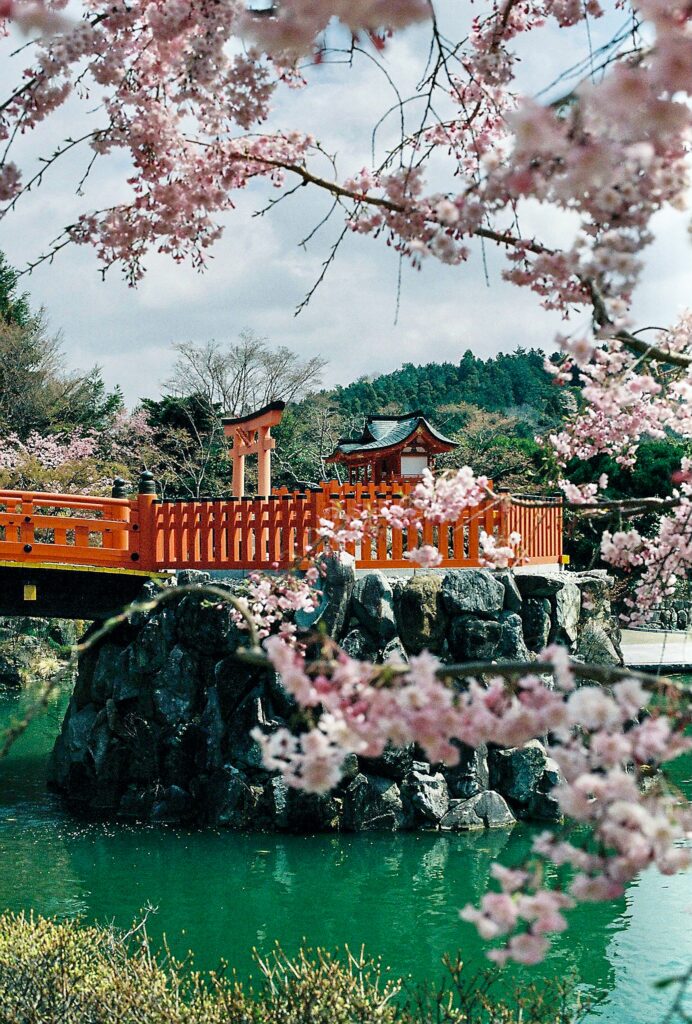
Cheapest Cities in Japan to Visit
Tokyo is amazing, futuristic, and a place unlike many others in the world, but there are many other captivating cities in Japan to explore that should be considered. Also, Tokyo is one of the most expensive cities to visit!
Whether you are a budget-conscious traveler or simply looking to maximize your money during your trip to Japan, these cities offer the perfect blend of affordability and unforgettable experiences.
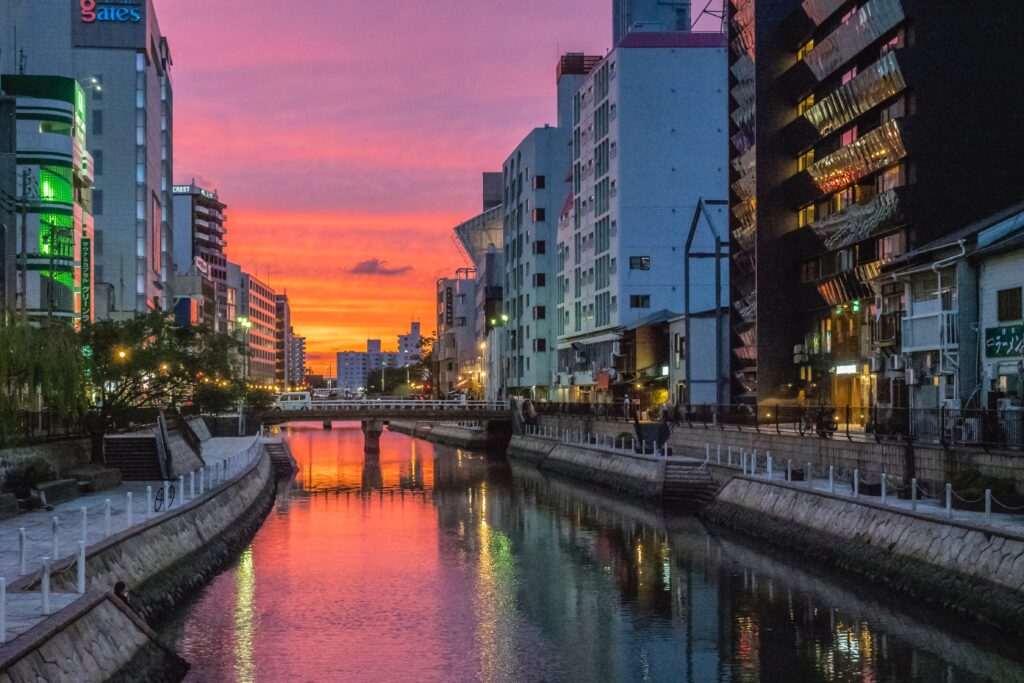
Fukuoka is a vibrant city located on the southern island of Kyushu, Japan. Known for its warm climate, beaches, modern shopping malls, ancient temples, rich history, and lively atmosphere, Fukuoka offers a unique blend of modern and traditional attractions.
Sitting at a population of over 1.6 million people, Fukuoka is the largest city on the island of Kyushu and has plenty to offer visitors. The city is well connected, with an international airport and excellent transportation networks, making it easily accessible for travelers.
Fukuoka boasts a wide range of attractions, from historic landmarks to contemporary modern shopping districts. The most famous attraction in the city is the Fukuoka Castle Ruins, which provides a glimpse into the city’s feudal past.
Foodies will love visiting Fukuoka; the culinary scene here is exceptional. The city is renowned for its rich and flavorful tonkotsu ramen. As you walk around the city, you’ll find countless restaurants and food stalls offering it. Besides the city’s famous ramen, you’ll find gyoza, grilled meat skewers, the freshest seafood, and much more!
The Nakasu district is a bustling area in the city known for its many restaurants, shopping, vibrant nightlife, and entertainment options. Within the district is the Naka River, offering a unique feature to the area.
Additionally, Fukuoka hosts various festivals throughout the year, showcasing traditional performances and cultural events. Visiting during one of the many festivals offers an extra way for you to experience the local culture!
Average Daily Visitor Cost: $140 US
Average Monthly Living Cost: $1,170 US
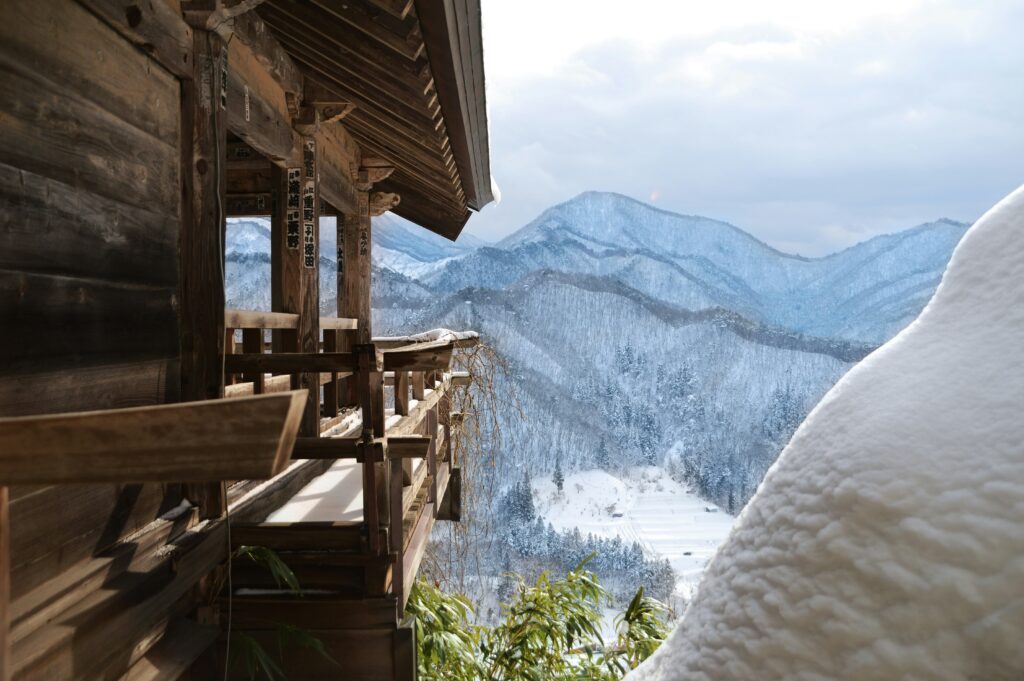
Sendai is Located in Japan’s northeastern Tohoku region, a vibrant and modern city that seamlessly blends innovation and tradition. Known as the “City of Trees,”
Sendai is famous for its picturesque scenery and abundance of green spaces within the city.
It is famous for being a cultural hub, offering visitors numerous museums, art galleries, and traditional festivals to experience. The city has a thriving culinary scene; Sendai is renowned for its delicious seafood, particularly its fresh and succulent gyutan (grilled beef tongue).
Visitors can also venture out and explore the nearby Matsushima Bay, an area known for its serene islands and breathtaking views.
With its natural beauty, cultural attractions, and delectable cuisine, Sendai offers a captivating experience for all types of travelers.
Average Daily Visitor Cost: $144 US
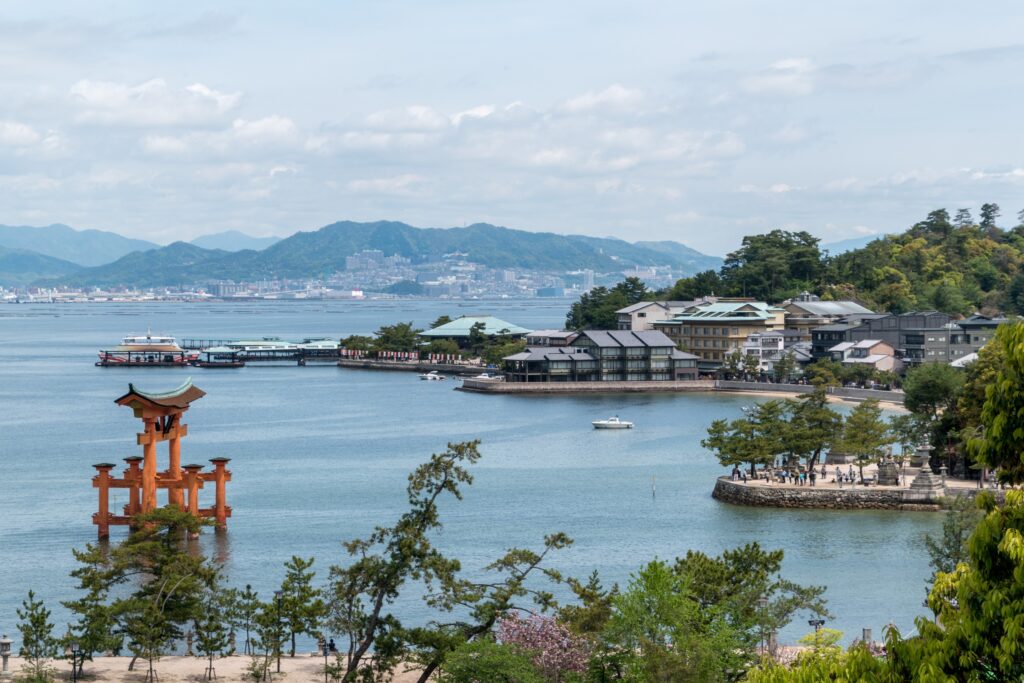
In western Japan, Hiroshima is a city with immense historical significance. Today, it serves as a symbol of peace and resilience.
The city is forever etched in history as the first city to suffer the devastation of an atomic bomb during World War II. Hiroshima has since risen from the ashes and transformed into a vibrant, forward-thinking metropolis.
Hiroshima’s most known attractions are the Peace Memorial Park and Museum, serving as reminders of the devastating event that occurred in 1945.
These sites honor the victims and advocate for nuclear disarmament and global peace. The A-Bomb Dome, a skeletal structure that survived the blast, stands as a powerful symbol of the city’s resilience.
The city is blessed with natural beauty, including the scenic Hiroshima Peace Memorial Park and the picturesque Miyajima Island, home to the iconic floating torii gate.
Today, Hiroshima stands as a vibrant city that embraces its past while looking towards the future; with beautiful parks and a vibrant food scene, Hiroshima’s charm extends beyond its tragic past.
Average Daily Visitor Cost: $146 US
Average Monthly Living Cost: $927 US
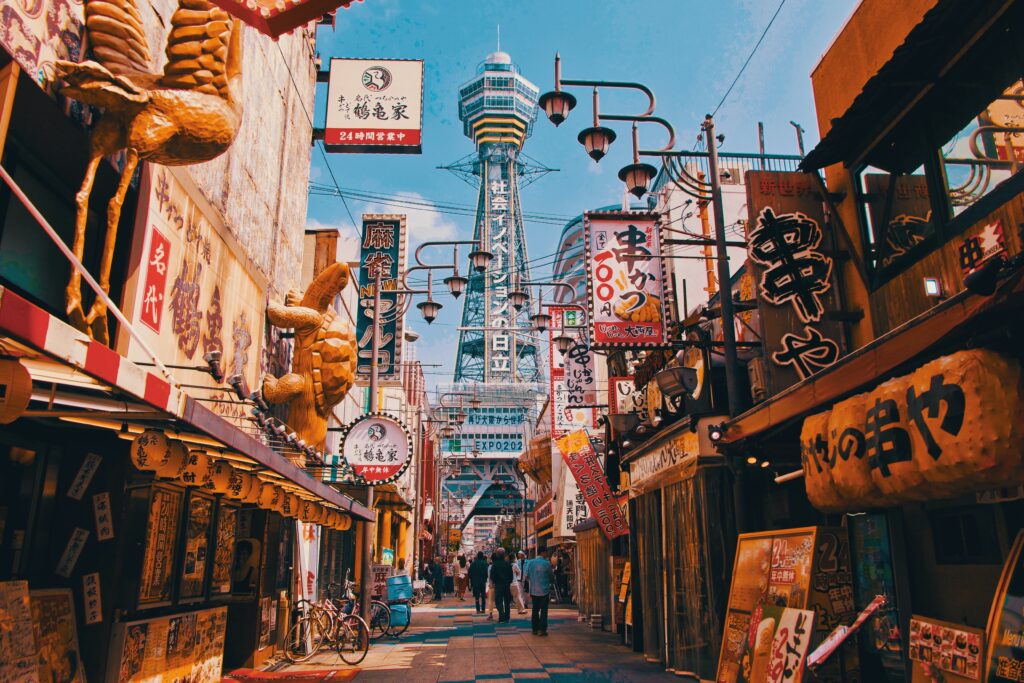
Located in the Kansai region of Japan, Osaka is a bustling city famous for its vibrant atmosphere, rich cultural heritage, and delicious cuisine.
With a population of over 2.7 million people, you’ve most likely heard of Osaka before. Osaka is Japan’s third-largest city, so there’s no shortage of things to do in Osaka!
One of the main highlights of Osaka is its food scene, so much so that the city is often referred to as the “ Kitchen of Japan .” It’s most famous for its street food, including takoyaki (octopus balls), okonomiyaki (savory pancakes), and Yakiniku (Japanese grilled meat).
The best way to experience street food in Osaka is to pay Dotonbori a visit. The vibrant street is a must-visit for food lovers, food stalls, countless restaurants, and a fun atmosphere.
Osaka is home to several iconic landmarks within the city. Most notable is Osaka Castle, a magnificent 16th-century fortress, which is a popular tourist destination, offering stunning views of the city from its observation deck.
The Shinsaibashi and Umeda districts in Osaka are ideal for those looking to get some shopping done. You’ll find everything from trendy shops to luxury boutiques and large department stores. Another fun attraction in Osaka is Universal Studios Japan, a theme park that offers thrilling rides and attractions based on popular movies.
Osaka’s cultural heritage is evident in its many temples and shrines. The Shitennoji Temple, one of the oldest Buddhist temples in Japan, is a tranquil oasis in the heart of the city. The Sumiyoshi Taisha Shrine, known for its unique architecture, is another popular spiritual site.
Average Daily Visitor Cost: $147 US
Average Monthly Living Cost: $1,220 US
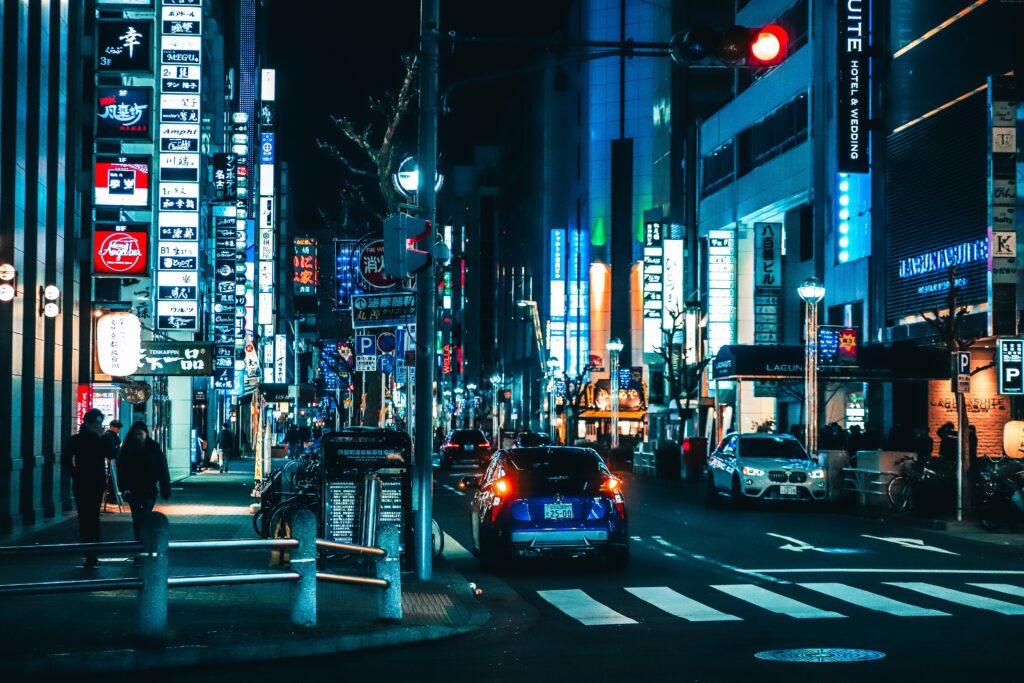
As the fourth-largest city in Japan , Nagoya has a lot to offer visitors in terms of sights, experiences, and cuisine. Nagoya is known for its rich history and is home to several iconic landmarks, and it’s located in the Chubu region of Japan.
The Sakae district is a bustling area filled with high-end shopping malls, trendy boutiques, museums, and entertainment venues. Standing tall in the city’s heart is the Nagoya TV Tower, which offers breathtaking skyline views from its observation deck.
Foodies will be in awe and delighted by Nagoya’s local cuisine. Hitsumabushi, a grilled eel dish, is a city specialty and a must-try for visitors. Nagoya is also very much famous for its miso-based dishes, such as miso katsu and miso nikomi udon, which are flavorful and unique to the region.
The most famous attraction is The Nagoya Castle, a reconstructed 17th-century fortress that symbolizes the city’s feudal past and offers visitors a chance to explore its impressive architecture and beautiful gardens. Nearby, you’ll find the Osu Kannon Temple, a historic Buddhist temple.
With the city’s excellent combination of historical sites, modern attractions, and culinary delights, Nagoya offers a diverse range of experiences for tourists!
Average Daily Visitor Cost: $149 US
Average Monthly Living Cost: $1,407 US
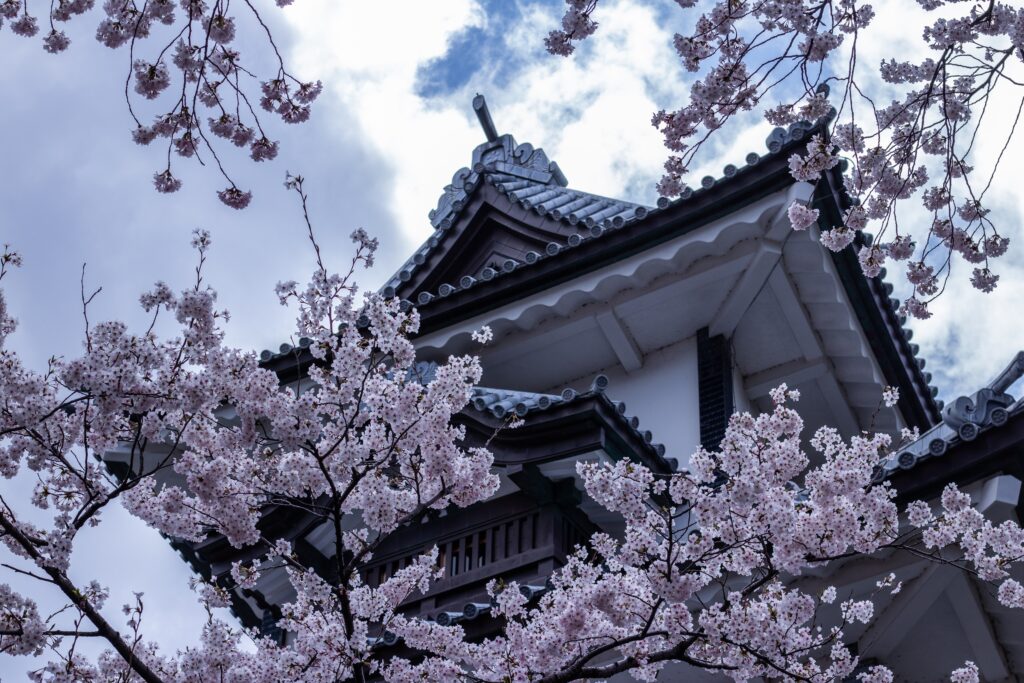
Often referred to as “Little Kyoto,” Kanazawa offers a glimpse into Japan’s traditional arts and architecture with its well-preserved historical districts and charming manicured gardens.
One of the Kanazawa’s main attractions is Kenrokuen, one of Japan’s most famous gardens. Known for its beautiful landscapes and stunning seasonal beauty, Kenrokuen offers a harmonious atmosphere mixing the beauty of nature and man-made design.
The Nagamachi Samurai District provides a glimpse into the feudal era of Japan, with its traditional houses, narrow streets, and preserved samurai residences. Strolling through this district, you’ll think you’ve stepped back in time, and it offers insights into the samurai way of life.
Kanazawa’s culinary scene is worth mentioning, with its fresh seafood, traditional sweets, and unique local dishes like jibuni (a rich duck stew) and kaga ryori (traditional multi-course meal).
With its blend of history, culture, traditional crafts, and culinary delights, Kanazawa offers a captivating experience showcasing Japan’s best traditional and artistic heritage.
Average Daily Visitor Cost: $152 US
Average Monthly Living Cost: $1,127 US
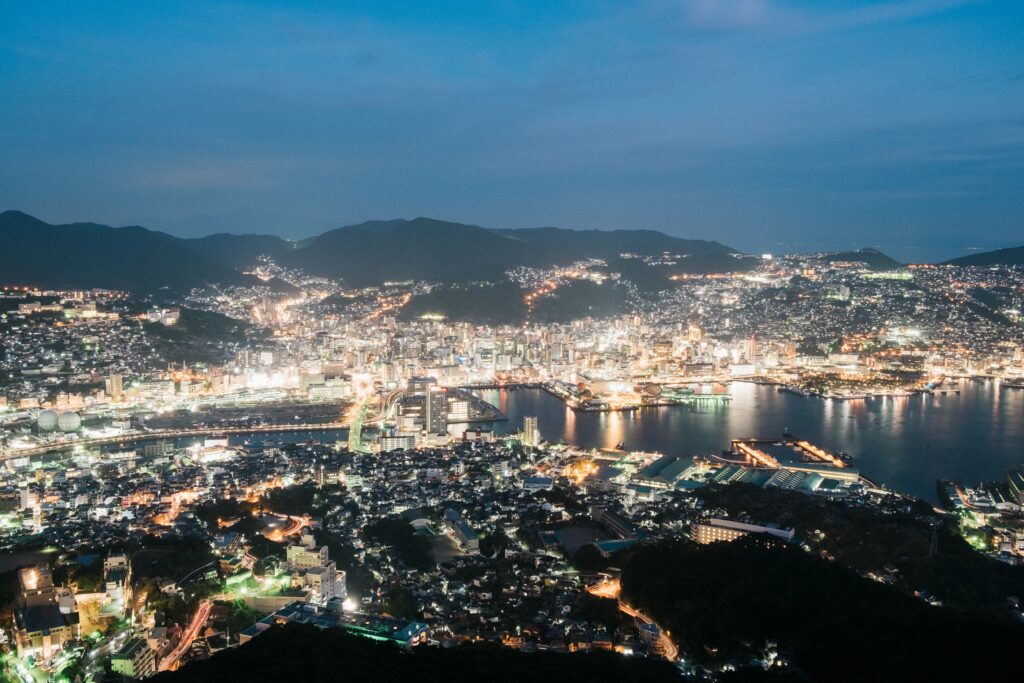
Nagasaki, located on the western coast of Japan’s Kyushu island, is a city renowned for its stunning scenery, rich history, and resilient spirit. Known worldwide for the tragic events that unfolded during World War II, the city of Nagasaki has since emerged as a symbol of peace and reconciliation.
Nagasaki’s history is deeply intertwined with lots of international influences, particularly due to its historical role as a major port for foreign trade. The city’s cultural heritage is evident in its unique blend of Japanese, Chinese, and Western influences.
One of Nagasaki’s most famous attractions is the Nagasaki Atomic Bomb Museum and Peace Park, a war museum. These poignant sites serve as a memorial to the devastating atomic bombing that occurred in 1945 and serve as emphasizing the importance of promoting peace in the world.
Mount Inasa, a popular observation point, offers breathtaking panoramic views of the city and its surrounding landscape. Overall, Nagasaki offers plenty of parks scattered around the city to explore.
Nagasaki’s cuisine is also worth exploring. The city is famous for its Nagasaki Champon, a hearty noodle dish with a variety of ingredients, and Castella, a sweet sponge cake with Portuguese origins. With Nagasaki’s captivating history, natural beauty, and scenic charm, the city’s worth a visit!
Average Daily Visitor Cost: $161 US
Average Monthly Living Cost: $980 US
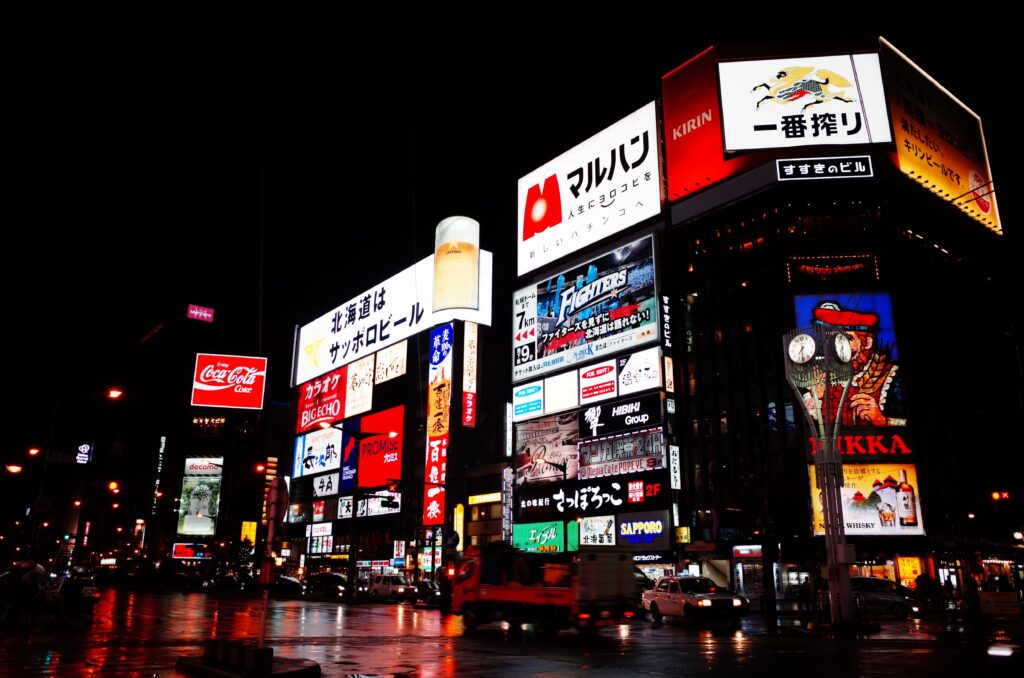
Sapporo, the capital city of Hokkaido in northern Japan, is a modern and vibrant metropolitan city that offers a unique blend of urban attractions and natural beauty.
You’ve most likely heard of Sapporo due to the famous Japanese beer that was founded here, named after the city. Visitors can also explore the Sapporo Beer Museum, where they can learn about the history and brewing process of Sapporo beer, the world-famous beer.
The city is known for its lively atmosphere. Sapporo is famous for its annual Snow Festival, where magnificent ice sculptures attract visitors worldwide. The Sapporo Clock Tower is the city’s most famous attraction, symbolizing its rich history.
Sapporo is also home to the historic Odori Park, a spacious green oasis in the heart of the city, perfect for relaxation and picnics. Also, Sapporo is an excellent skiing destination in Japan for those who enjoy skiing.
The city is also home to various must-try foods when visiting, including the famous Sapporo ramen, Soup Curry, Kaisendon & Sushi (sushi rice bowl), and fresh seafood from nearby coastal areas.
Average Daily Visitor Cost: $165 US
Average Monthly Living Cost: $1,240 US
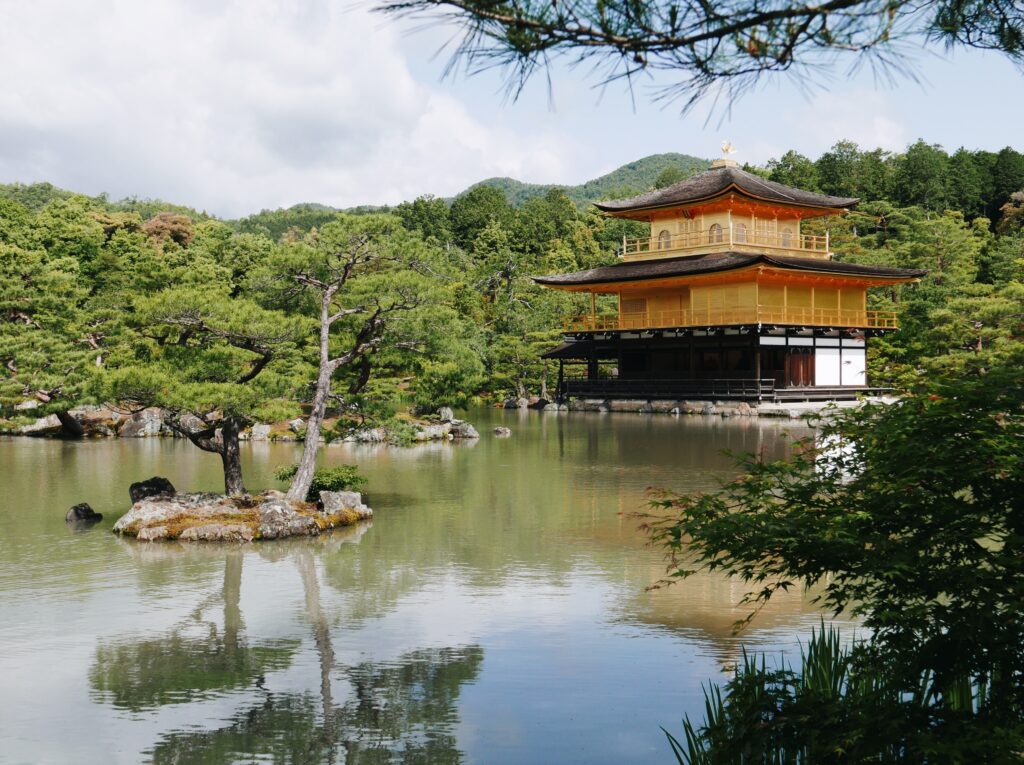
Okayama is a charming city located in the Chugoku region of Japan. It’s known for its historical landmarks, beautiful gardens, and vibrant cultural scene. The city is home to one of Japan’s most iconic attractions, Okayama Castle, offering exceptional panoramic views of the city.
Adjacent to the castle is the stunning Korakuen Garden, considered one of Japan’s top three most beautiful gardens, boasting picturesque landscapes, traditional tea houses, and tranquil ponds.
Art enthusiasts will appreciate the Okayama Prefectural Museum of Art, which houses an impressive modern and contemporary artwork collection.
The city is famous for its connection to the legend of Momotaro, a popular Japanese folklore hero, and visitors can explore the Momotaro Shrine and learn about the story’s significance.
Okayama is also known for its production of high-quality denim, and visitors can shop for unique denim products in the bustling shopping district of Kurashiki Bikan Historical Quarter. You must buy a pair of jeans during your visit to Okayama!
Average Daily Visitor Cost: $167 US
Average Monthly Living Cost: $1,290 US
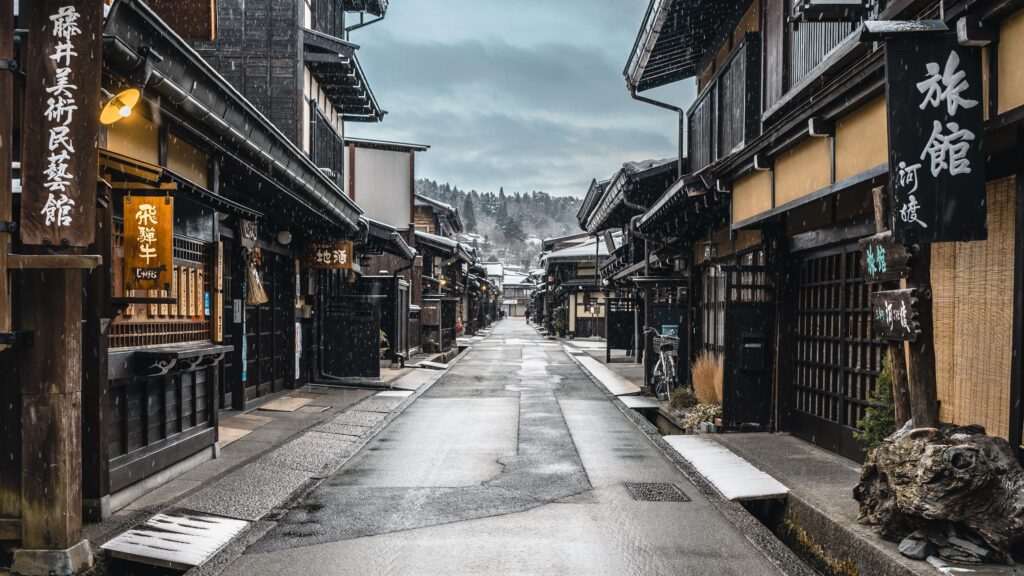
Takayama, nestled in the mountainous Hida region of Japan , is a picturesque city that showcases the country’s rich cultural heritage. Takayama boasts many well-preserved traditional wooden houses, narrow streets, and historic buildings that transport visitors back in time.
The small city’s most notable attraction is the Sanmachi Suji district, a charming, preserved old town lined with several shops, sake breweries, and traditional Japanese houses. Takayama is also famous for its festivals, including the Takayama Festival, which dates back to the 1600s.
Foodies will be delighted by the many must-try foods in the city, including succulent Hida beef and traditional sake. Takayama’s warm and welcoming atmosphere, cultural richness, and natural beauty make it a must-visit destination for those seeking an authentic Japanese experience.
The city is surrounded by breathtaking natural landscapes, including the stunning Hida Mountains and the scenic Hida-Kanayama Lake, offering opportunities to experience many outdoor activities such as hiking, fishing, visiting hot springs, and more!
Average Daily Visitor Cost: $172 US
Average Monthly Living Cost: $1,390 US
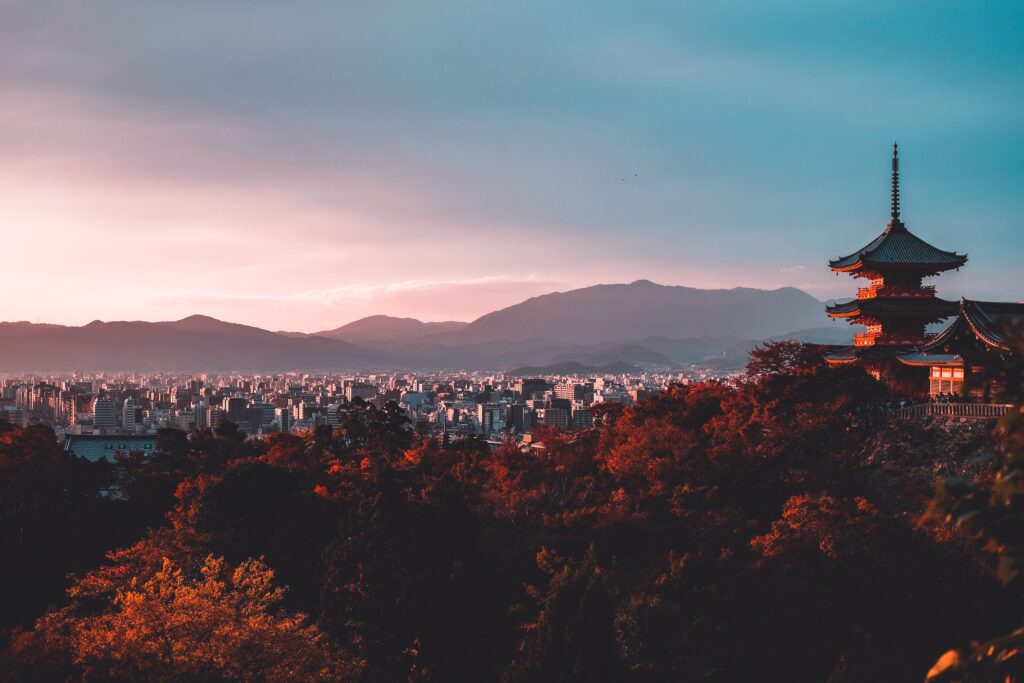
Kyoto is a cultural treasure trove renowned for its historical significance, traditional architecture, and serene beauty. Located in central Japan, known as the former capital of Japan for over a thousand years.
The city of Kyoto represents Japan’s history and offers visitors a glimpse into the country’s rich cultural heritage like no other city. Kyoto is home to numerous UNESCO World Heritage Sites, including the iconic Kinkaku-ji (Golden Pavilion) and Kiyomizu-dera, both known for their stunning architecture.
Another is the Fushimi Inari Taisha shrine, with its thousands of vibrant red torii gates. It is another must-visit destination in Kyoto that offers a unique and enchanting experience.
It is famous for its traditional Japanese gardens, such as the stunning Ryoan-ji and the meticulously landscaped Katsura Imperial Villa. These gardens provide a peaceful ambiance escape from the hustle and bustle of Kyoto, allowing visitors to immerse themselves in nature.
The city is also known for its seasonal beauty, with its cherry blossoms in spring and vibrant autumn foliage attracting visitors from around the world to experience the scenery.
Kyoto’s culinary scene is equally enticing, with a wide range of traditional Japanese dishes, such as kaiseki (multi-course meal), matcha, and Kyoto-style sushi. The Nishiki Market is an iconic, vibrant market offering a bustling experience where visitors can try many local foods.
Average Daily Visitor Cost: $215 US
Average Monthly Living Cost: $1,090 US
RELATED: 11 Cheapest Places in Thailand
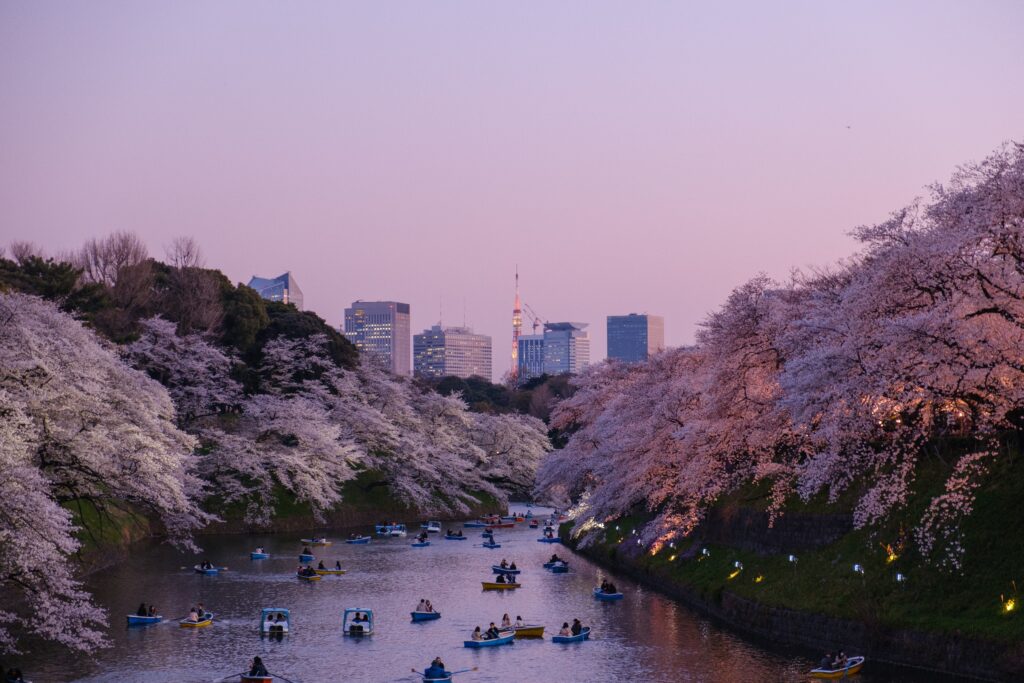
Is Japan Cheap to Visit?
Considering one’s costs for visiting Japan can depend on multiple factors, including what places you choose to visit, the travel season, and your travel style.
Generally speaking, Japan is not considered a cheap travel destination, especially compared to other Asian countries, such as Thailand and Vietnam .
However, that doesn’t mean you cannot visit Japan on a budget because it’s very much possible.
According to BudgetYourTrip , the average daily cost to visit Japan is around $130 US , including hotel, food, and transportation.
Keep in mind this is an average estimate across all traveler types and all destinations in Japan.
Many automatically think of visiting Tokyo when thinking of Japan; while that’s an excellent idea, it’s also one of the most expensive places in Japan to visit. So, ultimately, the places you choose to go will factor in your cost per day.
RELATED: 12 Cheapest Places to Travel
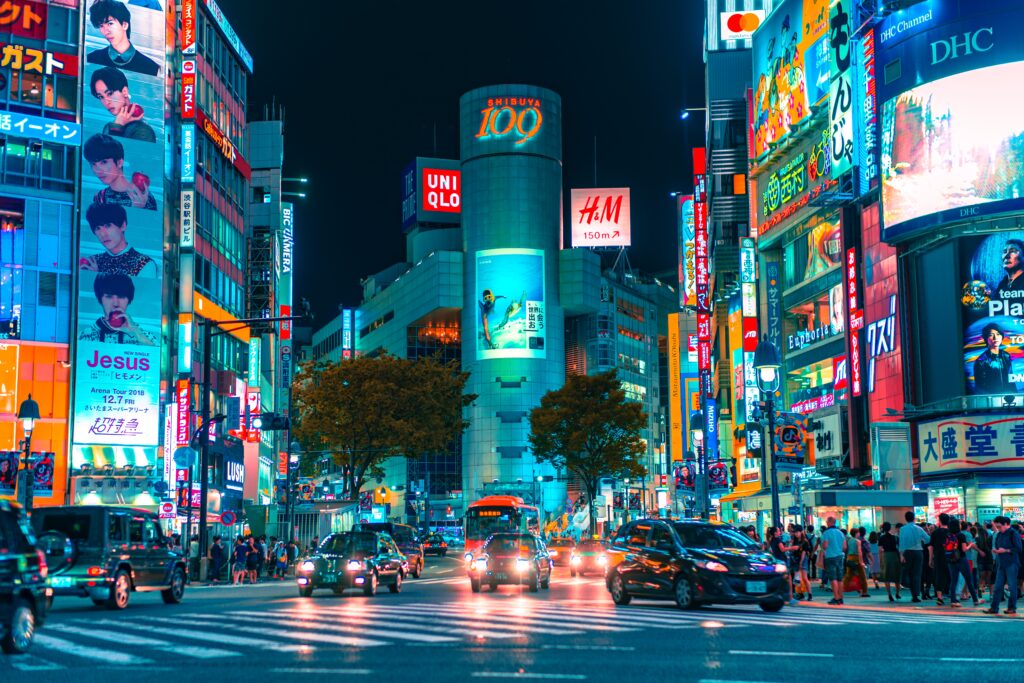
Cheapest Cities in Japan to Live
Now, let’s discuss the cheapest cities in Japan to live in. Keep in mind the cities mentioned above are all excellent destinations to visit, but if you’re an expat/digital nomad looking to move to Japan , you’ll want to relocate to a liveable city .
For a city to be considered liveable , it must be fairly developed, offer many grocery stores/shops, things to do, amenities, access to healthcare, and be somewhat near an airport.
Fukuoka — Fukuoka is an excellent city to live in. The city offers many modern amenities, its food scene is exceptional, and the public transportation in the city is great. Fukuoka offers a unique, diverse landscape, including mountains and beaches.
Sapporo — Those who enjoy nature will love the lifestyle in Sapporo, a city known for its natural beauty. It’s a rather safe city to live in, and you can find rental deals on apartments here.
Osaka — Known as the third most populated city in Japan. Osaka offers a wide variety of amenities, many restaurants, gyms, etc. With, on average, lower rent prices than some of Japan and great public transportation, Osaka is a great choice.
RELATED: 12 Cheapest Places to Live in the World
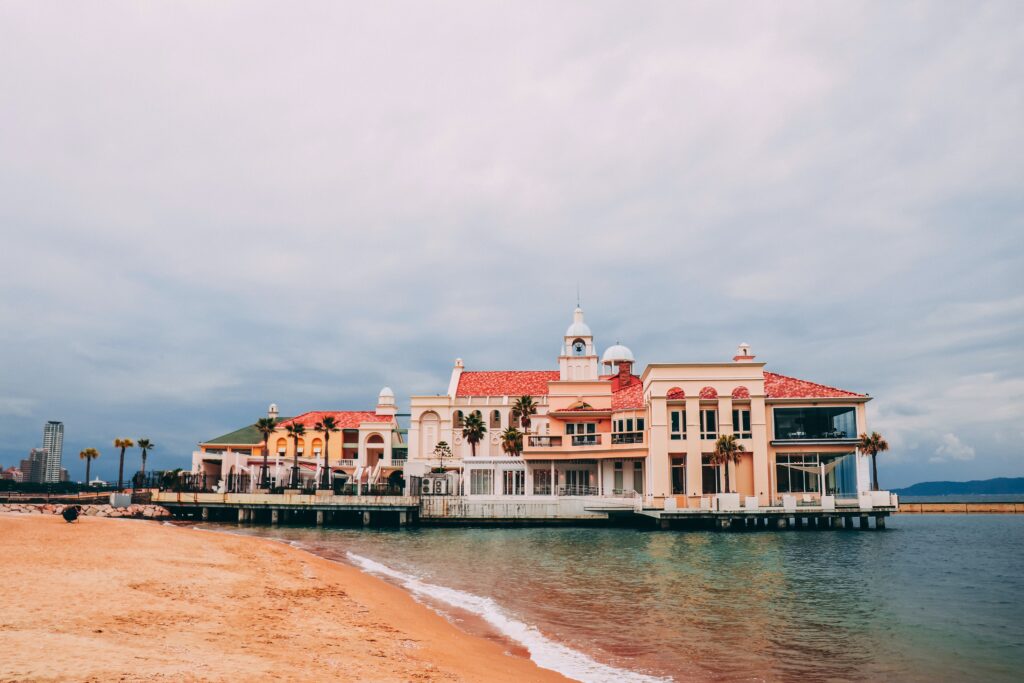
Is Japan Cheap to Live in?
The cost of living in Japan first depends on your lifestyle, location, and overall spending habits.
Overall, Japan has claimed a relatively high cost of living compared to many other countries. If budgeting is your first factor regarding where to live, Japan shouldn’t be considered.
A main aspect that can make living in Japan more affordable is the public healthcare in Japan, which is known for its quality and accessibility, and the cost of healthcare is typically lower compared to some other developed countries.
Besides that, rent prices are quite high in many of Japan’s most liveable cities, and food expenses, like groceries and eating out, are considerably higher than in other countries.
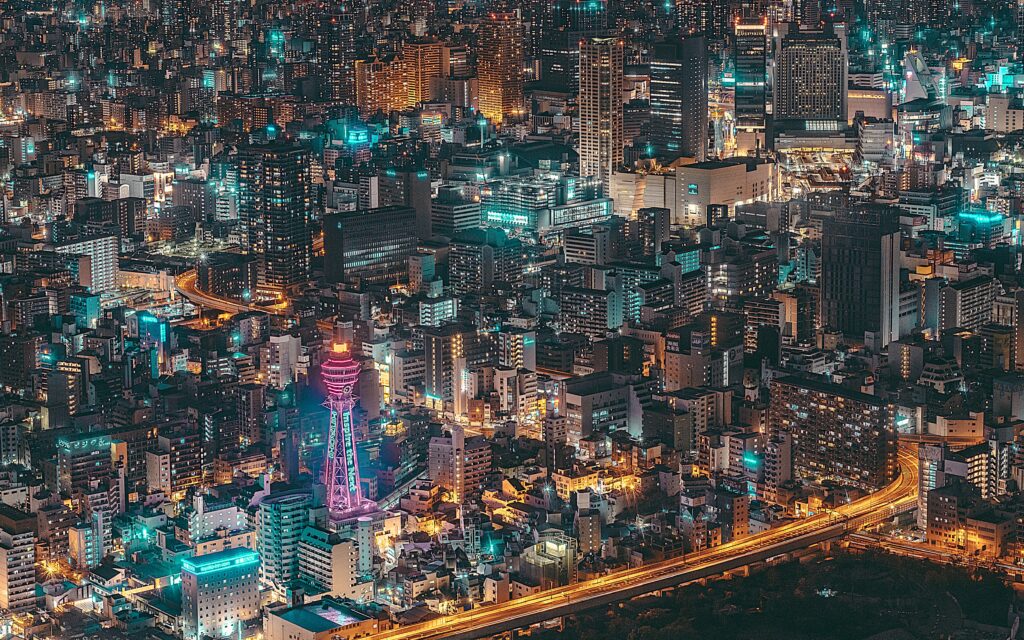
Which city in Japan is cheapest?
Fukuoka is the cheapest city in Japan, with the average daily cost is $140 US.
Can I visit Japan on a budget?
It’s possible to visit Japan on a budget. The average daily cost in Japan is $130 US a day .
But if you choose to visit expensive cities like Tokyo and others, visiting them will quickly make your trip costly.
Is Nagoya cheaper than Tokyo?
Nagoya is approximately 12% cheaper in terms of living costs than Tokyo.
Is Fukuoka cheaper than Tokyo?
The average daily cost to visit Fukuoka is around $140 US a day, whereas for Tokyo, it’s around $171 US a day.
Subscribe to Travel Hiatus!
Receive updates on my latest posts, insider travel tips & the best destination guides to your inbox!
[yikes-mailchimp form=”1″]
Happy & Safe Travels
Planning Checklist
- Find the best Hotels/Resorts
- Book a Vacation Home Rental
- Book a fun Tour in the Place you’re visiting
- Find the best Hostels
- Find/Buy the Cheapest Flights
- Get Travel Insurance when traveling
Disclaimer : Please note that some of the links shared in this article might be affiliate links. This means that at no extra cost to you, we will earn a small commission for any sales generated through this article and/or this website.
We recommend products/services we’ve either used or researched thoroughly – Thank you for supporting me so we can continue to share helpful travel content!
Owity founded Travel Hiatus in 2022 to document his travel, food and cultural experiences from all over the globe in order to help fellow travellers along the way. His slow travels allow him to research and explore places in-depth, meaning only the best and most informational guides for fellow readers! From Europe to North America, Asia and more, so far Owity has visited 21 countries.
Similar Posts
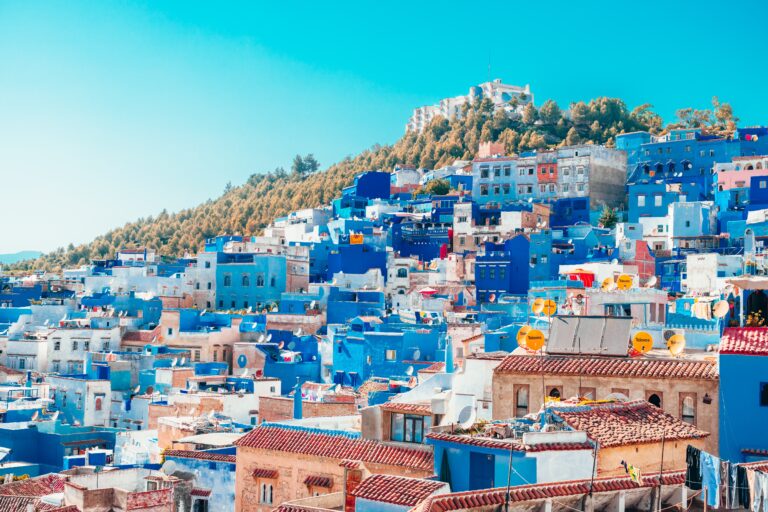
9 Cheapest Cities In Morocco To Visit
Are you planning a trip to Morocco and looking for the cheapest cities in Morocco to visit? You’ve come to the right place! I’ll cover the cheapest cities in Morocco to visit and live in, as well…
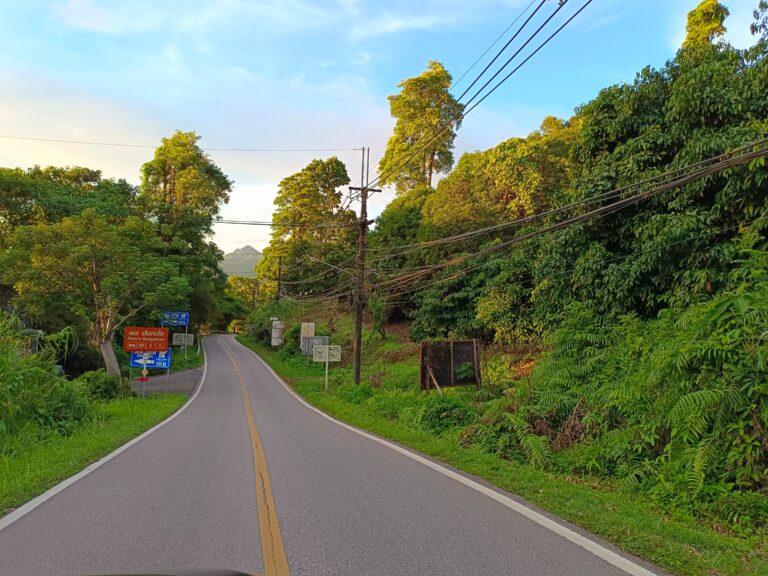
How to Get from Bangkok to Koh Chang: 4 Ways
Are you trying to find out how to get from Bangkok to Koh Chang? This complete transportation guide covers all four ways to do just that! Koh Chang is one of the most beautiful and picturesque islands…
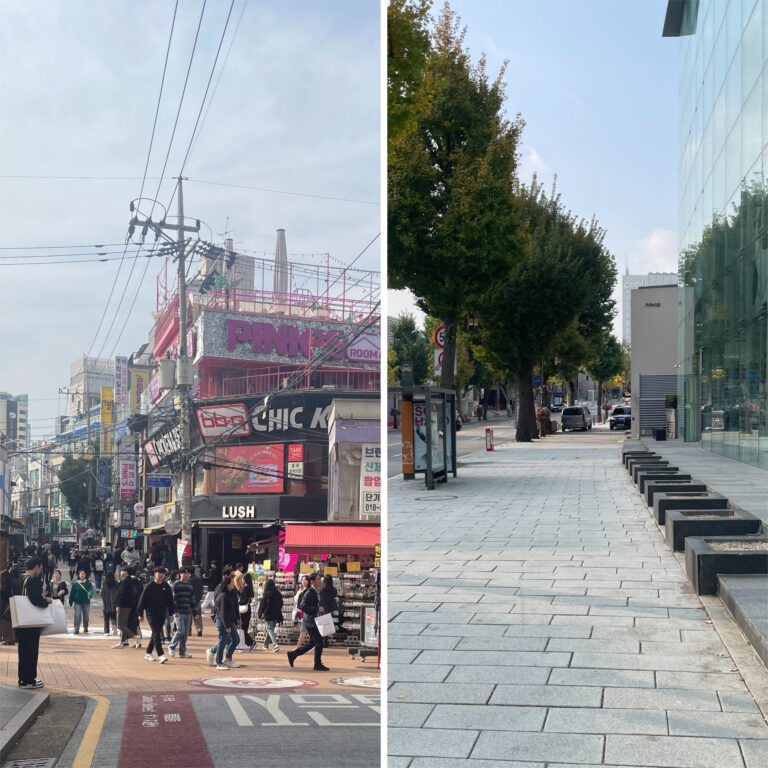
Hongdae or Itaewon: Which Area is Better?
Are you planning a trip to Seoul for the first time and need help deciding which area to stay in, between Hongdae or Itaewon? Both are two of the trendiest areas in Seoul, with many things to…
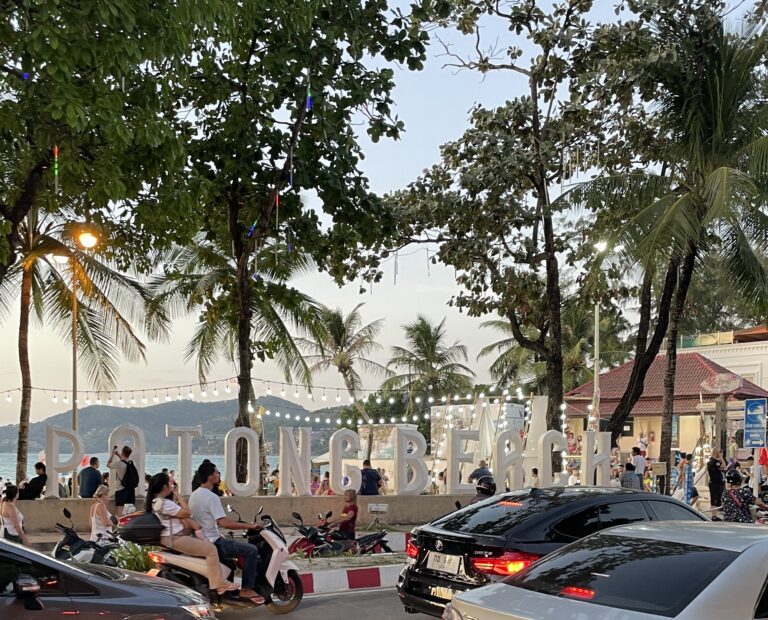
Phuket Airport to Patong Beach: 5 Best Ways
Are you wondering how to get from Phuket Airport to Patong Beach? Here are the five best ways to get from Phuket Airport to Patong Beach! It takes around 1 hour to get from Phuket Airport to…
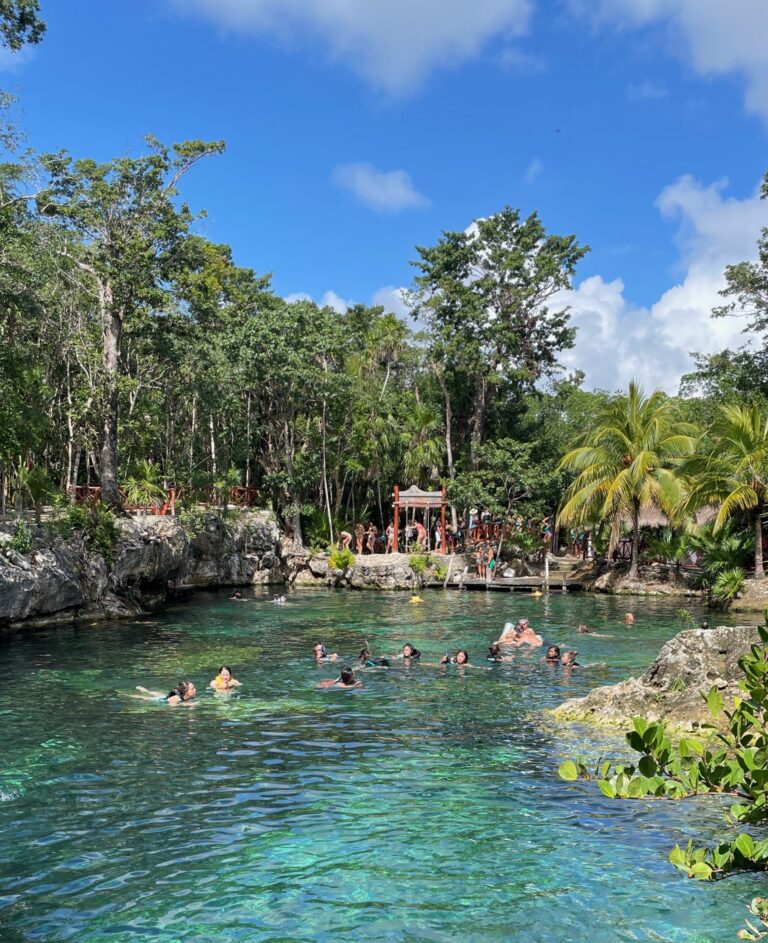
7 Best Tulum Cenotes You Should Visit
Are you visiting Tulum soon and looking for the best Tulum cenotes? This cenote guide covers the best cenotes in and around Tulum, how to get to all the different cenotes, and other essential information you should…
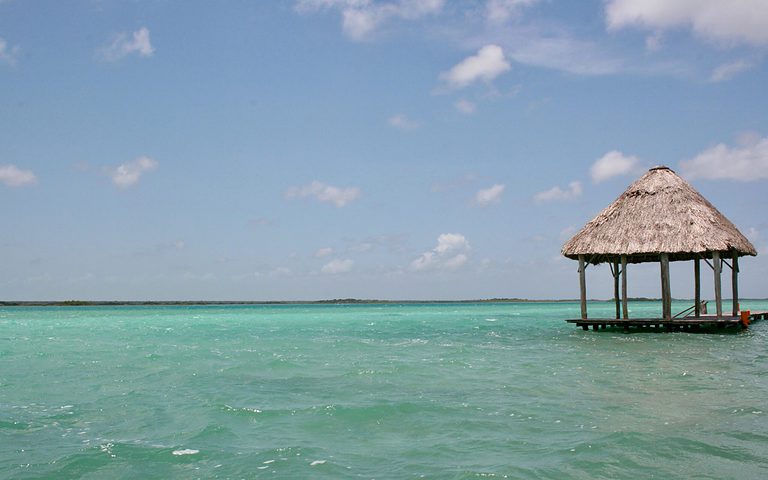
9 Best Bacalar Hotels in Mexico to Consider
Looking to visit Bacalar, Mexico, and can’t decide where to stay in Bacalar? You’ve come to the right place; this guide covers the best Bacalar hotels to consider! The small town is located in the Quintana Roo…
Leave a Reply Cancel reply
Your email address will not be published. Required fields are marked *
Save my name, email, and website in this browser for the next time I comment.
Notify me of new posts by email.

Japan on a Budget: The Complete Guide to Cheap Travel in Japan

How to Travel Japan on a Budget: The Only Guide You’ll Ever Need
Is is possible to travel to Japan on a budget? Definitely! Japan is one of the most fun and amazing travel destinations in the world. However, many travelers are reluctant to plan a trip to the Land of the Rising Sun because of the cost.
Known for being an expensive place to visit, many Japan lovers give up when they hear how much it costs to travel to Japan. In doing so, they miss out on the trip of a lifetime. It’s true that Japan has tons of luxury hotels, world-class restaurants, and first class transportation options that cost more money than most people’s mortgages.
However, Japan also has lots of cheap lodging, amazing food, and transportation options that are very easy on the wallet. In fact, Japan can be one of the CHEAPEST destinations to travel on a budget. If you want to visit Japan on a budget, this article will provide you with all of the tips, tricks, and advice to save you as much money as possible.
How to Get Cheap Flights to Japan
While it is possible to visit Japan by boat (namely from Australia, China, Taiwan, and Korea) the vast majority of visitors choose to go by air.
If you live in one of these nearby countries and have LOTS of time, check out your local boat companies for deals. Sometimes they sell last minute tickets at a fraction of the cost.
However, it’s almost always more efficient to travel by air.
So here are 5 tips to getting the cheapest airline tickets to Japan.
5 Tips to Find Cheap Flights to Japan
1. book as early as possible.
When searching for a flight to Japan, booking as far in advance as you can is best. Waiting until the last minute to grab reduced price tickets can certainly pay off, but it’s a big gamble if the tickets sell out (which happens more often than not).
You’re better off by being prepared, planning in advance and choosing to visit Japan at a cheaper time of year.
I usually buy my tickets at least a month before my travel date. I found that this is the latest I can wait before tickets sell out or really get expensive.
2. Avoid Peak Periods of Travel: Peak Times

Not only does the cost of airfare increase during peak times of travel in Japan, but hotels, attractions, and even restaurants raise their prices as well (usually buffets or nice restaurants that offer things like “special” holiday menus). If possible, try to avoid these peak travel times in Japan if you are on a tight budget:
- Golden Week: End of April – start of May
- Cherry blossom viewing: Late March – early May
- Summer: Mid-August is the busiest due to the Obon Festival
- Autumn: Changing colors of leaves (busiest time is late September due to Silver Week, a period of national holidays grouped close together)
- Spring: The end of March – the beginning of April. School children are on spring break, and lots of families travel during this time
- New Years: A popular time to travel during this time (domestic and international)
3. Cheapest Time to Fly to Japan
Here are the dates that generally have the cheapest flights to Japan
- Early to late December (before New Years)
- Just after the New Year holiday ends (people are usually back to work by January 5th) up until the end of March. However, Hokkaido has lots of visitors during this time due to all of the incredible ski slopes and winter foods. The world-famous Snow Festival also takes place in early February, which makes finding a cheap ticket to Hokkaido difficult.
- Mid May – June is also a cheaper time to visit.
While the winter season might not be the best time to visit Japan in terms of weather, you’ll usually save money on plane tickets. Winter foods in Japan are absolutely delicious as well. Delicious hot pot dishes, fresh crab, and other seafood are especially delicious in winter.
If you want all of the details and insiders tips on when to visit Japan, check out our best time to visit Japan guide.
4. Check for Internet Deals
Or course you could get cheap airlines tickets by choosing non-direct flights with long, inconvenient waits in between. But who wants to do that? Sure, you can save some money, but you’ll be giving up a lot of time and comfort by doing this.
Before going this route, spend an hour or two searching the Internet for the best deals. You can decide if a reduction in price with a 12-hour wait in some random airport is worth the inconvenience.
How to do Internet Research for Cheap Flights to Japan
Here are the steps I use to find the best deals to Japan:
1. Determine Both Your Budget and Which Airlines Companies You Want to Use
Of course, if you are willing to fly with any airlines, you’ll have the best chances of finding a cheap flight. However, I highly recommend you only use reputable carriers. There are lots of airlines with cheap flights to Japan, but they usually have very long layovers or delays, poor service, and safety issues.
Sometimes, it’s just not worth the risk. So to minimize your chances of having a bad flight, go with a reputable airline company. Airlines that fly to Japan differ depending on where you live, but I like Hawaiian Airlines, Japan Airlines (JAL), All Nippon Airways (ANA), and Korean Airlines.
2. Always Check Your Favorite Airline Carrier’s Website First
I always check the Hawaiian, JAL, and ANA Airlines website first. Most of the time, I find the best deals directly on their website.
Booking directly with the airline carrier is usually safer and more secure than booking with a third-party company. Be sure to check the prices often, as they can change frequently.
If the prices are high, proceed to step 3.
3. Do a Quick Search for Ticket Prices on a Multi-Search Website like Kayak.com
Other websites such as Skyscanner, Expedia, Jetstar, Kayak, Lastminute, and Farecompare are also good places to analyze ticket costs. Remember that flight costs will depend on where you’re flying from. Heading out from a major “hub” airport rather than a local one will certainly cut costs.
These websites search hundreds of travel sites and find the cheapest tickets out of all of them. Filter the searches by the airline carrier and how many layovers you are willing to have on your trip. Be sure to check the prices for different dates. Sometimes traveling just 1 day later can drop the prices significantly.
NOTE: I just do this to see what the average prices are for that dates of travel. I DO NOT purchase my tickets through Kayak unless there is an amazingly good deal though a REPUTABLE company. While there are usually cheap tickets that show up in the results, most of these are either a) flights with LONG layovers or b) flights listed by bad, untrustworthy third party companies.
In my experience, many of the companies that are listed on their website aren’t very trustworthy. Many of them have very bad reviews, with some even having complaints filed against them. Stick with the bigger companies like Expedia. Just use it to check the prices of the airlines you want to fly on.
4. Consider Buying a Ticket from Another Country or with a Different Currency
Choose the best 3 or 4 itineraries you found on Kayak/Expedia/Priceline/etc. I usually have the best results with Expedia.
At the bottom of the Expedia website, there’s a section called “Global Sites” with pictures of flags of different cultures. Choose a different country and search for the same flight. The ticket prices might be lower if you book it through another country with Expedia.

5. Fly into a Different Airport in Japan

If all of the flights to your desired airport in Japan are crazy expensive, consider flying to a different airport and then using the JR Rail Pass to take the train the rest of the way. If you don’t mind having a longer trip, the JR Rail Pass is a good way to cut costs.
You can fly into another major airport in Japan and then cash in your rail pass at the nearest participating station. Then you can take the bullet train to your desired location. While this does take more time, it can save you money and is much more fun that riding an airplane.
The seats on the bullet train are much more spacious than a plane and are much easier to travel. The only downside is that the bullet train doesn’t have space for big pieces of luggage.
Transportation in Japan: Saving Money on Domestic Travel
Finding a cheap way into the country is only half the problem. Domestic travel within Japan is also expensive. Of course, you could explore only one or two cities, which can cut costs dramatically by only paying local fares, especially if there are city passes available.
What makes Japanese so awesome is traveling to different areas to eat local foods and to experience the culture throughout Japan. If you want to explore many places in Japan, purchasing a travel pass will be your best bet. These passes can save you both time and money if you plan to travel a lot in Japan.
The JR Rail Pass: The Best Deal in Japan

The Japan Rail Pass is essential if you want to experience all that Japan has to offer. This pass allows you unlimited rides on most JR trains, including the bullet trains, as well as some JR buses and the JR ferry to Miyajima.
This pass opens up the whole Japan to you. You’re free to travel wherever, and whenever you want. I highly, highly recommend getting this pass.

This pass also makes traveling much easier. You don’t need to research ticket prices or deal with buying or keeping track of your tickets for each trip. Just walk on through the gates on the side and show your pass to the attendant.
Also, if you don’t mind sitting in the unreserved area, you can walk straight onto the train too – although reserving specific seats ahead of time is certainly recommended for busy times/seasons/routes.
How the JR Rail Pass Works
IMPORTANT: You can’t buy a Japan Rail Pass while in Japan. You must purchase your pass before you arrive in Japan. The pass is only for those on a tourist visa.
Also, keep in mind that the JR pass cannot be used on every type of transport. For example, you cannot ride the NOZOMI or MIZUHO type bullet trains using a Japan Rail Pass. This isn’t usually a problem, though.
The NOZOMI trains travel the exact same route as other types of bullet trains but only stops at major stations. A full list of what you can and can’t use the pass for can be found on the rail pass website .
JR Rail Pass Prices
There are two types of pass you can buy. A “green pass” allows you to sit in the first-class section of the train. However, not every train has a green car (first class section). The “ordinary” JR Rail Pass is the more economical option. Both of these passes can be used to make seat reservations for the bullet train.
Passes are available for periods of 7 days, 14 days, or 21 days. The countdown will start on the day you activate your pass. You do not have to activate it as soon as you arrive in the country. You can redeem it anytime during your trip.
Just take your rail pass voucher to a JR Station that can redeem it. A list of places should be included on a sheet with your voucher. However, most big, urban JR stations can activate your rail pass.
JR Rail Pass Prices (2017)
Prices for adult “original” passes:
- 7-day pass: 29,110 yen
- 14-day pass: 46,390 yen
- 21 day pass: 59,350 yen
Prices for child passes (age 6 to 11):
- 7-day pass: 14,550 yen
- 14-day pass: 23,190 yen
- 21-day pass: 29,670 yen
The passes may seem expensive but can save you an incredible amount of money if you travel a lot during your trip. A round-trip ticket from Tokyo to Kyoto would already cost 28900 yen, nearly the full price of a one week pass.
A typical 7-day trip for tourists would look like this:
- Days 1&2: Tokyo
- Day 3: Osaka
- Days 4&5: Kyoto
- Day 6: Hiroshima
This itinerary would cost you 41,640 yen, not including all of the local trains you’ll ride within these cities. If you were to return to Tokyo from Hiroshima, the total cost would be 60,200 yen, which is more expensive than a 21-day pass.
If you plan to visit more than one city by bullet train on your trip to Japan, a rail pass is an absolute must.
Where to Buy the JR Rail Pass
There are a few different agents you can use to order your Japan Rail Pass. Be sure to check the details. Some airlines sell rail passes, but you must book your airlines ticket with them as well.
Here are some of the main agents through whom you can purchase the pass: Tobu Top Tours, JTB Corp., KINTETSU INTERNATIONAL, Japan Airlines, Nippon Travel Agency, ANA Sales Americas (Los Angeles), and JALPAK. Check the website for details on how to purchase a rail pass.
Special Passes to Save You Money on Travel in Japan
As well as the Japan Rail Pass, there are other special tickets and passes you can buy to cut costs on your trip to Japan. Some tickets are regional, but others can be used all over the country.
Seishun 18 Pass

This is another offer from the JR (Japan Rail) company. This ticket is similar to the Japan Rail Pass, but it is more limited. However, the reduced cost makes this pass a great option if you’re trying to travel on a budget (and have lots of time).
The Seishun 18 ticket is a seasonal offer only. You can use the ticket for a 5 day period during the spring (early March to early April), summer (mid-July to early September), or in the winter (early December to early January). The exact dates are released when the tickets become available.
You can use this pass for unlimited travel on all local and rapid JR trains. You cannot use it on Shinkansen rides (bullet train) or on limited express travel.
The Seishun 18 is a 5-day ticket, costing 2,370 yen per day – a total of 11,850 yen.
A fraction of the price of the Japan Rail Pass, this is a great option if you want to do lots of little trips or one or two big journeys during the 5 day period. Interestingly, the ticket can also be shared between up to 5 people. You could have use of it for one day each and your friends could use it the other days.
Where to Buy the Seishun 18 Pass
You can buy the Seishun 18 ticket in the JR East station travel centers, or at JR Ticket Offices. Advance booking is available. Dates for when the passes go on sale are listed on the website along with the details, which usually becomes available from 1 to 3 weeks before the pass becomes available.
Hakone Free Pass
Hakone is an amazing place to visit. It is filled with stunning natural beauty, especially when the autumn leaves change and the cherry blossoms bloom in the spring. Whatever the season, Hakone is a wonderful place to visit. Amazing hot springs, outdoor walks, mountain hikes, surrounded by peace and quiet. It’s pure bliss.
The Hakone Free Pass is a must for people heading out that way. It gives you free travel on eight different types of transport in the Hakone area for a 2 or 3 day period, as well as discounted entry to dozens of attractions, including hot springs, museums, galleries, historical sites, parks, restaurants, shops and more. A full list is available on their website .
The Hakone Free Pass has different prices depending on where you depart from.
While you can get passes that are valid from Machida and Odawara, most travelers start their journey at Shinjuku. However, if you are heading off from one of the other two locations, be sure to check out the details as those tickets are a little cheaper.
From Shinjuku:
2-day adult pass: 5,140 yen
3-day adult pass: 5,640 yen
For children:
2-day pass: 1,500 yen
3-day ticket: 1,750 yen
Where to Buy the Hakone Free Pass
Hakone Free Passes can be purchased at any Odakyu line station, including Odakyu line ticket machines.
JR Tokyo Wide Pass

If your trip to Japan will be focused in and around Tokyo (there is so much to do there that you could easily spend your whole holiday there) then you should consider buying the Tokyo Wide Pass.
This 3-day ticket offers unlimited travel in Tokyo and the surrounding Kanto area. Including both the Narita and Haneda airports, you can pick up your pass on arrival, and it will cover the cost down into central Tokyo, and everything else for the rest of the period of validity.
Like the Japan Rail Pass, this ticket is only available to people with a tourist visa. As it is only valid for 3 days, you could easily get yourself one of these passes to use for a few days in Tokyo, then after that head off around the rest of the country using a Japan Rail Pass.
The 3-day pass is 10,000 yen for adults and 5,000 yen for children aged 6 to 11.
Where to Buy the JR Tokyo Wide Pass
You can buy a Tokyo Wide Pass at the JR Ticket Offices and JR Travel Agents located in the Haneda International Airport and in the Narita Airport Terminals 1 and 2, and 3.
The passes are also available at JR travel centers and general travel service centers at various locations, including Shinjuku, Tokyo, Ueno, Shinagawa, Shibuya, Ikebukuro, Yokohama, and Mito. Check the website for details.
Domestic Air Travel
Train passes are good for people who want to travel a lot, but what if you only want to explore one or two areas? While the rail passes are, on the whole, cheaper than buying individual tickets, they are still quite costly if you aren’t going to be getting a lot of use out of them. So if this applies to you, take a look at budget local airlines for domestic travel.
Low-Cost Carrier (LLC) Flights

Several airlines in Japan offer flights to various locations, and often at a fraction of the price of the same journey by train. Of course, you need to factor in all costs to make sure you’re getting the best deal. Keep in mind that getting to the airport might involve time-consuming/costly trips on the subway or train.
However, this depends on the city. For example, in Fukuoka, the airport is only a 5-minute subway ride away from the central train station.
Two of the most well-known budget airlines in Japan are Peach and Jetstar.
Both of these airlines fly to a variety of locations, including Tokyo, Osaka, Sapporo, Kagoshima, Fukuoka, and Nagasaki.
Other popular domestic airlines include JAL (Japan Airlines) , ANA (All Nippon Airways) , Skymark Airlines , Vanilla Air , Spring Airlines and Solaseed Air .
Taking a plane instead of a train, even for a short journey, can make a huge difference in price.
For example, reserving a seat on the train from Kumamoto to Tokyo will cost a total of around 27,000 yen (and take about six hours!) whereas the same journey by plane (using Jetstar airlines) will cost less than 7,000 yen.
Taking the train from Kagoshima to Osaka will set you back around 22,000 yen, vs. a flight on Peach Airlines can cost you less than 6,000 yen. That’s a huge discount!
Special Airlines Discounts
If you prefer to take Japan Airlines or ANA Airlines, here are a couple of special discounts you can use.
JAL: Special Japan Explorer Pass – 10,800 yen flights to over 30 different cities in Japan.
Restrictions: Only for short-term visitors. Must have a ticket leaving Japan to be eligible for this special pass. You also need to purchase these flights directly through the JAL website.
ANA: Experience Japan Special Fares : 5,500 yen flights to cities within Hokkaido, or 7,700 – 11,000 yen flights for any other destinations.
Restrictions: You need to reside outside of Japan, have a passport from a country other than Japan, and have an international ticket leaving Japan.
Traveling by Bus

Probably the cheapest way to travel long distances in Japan is by bus. Taking a highway bus is not the most popular option, but can be a great way to save money on both short and long trips.
A popular bus provider is Willer Express. You’ll be surprised to know that you can make online reservations in English when booking through Willer Express. Most other bus companies don’t have online or English reservations.
Other companies to look into are Japan Bus Online, Hankyu Bus, and JR Bus branches (split into eight regional companies).
Insider’s Tip
Most bus companies offer different types of seating for overnight buses. These range from the cheapest 2-seater style seats (think of an American school bus) to super comfortable individual seats.
The price difference is significant, but if you’re taking a long bus (over 8+ hours) I highly recommend that you purchase a better seat. The buses with 3 seats per row are very comfortable. The seats are not connected, which makes it feel like you have your own personal space.
I took an overnight bus from Kobe to Tokyo on Willer Express with the cheapest seats (which was only 2,500 yen or so). While the bus looked new and the ride was smooth, it was the one of most cramped, cold (it was during winter), and uncomfortable experiences of my life. The better seats were 2 to 3 times more expensive, but I would definitely purchase those seats next time. These upgraded seats would still be much cheaper than taking a bullet train.
Taking the bus can also save you on money on hotels. You can sleep on overnight buses that run late into the night.
Japan Bus Pass
If you plan on traveling all around Japan, consider the Japan Bus Pass.
This pass can be used on all daytime and overnight buses provided by Willer Express. There are 3-day, 5-day, and *7-day passes, with 2 different prices depending on if you’ll be using it from Monday to Thursday or over a weekend period. A 3-day Monday to Thursday pass costs just 10,200 yen.
*NOTE: The 7-day pass is only valid during Monday – Thursday, but you don’t need to use the 7 days consecutively.
There are a few rules. The pass can be used for up to 3 rides per day, but you can’t use it on premium buses. However, on the plus side, this is one of the “only for foreign visitors” passes which can also be used by foreign residents. That means that JET teachers and other ex-pats who usually miss out on the great travel deals can use the Japan Bus Pass.
For more information: Willer Bus Pass Page
Cheap Places to Stay Overnight in Japan
Finding a place to stay is one of the major concerns for people wanting to travel Japan on a budget. There are tons of luxury hotels that cost a fortune, but there are also lots of budget hotels as well. A discerning eye can track down cheap accommodation all over Japan. The key is knowing what kind of lodging to look for, and where to find it.
Finding Cheap Deals Online

With price comparison websites and dedicated travel companies providing endless lists, this is the best place to start your search. However, bear in mind that these websites have more listings in big cities. Small towns in the countryside will probably yield very few search results. If you’re hoping to visit somewhere off the beaten track, you may need to find other ways to find lodging there.
One of the best websites to use is Booking.com . This website is easy to use and often has great deals. It is also a reputable company that most people trust. I recommend Booking.com because it offers a whole range of different sorts of accommodations. From fancy hotels to local ryokans, you can find something in your budget.
However, there are some popular hotels that are not listed on Booking.com. Agoda.com comes to the rescue in most cases.
Most of the lodging options that aren’t listed with Booking.com can be found on Agoda. I always check both of these websites anyway, to compare prices for the same hotels.
Other good websites are Rakuten, Hostelworld, Japanican and Jalan.
Accommodation Booking Websites
Booking.com : Best choice to reserve most types of accommodations (hotels, Japanese inns, hostels, capsule hotels, etc.)
Agoda.com : Not as easy to use as Booking.com, but has some hotels that are not listed on Booking.com
If you’re having trouble finding something, or the hotel you want is fully booked, check out the Japanese version of the site.
Particularly on Jalan and Rakuten, it might appear that something is fully booked, but when you check the local website, there is still availability! Also, the Japanese website sometimes lists a cheaper price.
The only downside to this is you need to be able to read Japanese.
However, if you are just booking a room (no meals or other services) you can probably book a reservation in Japanese by using “rikaichan” which is an add-on to the Mozilla Firefox browser (for Google Chrome, the extension is called “rikaikun.” When you turn it on and hover your mouse over Japanese characters, it will show you the reading and the definition of the word.
Google Chrome: Rikaikun Mozilla Firefox: Rikaichan
Business Hotels

One of the most affordable types of accommodation in Japan, business hotels are certainly “no frills, ” and you get what you pay for.
They are hugely popular, as the name suggests, with Japanese business people (mainly men) who travel a lot for work.
Business hotels are a good choice if you plan to explore Japan all day and just want a bed to sleep in at night. You find them all over Japan, with many big chains all over the country, with their rooms looking the same whether you’re staying in a big city or out in the countryside.
Major companies to look out for include Toyoko Inn, Daiwa Roynet Hotel, Dormy Inn, Chisun Hotels and Route Inn.
How Comfortable are Business Hotels?
Rooms are functional with minimal decorations. Some rooms can be very small (the bed and drawers take up most of the space). Beds are very standard but usually pretty comfortable. There’s usually a TV, small refrigerator, a hot water pot, and internet access (either by ethernet cable or wi-fi).
The bathrooms are usually very tiny but they do the job unless you are very tall or big. Most business hotel bathrooms are stocked with basic amenities (toothbrush, soap, shaving razor, etc.).
Average Prices
A single room in a business hotel will cost you between 4,000 Yen to 10,000 yen a night, whereas a twin or double room will be the cheaper option if split between 2 people. For a twin, prices are around 7,000 yen to 12,000 yen per night.
Capsule Hotels

One of the most famous types of Japanese lodging, staying in a capsule hotel is definitely an experience. The first ever capsule hotel opened in Osaka, Japan, and now you can stay in similar lodgings all around the world.
They may look like fun, but capsule hotels aren’t always all that they’re hyped up to be. It is small, but not as small as most people think. Most capsules are big enough for you to sit up inside without hitting your head.
However, it’s somewhere to sleep and nothing else. Also, many capsule hotels are for men only. They’re geared at businessmen and often don’t have capsules for women. Some capsule hotels have a “female only” floor, though. You’ll find them in big cities, but smaller towns throughout Japan are unlikely to have mixed gender capsule hotels if they have one at all.
Are Capsule Hotels Comfortable?
For the first day or so, capsule hotels are decently comfortable. However, it doesn’t take an expert traveler to know that these are not good for long term stays. There is only so many nights in a row that sleeping in what is basically a well-lit coffin can be counted as a fun novelty rather than an annoyance.
Depending on your fellow travelers, capsule hotels can easily be noisy, crowded places, and while many hotels offer lockers or other places to store your belongings, theft, while not rampant, is more common in these lodgings than in other types of accommodation.
Capsule hotels are far from the most luxurious hotel, but they do come cheap! Spending a night in a capsule hotel can cost as little as 2,000 yen. However, is it worth it? Some travelers thrive on this sort of “simple” accommodation, but if it doesn’t sound like your cup of tea, move on to another type of hotel.
At best, make your stays in capsule hotels a one-night-at-a-time affair when you are just stopping over or arriving somewhere too late to make use of a regular hotel room. In these instances, the low cost is worth the inconveniences.
Japanese Hotels
This is probably the type of lodging with the widest variation between properties. Some hotels in Japan are little better than business hotels. The rooms have basic furnishings, no decorations or excessive comfort, and is just somewhere to spend the night.

At the other end of the scale, you have fancy hotels which are amazingly luxurious. Fully furnished rooms, spacious bathrooms, communal areas with massage chairs, gym facilities and even swimming pools.
There is great variety between different hotels in Japan. The number of choices can be overwhelming. The good thing is that many hotels are conveniently located near to train stations or bus stops.
Are Hotels in Japan Comfortable?
This really depends on what kind of deal you’re looking for. A cheap hotel will, naturally, not be very comfortable, but it will cost a mere fraction of the cost when you compare it to mega hotel chains like MyStays, APA or Nikko. In general, bigger hotels in Japan are comfortable and are good for both sleeping and relaxing in.
Cheaper hotels are usually around 8,000 yen per night, with luxury hotels priced 30,000 yen to 60,000 yen or more per night. While many hotels might look out of your budget, it’s worth keeping an eye out for special deals. For example, the MyStays chain is a delightful place to stay, but with the rooms usually priced at 20,000 yen per night, it’s not exactly a budget choice.
However, on websites like Booking.com you can regularly see special deals when booking in advance, which see those rooms listed at half price, or less!
Why pay 8,000 yen to stay in a terrible business hotel when you can splash out a little and stay in a palace for 10,000 yen?
Even budget travelers need to relax once in a while, so if you need a night of luxury, this is a great option to check out.
Minshuku / Ryokan

These are types of traditional Japanese accommodation, which are just as popular with foreign visitors as they are with locals. Cheap hotels are all well and good, but if you want to experience local hospitality and step back in time, you can’t beat spending the night in a ryokan or minshuku.
They are pretty similar, it’s just that minshuku tend to be smaller, located in older buildings and usually run as a family business. Ryokans are often run like this too, but sometimes they are located in newer, bigger buildings and have more staff with more services.
Are Ryokan and Minshuku Comfortable?
Staying in traditional Japanese accommodation isn’t for everyone.

For starters, you’ll be sleeping on the floor on a traditional futon, and the flooring will probably have tatami mats rather than carpet.
Sometimes ryokans and minshukus have showers, but often they only have traditional communal bathing facilities – and these will likely be down-to-earth and not luxurious unless you’re staying in an “onsen ryokan” which is specifically designed for spa relaxation.
However, if you like experiencing different cultures in local style, these can be very comfortable places indeed. They vary a lot – some have fun, bubbly atmospheres like youth hostels, with a variety of characters lounging in the common areas, and are quieter than an emply library. Check reviews to see what other travelers think before you make a booking.
These can vary quite a lot, particularly between little minshuku out in the countryside, and fancy onsen ryokan in a swanky location. However, lodging like this is seen less and less in big cities – it’s more frequent to see ryokan and minshuku out in the countryside and on the outskirts of small towns.
The cheapest minshuku can be seen at around 4,000 yen per night, up to about 9,000 yen per night. Ryokan can be as cheap as 5,000 yen or less per night, up to 60,000 yen per person for luxury inns. Be sure to check whether prices are per person or per room.
Internet Cafe / Karaoke Rooms

If you told a Japanese person that you were planning on spending the night in an internet cafe or private karaoke room instead of booking into a hotel, they’d probably think you were a bit weird. That isn’t because you can’t stay overnight in these places – it’s certainly a popular option.
It’s just that few people plan to use this kind of accommodation. The usual overnight clients at these types of establishments are salarymen who stayed out too late drinking and don’t want to go home and face the wrath of their wives, or young party animals who missed the last bus home and need somewhere to stay.
You can choose a public or private space, and choose between a normal chair, reclining chair, floor space or whatever other options they provide.
Are Internet Cafes in Japan Comfortable to Sleep In?
Generally not comfortable in at all. These rooms are not designed for sleeping in, they’re designed for surfing the internet or playing online games. You probably will not get a good nights sleep in a place like this.
They can be noisy, uncomfortable and full of people who are doing anything but sleeping. However, they are super cheap, and often there are shower facilities which you can use for a small charge, and machines which provide free soft drinks, ice-cream, etc.
If you want to try and get a good night’s rest in an internet cafe, be sure to choose the “floor” type of room. This is the only type of room that has enough space to lie down. The other types, come with reclining chairs, or small couches, which makes sleeping difficult.
This depends on how long you stay. Some places charge by the hour, and others have deals where you can stay up to a certain number of hours for a fixed price. You may have to pay in advance. Generally, one night in an internet cafe or similar place will cost 2,000 yen or less.
You can’t book in advance – just turn up, and be wary of busy times. There is usually a crowd around the time just after the last trains/buses have left, so be sure to arrive before then.
Food on a Budget

Eating out in Japan can cost a lot of money if you don’t know where to go. When you arrive in Tokyo, everything looks so delicious it can be difficult to hold back, even when you know you’re on a budget. But there are several ways to make savings in Japan without sacrificing all the delicious culinary experiences that are waiting for you.
Knowing a few tricks can save you a bundle – which you can use to treat yourself to a really extravagant meal. Use these tips to eat well while saving you some cash.
Cheap Restaurants in Japan
Just because you’re cutting down on costs doesn’t mean you need to miss out on eating at restaurants during your trip. There are plenty of budget restaurants in Japan where you can get a tasty meal for a reasonable price. Following these few hints will ensure you get the best value for money without sacrificing your dining experience.
Lunch Deals
If you want to find deals for food in Japan, lunchtime is king. Many restaurants have special menus at lunchtime where you can get the same food available in the evening, but at a lower price. The portions are usually a little smaller, but still worth it.
There are some hearty lunch sets that will leave you stuffed until dinnertime though. Even fancy restaurants offer lunchtime sets for 1,000 yen to 2,000 yen.
Cheaper restaurants sometimes offer a “one coin” lunch which will set you back just 500 yen (1 coin). This is especially a good deal for expensive foods like Kobe beef. Eating Kobe beef for lunch can save you a lot of money.
Gyudon (beef bowl) is one of the more popular cheap eats in Japan, and it soon becomes a favorite of foreigners traveling Japan on the cheap. “Don” means a bowl (with rice), and “Gyu” refers to the beef topping. Plenty of different “don” are available throughout Japan.

Thin strips of beef and slices of onion are simmered in a sweet sauce consisting of soy sauce, mirin (sweet rice wine) and dashi (Japanese broth). Gyudon sets are often accompanied by a raw egg (for dipping the beef in), miso soup, salad, pickles, and tofu. You can get extra toppings like kimchi, cheese, green onion and grated yam.
Popular chain restaurants where you can purchase these dishes, and other cheap options, are Sukiya, Matsuya, and Yoshinoya. You can find these restaurants all over Japan, serving gyudon in portions of different sizes depending on how hungry you are.
A simple bowl of gyudon will cost you about 350 Yen (bargain!). For a set, you’re looking at between about 500 yen and 750 yen. An awesome deal for a quick and delicious meal for the hungry traveler.
Famiresu – Family Restaurants

As eating out is a popular weekend treat for families in Japan, there is a special type of restaurant which cater to this demographic – famiresu ファミレス , which stands for “family restaurant.”
With a mix of Japanese and Western style food at low prices, these places are also a great choice for budget travelers as it allows you have a filling meal in a comfortable environment for a relatively cheap cost. They also tend to have cheap alcohol so are good of you need a treat!
There are many different chains of famiresu in Japan, some of which have specialty dishes or styles, but they are all pretty much the same.
Here are some of the big names which you’ll see around: Gusto, Royal Host, Jolly Pasta, Denny’s, Joyful, and my personal favorite, Saizeriya. Meals cost as little as 500 yen, but taste great.
Teishoku Restaurants – Set Menus
Teishoku restaurants serve meals that follow this basic principle: one main dish, soup, and one side dish. You order whichever main meal you’d like, and it comes with a little plate of pickles, perhaps some tofu or a salad, and a bowl of miso soup.

These vary from place to place, but the combinations are the same. Main meals vary, serving seasonal products throughout the year but also traditional Japanese favorites: udon, katsu don, gyudon, karaage fried chicken, etc.
Some restaurants have a vending machine at the front where you purchase a ticket for your meal. You then hand the ticket to the server once you’ve taken your seat. Food is cheap, ranging from about 500 yen to 1,000 yen for a meal. Teishoku meals give you a taste of popular Japanese foods that can be found all over Japan.
Japanese Supermarkets

You may not think of visiting a supermarket for food during your trip to Japan, but it’s actually a great place with lots of choices. Supermarkets in Japan, whether they are small or large, have a great selection of ‘prepared food,” and they usually have a microwave where you can heat it up too.
Larger supermarkets will often have a seating area with tables where you can sit and eat. Bento boxes are a popular choice, with rice, meat, vegetables all packaged up neatly together. You can get all sorts of food in the supermarket – tempura, sushi, tendon, udon, salads, sandwiches, onigiri (rice balls), fried rice, Chinese steamed buns…the list goes on and on.
Price wise, a small bento at the supermarket could be 300 yen or less, while bigger bento with lots of different dishes cost around 400 yen to 600 yen.
Daily Discounts
The best thing about supermarket dining is the price discounts at the end of the day. From the early evening up until closing time, supermarkets reduce the price of their prepared food, making it even cheaper. At about 6:00 pm you can see savings of 10% or 20%, and then by 9:00 pm the reductions are as low as 50% off, or more.
However, by this time it’s slim pickings and the other customers around at that time as just as eager to grab a bargain, so you have to be decisive and time your visit wisely. If you go too early the savings are small, but go too late, and all of the food is gone.
This is a great option if you’re staying somewhere with a fridge. You can buy your meal late at night and then keep it for lunch the next day. If you really want to save money, you could easily get by on spending around 1,000 yen per day on food.
Cheap Attractions in Japan
If you aren’t fussy about how you spend your leisure time in Japan, it doesn’t need to drain your bank account to see and do amazing things. There are plenty of attractions which you can see cheaply, or even for free.

Parks and temples are often free to visit, and while some specialist museums can be costly, many others have very cheap admission fees.
Hiking and city walks don’t cost a thing, and attending local festivals are some of the best attractions you can see for free in Japan.
For attractions you need to pay for, you can often get combination tickets or discounts. Some small towns offer a combination ticket to encourage visitors to see more of their attractions. Big cities offer pricier combination tickets where you can get entry to dozens of attractions with just one ticket.
The best place to find out information about free and cheap attractions is at a local tourist center. Many centers have brochures with coupons for discount tickets, and the staff there can advise you on how to make the most of your trip for the cheapest cost.
Free local guides are a popular way to see Japan on the cheap. Often run by volunteers who want to practice their English, taking a free tour can be done in a group or even on a one-to-one basis. Research free guides for the area you’re visiting to see what’s available.
Shopping on a Budget in Japan

The cost of shopping in Japan varies greatly depending on where you are and what you want to buy, but the best tip I can offer you is to visit a 100 yen store.
These shops sell everything under the sun, including stuff that tourists want to buy (like Japanese fans, hand towels, chopsticks, fake lacquer bowls).
Almost everything in the store costs 100 yen (+ 8% tax) and if things cost more then they are clearly marked.
Popular 100 yen store shops are Daiso, CanDo and Seria.
TheTrueJapan
Leave a comment cancel reply.
This site uses Akismet to reduce spam. Learn how your comment data is processed .
This site contains affiliate links to products and services we recommend or review. If you click through the links we provide and make a purchase, we may earn a commission.
As an Amazon Associate, I earn from qualifying purchases.
Copyright © 2023 The True Japan
The Best Places in Japan for Budget Travellers

Despite its long-held reputation for being one of the more expensive countries to visit in Asia, Japan can actually be surprisingly cheap. Of course, in the 1980s, the country went through an economic boom, and living costs skyrocketed; however, in the 30 years that have followed, the cost of daily life and travel have evened out. Whether you are hoping to spot geishas in Kyoto, walk along Tokyo ‘s Shibuya Crossing or ride the bullet train to Osaka, here’s Culture Trip’s budget guide.
Architectural Landmark

Starting the list with Tokyo seems like a ridiculous notion, but if you’re willing to do your research and forgo personal space, staying in one of the most hectic cities in the world can be a rather thrifty option . Firstly, one of the greatest things about staying in Tokyo on the cheap is that many of the best sightseeing hotspots are free. You can explore countless stunning gardens like Yoyogi Park and the Imperial Palace East Gardens for free. If you want to see something a little more exotic, a visit to Shinjuku Gyoen is going to set you back a very low ¥500 (£3.30). So many of the city’s other sights like Tsukiji Market, the Shibuya scramble and the Tokyo Metropolitan Government Building Observatory will only cost you your transport fee.
Sitting on the northern shore of the Japanese island of Kyushu is Fukuoka, one of the country’s main cheaper city options. Given that it’s not as densely populated as say Tokyo or Osaka, Fukuoka balances between being small enough to stay on the cheap, while still being an incredibly vibrant city. You can easily get a dorm bed in a hostel for ¥2,500 (£17) per night. Because the city is known for ancient temples and beaches, you can embrace Japan’s local culture while spending nothing.
3. Kamakura
Buddhist Temple, Historical Landmark

Want the history of Kyoto without the tourist trap costs? Then Kamakura is the place to go. Firstly, there’s the fact that it’s close to Tokyo (less than an hour), meaning that if you’re in the main city, you’ll save the crazy shinkansen (bullet train) prices. In a previous life (around 1192), Kamakura was actually the political centre of Japan, which it ruled for over a century. These days, a lot of the buildings and history of this era of Tokyo still remain. Known in some circles as the Kyoto of Eastern Japan, it is a popular tourist destination, but a lot more budget traveller-friendly. Don’t miss Kamakura Daibutsu, the second tallest bronze Buddha statue in Japan.

Become a Culture Tripper!
Sign up to our newsletter to save up to 500$ on our unique trips..
See privacy policy .

If you want to experience world-class beaches and rich Japanese culture in one cheap vacation, Okinawa is the place to be. Surfers flock here for the waves, whilst others enjoy the turquoise waters for snorkelling and clear night skies for stargazing. There are plenty of beach camping options for free and cheap, just be sure to keep a look out for “no camping” signs. If you’d rather have a solid roof over your head, then a guesthouse is the best option – some places can be as low as ¥2,000 (£13) per night because real estate in the area is way cheaper than the more populated cities.

If Osaka is the cheaper Tokyo, then Kobe is the even cheaper Osaka alternative. The capital of Hyogo Prefecture and one of Japan’s 10 largest cities, Kobe has a lot more going for it than just beef, though the beef is, of course, pretty great. This busy hub is overflowing with history and rich diverse culture, thanks to its origins as a port city. Located only 20 minutes from Osaka, you have the best of both worlds – the affordability of being in a smaller city, but the accessibility of Osaka in less than a 30-minute journey.
If you want to explore Japan’s stunning mountains and sample the most incredible ramen you’ll ever experience, a visit to Sapporo is definitely one to add to your itinerary. If you’re concerned about breaking the bank, head during the warmer months to avoid the hordes of snow-chasing tourists and ski holiday makers. If you’re coming to Japan in summer and want to escape the heat, Sapporo’s mild temperatures provide some serious respite. Also, many of the city’s attractions are free, including Odori , Moerenuma and Nakajima Parks. During the non-snow season, finding a place to stay is a lot less competitive, which means you can nab a bed in a hotel or hostel for around ¥2,000 – ¥3,000 (£13 – £20) per night.

KEEN TO EXPLORE THE WORLD?
Connect with like-minded people on our premium trips curated by local insiders and with care for the world
Since you are here, we would like to share our vision for the future of travel - and the direction Culture Trip is moving in.
Culture Trip launched in 2011 with a simple yet passionate mission: to inspire people to go beyond their boundaries and experience what makes a place, its people and its culture special and meaningful — and this is still in our DNA today. We are proud that, for more than a decade, millions like you have trusted our award-winning recommendations by people who deeply understand what makes certain places and communities so special.
Increasingly we believe the world needs more meaningful, real-life connections between curious travellers keen to explore the world in a more responsible way. That is why we have intensively curated a collection of premium small-group trips as an invitation to meet and connect with new, like-minded people for once-in-a-lifetime experiences in three categories: Culture Trips, Rail Trips and Private Trips. Our Trips are suitable for both solo travelers, couples and friends who want to explore the world together.
Culture Trips are deeply immersive 5 to 16 days itineraries, that combine authentic local experiences, exciting activities and 4-5* accommodation to look forward to at the end of each day. Our Rail Trips are our most planet-friendly itineraries that invite you to take the scenic route, relax whilst getting under the skin of a destination. Our Private Trips are fully tailored itineraries, curated by our Travel Experts specifically for you, your friends or your family.
We know that many of you worry about the environmental impact of travel and are looking for ways of expanding horizons in ways that do minimal harm - and may even bring benefits. We are committed to go as far as possible in curating our trips with care for the planet. That is why all of our trips are flightless in destination, fully carbon offset - and we have ambitious plans to be net zero in the very near future.

Guides & Tips
The ultimate guide to getting around japan.

Film & TV
The best japanese movies to watch on the bullet train.

Top Tips for Travelling in Japan

How Much Does a Trip to Japan Cost?

The Best Rail Trips to Book this Year

See & Do
The best places to visit with culture trip this autumn.

How modern art revitalised the city of Towada, Japan

Tomamu: a secret skiing spot in the heart of Hokkaido

How to Experience Off-the-Beaten-Track Japan by Bullet Train

Rediscover Japan with its Borders Fully Open

Introducing Culture Trip's Rail Trips

The Best Solo Trips to Take in Your 30s
Winter sale offers on our trips, incredible savings.

- Post ID: 1603129
- Sponsored? No
- View Payload
Nomadic Matt's Travel Site
Travel Better, Cheaper, Longer
Japan Travel Guide
Last Updated: February 18, 2024
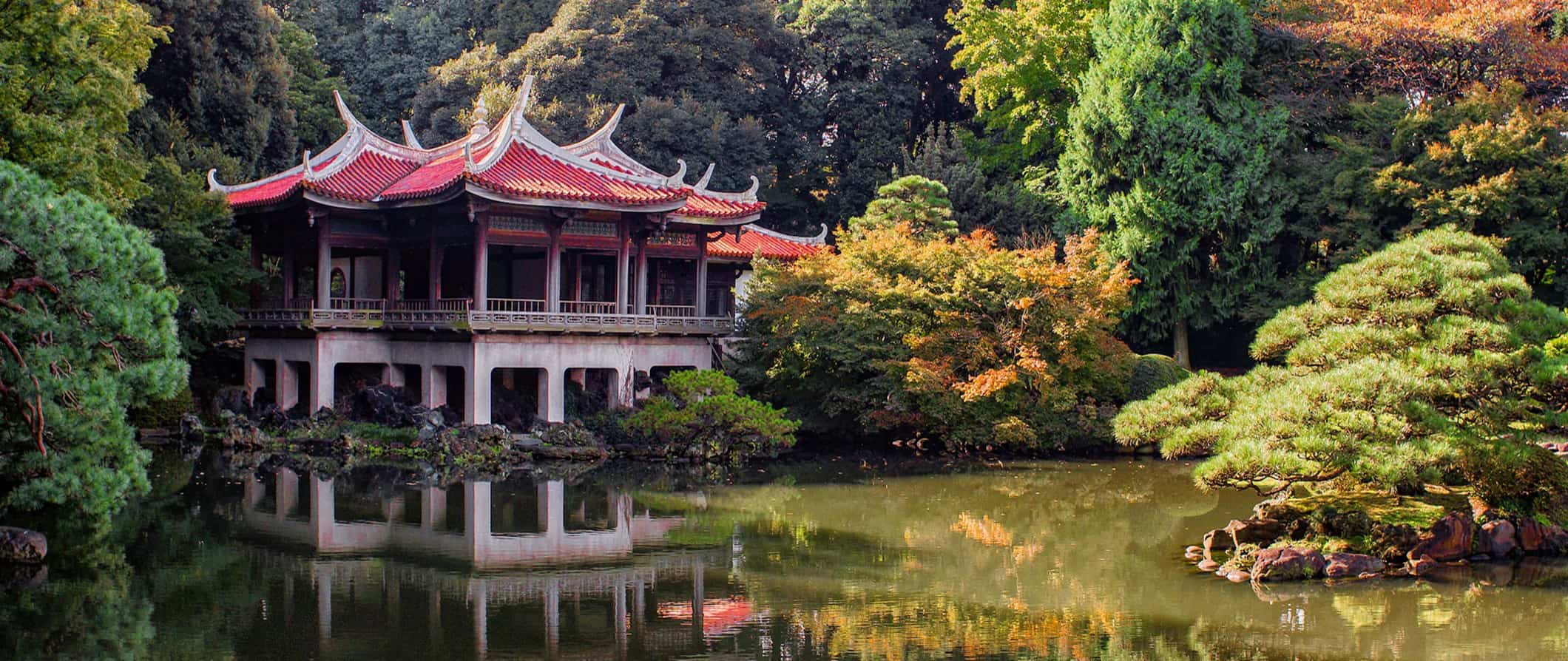
It was a lifelong dream to visit and, when I finally did, it lived up to all my expectations. Since that first visit, I’ve been there over five times. Japan is a country that blows everyone away. From the food to the people to the architecture and everything in between, I’ve never met someone who didn’t go to Japan and fall in love with it.
A lot of people delay visiting Japan because they think it’s super expensive. And, while some aspects of traveling there are expensive, there are plenty of ways to make it affordable. I was actually shocked how easy it was to see Japan on a budget .
This Japan travel guide can help you plan an affordable trip so you can see more, eat more, and spend less.
Table of Contents
- Things to See and Do
- Typical Costs
- Suggested Budgets
- Money-Saving Tips
- Where to Stay
- How to Get Around
- How to Stay Safe
- Best Places to Book Your Trip
- Related Blogs on Japan
Click here for City Guides
Top 5 things to see and do in japan.
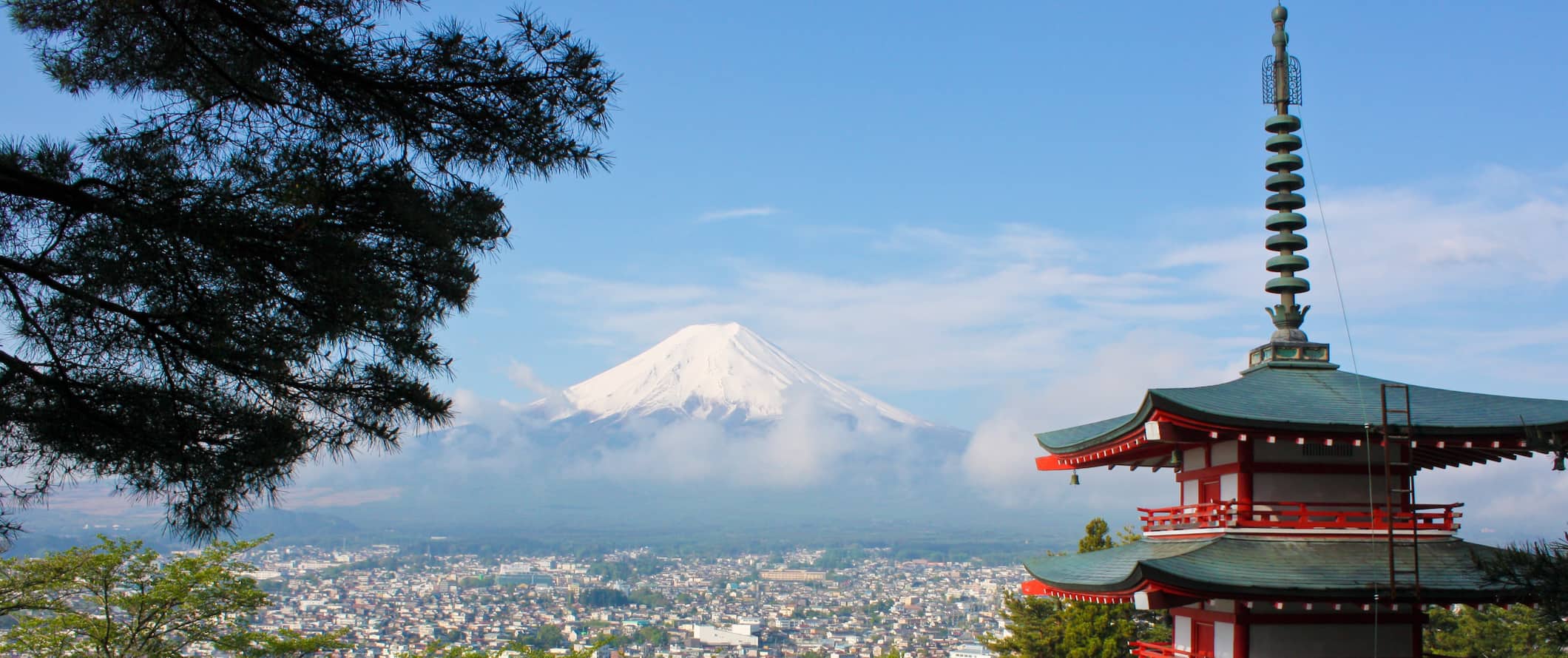
1. Explore Tokyo
Tokyo is one of the best cities in the world. Here you will find shrines, palaces, temples, hip clubs, fancy cocktail bars, weird fashion, and, of course, incredible people. Tokyo is a fast-paced, futuristic city. Be sure to also hit some of the quirky-themed cafés, wander the Harajuku district, walk across the iconic Shibuya crossing, and admire the Imperial Palace. Visit my detailed guide for more information .
2. Wander Kyoto
Boasting beautiful temples and Japanese gardens, Kyoto is one of the most popular destinations in Japan. This place definitely lives up to the hype because it retains much of the traditional lifestyle and is a good juxtaposition to fast-paced and high-tech Tokyo. See as many temples as possible , wander the enchanting bamboo forest of Arashiyama, (just get there early to beat the crowds), and do some hiking here. It’s a city not to be missed.
3. See Hiroshima
In 1945, the first atomic bomb to be used in combat was detonated in Hiroshima . Around 80,000 people were killed instantly and tens of thousands more died afterward due to radiation exposure. Visit the Hiroshima Peace Memorial (Genbaku Dome), which was the only building left standing after the bomb was dropped on August 6, and learn about one of the most controversial events in human history. I found the museum’s photos and artifacts sobering and eye-opening, and yet a must-see if you want to understand modern Japan. You can also take a cycling tour around the city to learn more about the bombing and its aftermath.
4. Climb Mount Fuji
This 3,776-meter (12,389-foot) mountain is located near Tokyo. As Japan’s tallest mountain, it is often covered by fog and clouds during the day, so ascents tend to happen early in the morning or overnight. In fact, some 400,000 people take part during the short climbing season that is only from early July to mid-September. If you’re visiting outside of the climbing season or just don’t want to hike the mountain, there are many tour providers that offer day trips from Tokyo from around 12,000 JPY.
5. Visit Sapporo
The gateway to Japan’s northern island of Hokkaido, this city is famous for its surrounding mountains, thermal baths, ski resorts, and lengthy beer brewing history. Hosting the 1972 Olympic Winter Games put the city on the international map, and it remains hugely popular for its cold-weather sports. It’s also home to the hugely popular Sapporo Snow Festival, where you can see world-class ice and snow sculptures each February (over two million people attend!). Although Sapporo is very much a ski haven, I also loved going in Spring because of the lush greenery and in particular, the thousands of Japanese cherry blossoms in Moerenuma Park. Don’t miss the Beer Museum and be sure to take the train to the coastal town of Otaru for uni (which is harvested there).
Other Things to See and Do in Japan
1. visit the tsukiji and toyosu fish markets.
Tokyo’s fish markets start bright and early at 4am. Here you can see the frenzied buying and selling of the world’s largest tuna market. Tsukiji was the original market but, as of 2018, the inner fish market moved to Toyosu and is now known as the Toyosu Fish Market. However, the outer market (where you can find food and shops) is still at Tsukiji. You can take a guided tour to learn about its history, how it works, and even learn how to roll sushi in a workshop at the end. Shops start opening around 6am so it’s a perfect place to go when you have jetlag.
2. Spend a day in Kyoto’s Gion District
Otherwise known as the Geisha District, this neighborhood is filled with fascinating historic architecture and is a good area for window shopping. Geishas (traditional professional entertainers) have worked here for centuries, and if you’re lucky, you may be able to spot one going to or from a social engagement at one of the establishments. (Just note that photographs are forbidden on the narrow alleys to prevent harassment of the geishas.) You can also take a nighttime walking tour .
3. Explore Nara
Located just one hour from Kyoto , Nara is famous for its 1,300 “wild” deer that freely roam Nara Park. The Japanese consider deer to be messengers of the gods, so they are free to roam the city (their horns are cut short, so they can’t hurt people). There are vendors selling crackers all around the park, so you can feed them by hand. While here, be sure to take in the world’s largest wooden building, Todai-ji, which dates to the eighth century and was reconstructed in the 1700s. Most travelers visit Nara as a day trip from Kyoto, but I suggest staying at least a night to really see everything.
4. See Osaka
Osaka is the third-largest city in Japan and its financial heart. It’s also a big foodie hub. Mouthwatering sushi and sashimi, Kobe beef, Japanese barbecue, and flavorful ramen can all be found here in abundance. There are also popular specialties like okonomiyaki (a savory pancake with egg and vegetables) and kushikatsu (skewered kebabs). You can take a food tour for around 12,000 JPY or just wander and eat.
Beyond the food, don’t miss Osaka Castle. While it’s not the original (this version dates to 1931), it’s nevertheless an impressive sight. It’s home to a small but insightful museum and an observation deck that offers some picturesque city views.
5. Relax in Ueno Park
Established in 1873, Tokyo’s Ueno Park is a great place to spend the day. It’s the perfect spot to see the cherry blossom trees (April is the best time of year if you hope to catch them in full bloom). Year round, you will find events on the weekend, people hanging out here on a beautiful day, and plenty of museums to visit. The park is home to the Tokyo National Museum, a couple art museums, and a zoo. You can also take a three-hour architecture tour around the park .
6. Admire the Imperial Palace
The Imperial Palace is home to the emperor of Japan (whose lineage stretches back over a thousand years). It was built on the site of the former Edo Castle, which was originally constructed in the 15th century. Though you can’t go inside the palace itself, the surrounding grounds and park are beautiful, and you can watch the changing of the guard. You can visit select parts of the grounds on a 75-minute guided tour at 10am and 1:30pm Tuesday-Saturday. The Imperial East Gardens are free and open daily except Mondays, Fridays, and holidays. There’s also a lot of free walking tours that take you around and give you a history of the palace.
7. Visit Miyajima Island
Miyajima is a UNESCO World Heritage Site located about an hour outside of Hiroshima, known as “Shrine Island” because of its temple and iconic floating torii gate. Itsukushima Shrine, the main one here, dates back to the 12th century. There’s also a five-story pagoda that dates back to the 15th century, and the tranquil Momijidani Park, one of the most beautiful maple valleys in the country. And, like Nara, there are plenty of deer here too. A trip to the island can easily be made into a full day if you hit the walking trails nearby. And be sure to hike up Mount Misen — it’s a great workout, and the views are stunning! There is also a cable car to the peak you can take for 2,000 JPY round-trip.
8. Tour Bitchu Matsuyama Castle
At 430 meters (14,100 feet), not only is this Japan’s highest castle but it’s also its only remaining original one (most were destroyed in fires or during World War II). The castle was originally built on a nearby mountain in 1240 by Akiba Shigenobu. In 1929, restoration work began, and it is now a popular tourist site. Admission is 500 JPY for just the castle or 1,000 JPY for the castle, temple, and nearby samurai houses. If you’d like to patronize the Takahashi Folk Museum and Yamada Hokoku Museum, the entire combined ticket costs 1,500 JPY.
9. Go on the temple pilgrimage
The 88 Temple Pilgrimage (also known as “Shikoku Henro”) is an ancient route that circles the island of Shikoku, one of Japan’s four main islands. Under consideration for UNESCO status, the route stretches 1,200 kilometers (745 miles) and can take between 30 and 60 days. Pilgrims typically wear special white robes and carry a walking stick so they stand out (locals take pride in helping and welcoming pilgrims so standing out is a good thing). It’s one of the only circular pilgrimages in the world, with roots dating back over a thousand years. Between 150,000 and 200,000 people do the hike each year. In addition to the 88 official temples, there are also 20 additional sites you can visit as well. Most pilgrims hike between March-May or October-November since the summer is too warm. If mobility is an issue, you can also explore the route via car or bus, which takes around 10 days.
10. Explore Nikko
Located two hours north of Tokyo in the mountains, Nikko has welcomed worshippers of both Buddhist and Shinto traditions for centuries, so there are many temples and shrines in the woods to visit. Nikko is also the home of the imperial summer palace (the only imperial residence opened as a museum) and the resting spot of Tokugawa Ieyasu, the first shogun of Tokugawa Shogunate (1603–1868). You’ll also find lots of waterfalls in the area and a beautiful lake to go boating on. The trails at nearby Nikko National Park offer excellent hiking. Don’t miss Nikko Toshogu, Kegon Falls, Ryuzu Falls, Shinkyo Bridge, Lake Ch?zenji, Kanmangafuchi Abyss, and the Imperial Palace! Only a few hours from Tokyo, Nikko is a really nice destination for two or three nights.
11. Stay in a ryokan
A ryokan is a traditional Japanese bed-and-breakfast, usually found in the more scenic regions. They date back over 1,200 years and are known for their traditional tatami floors, communal baths, sliding doors, and cozy interiors. Ryokan s make for an intimate and unique Japanese experience, featuring included meals and traditional Japanese robes (called yukata ). Beds are traditional futons, and there is usually a common area where you can make tea and chat with the owner.
12. Soak in an onsen
Natural hot springs are widespread throughout the country, and can be found both indoors and outdoors. They are a great way to “soak in” some traditional Japanese culture. Each has a different mineral composition. Expect to pay around 1,000 JPY for a budget bathhouse. (Just note that many do not allow people with tattoos or require tattoos to be covered. They are also separated by gender.) Hakone is the most popular onsen destination as it’s just 90 minutes away from Tokyo and is nestled into the mountains. Other popular choices include Beppu, Yufuincho, Noboribetsu, and Ibusuki.
13. Explore Daisetsuzan National Park
If you make it all the way up to Hokkaido (the northern prefecture of Japan and second-largest island), be sure to spend some time exploring Daisetsuzan (“Great Snowy Mountains”) National Park. Located around two hours from Sapporo, the park offers numerous trails, and some of the most rugged and beautiful landscapes in the country. It’s also one of the last remaining places in Japan to see brown bears. The most popular hike here is Mount Asahidake, a challenging volcano that takes 3-4 hours. The park is a far cry from the tourist trail and usually just sees Japanese visitors, so you’ll get to enjoy a spot locals favor.
14. Relax in Okinawa
If you need a break from the fast pace of Japan, hop on down to Okinawa Prefecture, considered “the Hawaii of Japan.” Life proceeds at a much slower pace here, and the climate is subtropical. Even Naha, the biggest city in the region, is laid-back. Okinawa is famous for its diving opportunities as well as World War II sites and memorials. From Okinawa Honto (the main island), you can hop to other smaller islands by ferry, including some that are very remote and rarely see visitors (such as Iriomote or Kume). Camping, whale watching, and hitting the beach are some of the most popular activities here.
15. Admire Kanazawa
Located on the west coast, Kanazawa is known for its incredibly well-preserved Edo-era (1603–1868) districts (the final period of traditional Japan). Home to under 500,000 people, the city is called “Little Kyoto” — but without the oppressive crowds. I think this is a really nice, off-the-beaten-path destination. Make sure to see Tsuzumi-mon Gate, admire Kanazawa Castle, and explore the geisha districts and samurai district (Nagamachi), where numerous preserved houses remain. Head to the Omicho Fish Market for fresh fish and seafood (there are dozens and dozens of stalls here). And if you want to learn more about Buddhism, visit the DT Suzuki Museum (Suzuki was a Zen Buddhist academic and philosopher who helped introduce Zen Buddhism to the West).
16. Hike in the national parks
Japan may be a small country but it’s preserved a lot of its natural landscapes. There are 34 national parks, each offering respite from the hectic and dense cities that Japan is known for. Nikko (mentioned above) is best for seeing fall colors; Daisetsuzan (also mentioned above) has lots of remote onsen and challenging trails; Keramashoto, located in Okinawa, has some of the best islands and beaches, as well as over 250 types of coral; and Yoshino-Kumano is famous for its cherry blossoms. There are a lot of parks to choose from! Try to see at least one!
17. Visit Takashima
Home to just 50,000 people, Takashima is just a short drive from Kyoto on the coast of Lake Biwa (the largest freshwater lake in Japan). The city boasts castle ruins, plenty of old shrines and Buddha statues, and a picturesque floating torii gate (similar to the one in Miyajima) at the Shirahige Shrine. There’s also a four-kilometer (2.5-mile) walking route lined with cherry trees. Moreover, this town is famous for its Hida beef, which I think is the best beef in all of Japan. For a fun day trip, head to Chikubushima, a small island on Lake Biwa where you can visit centuries-old temples as you hike around the island.
For information on specific cities in Japan, check out these city guides:
- Hiroshima Travel Guide
- Kyoto Travel Guide
- Tokyo Travel Guide
Japan Travel Costs
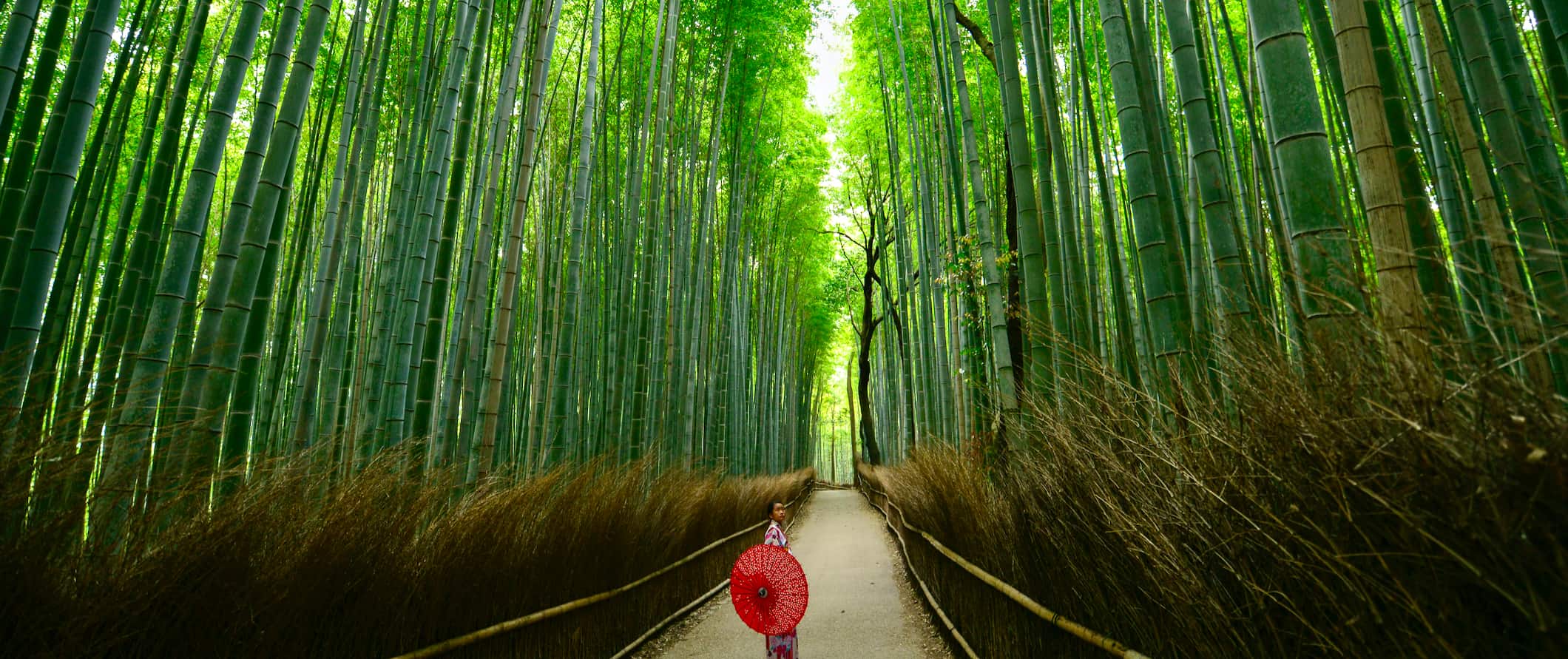
Accommodation – Expect to spend 2,500-4,500 JPY per night for a dorm room in a hostel (prices are on the higher end in larger cities like Tokyo or popular tourist destinations like Kyoto). Free Wi-Fi, private lockers, and self-catering facilities are standard in most hostels. But it’s uncommon for them to provide breakfast here. For a private room with a twin or double bed, expect to pay 6,500-15,000 JPY per night. Prices are generally the same year-round.
Capsule hotels cost 3,000-5,500 JPY for a tiny coffin-like pod that’s essentially just a bed, often with a small TV, light, and outlet to charge your devices. There are shared bathrooms and sometimes a small common room as well. It’s not fancy, but it’s a unique (and very Japanese) experience.
For (non-capsule) budget hotels, expect to spend 6,000-10,000 JPY per night for a double room. For Western hotel chains, expect to spend around 20,000 JPY or more per night. Note: For accommodation in Tokyo, add 50% to all these prices.
Airbnb is heavily regulated in Japan and, as such, there aren’t too many options. What rooms are listed are mostly hotels and guesthouses. Private homes/apartments usually start around 15,000-20,000 JPY per night, while private rooms (i.e., hotel rooms) run 8,000-10,000 JPY per night and up.
If you are looking for a more unique experience, consider staying at a ryokan , a traditional Japanese bed-and-breakfast. While they are more expensive than a standard hotel, it’s a unique and memorable experience, as you’ll get to sleep on traditional futons and tatami mats.
Food – Japanese cuisine is world-renowned and has even earned a spot on UNESCO’s Intangible Heritage List. While each region has its own specialties, rice, noodles, seafood, and seasonal produce all feature heavily no matter where you are. Plus, there’s izakaya (small plates), yakitori (grilled food), curry bowls, BBQ, and so much more. One of the best things about visiting Japan is the food.
Food in Japan is relatively inexpensive so long as it’s not imported (fresh fruit will blow your budget!). The most common cheap eats are using curry, donburi (bowls of meat and rice), or ramen. Curry and donburi bowls cost 500-700 JPY while ramen or soba noodles are usually around 1,200 JPY. Okonomiyaki (a Japanese pancake with noodles or rice) is between 1,000 and 1,300 Yen.
Fast food (think McDonald’s) is around 800 JPY for a set menu. You can also find plenty of cheap meals and prepackaged items at 7-Eleven (locals actually get a ton of food here as it’s delicious and quick). Noodles, rice balls, tofu, and prepackaged sushi are all available for only 250-500 JPY per item. (Trust me, it’s good!)
Most sit-down restaurant meals are going to cost you 2,000-3,000 JPY. Sushi conveyor belt restaurants (which are super fun) will run you 125-600 JPY per piece. Quicker lunch spots are going to be around 1,500 Yen.
Fine dining is a tradition rooted in Japanese culture, and kaiseki ryori is a style of high-end, multi-course Japanese dining that originated in Kyoto. It costs about 8,000-10,000 JPY for a set menu of seven courses, covering everything from chicken to Wagyu steak to sushi.
High-end omakase sushi restaurants (where dishes are selected by the chef) will set you back at least 10,000 JPY, though more likely closer to 20,000 JPY. (In Tokyo, the best ones are 30,000 JPY.)
Domestic beer is around 450-550 JPY, and sake is about 800-900 JPY per glass. A cocktail will set you back about 1,200 JPY, though at the famous cocktail bars in Tokyo, expect to pay closer to 1,600 Yen per drink. A latte or cappuccino is 500-600 JPY, and a bottle of water is 100-130 JPY. Soda is around 200 Yen.
Expect prices to be higher in the bigger cities and cheaper in the countryside.
Buying groceries costs around 5,000-6,000 JPY per week for basic staples like rice, vegetables, and fish. However, given the availability of such cheap food, it’s doubtful you’ll go grocery shopping to prepare your own meals.
Backpacking Japan Suggested Budgets
If you’re backpacking Japan, plan to budget 7,000 JPY per day. This assumes you’re staying in a hostel dorm, cooking some of your meals, eating at the cheap restaurants and takeaways, visiting free museums and temples, and using public transportation to get around.
On a more midrange budget of 16,000 JPY per day, you can stay in nicer accommodations, eat out more liberally, indulge in more drinks, visit more attractions, and, overall, just have some more breathing room in your travels! On this budget, you’ll be able to do most things.
On an upscale budget of 28,000 JPY per day or more, you can stay in traditional Japanese accommodations or two-star hotels, eat at nicer restaurants each day, splurge on some meals, enjoy drinks as often as you want, take tours, and, overall, just afford whatever you want!
You can use the chart below to get some idea of how much you need to budget daily, depending on your travel style. Keep in mind that these are daily averages — some days you’ll spend more, some days you’ll spend less (you might spend less every day). I just want to give you a general idea of how to make your budget. Prices are in JPY.
Japan Travel Guide: Money-Saving Tips
I think Japan’s reputation as an expensive country is overstated. Outside of accommodation and transportation, it’s actually really affordable. Is it super cheap? No. Is it super expensive? Not at all. There are plenty of ways to lower your costs and all non-imported food is really inexpensive. Here are some ways to save money when you visit:
- Visit the free attractions – With its countless museums, galleries, shrines, temples, historic neighborhoods, and parks, Japan is filled with opportunities to immerse yourself in its culture without spending a Yen. Moreover, many of the nation’s parks and gardens are also free. Start with them and you’ll fill your days on the cheap!
- Get a JR Pass – The bullet trains in Japan are ridiculously expensive, with one-way fares costing hundreds of dollars. If you plan to do a lot of traveling around the country, get the JR Pass , which allows you unlimited train travel and can save you a ton of money. It comes in 7-, 14-, and 21-day options. (Keep it mind it can only be purchased outside of Japan, so be sure to plan ahead.)
- Take the bus – Buses are a far more economical option than the trains. They cost a fraction of the price. For example, the unlimited Japan Rail Pass costs 29,650 JPY for seven consecutive days of travel, but this is far more expensive than using the bus. But buses take a lot longer. For example, the two-hour bullet train ride from Tokyo to Osaka becomes a 10-hour bus ride. Bottom line: if you have the time, take the bus.
- Shop at the 100-yen stores – There are many 100-yen shops around the country. They all sell meal sets, groceries, water bottles, toiletries, and household items. Store names vary by region, so ask your hotel or hostel reception where the nearest “Hyaku En” store is located.
- Eat at 7-Eleven – 7-Eleven, Family Mart, and other convenience stores have a lot of pre-made meals that make for a cheap lunch or snack. The food is actually really good and you’ll always see locals dipping in and getting a quick lunch or snack here. Don’t be afraid to at them.
- Cook your own food – Many hostels have kitchens where you can cook your own meals. Combining this with shopping at the 100-yen stores will drastically cut your food costs.
- Eat curry, ramen, and donburi – These dishes are the best option for eating cheap, filling meals. These cost from 400 – 1200 Yen (ramen is 1200). Shops specializing in these dishes are all over the country so you can easily find them. They are on every corner and the cheapest way to eat on a budget.
- Stay with a local – Using hospitality sites like Couchsurfing allows you to stay with residents, so you not only get a free place to stay but you get to interact with someone who can share their insider tips.
- Buy food before grocery stores close – After 8pm, many supermarkets discount their fresh food, as they have to get rid of it by law. You can save up to 50% on almost all ready-made meals. It’s a great cheap dinner.
- Hitchhike – Japan is one of the world’s safest countries, and many locals are curious enough to pick up foreign visitors. Hitchhiking isn’t really practiced by Japanese, so you will stand out as a tourist, which will increase your chances of finding a ride.
Where to Stay in Japan
There’s a lot of affordable accommodation in Japan, especially if you avoid Western style hotels and chains. To help you save money on accommodation, here’s my list of the best hostels and budget hotels in Japan:
- Hostel Chapter Two Tokyo (Tokyo)
- Hotel Century Southern Tower (Tokyo)
- Backpacker Hostel K’s House Kyoto (Kyoto)
- Gojo Guest House (Kyoto)
- The Pax Hostel Records (Osaka)
- Roku Hostel Hiroshima (Hiroshima)
- Guesthouse Akicafe Inn (Hiroshima)
- WeBase HAKATA Hostel (Fukuoka)
How to Get Around Japan
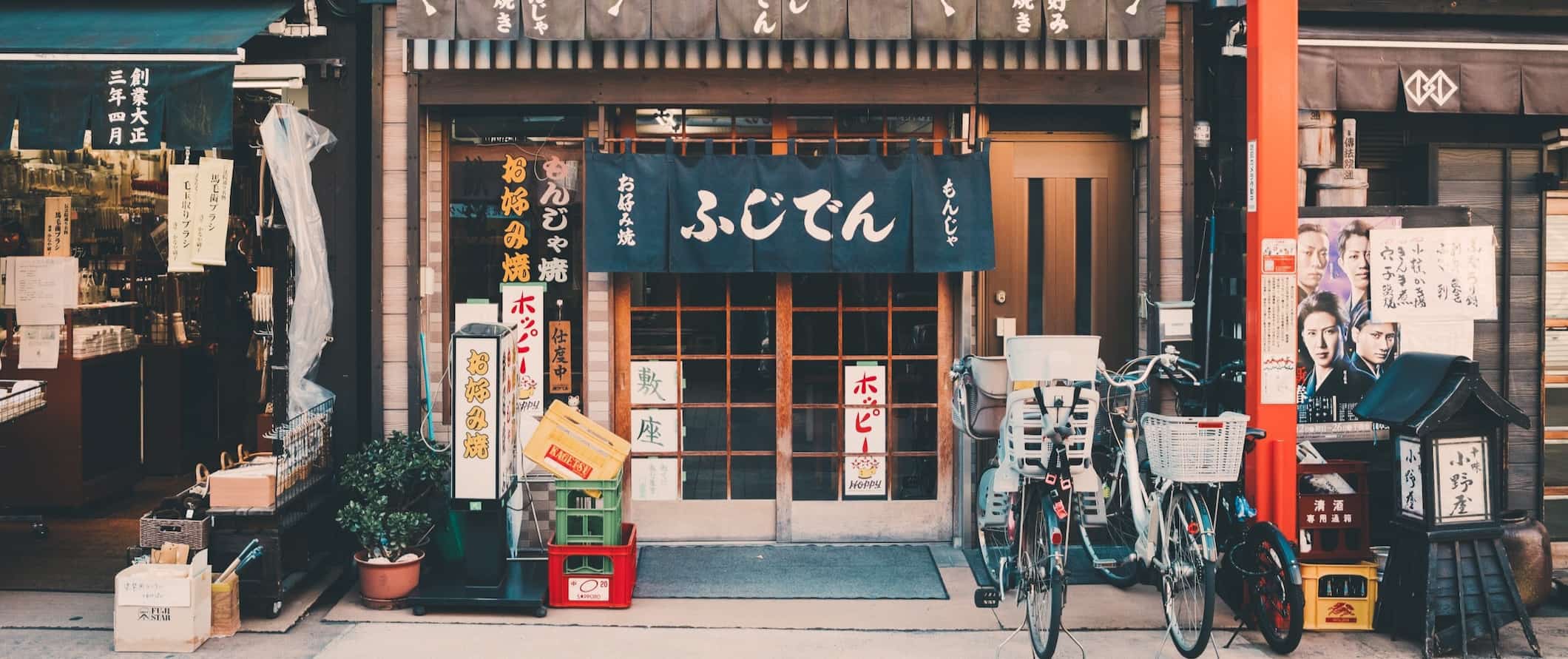
Public transportation – Metro or bus tickets cost 150–300 JPY for a single journey. (The price varies by distance and may often be higher.) Fares are usually around 220 JPY to travel across Tokyo but less for shorter distances. In most major cities, you can buy a day pass, which gives you unlimited travel for 24 hours for around 800-1,100 JPY.
Train – Train travel is the quickest way to get around Japan. The bullet train is awesome, comfortable, and super-fast — but it’s not cheap. Individual tickets can cost hundreds of dollars. In order to reduce your train costs, get a Japan Rail Pass , which is indispensable for travel here.
Even if you just get the seven-day pass, it’s the same price as a round-trip train ticket from Osaka to Tokyo. Moreover, the JR trains also serve urban areas and so can be used within cities. I used my pass to get around Kyoto and Tokyo instead of buying metro tickets.
So, even if you aren’t going to do much traveling around Japan, buying a pass is better than buying individual tickets. While the high price of the pass can cause sticker shock, the alternative is worse.
Additionally, be sure to download the Navitime app . It has offline maps, train and public transit routes, and info on train stations. It’s a lifesaver when trying to figure out how to get around the country.
Bus – Buses are a less expensive alternative to the bullet train system in Japan, but they take more time. For example, the two-hour bullet train ride from Tokyo to Osaka becomes a ten-hour bus ride. The price for that seat is 4,500-8,000 JPY, but at some point, you need to think about how much your time is worth.
There are also bus passes that offer unlimited travel and begin at 10,200 JPY for three nonconsecutive days of travel. You can use these two websites to book your bus journeys:
- Willer Express
- Japan Bus Lines
If you have more time than money, take the bus. Otherwise, I’d say splurge and take the train, because they really are much faster and much, much more comfortable.
Flying – Generally, flight prices are on par with bullet train tickets. ANA, one of the country’s two main carriers, offers special last-minute fares via a hidden page on its website , usually for around 14,000 JPY for a seat. It’s only available to foreigners and can sometimes be cheaper than the flights you find on booking platforms, especially for longer routes around the country.
Flights from Tokyo to Okinawa are around 23,000 JPY (round-trip) while those from Tokyo to Sapporo are around 16,000 JPY (round-trip).
Car rental – With efficient public transportation and nationwide bullet trains, renting a car here really isn’t necessary. However, if you do need one, multi-day rentals start at 6,000 JPY per day. Just remember that people drive on the left here! For the best car rental prices, use Discover Cars .
When to Go to Japan
Temperature and weather vary drastically across Japan, meaning it’s always a good time to visit some part of the country. While most of Japan does have four seasons (including snowy, freezing winters in the north), Okinawa and the islands in the south are warm year-round. It gets cold in Tokyo, but it generally doesn’t snow.
Expect warm, humid weather from June through August, with temperatures hovering around 32°C (89°F). Japan also gets a lot of rain, mostly in the summer months, from mid-June to mid-July. It gets a little drier in August, before the precipitation picks up again in September. Typhoon season occurs from May to October. Japan is well-equipped to handle all types of typhoons, but be sure to purchase travel insurance in advance !
Overall, there’s no real bad time to visit. Winter is awesome for skiers or snowboarders, spring is famous for its cherry blossoms, summer is full of festivals, and fall has brilliant autumn colors and nice temperatures. I personally prefer spring and fall, as the summer heat and humidity is pretty oppressive.
How to Stay Safe in Japan
Japan is a very safe country. There’s virtually zero chance you’re going to get robbed, scammed, or hurt here. Your biggest issues will most likely come from other foreigners who get drunk and are causing trouble.
Solo female travelers should generally feel safe here, but the standard precautions apply (never leave your drink unattended at the bar, never walk home alone intoxicated, etc.). Japan does have a problem with groping, especially on packed trains. Most train companies now have “women-only” cars during rush hour (you’ll see pink signs indicating where women should board).
Scams in Japan are nonexistent. No one is going to rip you off. The listed price is the listed price and the same for everyone. There are no tourist prices here.
Your main risk here is from Mother Nature. Earthquakes and typhoons aren’t uncommon, so make note of exits when you arrive at your accommodation. Download offline maps to your phone, as well, in the event you may need to navigate the city during an emergency.
If you do experience an emergency, dial 110 or call the nonemergency Japan Helpline at 0570-000-911.
The most important piece of advice I can offer is to purchase good travel insurance. Travel insurance will protect you against illness, injury, theft, and cancelations. It’s comprehensive protection in case anything goes wrong. I never go on a trip without it, as I’ve had to use it many times in the past.
Japan Travel Guide: The Best Booking Resources
These are my favorite companies to use when I travel. They consistently have the best deals, offer world-class customer service and great value, and overall, are better than their competitors. They are the companies I use the most and are always the starting point in my search for travel deals.
- Skyscanner – Skyscanner is my favorite flight search engine. They search small websites and budget airlines that larger search sites tend to miss. They are hands down the number one place to start.
- Hostelworld – This is the best hostel accommodation site out there with the largest inventory, best search interface, and widest availability.
- Agoda – Other than Hostelworld, Agoda is the best hotel accommodation site for Asia.
- Booking.com – The best all around booking site that constantly provides the cheapest and lowest rates. They have the widest selection of budget accommodation. In all my tests, they’ve always had the cheapest rates out of all the booking websites.
- Get Your Guide – Get Your Guide is a huge online marketplace for tours and excursions. They have tons of tour options available in cities all around the world, including everything from cooking classes, walking tours, street art lessons, and more!
- SafetyWing – Safety Wing offers convenient and affordable plans tailored to digital nomads and long-term travelers. They have cheap monthly plans, great customer service, and an easy-to-use claims process that makes it perfect for those on the road.
- LifeStraw – My go-to company for reusable water bottles with built-in filters so you can ensure your drinking water is always clean and safe.
- Unbound Merino – They make lightweight, durable, easy-to-clean travel clothing.
- Japan Rail Pass – This is a flexible transportation pass used for navigating Japan. Similar to the Eurail pass in Europe, it turns expensive bullet trains into budget-friendly modes of transportation. You honestly can’t visit Japan without one.
Japan Travel Guide: Related Articles
Want more tips? Here are all the articles I’ve written on Japan travel to continue planning your visit:
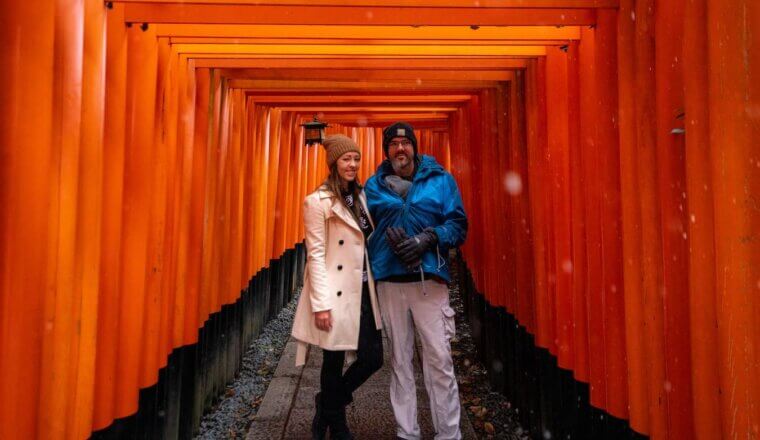
How to Travel Japan with a Baby
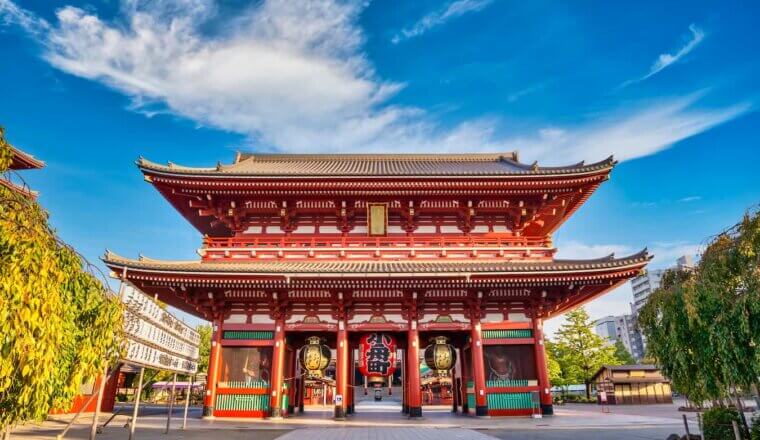
Where to Stay in Tokyo: The Best Neighborhoods for Your Visit
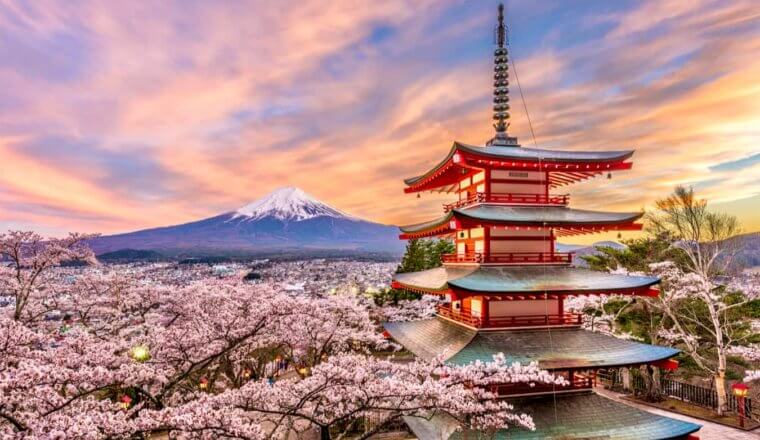
The Ultimate Japan Itinerary for First-Timers: From 1 to 3 Weeks
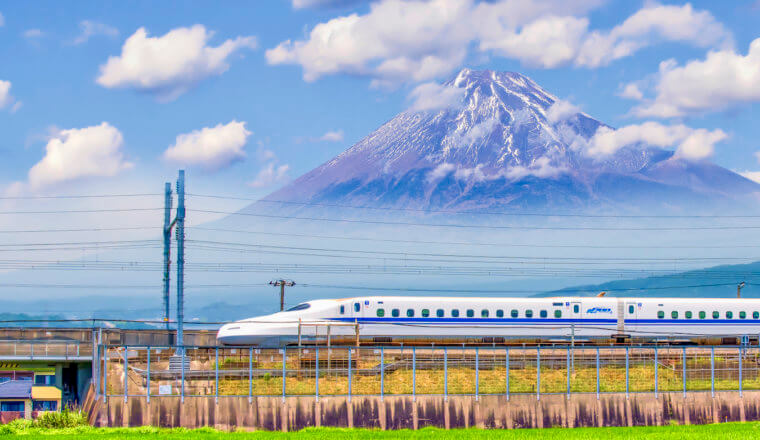
A Complete Guide to the Japan Rail Pass
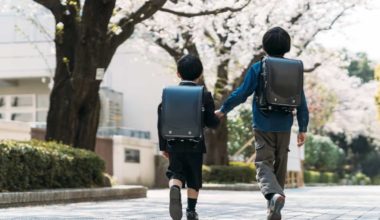
How to Teach English in Japan
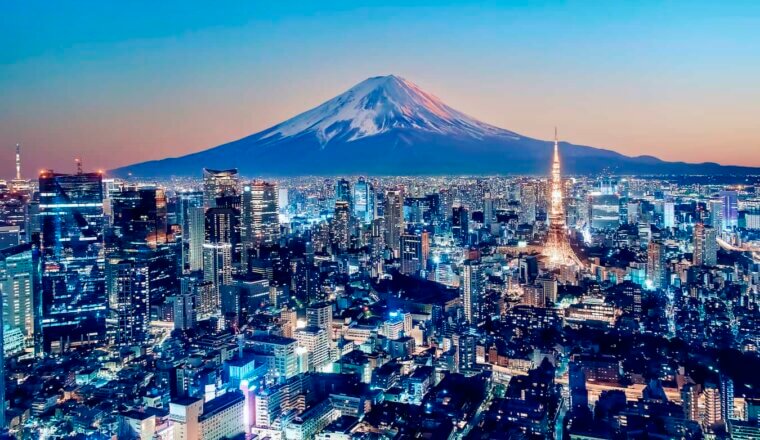
The 30 Best Things to Do in Tokyo
Get my best stuff sent straight to you, pin it on pinterest.
- Where To Stay
- Transportation
- Booking Resources
- Related Blogs
Japan on a budget: 17 ways to get more for your yen

Mar 28, 2024 • 7 min read

These top tips to low-cost living can help you stretch your budget on a trip to Japan © Monzenmachi/Getty Images
Japan has a reputation as an expensive place to travel, but it’s an image that doesn’t hold up on the ground.
With a little strategy, a visit can be very reasonable – budget-friendly, even. Many of the country’s major sights, for example, cost nothing, and free festivals take place year-round.
With these top tips on finding the best-value places to stay, the right transportation tickets and places to eat that suit all tastes and wallets, you can make your yen go further on a visit to Japan .
A guide to daily costs in Japan
- Capsule hotel room: ¥4,000 (US$30)
- Basic room for two: ¥8,000 (US$60)
- Self-catering apartment: (including Airbnb) ¥6,000 (US$45)
- Coffee: ¥400 (US$3.50)
- Sandwich: ¥300 (US$2.20)
- Beer/pint at the bar: ¥600 (US$4.50)
- Dinner for two: ¥5,000 (US$38)
- Hour of karaoke for two: ¥2,000 (US$15)
1. Consider staying in a business hotel
These economical (and, to be honest, rather utilitarian) hotels offer the best prices for private rooms with en suite facilities.
It’s possible to find double rooms for as low as ¥8,000 (and single rooms for as low as ¥6,000), though these will be a little more expensive in cities like Tokyo , Kyoto and Osaka .
Look for places that include a free breakfast buffet – they can be substantial enough to keep you going for hours.
2. Book direct at a guesthouse or hostel
Japan has fantastic guesthouses and hostels all over; not only are they generally clean and well-maintained, but friendly English-speaking staff are usually on hand to offer near concierge-level service.
A double or single room is comparable to a business hotel (but usually has shared facilities); dorm beds cost around ¥3,000.
Some places do charge extra for towel rentals, so you can save a few yen by bringing your own. Note that rates are often slightly cheaper if you book directly rather than through a booking site.
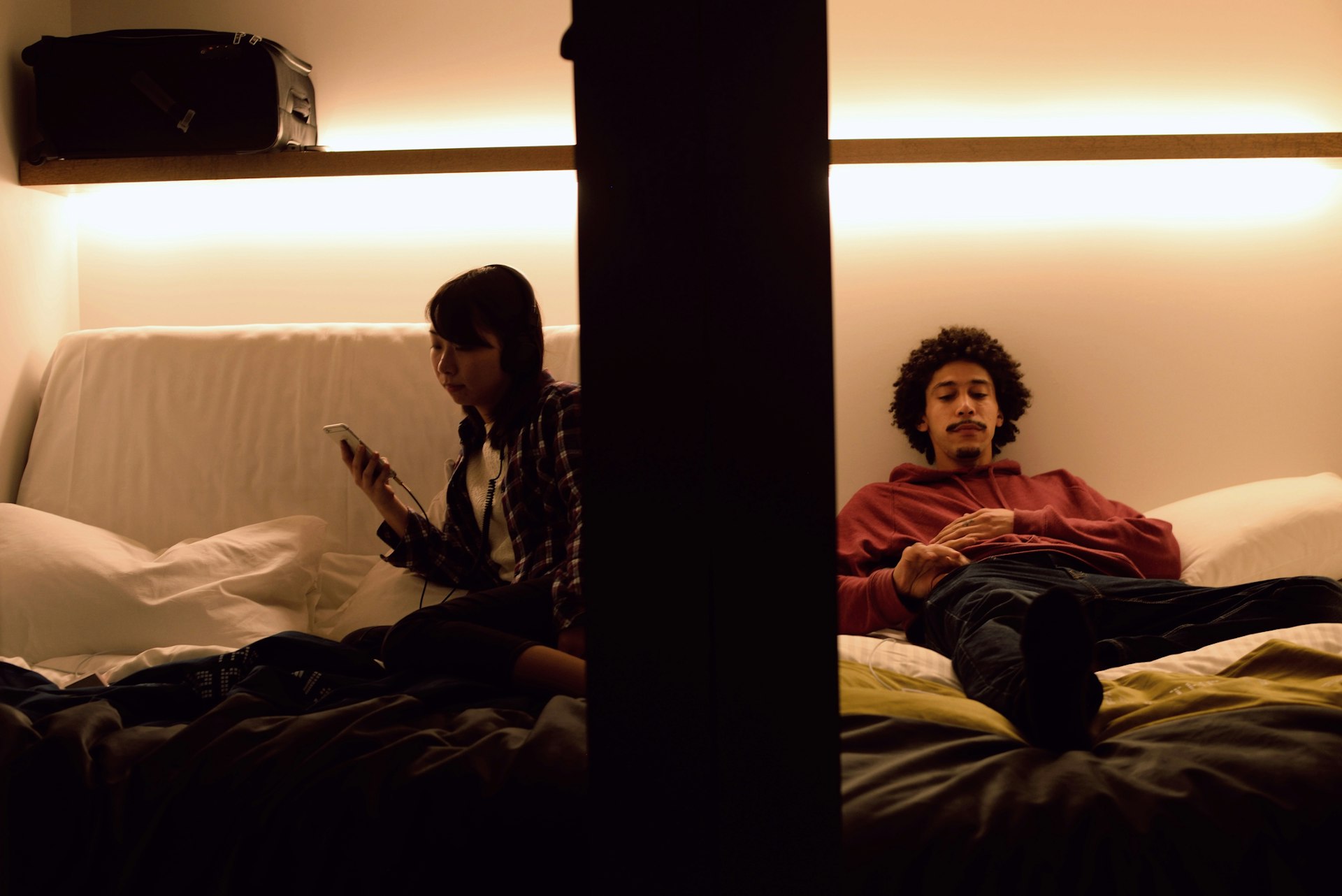
3. Sleep in a capsule hotel in the cities
Capsule hotels, which offer small rooms with enough space for just a bed, provide a budget-friendly place to spend the night.
A capsule berth costs slightly more than a dorm bed in a hostel (¥4,000 per night), but you get more privacy.
You probably wouldn’t want to stay every night in a capsule, but they’re good for saving money in cities where hotels are pricier.
4. Go camping in the summer months
If you really want to do Japan on the cheap, you can rely on its network of well-maintained campsites in rural or resort areas; prices range from ¥500 to ¥1,000 per person or tent. Note that many sites are only open in the summer.
5. Swap a night in a hotel for an overnight bus ride
Long-distance buses, like those operated by Willer Express , are the cheapest way to get around, and longer routes have night buses, which saves a night on accommodation. There are also bus passes, which can make this an even cheaper option.

6. The Japan Rail Pass is a great travel bargain
Like the famous Eurail Pass, the JR Pass is one of the world’s great travel bargains and is the best way to see a lot of Japan on a budget.
It allows unlimited travel on Japan’s brilliant nationwide rail system, including the lightning-fast shinkansen (bullet train).
There are also more regionally specific train passes that are cheaper, so examine your itinerary carefully before deciding. Purchase a pass online or from a travel agent like JTB in your home country.
7. Ride local trains for less with the Seishun 18 Ticket
The Seishun 18 is another great deal, but with very specific conditions: for ¥12,050, you get five one-day tickets good for travel on any regular Japan Railways train (meaning not the shinkansen or any high-speed limited express trains) during a limited period of a few weeks.
The Seishun 18 Ticket is only available at certain times during the year – during school holidays (the ticket is designed for students, but there’s no age cap) – and can only be purchased from JR ticket windows in Japan.
If the timing works, and you’re a fan of slow travel, this is a unique, ultra-cheap way to get around in Japan .
8. Consider renting a car to go beyond the cities
Highway tolls and petrol in Japan are expensive; however, renting a car can be economical if you’re traveling as a group or family, or are plotting an itinerary that takes you away from major rail hubs.
9. Take domestic flights with low-cost airlines
Japan has several budget carriers, like Peach , Jetstar and Air Do , that offer bus-like pricing on some routes – just be sure to factor in the time – and cost – of going to/from the airport.

10. Japan’s shrines and temples are free to visit
The vast majority of Shintō shrines in Japan cost nothing to enter. Likewise, the grounds of many temples can be toured for free (often, you only have to pay to enter the halls or a walled garden).
11. Eat cheap food and meet locals at a traditional festival
Throughout the year , festivals take place at shrines and temples and through city streets. They’re free, an excellent way to see traditional culture come alive, and are well attended by cheap food vendors.
12. Opt for hikes and walking tours
Going on a hike or a trek is free and can be the most rewarding part of your trip: explore an up-and-coming city neighborhood , walk old pilgrimage trails or rural lanes, or get up into the mountains in one of Japan’s national parks .
Japan’s cities, especially Tokyo, have some fantastic buildings designed by many of the big names in Japanese architecture. With a little bit of planning, you could chart your own architecture tour. Ask at a tourist information center or your accommodation for suggestions.
13. Spend time relaxing in the city parks
Urban parks are generally free to enter (and some gardens are, too) and are popular with locals on weekends; pack a picnic and settle in for an afternoon of people-watching. If you time your visit right, you could be bathing in the beauty of Japan's cherry blossoms .
14. Shop for cheaper goods at a local market
Many seaside towns have fish markets, some rural spots have morning markets, and some cities still have their old-fashioned open-air markets. Visits here are a great way to connect with local culture and are often a source of cheap, fresh food.
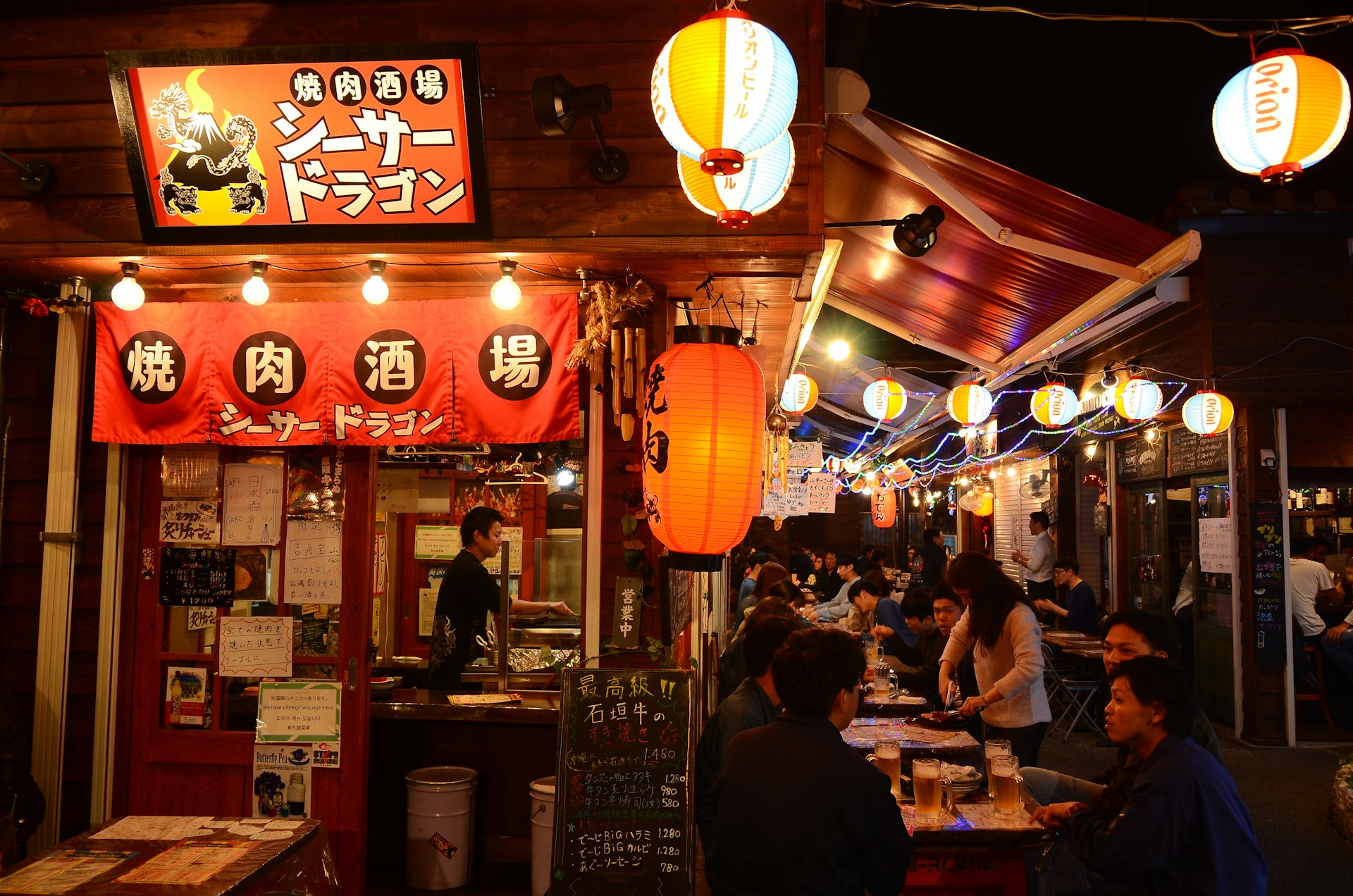
15. Choose the right dish in the right place to save money
You can get a good, filling meal in shokudō , Japan's answer to the greasy spoon, for under ¥1,000. A steaming bowl of tasty ramen can be picked up in many places for as little as ¥600.
Tachigui (stand-and-eat counter joints) sell soba (buckwheat noodles) and udon (thick white wheat noodles) for even less – starting as low as ¥350 per bowl.
Many upscale restaurants in Japan offer a smaller course at lunchtime for significantly less than they charge at dinner, so for a bargain deal have your larger meal then. In all restaurants in Japan, tea and water are complimentary, and tipping is not required.
16. Bentō are a budget alternative to a meal out
These "boxed meals," which include a variety of dishes, can be picked up for under ¥1,000 at supermarkets. Department store food halls sell gourmet ones for a little bit more; visit just before closing to buy them on markdown.
17. Get everything you need and more at the convenience store
Convenience stores are the best friend to all budget travelers. They stock sandwiches, rice balls, hot dishes and beer, all of which you can assemble into a very affordable (if not exactly healthy) meal. Accommodations always have kettles, so cup noodles are always an option.
Keep planning your trip to Japan:
Save this guide to the top things to do in Japan . Find out what to expect during every season from cherry blossoms to winter skiing . Before you book your trip, read these t op things to know before you go . Do you need a visa? Discover more here. Want to see Japan by train? Railway enthusiast John Walton shares his advice.
This article was first published May 2012 and updated March 2024
Explore related stories
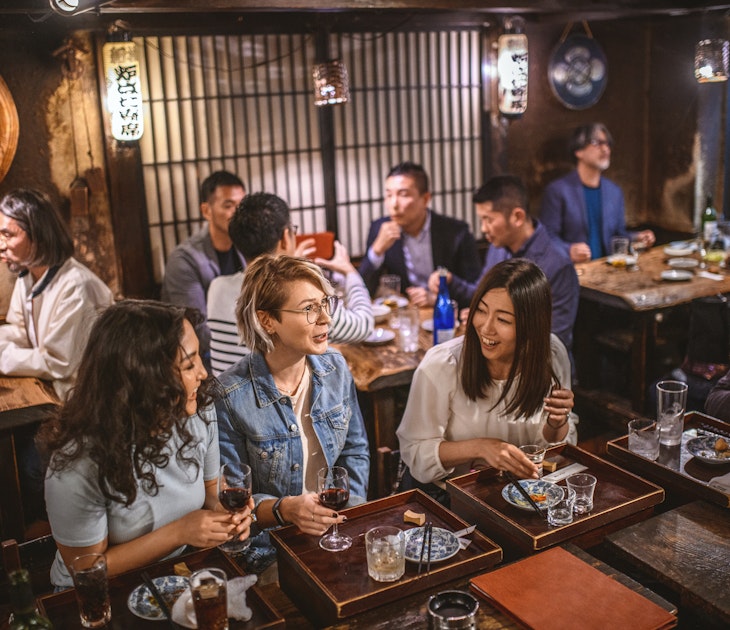
Budget Travel
Mar 23, 2024 • 7 min read
Tokyo is expensive but you don't need to max out your credit card to enjoy. Our insider tips and tricks will stretch your yen and save your bank account.
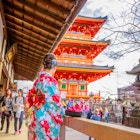
Dec 10, 2023 • 6 min read
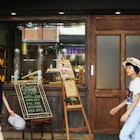
Oct 20, 2023 • 13 min read

Jan 29, 2020 • 9 min read

Jan 12, 2020 • 5 min read

Oct 28, 2019 • 19 min read

Apr 3, 2024 • 17 min read

Apr 2, 2024 • 10 min read

Mar 31, 2024 • 7 min read

Mar 28, 2024 • 6 min read

Budget Travel in Japan – Ultimate Backpacking Guide [2024]
- Last Updated: February 5, 2024
From seeing up close the famous Mt Fuji, exploring the architecture of Japanese castles to slurping down the best bowl of ramen you ever had, all these epic memories to-be-made are possible even with our guide to budget travel in Japan .
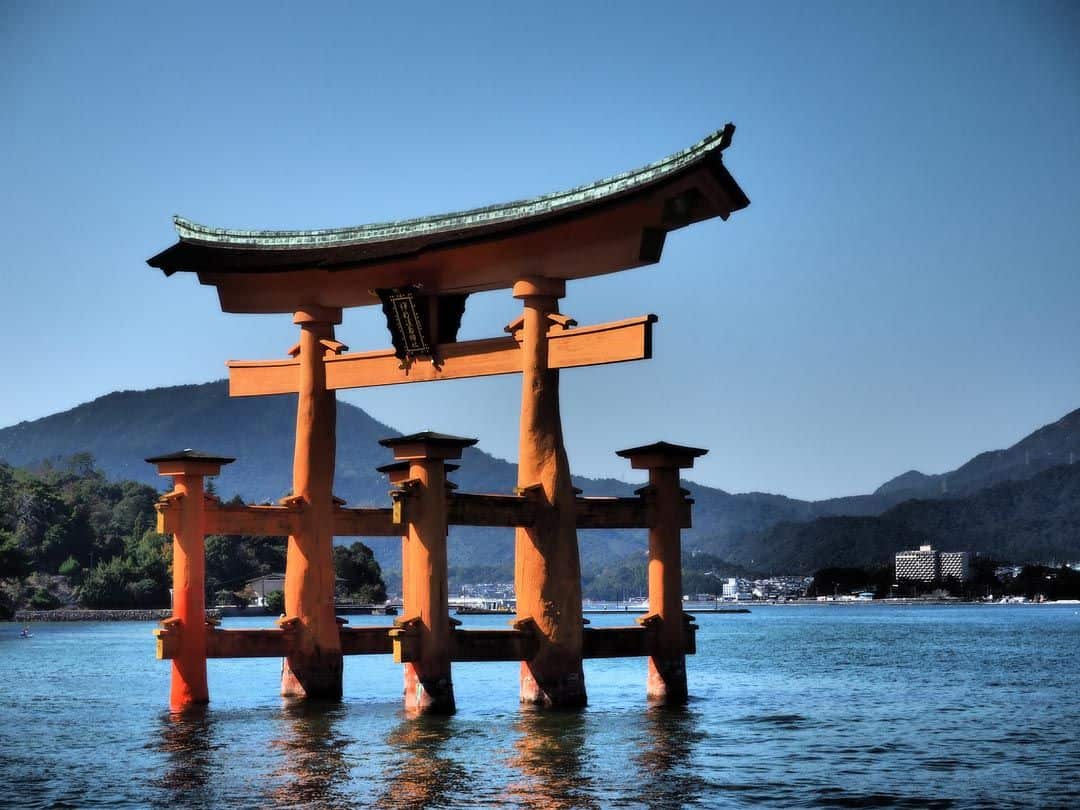
Today’s Japan is a fascinating example of blending the ancient traditions and modern day culture.
Throughout the country you’ll witness dynamic mountainscapes in stark contrast to futuristic cities that are inspiring new trends in architecture worldwide.
It’s also thought of to be notoriously expensive but we managed to travel to Japan on a budget, and so can you.
Table of Contents
Get A JR Rail Pass
Take some flights, deals in hiroshima, deals in osaka, deals in kyoto, deals in tokyo, cheap eating and drinking in japan, save this pin for later, budget travel in japan.
Japan has had a reputation as being expensive for a very long time, people paying hundreds of dollars for a piece of Kobe beef or a sliver of the finest blue fin tuna.
Prices of hotels can be among some of the most expensive in the world. Public travel, whilst incredibly reliable, can sometimes be quite expensive.
Well, some of this is true and some of it is a little more than a rumour that we have all perpetuated. Many people are put off traveling around for a long period of time because of the belief that the costs will be astronomical.
This isn’t always the case.
We have just finished 1 month of travel in Japan and it is comfortably cheaper than Australia, New Zealand, Western Europe and in some cases is even cheaper than China!
It sounds crazy, but here are a few really simple tips for budget travel in Japan that will save you some dollars on your next trip.
Note – At time of travel $1 USD was equal to about 110 Japanese Yen.
READ MORE: Don’t miss our brand new complete guide to help you travel to Japan!
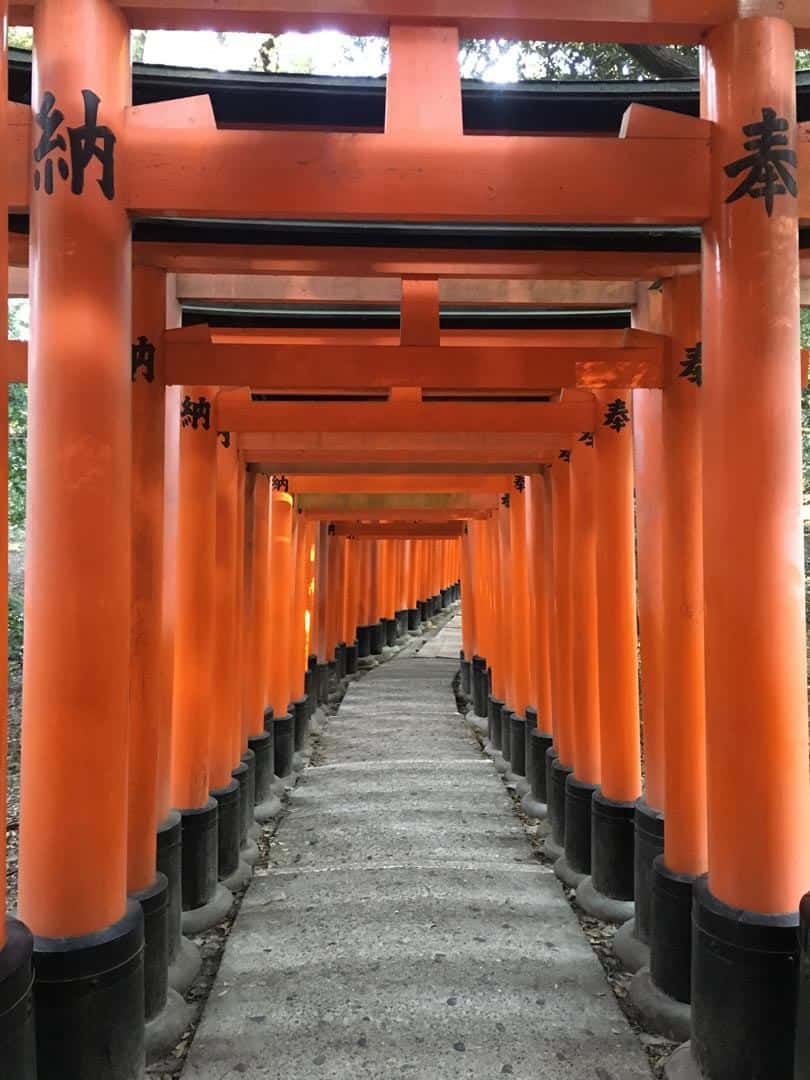
This is a no-brainer. Anyone travelling between cities in Japan should consider investing in one of these.
However be very careful about which JR pass you choose as you could end up spending more than you need to.
I’ll use our situation as an example.
We spent our first 12 days figuring out an excellent Hokkaido itinerary , which is absolutely incredible and definitely our favourite part of Japan. From Sapporo we flew down to Hiroshima .
From here we planned to go on to Miyajima, Osaka, Himeji, Nara, Kyoto and Tokyo.
A few of these were day trips and a few were for a bit longer, but as you can see we had a lot of travel ahead of us.
A regular JR pass that allows travel across the whole country costs 29,100 yen. This is incredibly reasonable. If you take a train from Tokyo to Kyoto, throw in a day trip to Nara and you’ve started saving money.
Our plan was as follows:
- 3 days – Hiroshima and Miyajima
- 2 days – Osaka
- 1 day – Himeji
- 1 day – Nara
- 4 days – Kyoto
- 5 days – Tokyo
We decided to purchase a Kansai-Hiroshima pass through JR West for 13,500 yen per person.
We activated this when we travelled from Hiroshima to Osaka. We used it for our day trips to Himeji, Nara and our trip to Kyoto. We then travelled from Kyoto to Tokyo by night bus for 6500 yen per person.
A total of 20,000 yen, 9000 yen less than a 7 day rail pass.
We would not have had time to do everything we wanted to do around Kansai and get to Tokyo in 7 days. Hence why we elected to go this route.
The JR pass website states that a JR pass cannot be used on the Nozomi or Mizuho trains. However if you purchase ANY JR west railway pass, which ours was, you can use these trains. This is great for longer routes, notably Hiroshima to Osaka/Kyoto.
Plan where you want to go and what you want to see and then search on the Klook website to find the pass that best fits your plan.
You could end up saving yourself a lot of money.
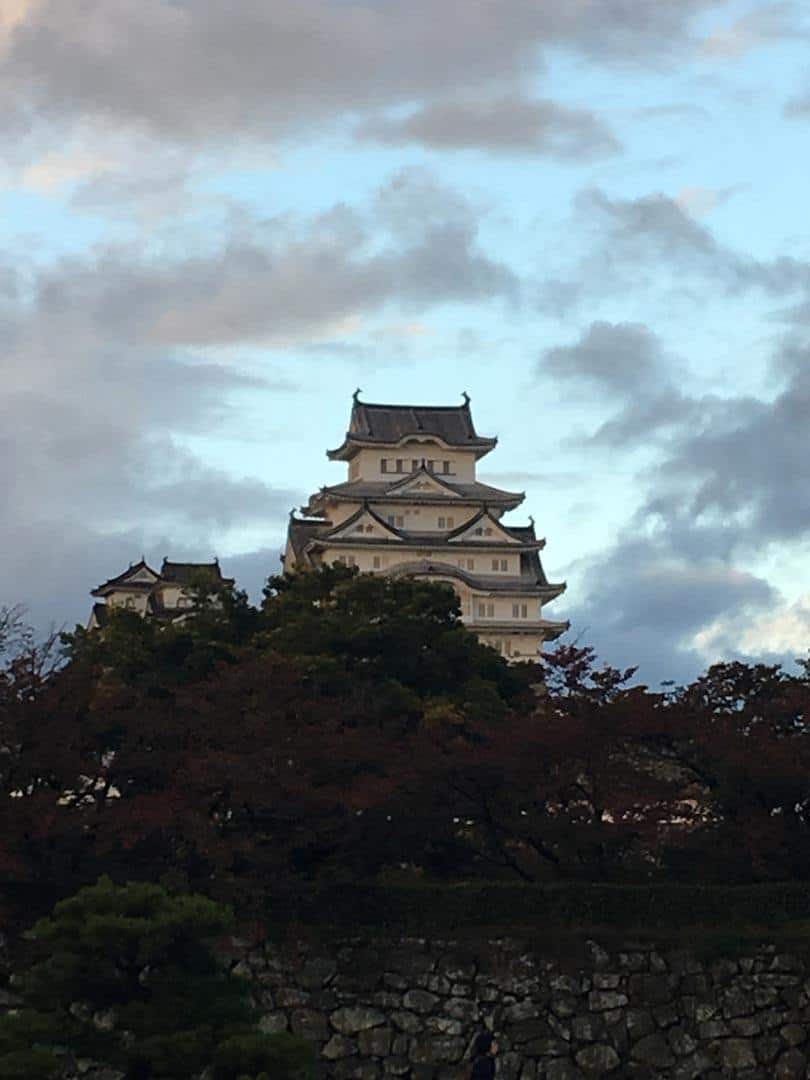
I read about this little deal on the amazing website Japanguide , a must for anyone planning a trip to the land of the rising sun.
In essence, this deal covers cheap flights all over Japan for any visitors to the country. It’s advertised as a 10,000 yen deal however there are some flights that are cheaper and some that are slightly more expensive.
We paid 10,000 yen each to fly from Sapporo to Hiroshima. If we were to booked these flights without this deal it would cost us closer to 50,000 yen per ticket.
There are two airlines that participate in this amazing deal: JAL and ANA. We ended up flying with ANA and it was great.
One thing to remember is that for this to work you usually have to book from outside Japan. As always in Japan there are a variety of deals.
The deals that we researched are linked below, but the link above has information on all of the deals available.
- JAL – Japan Explorer Pass
- ANA – Experience Japan
Both of these links take you straight to the booking page where you can research and compare prices. This deal is a must for anyone looking to get away from the Tokyo-Kyoto-Osaka route. This saved us a huge amount of money.
Day Passes for Attractions
Many of Japan’s cities have a variety of day passes allowing giving unlimited rides and even discounts to various attractions. This is a lifesaver for budget travel in Japan.
In Hiroshima you can purchase a 1 day street car and ferry pass for 840 yen. This is a great option if you are doing Miyajima as a day trip.
- Street Car to Miyajimaguch i = 280 1 way – total of 560
- Ferry to Miyajima = 180 yen 1 way – total of 360
- 560+360 = 920
This also means that you can use the streetcars to get around in the evening as your legs will be knackered after a day in Miyajima.
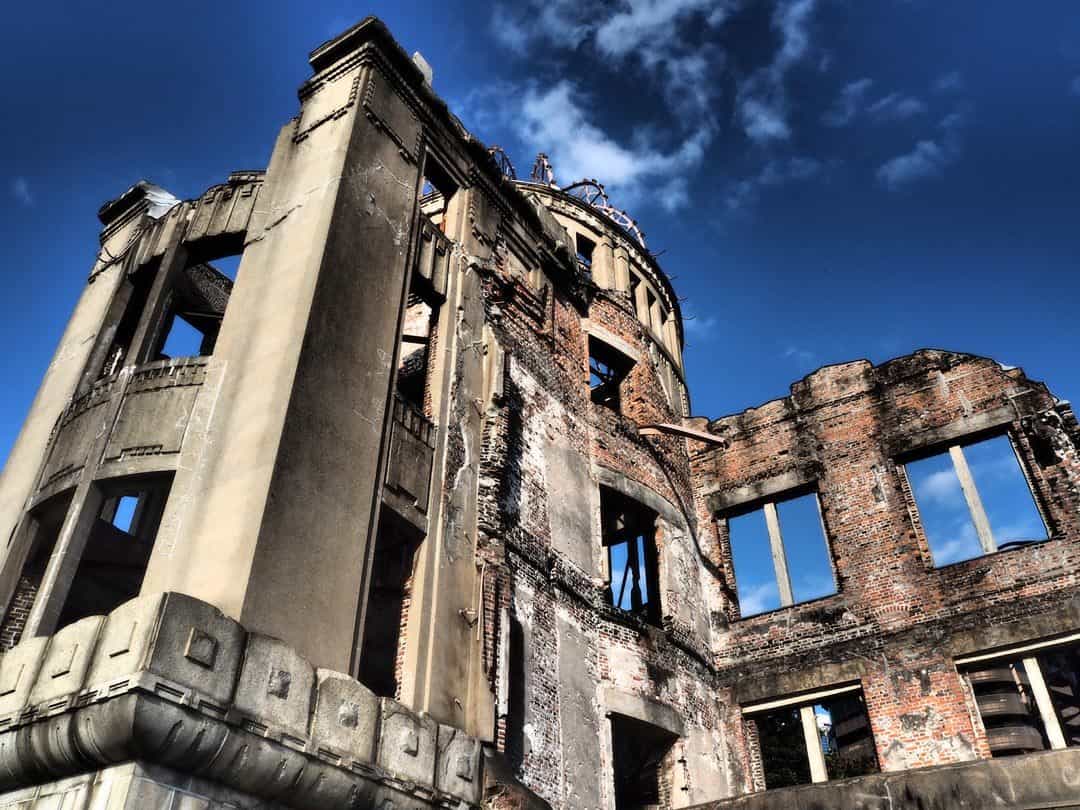
In Osaka you can pick up the “Osaka Amazing Pass” that covers subway and entry in a huge number of attractions for one day.
When we used it we headed to Osaka Castle, did the HEP5 ferris wheel, went to the top of the Umeda tower and took in an evening cruise (which was not that great to be honest).
It costs 2500 and it ended up saving us 2500 yen in transport and entrance fee’s definitely worth it.
Possibly the most popular tourist destination in Japan (it certainly felt that way when we were there).
Kyoto’s subway system is quite useful for accessing Northern Higashiyama and the city centre, but other than that it’s the bus and JR that are king.
However the JR routes to Arashiyama and Inari are very cheap so it’s not worth activating a rail pass just for this. Save it for intercity travel.
Kyoto’s bus network is both extensive and convenient. For 500 yen you can pick up an all day bus. You end up saving money if you take 3 or more buses. With Kyoto’s sites spread all over the city, this will not be a problem.
Here’s our list of the best things to do in Kyoto .
Japans greatest urban metropolis has one of the most impressive and confusing transportations systems on planet earth. The truth is there are huge number of tickets. Outlines of all of them are listed here .
Suica: This is just a simple subway card, like the oyster card in London or the octopus card in Hong Kong. You need to pay a 500 yen deposit for the card, but this is returned to you when you return the card at the end of your trip. Also the fares a few yen cheaper than if you buy tickets at the machine. They can be used on every line in Tokyo.
All Day Pass: There are 2 all-day pass options. The all-day metro card for 600yen which can only be used on the Tokyo metro, or you can include the Toei lines for 1500yen.
We found the all-day metro card fantastic value. If you take 4 trips you will be saving money. Just remember, neither of these passes include the JR lines, so sometimes the journeys are a little longer.
While you’re at it, check out these great things to do in Tokyo.
Eating out in Japan can be extremely cheap, in some case it was far cheaper than eating similar food in Beijing. Obviously eating out can be as cheap or as expensive as you wish, but here is a very rough price guide based on 2 people eating.
- 500-1000 Yen – Bento boxes – can be brought from any convenience store
- 1000-1500 Yen – Ramen and Udon
- 1500-2000 Yen – Katsu Curry
- 2000-3000 Yen – Tempura Sets
- 3000-5000 Yen – Yakiniku (Japanese BBQ), Izakaya/Yakitori (Japanese style pub serving sticks of meat, sashimi and other wonderful delights), Sushi and Sukiyaki (type of Japanese hot pot)
This is not a definitive list, but it’s generally a good guide as to what type of food is generally cheaper or more expensive.
The big thing that raises the cost of meal is alcohol. A couple of draft beers would generally add at least 1000 yen to the bill. So an easy way to save is to limit your alcohol intake.
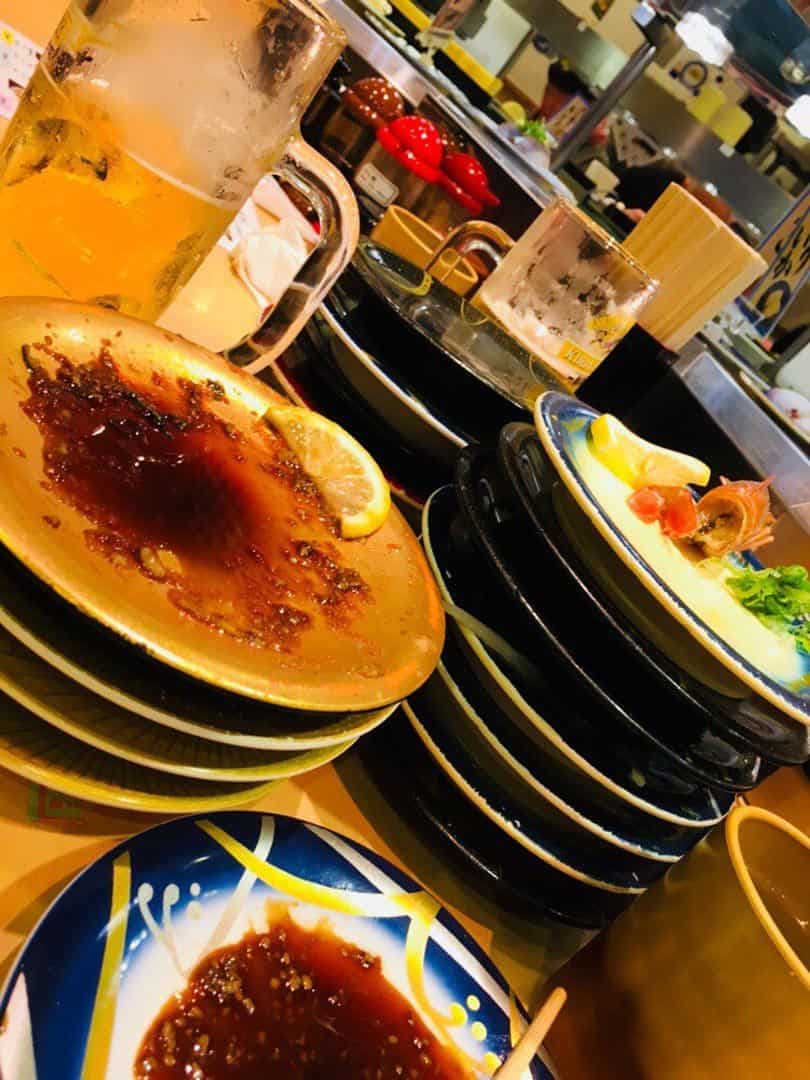
Budget Accommodation in Japan
Accommodation is usually the most expensive part of any trip.
Hokkaido – Booking.com and agoda.com offered us the best rates for anything outside Sapporo. In this region of Japan AirBnB is can be pretty pricey. In the national parks it can be around 9000yen per night, with breakfast included. However this is offset by the cost of food being much cheaper than other parts of Japan.
Hiroshima to Tokyo – Here AirBnB was generally cheaper and that was what we used the majority of the time. We managed to rent entire apartments for half the price of a hotel room in Hokkaido.
Another thing to be aware of is that paying for 2 beds in a dorm is usually more expensive that getting a room in a hotel or guesthouse, so plan accordingly.
Sign up using our AirBnB link to get $50 credit to go towards your first booking and make help make your trip even cheaper.
In truth Japan is much more affordable than people would believe. Hope you found this useful. Head over to www.abearandapig.com to see more of what we do.
That’s it for our guide to budget travel in Japan. Please leave a comment below if you found this article useful, or if you have anything else to add.
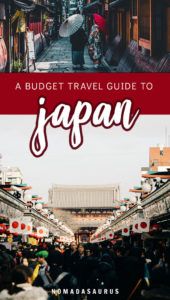
Richard Barnes
Hi, We’re Alesha and Jarryd!

We’ve been traveling the world together since 2008, searching for the planet’s best destinations and adventures.
Love Travel?
Sign up for our free weekly newsletter for the best travel tips, ideas and deals!
We respect your privacy. Unsubscribe at any time.
READ MORE...
The Perfect 3 Days in Tokyo Itinerary
The Best Day Trips from Every City in Japan [2024]
18 Amazing Things to Do in Kyoto at Night (2024 Guide)
Related Posts
10 best day trips from kyoto, japan [2024 travel guide], how to plan your perfect hokkaido itinerary in 2024, 19 best things to do in osaka, japan [2024 edition], 6 thoughts on “budget travel in japan – ultimate backpacking guide [2024]”.
People may think that Japan is very expensive, but there are many ways to travel in there very cheaply if you know some “secrets” like right organizations where you can get some very unbelievable travel deals 😉
What kind of organizations would those be?
Thanks for sharing this kind of information Thanks for the tips I’ve always enjoyed traveling, the idea of seeing the world fascinated me, but I was never able to take a very long trip
Thank you for your comment Luana. Travelling is definitely amazing in so many ways. Hope you can travel where you want to soon and stay for a long trip and immerse yourself in the country and the people. Happy travel planning 🙂
I love to visit this places in japan this year..Thanks for sharing such kind of information..I think Travelling is the most important way to enjoy life and know something different from your routines..
We agree. Travel is amazing. Have a great trip.
Leave a comment Cancel reply
Save my name, email, and website in this browser for the next time I comment.
- Media & Industry
- Meetings & Events
- Select Language 简体中文 繁體中文(香港) 繁體中文(臺灣) India (English) Bahasa Indonesia 한국어 ภาษาไทย Tiếng Việt Singapore (English) Philippines (English) Malaysia (English) Australia/New Zealand (English) Français Deutsch Italiano Español United Kingdom (English) Nordic countries(English) Canada (English) Canada (Français) United States (English) Mexico (español) Português العربية Japan(日本語) Global (English)
- India (English)
- Bahasa Indonesia
- Singapore (English)
- Philippines (English)
- Malaysia (English)
- Australia/New Zealand (English)
- United Kingdom (English)
- Nordic countries(English)
- Canada (English)
- Canada (Français)
- United States (English)
- Mexico (español)
- Global (English)
- Fujiyoshida
- Shimonoseki
- Ishigaki Island
- Miyako Island
- Kerama Island
- Tokyo Island
- Koka & Shigaraki
- Hida Takayama
- Ginza, Nihonbashi
- Beppu & Yufuin (Onsen)
- Ginzan Onsen
- Nagasaki Islands

- Kumano Kodo
- Shikoku Karst
- Amami Oshima
- Hachimantai
- Omihachiman
- Aizuwakamatsu

- Diving in Japan
- Skiing in Japan
- Seasonal Flowers in Japan
- Sustainable Outdoors
- Off the Beaten Track in Japan
- Scenic Spots
- World Heritage
- Home Stays & Farm Stays

- Japanese Gardens
- Japanese Crafts
- Temple Stays
- Heritage Stays
- Festivals and Events
- Theater in Japan
- Japanese Tea Ceremony
- Cultural Experiences in Japan
- Culture in Japan

- Local Cuisine Eastern Japan
- Local Cuisine Western Japan
- Local Street Food
- Japan's Local Ekiben
- Japanese Whisky
- Vegetarian and Vegan Guide
- Sushi in Japan Guide
- Japanese Sake Breweries

- Art Museums
- Architecture
- Performing Arts
- Art Festivals
- Japanese Anime and Comics
- Japanese Ceramics
- Local Crafts

- Scenic Night Views
- Natural Wonders
- Theme Parks
- Samurai & Ninja
- Iconic Architecture

- Wellness Travel in Japan
- Japanese Ryokan Guide
- A Guide to Stargazing in Japan
- Relaxation in Japan
- Forest Bathing (Shinrin-yoku)

- Experiences in Japan
- Enjoy my Japan
- National Parks
- Japan's Local Treasures
- Japan Heritage
- Snow Like No Other
- Wonder Around Japan

- Visa Information
- Getting to Japan
- Airport Access
- COVID-19: Practical Information for Traveling to Japan
- Anime Tourism
- Countryside Stays
- Accessible Tourism
- Hokkaido Great Outdoors
- Scenic World Heritage in Tohoku
- Shikoku’s Nature and Traditions
- Southern Kyushu by Rail

- Traveling by Rail
- How to Travel by Train and Bus
- JR Rail Passes
- Scenic Railways
- Renting a Car
- Sustainable Travel in Japan
- Travel Brochures
- Useful Apps
- Online Reservation Sites
- Eco-friendly Accommodation
- Luxury Accommodations
- Traveling With a Disability
- Hands-free Travel
- How to Book a Certified Tour Guide
- Volunteer Guides
- Tourist Information Center

- Japanese Manners
- Spring in Japan
- Summer in Japan
- Autumn in Japan
- Winter in Japan
- Cherry Blossom Forecast
- Autumn Leaves Forecast

- Japan Visitor Hotline
- Travel Insurance in Japan
- Japan Safe Travel Information
- Accessibility in Japan
- Vegetarian Guide
- Muslim Travelers
- Safety Tips

- JAPAN Monthly Web Magazine
- Arts & Cultures
- Nature & Outdoor
- Festivals & Events
- Insider Blog
- Things to do
- Local Guides
- Food & drink
- Traditional
- Hokuriku Shinetsu

My Favorites
${v.desc | trunc(25)}
Planning a Trip to Japan?
Share your travel photos with us by hashtagging your images with #visitjapanjp
GUIDE Guide to Traveling Japan on a Budget A guide to budgeting your trip to Japan
- Stories & Guides
- Guide to Traveling Japan on a Budget
Plan in advance to make your trip to Japan affordable
You may have heard that Japan is an expensive place to visit, but don't be discouraged. With some advance planning, Japan is an affordable destination for even the most budget-conscious traveler. Take some time to decide which options best suit your budget.
There are a wide variety of budget accommodation options, transportation passes and sightseeing discounts available. Browse our list for more details.
Transportation
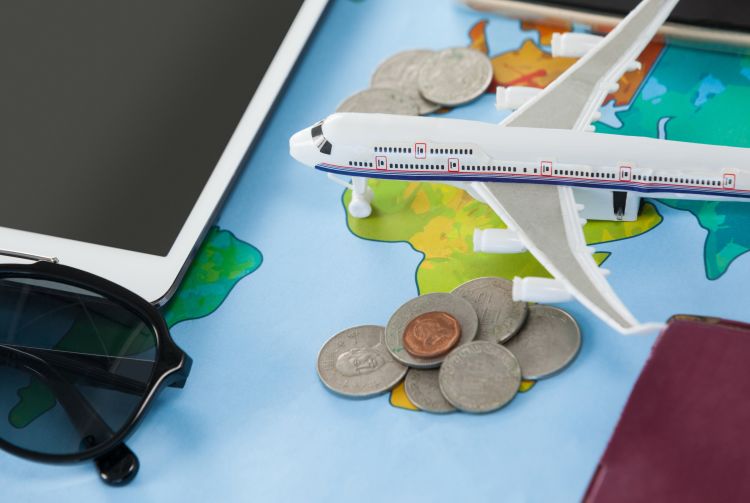
Long distance buses
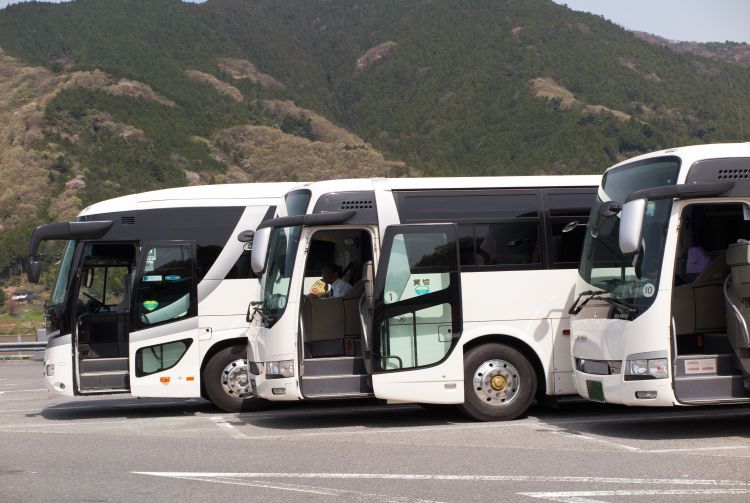
Ferries and passenger boats
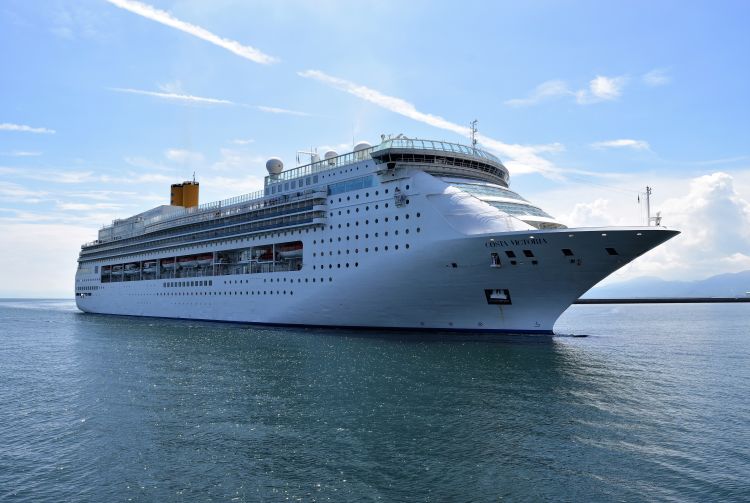
Accommodations
Dining out in Japan doesn't have to be expensive, and is often better value for money than most other world capitals. Wherever you travel, restaurants in popular tourist areas will always cost more. Follow the locals and you will generally find both lower prices and more authentic Japanese cuisine. Avoid restaurants that don't list their prices outside the door. Budget dining can usually be enjoyed at more casual establishments such as izakaya (Japanese pubs), shokudo (small casual restaurants, often with set meals), kaitenzushi (conveyor belt sushi) and okonomiyaki restaurants.
Comparing Prices
Improvements in the foreign exchange rate mean more favorable prices for overseas visitors to Japan. The price chart on this page is designed to give an idea of what you can expect to pay for a variety of everyday and travel-related items in Japan.
The latest information may differ, so please check the official website.
* The information on this page may be subject to change due to COVID-19.
- Story & Guide
- Travel Tips
Did this information help you?
out of found this information helpful.
Thank you for your feedback.
Recommended for you.

Please Choose Your Language
Browse the JNTO site in one of multiple languages

- Meet the Team
- Work With Us
- Itineraries
- Italy Travel Guide
- Hawaii Travel Guide
- Travel Tips
How to Travel in Japan on the Cheap
If you’ve looked into a trip to Japan , you’ve probably already realized that Japan is not a cheap destination, even with a favorable exchange rate. You shouldn’t let that detour you from taking a vacation in Japan, however. You might need to get creative with your planning, but there are many ways that you can travel in Japan on the cheap.
Most travelers to Japan want to stay for at least a week , maybe even 2 weeks , so they can visit many parts of the country in one trip, but that can be difficult to manage on a budget.

If you’re worried about mounting costs for your Japan itinerary, don’t! There are many ways to cut costs while traveling in Japan , you just need to put in a little extra effort to find them. Check out these budget hacks that will help you travel to Japan without breaking your budget.
Japan Itineraries
If you’re looking for a great itinerary you can follow in Japan, see our suggested routes below.
- We have a 7-day itinerary and a 2-week Japan itinerary so you can choose which length of trip suits you best.
- If you will only be visiting Tokyo, here’s a shortened 3-day itinerary for Tokyo .
- Want to add more days outside of Tokyo ? Here’s a 3-day Kyoto itinerary and a 2-day Osaka itinerary .
Planning Your Japan Trip?
Buy flights. We recommend using Skyscanner or Expedia to find the best flight deals. Check out our guide to finding the best airfare for additional tips.
Get your Japan Rail Pass. You can buy it online here
- In Tokyo: The Strings by InterContinental Tokyo
- In Kyoto: ACE Hotel Kyoto
- In Osaka: Intercontinental Osaka
Best Tours to Book
- Fully escorted 8-day Intro to Japan tour
- Private Custom Tour: Tokyo in a Day
- Tsukiji Fish Market Food and Culture Walking Tour
Table of Contents
Transportation in Japan

Most people who travel to Japan visit Tokyo , even if it’s only for a few days, because Tokyo has the most accessible airport in Japan. However, it’s likely that you’ll want to visit other parts of Japan as well, but transportation costs can really add up.
Japan has the high-speed Shinkansen train system that whisks people around at an extremely rapid pace. It’s really convenient for traveling long distances in a shorter amount of time, but it’s also quite expensive.
Just one trip on the Shinkansen from Tokyo to Kyoto or Osaka will cost you roughly $120 one way. Add two or three other trips, and you’ve blown your budget.
That’s where the Japan Rail Pass comes in. The Japan rail pass is a virtually all-you-can-use travel pass that only tourists can buy for a specific duration (7, 14 or 21 days).
You can use it on pretty much any train (though not all), at any time, without the hassle of purchasing tickets in advance. You can buy a rail pass that gets you standard seats or splurge for the Green Pass, a first-class rail pass that gets you reserved seats, plus other perks, in the best carriages.
The pass can provide significant savings over buying single tickets. The current price for an adult standard 7-day pass is $294 USD. For all the information you need, plus where to purchase the rail pass, read our guide on the Japan Rail Pass .

Take for instance the trip from Tokyo to Kyoto, a popular destination that’s a journey from Tokyo. The fast train from Tokyo will cost around $120. This is where the Japan Rail Pass really comes in handy.
If you plan to do even a small amount of traveling between cities, it will pay off quickly. You’ll get unlimited rail travel with the seven-day pass for $294.
While in Kyoto, be sure to check out this post on How to Experience Fushimi Inari Shrine .
Eating on the Cheap in Japan
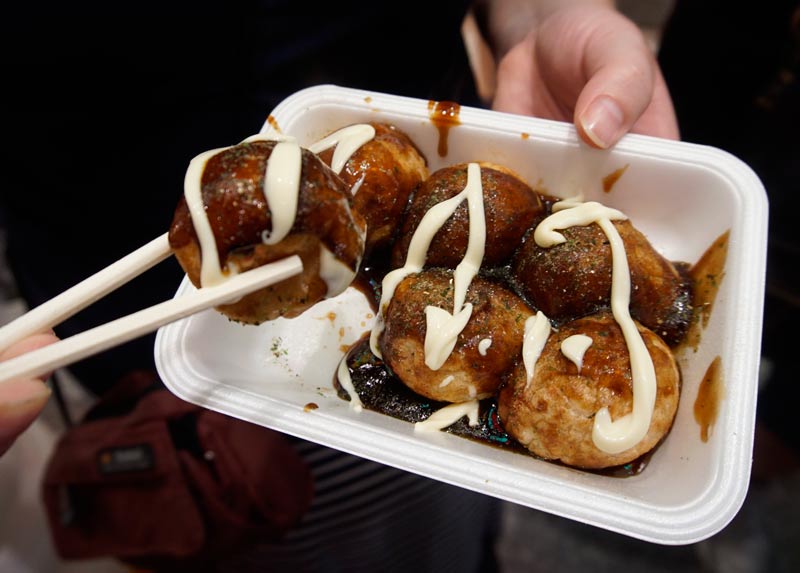
Known for its incredible food, Japan is a country where you will want to be sampling as many Japanese specialties, like ramen, yakitori, and sushi as you can.
However, you can quickly break your budget with food in Japan if you’re only eating at restaurants and not taking advantage of all the great izakayas and street food vendors.
I hear people say that they don’t want to eat street food when traveling because they’re afraid of food poisoning or stomach bugs that might ruin their trip. While you do have to be careful about the food stalls you choose, you don’t have to avoid them altogether.
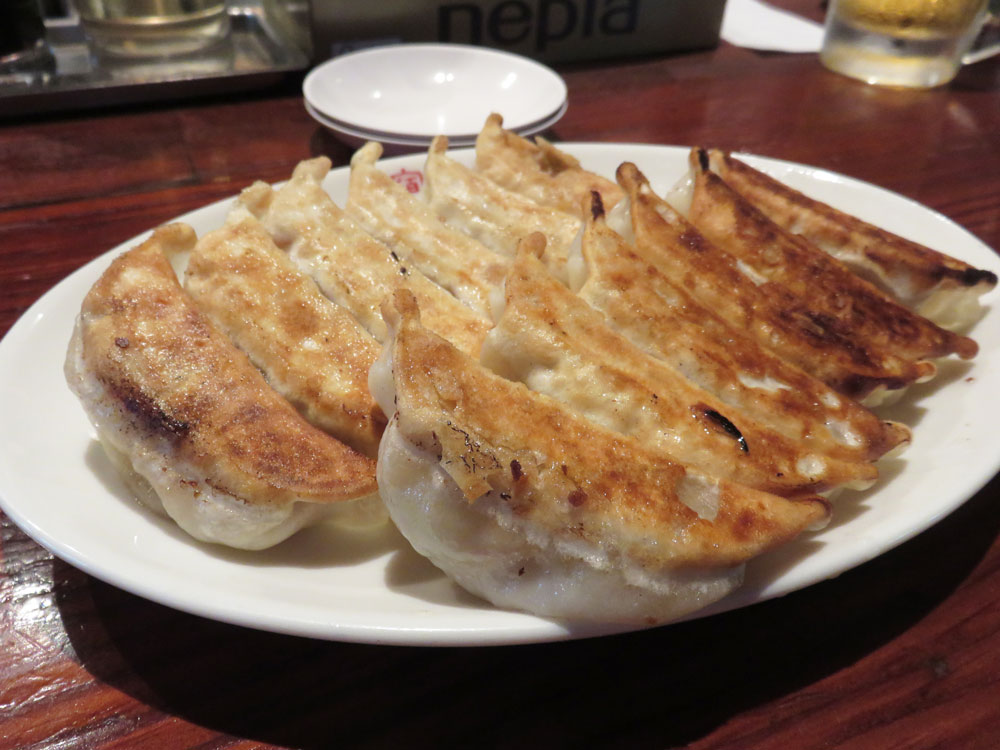
In fact, some of the best and cheapest places to eat in Japan are at food stalls. You will find them near and around markets like Tsukiji outer market in Tokyo and Dotonbori street in Osaka, and in Nishiki Market in Kyoto.
At these street food vendors, you can purchase a large plate of a specialty like gyoza or takoyaki for just a few dollars. There are also Ramen streets in just about every city in Japan. You can purchase a huge bowl of delicious ramen that will keep you full for hours for just a few dollars too.
Usually these ramen stalls can be found around the train stations. For sushi, we found that grocery store sushi was the most economical way to eat great freshly made sushi for a lot less than you’d pay at a restaurant.
We even ate grocery store sushi for breakfast! At most major train stations, there are huge basement grocery stores that have large sushi sections. You can get an enormous tray of sushi for a very low price.
How to Drink on the Cheap in Japan

When we travel, we like to visit wineries and breweries when we can, not only to get a taste of the local spirits, but to learn more about the ingredients and processes used there. In Sapporo, save on your bar bill by visiting the three major breweries in town: Sapporo, Kirin and Asahi, where you’ll get a tour and free tastings (at least at the latter two).
If you like sake, you can visit the sake breweries outside of Tokyo and Osaka, where there are often free tastings offered. Then you’ll want to visit a sake bar where you can sample as many sakes as you like for one small entrance fee. Kurand Sake Market in Tokyo carries over 100 different varieties of sake directly from the breweries.
Budget Accommodations in Japan
As you can imagine, hotels are one of the biggest expenses you’ll have while traveling in Japan. There are a plethora of high-end and luxury hotels throughout the country, and travelers also really love staying in traditional ryokans. But these options can be quite pricey.
The Citadines hotel chain has nice, clean rooms that are perfect for a budget stay, without sacrificing location, safety, or good value. Try the Citadines Shinjuku .
There are some really nice hostels you can book in major cities in Japan that will save you a tremendous amount of money. You can often find apartments for short-term stays on Booking.com.
Japan is also known for its capsule hotels. These are sort of mini-hotels that are considerably smaller than a traditional hotel. They provide a bed and basic amenities and the price is often around $25 USD per night.
Activities on the Cheap in Japan

In Japan, there are many activities you can do that are free or very inexpensive. These are the activities you should aim to participate in to save money. Free activities include walking around the city (there are so many unique things to see while walking around), visiting gardens (some have entrance fees), visiting temples from the outside.
There’s no better way to see the city than to walk! Instead of booking an expensive group tour, consider joining a free walking tour, or put together your own self-guided tour of the top sites in the city. However, there are also a ton of museums, temples, and activities that are not free. And you don’t want to miss out on those.
For the cities where the focus is on these things, you can get a visitors pass that allows entrance to multiple attractions for one low price. Especially in Kyoto and Fukuoka is its ancient temples, art museums, and architecture. You can buy 1 or 2 day passes that allow you to see multiple things in the city, as well as ride public transportation.
Use these budget hacks during your next trip to Japan and you’ll find that it’s not nearly as expensive as you once thought. If you plan well, you can travel in Japan for cheap.
Be Prepared For Travel Planning is the most important part of any successful trip. Do it the easy way:
🧳 Travel Packing List | ✔️ Why You Need Travel Insurance | ✈️ What to Do Before You Leave Home
- Find and book the best hotel (our favorite booking site is Expedia)
- Research flight options (our favorite tool is Skyscanner )
- Book a tour (we always use Viator to find the best tours)
- Rent a car through Discover Cars (they search the best deals for you!)
YOU MIGHT ALSO LIKE

9 Great Cherry Blossom Viewing Spots in Japan

7 Amazing Day Trips from Osaka Japan
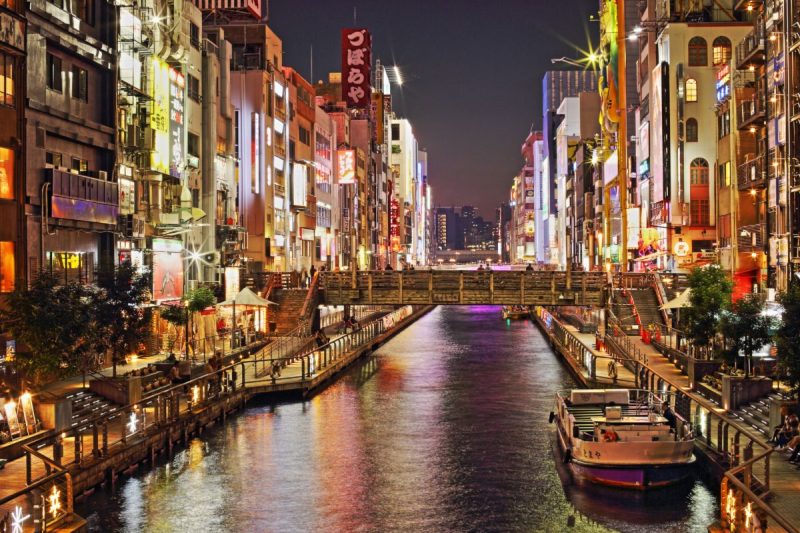
How to Spend 2 Days in Osaka Japan

Where to Buy Japan Rail Pass and Is It Worth It?
Like this post? Pin it for later

Laura Lynch, creator and writer of Savored Journeys, is an avid world traveler, certified wine expert, and international food specialist. She has written about travel and food for over 20 years and has visited over 75 countries. Her work has been published in numerous guidebooks, websites, and magazines.
27 thoughts on “ How to Travel in Japan on the Cheap ”
Great article – Japan is so expensive, it’s always good to go prepared with some tips for ways of saving some cash!
What a great plan. We haven’t done Asia as a family. Self guided walking tours are where we have our greatest successes though, so glad to hear that’s an easy option.
I also didn’t think you can fin bargains in Japan but happy to hear it is possible. South Korea sounds interesting as well.
You certainly can, if you look hard enough! 🙂
Beautiful places! My favourite is Kyoto, where I was in winter and everything was covered by snow and looked even more magical 🙂 And of course, matcha ice cream 😀
Lovely alternance of pics of old style structures and modern areas, you give an idea of the double (and incredibly interesting) face of this country that I really wish to visit as soon as possible!
Thanks for the tips – I’ve heard really good things about the Japan Rail Pass; we’re looking for our next destination for 2016 from Australia so Japan is definitely on the cards. Just have o toss up between that or South Korea!
You can do both, Meg! If you’re planning to go to Fukuoka, ti’s really easy to get to South Korea – then you’ll get a two-for-one!
I love Japan! Even though it can be pretty expensive, I tried my very best during my visit there for a week! Japan Rail is definitely worth it! Expensive but worth every penny, especially since I only stayed for a week – which is not enough time to explore a lot of things I want to see in Japan, haha. I missed out Sapporo and Fukuoka! Osaka as well, I went there but didn’t really explore since I focused primarily in Tokyo, Kyoto (my favorite!) and Hiroshima. I didn’t know about the ferry from Fukuoka to Busan! That’s really awesome, I just didn’t realized that it’s only about 3 hours away. I’ll keep that in mind for next time 🙂
Yes, Japan Rail is definitely the way to go for getting around. I bet most people don’t realize that the two countries are so close and can be reached like this. It cuts down a lot on transportation costs between the two.
I confess: budget reasons have always kept me away from Japan (and the impression that it’s very crowded and busy in all cities). Good to know that there are some travel hacks.
Yeah, it’s definitely not great for tight budgets, but there are some ways to cut costs.
That house on the lake in the picture at the top is what and where I want my future house to be. Breathtaking. Great post.
I could handle that too, I think!
Nice tips. I enjoyed traveling in Japan two times. Truly an expensive destination to explore. I hope these tips help others experience it nonetheless.
Yes, me too!
I love japan and the food, thanks for the tips. We budget $30 a day for food and it was enough. We still got to sample most of it. Loved the market places too.
That’s great info, Karla! You can definitely find cheap eats in Japan and still eat really well.
Great tips, especially the bit about South Korea! Will have to try and add that in on our next visit 🙂 We redeemed hotel points for most of our time in Japan so that saved a ton–I think trains were our most expensive thing! The JR Pass really helped though! Would love to check out Sapporo next time as well–we love visiting breweries when we travel!
Using points in Japan is a really great idea. We always try to save up our points to use in places that are especially expensive. Better value!
I’m sharing this immediately because I have quite a few audience members that this would be perfect for. Thank you for sharing your deep knowledge on the subject with us. It’s so helpful and I’m also bookmarking it for future reference!
That’s great, Nicole. I’m always happy to help.
Ooo thanks for the great tips!!
Japan is in a world of its own, and I LOVE it. Could use the tips on South Korea though, can’t wait to get there next! Korean BBQ all day every day. 😀
Oh I agree – Korean BBQ every day!
I really want to see the culture in Japan. It is so interesting. It is nice to know that Japan can be done on a tighter budget. It always seems so expensive.
The culture and the food are two of the top attractions in Japan for me. But yes, it can be expensive!
Leave a Reply Cancel reply
Your email address will not be published. Required fields are marked *
Save my name, email, and website in this browser for the next time I comment.
- Travel Resources
Japan's best budget-friendly destinations
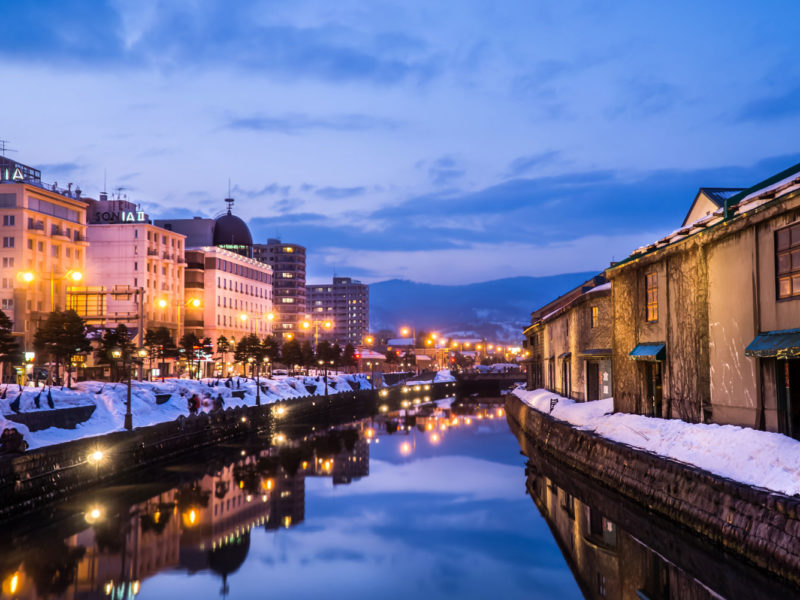
Otaru Canal at night is a sight to behold.
Last updated . 10 October 2022
Dreaming of cherry blossoms, sushi and Mount Fuji? We look at the ultimate budget-friendly getaways in Japan.
Ah Japan – it’s one of Australia’s favourite destinations. And for good reason, really. There’s cityscapes, snowscapes, beachscapes, cherry blossomscapes, and basically everything in between. Perfect for the traveller who loves a bit of variety, but just how budget-friendly is a trip to Japan?
Is Japan expensive to visit?
If you dream of visiting the Land of the Rising Sun, the biggest costs to factor into your trip to Japan are always going to be food, transportation and accommodation.
Food is the most affordable of the three, with plenty of budget-friendly options available around the country.
Transportation in Japan can be expensive, especially if you’re travelling long-distance. However, the Japan Rail Pass can help with that. Instead of paying nearly $200 for a oneway train ticket from Tokyo to Osaka, you can buy an unlimited Japan Rail Pass for $371 for 7 days, $592 for 14 days or $757 for 21 days.
Finally, accommodation is where your budget will be hit the hardest. On the cheaper end of the scale, you’re looking at $50 a night for a hostel in Kyoto.
Accommodation is the third of the big three travel expenses, and unfortunately, it’s not only the most expensive travel cost in Japan, but also the most unavoidable: There’s no special pass for hostels or guest houses and prices for tourists are higher, if anything. For example, you can expect to pay at least ¥3,500 (or about 35 USD) for a dorm bed in a hostel in Kyoto.
The good news is there are plenty of ways to cut down on your costs – and some destinations are cheaper to visit than others. Here is how you can do it on the cheap.
If you’re looking for a taste of traditional Japan, head to Kyoto . Buddhist temples, ancient wooden houses, zen rock gardens and geisha, all nestled within the confines of the neighbouring mountains.
With a population of 1.4 million people, it’s definitely a bustling place, but still filled with hidden gems that will give you your travel kicks.
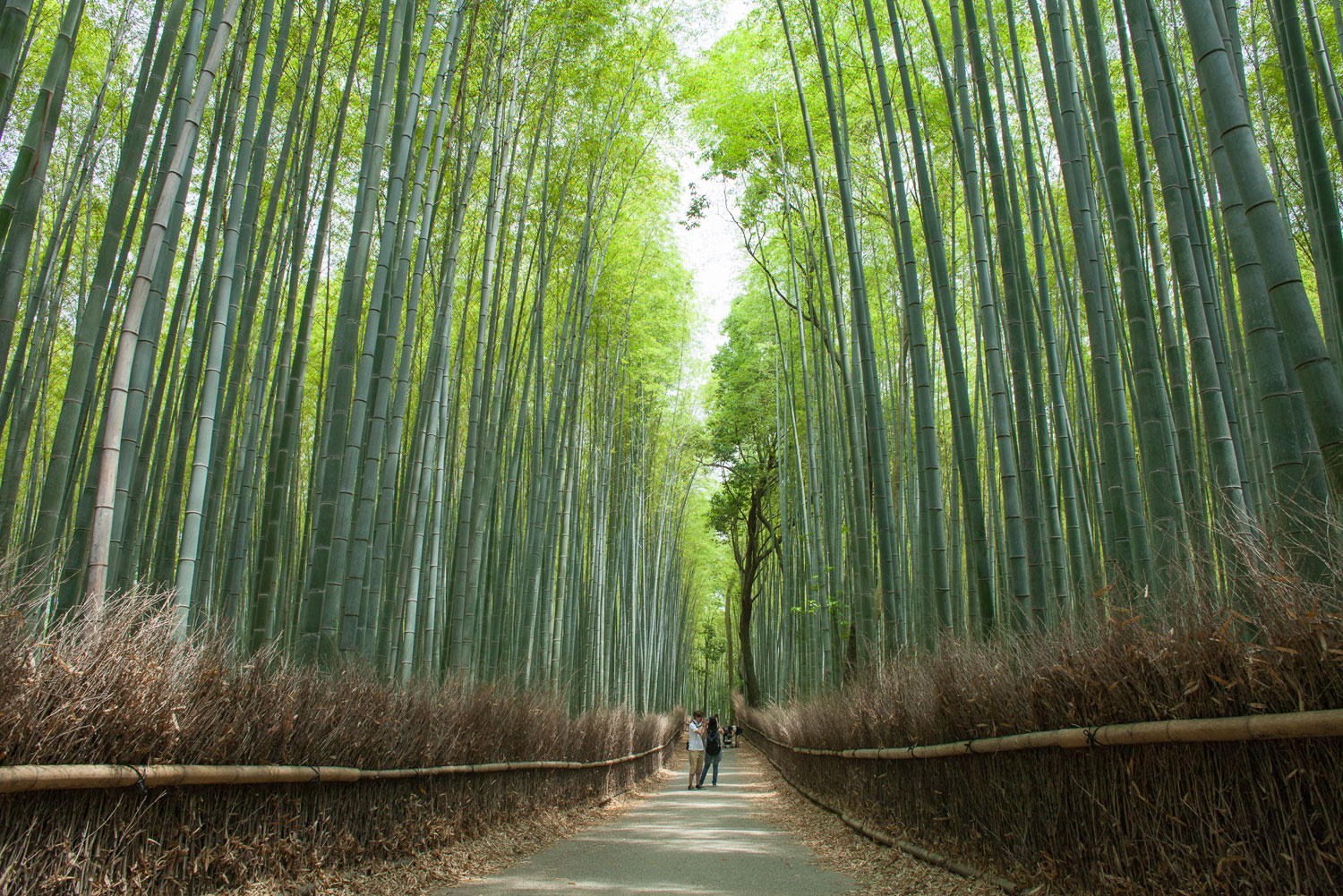
The Arashiyama Bamboo Grove in Kyoto.
1. The Arashiyama Bamboo Grove
The Arashiyama Bamboo Grove is an incredible, must-visit garden situated just outside the city centre. Here towering bamboo stretches endlessly in every direction and travellers really do feel at peace.
Address: Togetsukyo, Saga, Ukyo-ku, Kyoto 616-8383, Kyoto Prefecture
Onsens are dotted all over Japan, thanks to hot volcanic springs that deliver a steady supply of piping hot water; no trip to the country would be complete without having a soak in one. The city centre Funaoka Onsen on Kuramaguchi-dōri is one of Kyoto’s most celebrated.
Inside you’ll find hot, warm and cold baths, an outdoor rock pool and a cypress-panelled tub. And yes, you will have to abide by tradition and remove all of your clothes.
Address: 82-1 Murasakino Minamifunaokacho, Kita Ward, Kyoto, 603-8225, Japan
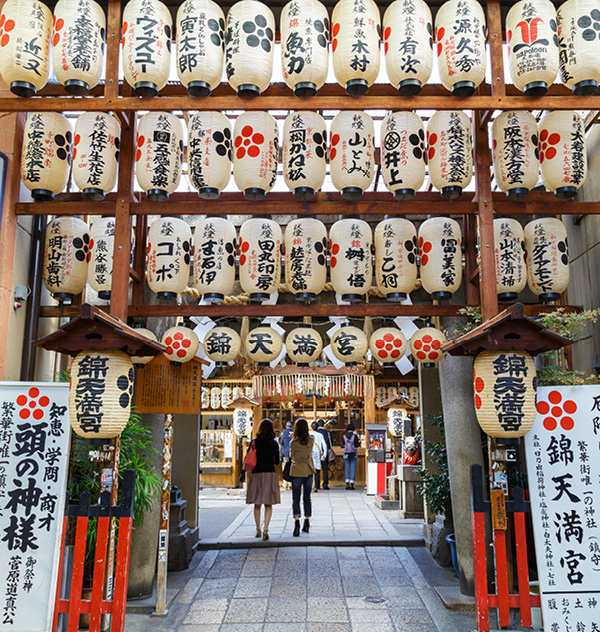
Nishiki Market is the place to go for your fill of all the Japanese street food you can eat.
3. Nishiki Market
Head to Nishiki Market for your fill of all the Japanese street food you could want. The traditional food market, which you’ll find in a long alley way, has been in operation for over 400 years. Not only can you walk away full, you can also purchase souvenirs, clothes, gifts, and fresh produce, meat and seafood to take back to your accommodation to cook and eat. There are over 100 stalls, shops and restaurants to choose from, so arrive mid-morning and spend a couple of hours browsing the stalls and eating.
Address: 609 Nishidaimonjicho Tominokoji Dori Shijoagaru , Nakagyo, Kyoto 604-8054, Kyoto Prefecture
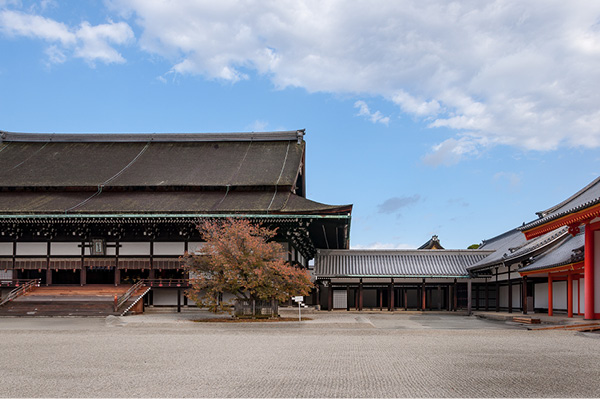
Tour the Imperial Palace in Kyoto.
4. Kyoto Imperial Palace
Once home to the emperor of Japan during the Heian period, the Imperial Palace shouldn’t be missed for it’s sheer scale and tranquil gardens. There is no admission fee, so you can wander until your heart’s content. Take in the architecture, immerse yourself in the history and take in the beauty of the manicured gardens.
Address: 3 Kyoto-Gyoen Kamigyo-ku , Kamigyo, Kyoto 602-0881, Kyoto Prefecture
Where to stay
Hotel sunroute kyoto.
The Hotel Sunroute Kyoto is not only great value for money but is located within walking distance from the downtown shopping district of Kawaramachi. Each reasonably-sized room features wi-fi, flat screen televisions and a pull-out sofa. The hotel also has two restaurants and breakfast is available to book. Prices start at $100 a night per room.
Address: 406 Nanba-cho Matsubara-sagaru, Kawaramachi-dori, Shimogyo-ku, Kyoto, Kyoto, 600-8027, Japan
Read more: the ultimate travel guide to Kyoto
Though the port town of Otaru is little known to international visitors, it’s a popular destination with Japanese tourists.
A bit off the beaten track, this little town charms travellers with its many local attractions, including several popular museums and a picturesque canal.
1. Eat all the ice cream
Otaru is known for its unique and delicious ice cream flavours. If there is one ice cream parlour you have to visit, it’s Kita-no Aisukurimu-ya-san. Here you’ll find ice cream flavours you’ve never dreamed of tasting! Think sea urchin, beer, wine, sake, tofu and squid. For those who aren’t feeling quite so brave, you can also choose between a variety of more palatable ice cream flavours, including strawberry milk, fresh caramel, apple pie, white peach and many more.
Address: 1-2-18 Ironai , Otaru 047-0031, Hokkaido
2. Otaru Canal
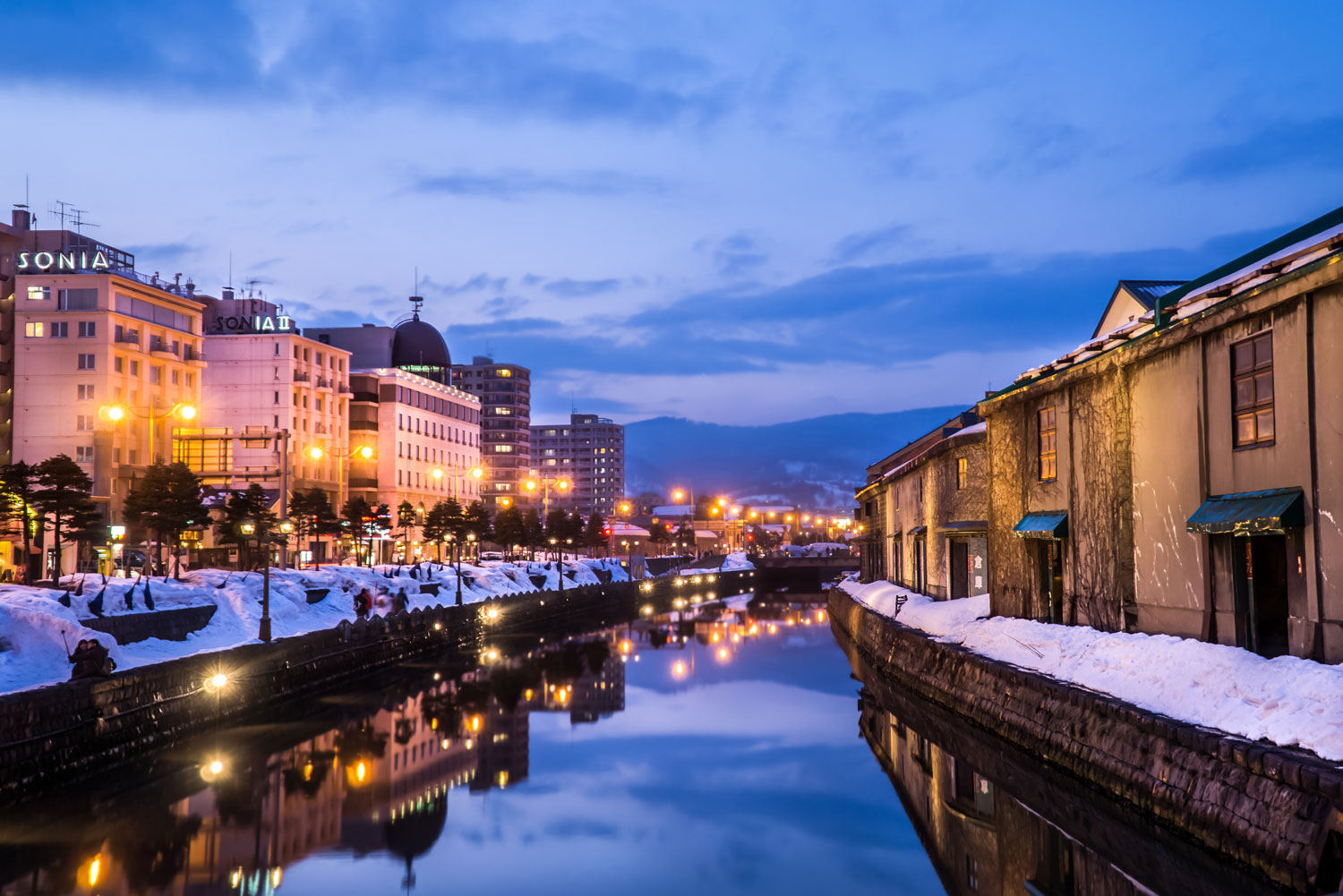
Otaru’s canal is a must, where you can wander along at leisure and admire the 19th and 20th century warehouses that line the waterway. The traditional oil lamps still burn each night along the promenade, making a sunset stroll something extra magical. There are canal boats for hire and walking tours for those after something a little more.
Address: Minatomachi , Otaru 047-0007, Hokkaido
3. Otaru Museum
While at the Otaru Canal, visit the vibrant Otaru Museum nearby, with displays featuring Hokkaidō’s natural history, Ainu relics and various exhibitions from all over Japan.
Address: 1-3-6 Temiya , Otaru 047-0041, Hokkaido
Smile Hotel
Located close to major local attractions and the main train station, Smile Hotel combines comfort, authentic experiences and amazing value, where two people can stay from just $54 a night.
Address: 3-5-14 Inaho, Otaru, Hokkaido
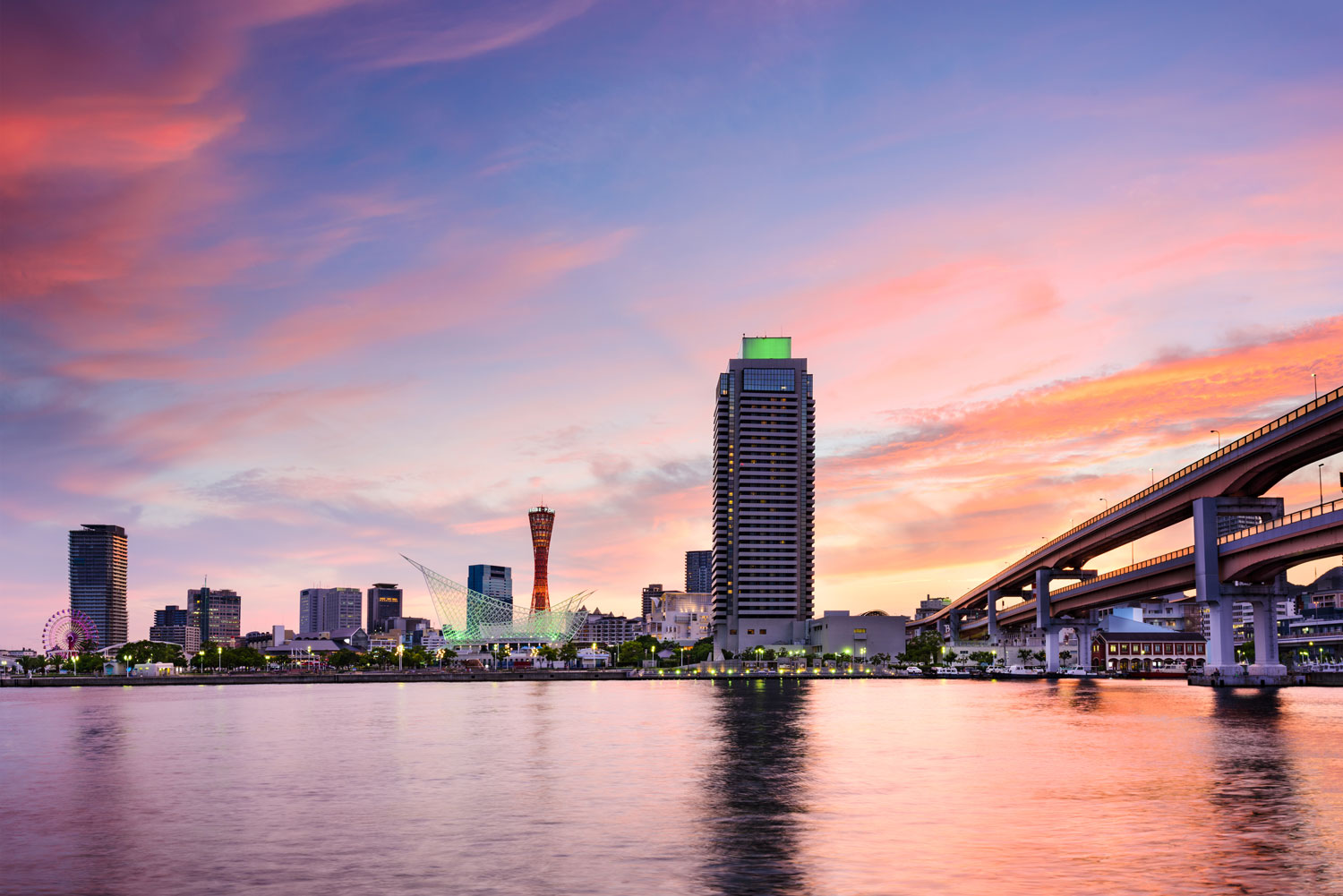
Kobe at sunset.
Located on Osaka Bay in Central Japan, this multicultural port city is renowned for its beautiful scenery, encompassing a scenic harbour and mountains, earning it a reputation as one of Japan’s most attractive cities.
1. Rokko cable car ride
Take a ride on the antique cable cars connecting Kobe to Mt. Rokko, which is one of the best ways to enjoy the spectacular panoramic views the port has to offer.
Address: Rokkosancho, Nada-ku , Kobe 657-0001, Hyogo Prefecture
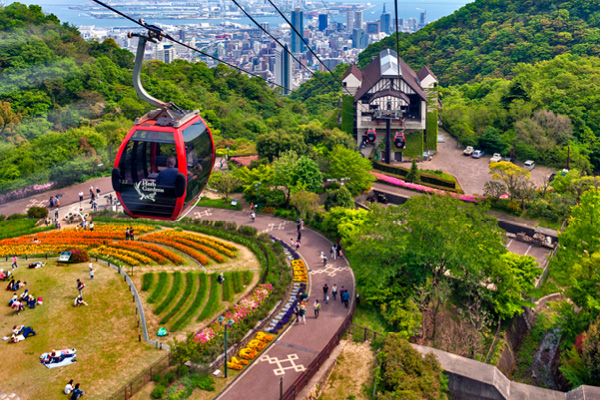
The Rokko cable car ride connects Kobe to Mount Rokko.
2. Arima Onsen
Then if you want to venture beyond the Rokko hills, experience the hot outdoor springs and public baths in Arima Onsen .
Address: Arimacho, Kita-ku , Kobe 651-1401, Hyogo Prefecture
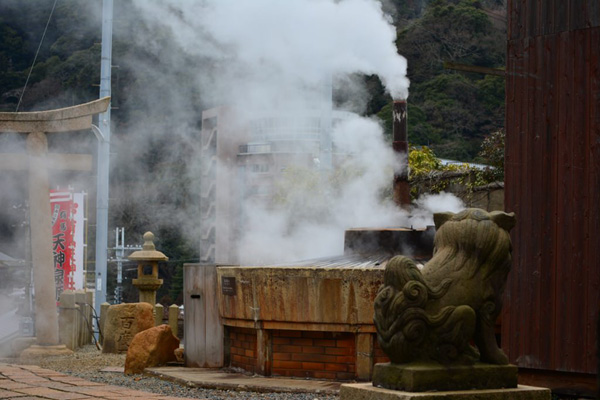
The Arima Onsen is just beyond Rokko hills.
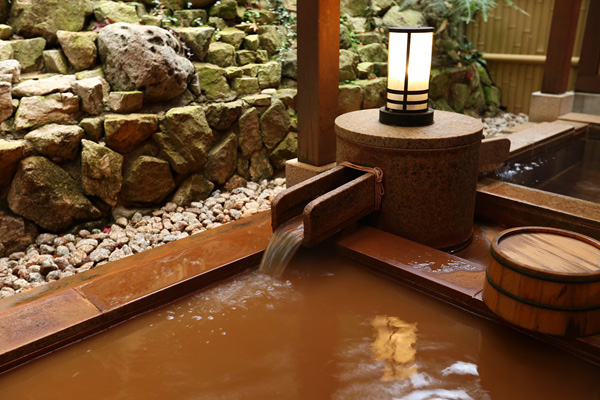
You’ll experience hot outdoor springs and public baths at Arima Onsen.
3. Eat Kobe marbled beef
The fun doesn’t stop at sundown either with many convivial bars to sample sake at, and a variety of restaurants where you can indulge in one of Japan’s delicacies, marbled beef. One of the best places to try the famous beef is at Wakkoqu. The beef is cooked in front of you as you dine, there are a variety of set menus and you can choose from a number of side dishes to accompany the beef.
Address: 1-1 Kitanocho, Chuo-ku | Shinkobe Oriental Avenue 3F , Kobe 650-0002, Hyogo Prefecture
Hotel Villa Fontaine Kobe-Sannomiya
Set among Kobe’s many restaurants, bars and shops is Hotel Villa Fontaine Kobe-Sannomiya , where well-appointed rooms (which come with a complimentary buffet breakfast) cost as little as $150 for two people per night.
Address: 4-1-4 Asahi-Dori, Chuo-ku, Kobe 651-0095, Japan
For a more active trip, the island of Hokkaido is an idyllic getaway, famed for its snow-covered slopes at Niseko, one of Japan’s best ski resorts.
1. Hit the slopes
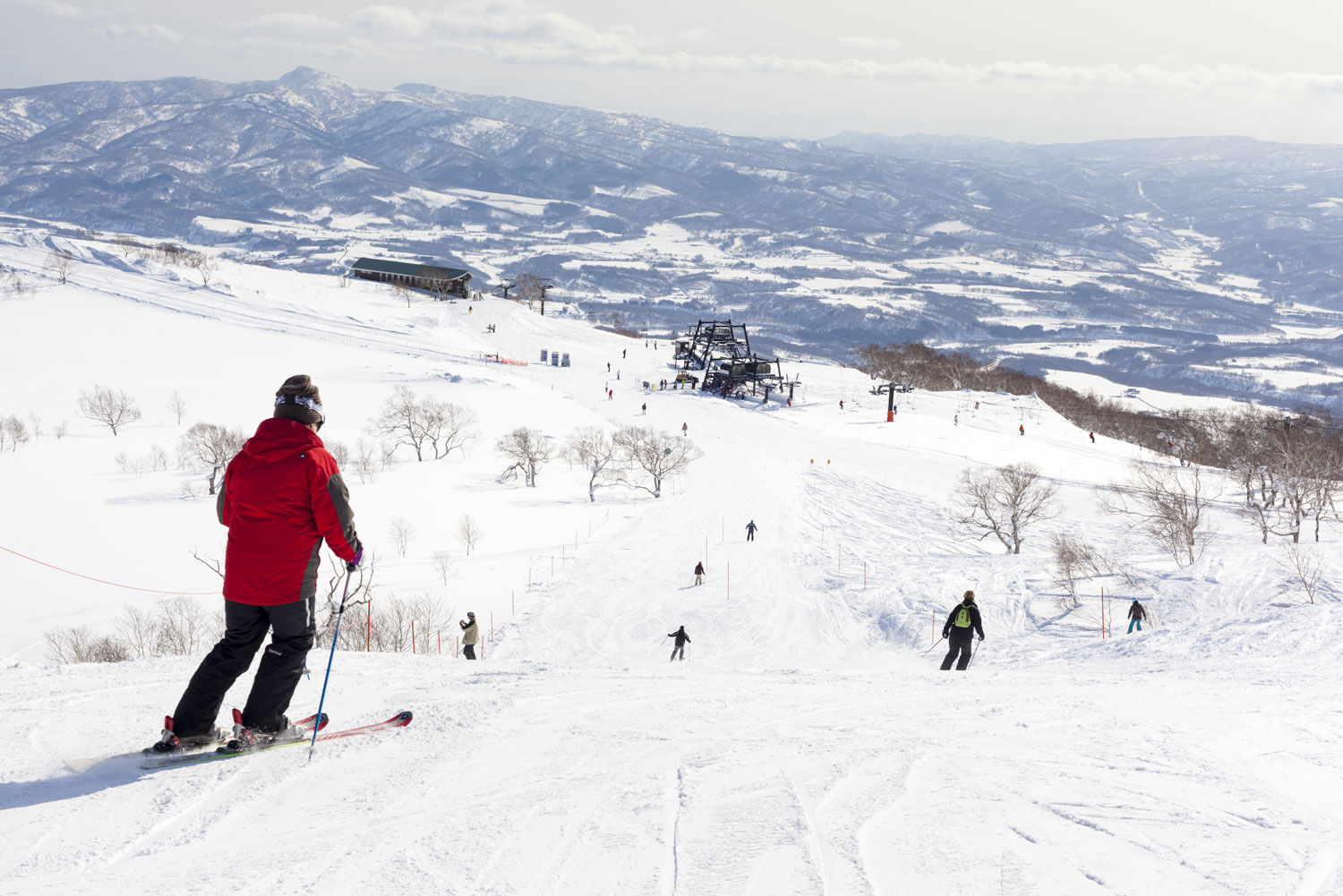
Niseko, one of Japan’s best ski resorts.
2. Hikes and bike trails
If you’re visiting outside of winter months (although there’s snow most of the year); there’s a variety of hikes to tackle, or rent a bike and explore the island’s unspoiled scenery on wheels.
The Lodge Moiwa 834
The Lodge Moiwa 834 ticks all the right boxes with contemporary centrally-located capsule-style accommodation, which won’t break the bank.
A capsule for two costs from $120 per night, and you can purchase discounted ski passes from the hotel.
Address: 447-5 Aza, Niseko 048-1511, Japan
Hailed as the food capital of the country, foodies can’t go past a trip to Osaka . It’s also home to Universal Studios, Osaka Castle and Japan’s answer to Times Square – Dotonbori
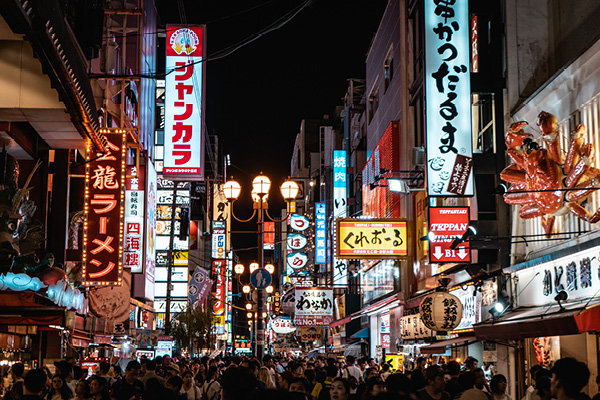
Take in the bright neon lights of Osaka’s Dotonbori district.
1. Walk around Dotonbori
Take in the bright neon lights of Dotonbori , window-shop (if you’re on a budget) and stop for dinner at one of the many restaurants on offer to get your fill of ramen, takoyaki balls and all the weird and wonderful Japanese food you can consume.
Address: Dotonbori, Chuo-ku , Osaka 542-0076, Osaka Prefecture
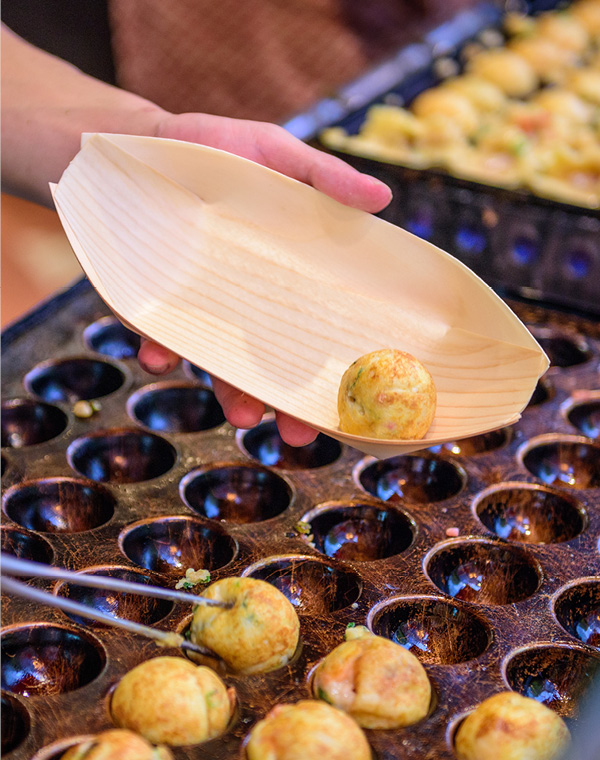
Sample some delicious takoyaki balls while you’re there.
2. Osaka Castle
Not only is it one of the most beautiful landmarks in Japan, Osaka Castle , it’s also free to visit the castle grounds and surrounding Nishinomaru gardens. If you wish to enter the castle and take in the view from the top, you’ll pay 600 yen (children under 15 years are free). The 14th century castle is surrounded by water and moat, and is one of the best places to view the famous cherry blossoms during April. Pack a picnic and spend the afternoon in the gardens with the locals.
Address: 1-1 Osakajo, Chuo Ward, Osaka, 540-0002, Japan
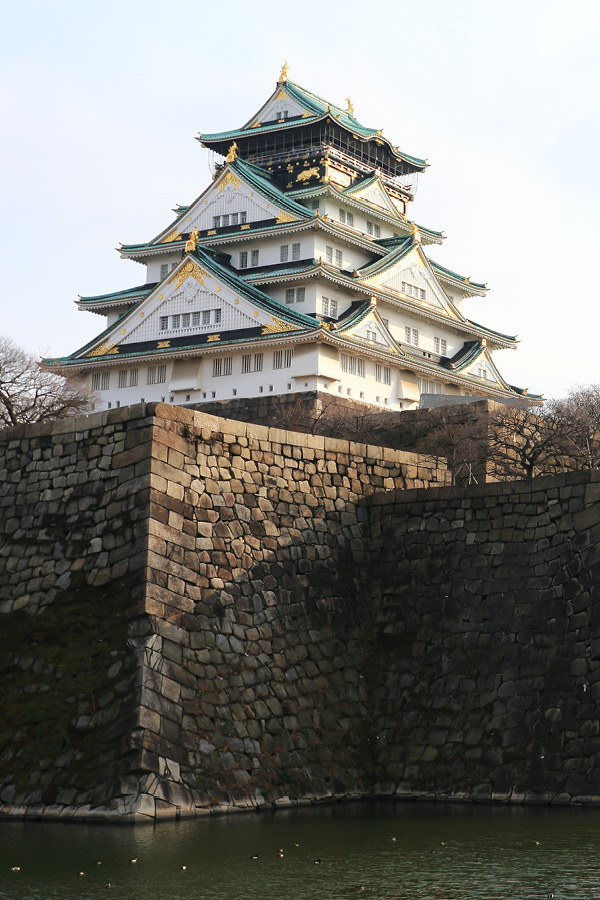
Osaka Castle is one of the most beautiful landmarks in Japan.
3. Sumiyoshi Shrine
One of the oldest Shinto shrines in Japan, the Sumiyoshi Shrine , with it’s striking red bridge and peaceful atmosphere is a must-see when in Osaka. Built over 1800 years ago, the shrine is beloved for its ornate architecture that is purely Japanese in design (it was built before the influence of Buddhist architecture).
Address: 2-9-89 Sumiyoshi, Sumiyoshi-ku , Osaka 558-0045, Osaka Prefecture
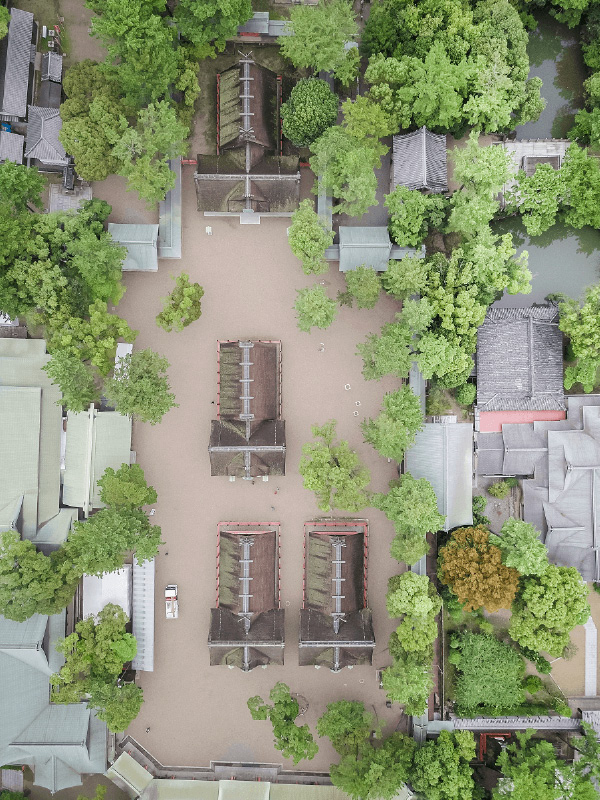
The Sumiyoshi Shrine is one of the oldest Shinto shrines in Japan.
Hotel Ichiei
For a traditional Ryokan stay with a modern twist, check in at the Hotel Ichiei. Sleep on a rolled out futon atop tatami mats with the added bonus of all the mod-cons you’re used to. Prices start from $189 a night per room.
Address: 1-6-8 Nanbanaka, Naniwa, Osaka 556-0011 Osaka Prefecture
Read more: the ultimate travel guide to Osaka
Want to know more about Japan? Read our ultimate travel guide to Japan .
Leave your comment, cancel reply.
Save my name, email, and website in this browser for the next time I comment.

You might also like
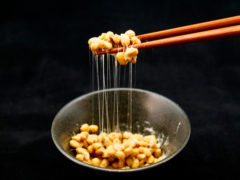
7+ strange Japanese foods to try while you’re there
A brief guide to all of the weird and wonderful dishes you can try during a visit to Japan. Japan is undoubtedly a country that has a plethora of del...
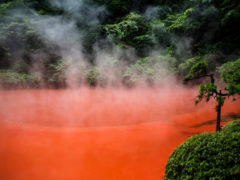
Japan’s gorgeous hidden gem Ōita
Let the sights of Tokyo be your starting off point on a journey to discover the hidden gem of Ōita. Getting from A to B in Japan is ridiculously e...
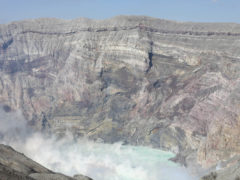
See a side of Japan that tourists are yet to discover
Tokyo, Kyoto, Osaka and Hiroshima – the Japanese golden route. It’s a trail many have completed, and one many aim to complete during their lifetim...

- Philippines
- South Korea
- National Parks
- Travel Stories
- How Much Does It Actually Cost to Travel the World?
- What’s In My Backpack: The Ultimate Long-Term Travel Packing List
- My Favorite Non-Fiction Travel Books
- All Budget Travel Resources
- Writing Portfolio
15 Tips For Visiting Japan on A Budget (How to Travel Cheap in Japan!)
This post may contain affiliate links. This just means I may receive a small commission at no extra cost to you for helping them promote their product or service. I don’t endorse any services I don’t personally use or recommend.
Japan is widely known as the most expensive destination in Asia. I’m not going to contest that fact, but I am going to show you how to save LOTS of money on your next trip. Because Japan is one of those places that everyone wants to visit. A bucketlist destination if you will. While it wasn’t cheap, it was also not nearly as expensive as we had originally thought. And with these tips for visiting Japan on a budget, it can even be a rather affordable destination open to exploration by all kinds of travelers.
This list isn’t going to include any Workaway or long-term travel tips for those staying months in the country. Instead, it’s going to focus on actionable easy budget-saving tips that people on a short trip can use to save bigtime in Japan.
15 Tips For Visiting Japan On a Budget
Transportation is by far the most expensive cost for travelers in Japan. We’re gonna start with ways that you can save while hopping from destination to destination in the country.
1. The big question: Japan Rail Pass or no Japan Rail Pass?
I actually wrote an entire post detailing my decision NOT to buy the Japan Rail Pass for $370 per person. The low-down is that we saved about $100 each by purchasing bullet train tickets on our own. We didn’t have to do an immense amount of research either. We just turned up and bought tickets.

Check out my full post to see everywhere we went so you can compare your itinerary and make sure that buying the Japan Rail Pass isn’t right for you.
2. Get Unreserved Train Seats.
When you’re purchasing your Shinkansen (Bullet Train) tickets be sure to specify that you want unreserved seats. This means you’ll be sitting somewhere in cars 1-6 and left to choose your own spot. These are much cheaper. If you’re traveling as a duo you’ll most likely still be able to find seats next to one another.
3. Choose buses.
Buses are cheaper than trains & astronomically cheaper than bullet trains. If time isn’t a constraint for you (or if you can plan for these travel days) choose at least a few buses to save hundreds of dollars.
4. USE the Metro!
I probably don’t need to tell you that Japan has impressively clean, well-connected metro and train lines in each major city so you’ll never need to use a taxi. You can reach every single destination by metro, bus, or walking. I promise. In slightly smaller cities biking is a great way to get around and is very popular among Japanese people.
Keep in mind that most metro stations (and all buses) require cash to purchase tickets.
5. Skip the SIM.
Everyone told us you need a SIM card to travel in Japan. But honestly, we found Japan super easy to travel without one. There’s free wifi everywhere (buses, trains, some towns) and maps.me has accurate metro info for offline use. All kiosks for restaurants and metro use had English language options and for the few menus that didn’t— use can download Google translate offline.
6. Book your accommodation ahead of time.

Budget-friendly places fill up first. Unfortunately, Japan is one of those countries where planning ahead is going to save you lots of money. Our guesthouses and hostels were all booked on Booking.com and Hostelworld.com for anywhere from $7.50-$23 per person. Hakone and the areas around Mt Fuji are the most expensive regions while Osaka had a $15 private room (not a great one but hey, what can you expect).
You’ll probably need to book at least a month ahead for the high season.
7. Where you stay in Tokyo matters.
Tokyo is huge. Sprawling. But luckily there are lots of interconnected metros including one circular JR line that rings the best part of the city. We stayed in Nippori. This is in the far northeastern part of the city. Most of the places we wanted to see were located in the West and Southwest. This meant lots of metro trips, most 40 minutes or more.
If you plan to stay less than 4-5 days in Tokyo, instead of simply choosing the cheapest place to stay, look for a conveniently located neighborhood. Otherwise, you’ll spend a lot of time and money on the metro.
Consider the 24-hour Tokyo Pass (cost: 800 yen) on days you’ll do LOTS of sightseeing in various neighborhoods. You can purchase it at all the major metro stations.
8. Don’t visit ANYWHERE on a weekend.
Obviously, you have to do something on a weekend. Make sure it’s Tokyo, Osaka, or another major city. Tourist cities like Hiroshima, Kyoto, Magome, Hakone, and more are absolutely flooded with local tourists. I mean A LOT of tourists. It’s kind of insane. You’ll have to wait in incredible lines. Plan accordingly.

9. Kyoto is all about picking and choosing.
To keep Kyoto budget-friendly you can’t see everything. Many Buddhist temples in the city charge an $8-$15 entrance fee. This is probably to combat overtourism in an area that sees an incredible amount of visitors. We found that the free shrines were often the best because they saw fewer people and it wasn’t just massive crowds jostling for a photo op. Shoren-in Temple even has a tea ceremony that’s authentic for half the price of typical touristy tea ceremonies. I wrote about how to attend it here.
I recommend making a list of a few attractions and sticking to those rather than trying to see everything. These are our favorite things in Kyoto.
- Bike to the Bamboo forest just out of town early in the morning.
- Hike to the top of Fushimi Inari Taisha, not just a quick photo op visit.

If you’re looking to splurge on food in Kyoto, and it’s got some excellent options, definitely pay Teppan Tavern and La Bac a Sable a visit. Teppan Tavern serves Wagyu A5, traditional Kyoto bites, and homemade Umeshu (plum wine) that’s better than anywhere else for dinner. Seriously, this is the highlight of Japanese hospitality and it won’t break the bank. We spent $40 on a full meal with a few drinks. The French bakery is the perfect lunch pick-me-up.
10. 7/11, Family Mart, and Lawsons.
These are convenience stores scattered all over Japan. They have the cheapest beer and chu-hi, the cheapest coffee, and a wide array of Japanese snacks and desserts. But the best part is the bento boxes and hot food. You might be put off by the sushi, pizza or curry stuffed bao, habanero chicken strips, and tonkatsu meals but they are actually excellent and good quality! It’s a very popular stop for commuting Japanese residents. Keep in mind that hot food is usually restocked just before popular meal times.

In my professional opinion, the best food goes to Family Mart— but the best coffee goes to Lawsons.
Most restaurants don’t open until 10-11 AM and few hostels offer breakfast which leaves you out of luck. But these stores are a great cheap option for breakfast. Or late night meal. Or lunch.
11. Another cheap meal option? Conveyor belt sushi.
These places are the best. And they happen to be the most budget-friendly restaurants for great traditional Japanese sushi. You can typically get 10 plates between $8-15 depending on the items you select. This is a great way to familiarize yourself with sushi menus and sample new things too without having to commit to a whole set.

12. Share meals!
Unlike South Korea , a country we visited just before Japan, it’s very easy to order one dish and share. In Korea, you often pay by the person for popular meals like Korean BBQ. A major pain in the wallet for budget travelers looking to sample a lot of different items. Japan, fortunately, does not follow this rule and it’s quite easy to share several small plates for cheap.
13. Buy food for your Magome excursion.
I wrote an entire post detailing everything you need to know about hiking from Magome to Tsumago. I highly recommend this trip but since all restaurants close by 5 PM and I found most to be overpriced in the area— be sure to buy your own food from a Family Mart before you head to the mountains. Don’t forget trail snacks!

14. Beer is the most expensive alcohol in Japan.
Skip the beer and instead opt for Japanese Whisky highballs, Plum Wine, Shochu, and sake for cheaper drinking options.
15. Choose Omoide Yokocho over Golden Gai for a night out.
If you are looking for Tokyo drinking hot spots and nightlife, Omoide Yokocho is cheaper and more authentic than the late-night Golden Gai district. In Golden Gai, the drinks aren’t as strong and you’ll often have to pay a cover to even sit at the bar. It was still worth wandering through the alleys of each but I much preferred Omoide for dinner and a night of drinking.

How much did we spend in Japan on a Budget?
Let’s look at a quick budget breakdown of what we spent while visiting the country. Keep in mind, we only took trains and bullet trains because we had a short amount of time. We also didn’t know many of the above tips beforehand and would have booked our Magome accommodation much further in advance. So basically, I think you could save hundreds by following our tips above.
How much we spent in total for 19 days for two people: $2,687.55
How much we spent per day per person: $70.72 per day per person!!!
I hope this information helps you feel more confident to visit Japan on a budget and save lots of money while you do so! This was our most expensive trip BY FAR and with these tips, we could have easily cut costs by hundreds of dollars. Let me know in the comments if you think you have any Japan budget travel tips to add to my list.
Save This Post For Later!

Further Reading...

How to Experience a Traditional Japanese Tea Ceremony in Kyoto

What It’s Really Like Staying in Hostels (For Travelers 25 & Older)

A Savvy Budget Travel Guide to Jordan (How to Save on Petra + Wadi Rum)
No comments, leave a reply cancel reply.
Save my name, email, and website in this browser for the next time I comment.
Notify me of new posts by email.
Sign up to our newsletter!
This site uses Akismet to reduce spam. Learn how your comment data is processed .
10 Days in South Korea: A Mini Travel Guide (2023)
Beyond_the_bucketlist.


Visit Japan on a Budget
Free or affordable destinations in the archipelago.
Traveling in Japan with a limited budget is possible. The islands’ life might seem costly, however the archipelago offers a wide range of transportation and accommodation services adapted to all budgets. Planning in advance remains the best solution to dig out the best value for money .
For those having time , long distance trips between larger cities can be done by night buses or boats . Also, hitch hiking works in the countryside.
There are several solutions to sleep at lower costs such as " manga kissa", capsule hotels and minshuku guest houses. Couch-surfing, that is to say free lodging at an inhabitant’s house, is less developed than in Western countries due to the small size of houses and the difficulty for Japanese people to welcome strangers at home.
On site, the country offers numerous free visits and combined tickets for several places, or comprising the transportation to get there from the closest train station. You can find here our information and advice to stay in Japan with a smaller budget and free destinations to visit .
Finally, to better estimate your spendings during your stay in the Japanese archipelago, you can use our Travel Budget Calculator .
- Flights and Airports
- Accommodation
- Transportation
- Internet & Phones
- Budget and money
- Japanese Food
- Visit with Kids
- Seasons: spring / summer / autumn / winter
- Weather forecast
- Time in Japan
- Holidays & Festivals
- Natural Disasters
- Customs and Duties
- Works and Closures
- From April 14 to 15 -- Sanno Matsuri (the Spring Takayama Festival)
- From April 29 to 5 May -- Japanese Golden Week
- May 12 -- Mother's Day in Japan
- June 6 -- Beginning of the rainy season (Tsuyu) in Japan
- June 21 -- Summer starts in Japan
- From July 1 to 31 -- Gion Matsuri Festival in Kyoto with float processions on July 17 and 24
- Tokyo : Shinjuku , Shibuya , Harajuku , Asakusa , Akihabara , Odaiba , Ikebukuro , Ueno , Roppongi , Chiyoda , Ryogoku ...
- Around Tokyo: Kamakura , Nikko , Hakone , Mount Fuji , Mount Takao , Yokohama ...
- Kansai: Kyoto , Nara , Osaka , Mount Koya , Himeji , Kobe , Kinosaki , Kumano Kodo , Ise ...
- Japanese Alps: Kanazawa , Matsumoto , Takayama , Shirakawa-go , Nakasendo ...
- West: Hiroshima , Miyajima , Shikoku , Onomichi , Naoshima , Izumo , Kurashiki , Matsue ...
- South: Kyushu , Okinawa , Yakushima ...
- North: Hokkaido , Tohoku ...

- Temples and Shrines
- Gardens and Parks
- Hiking and Trekking
- Observation Decks
- Public Baths (Onsen and Sento)
- Festivals (Matsuri)
- Amusement Parks
- Visit on a Budget / Luxury

Keikaku is a travel agency specialist of Japan and providing different kind of services:
- Japan Rail Pass
- English speaking Guides
- Pocket Wi-fi
- Japan Nightlife
- Working in Japan
- Religion and Spirituality
- Arts and History
- Movies / Animated Movies
- Japanese Music
- Studio Ghibli
- Photos / Videos
- Weird Japan
- Translations
- Kana & Kanji
- Japanese Swear Words
- Honorific Suffixes (san, kun, chan...)
- Introducing yourself
- Thank you / Apologize
- Count / Say Your Age
- Say the Date / Tell the Time
- Happy birthday
- Enjoy Your Meal
- Writing your name

Kanas are the much-needed basic characters of written Japanese language. Memorize them at a fast pace with our method.

Ask any kind of question and share your knowledge about Japan in Kanpai’s community space, our Q&A section Kotaete.

Isshoni means "together" in Japanese: share your trip details (dates, places you would like to visit) and find companions to travel in Japan.

Create your Kanpai account to manage your profile and view your participation history (questions, answers).
How to Travel Cheap in Japan

If you know some tips to save some money, you can actually travel cheap in Japan. You may think traveling to Japan would be very expensive, but it is more affordable than you think. Here we introduce how to travel cheap in Japan!
1. Travel season
Transit pass, take-away meals at grocery stores and convenience stores, kaiten zushi (conveyor belt sushi), business hotels, hostel / guest house, 5. explore cheap, 100 yen shop, japan wonder travel tours , read more japan tips.
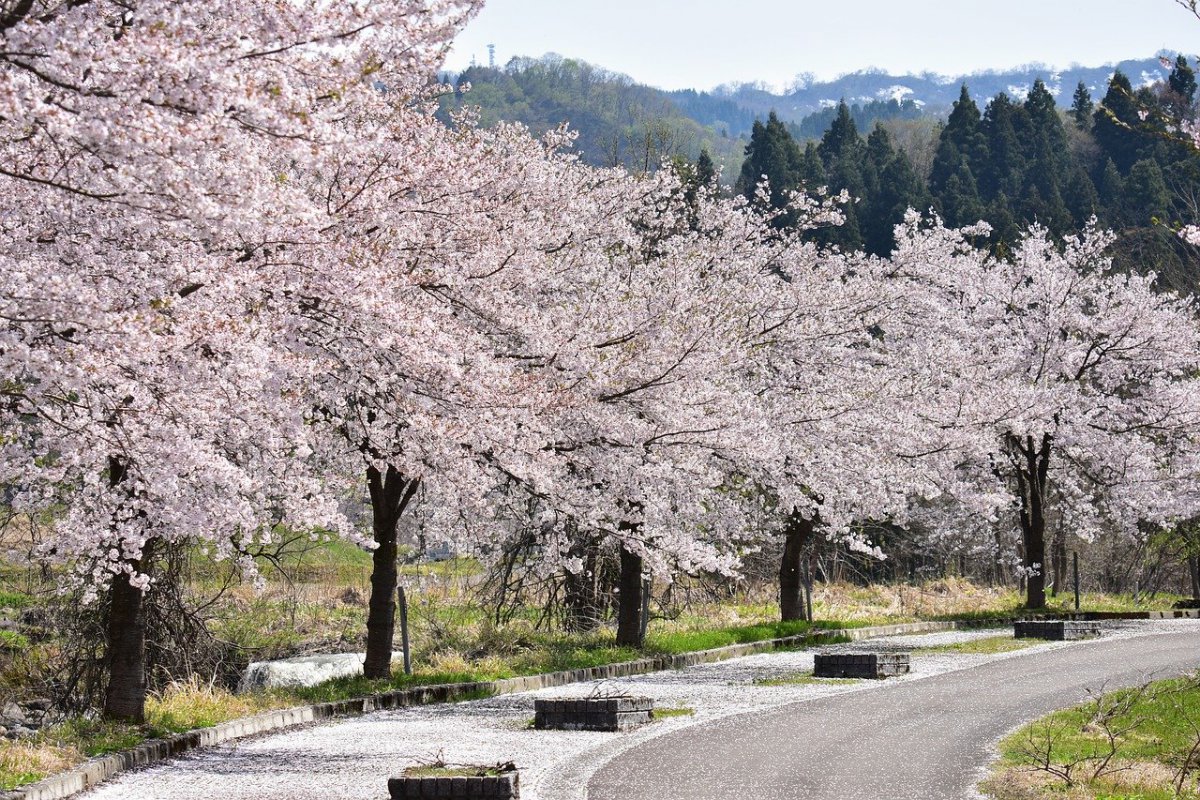
Peak seasons for Japanese travelers (which means peak hotel rates) are usually cherry blossom season from late March to early April, and autumn foliage season from mid-November to early December. Japanese holidays such as Golden Week (usually from late April to early May), Obon (mid-August) are considered as peak season for domestic travelers as well. In this period, hotel prices, entrance prices etc. tend to be higher.
Off-season in Japan is from late autumn through early March except for the New Year’s holiday season , and from late May to early July. Please note, however, that June to early July in Japan is normally a rainy season (tsuyu). You can still enjoy your Japan trip during the rainy season since there are many indoor activities and actually, in Tokyo area, it rains more in September to October due to the typhoon season. So it might not be a bad idea at all if you choose to travel in Japan in June to early July!
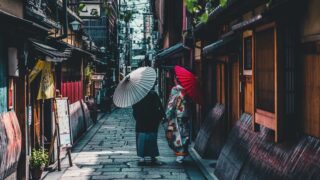
2. Getting around cheap
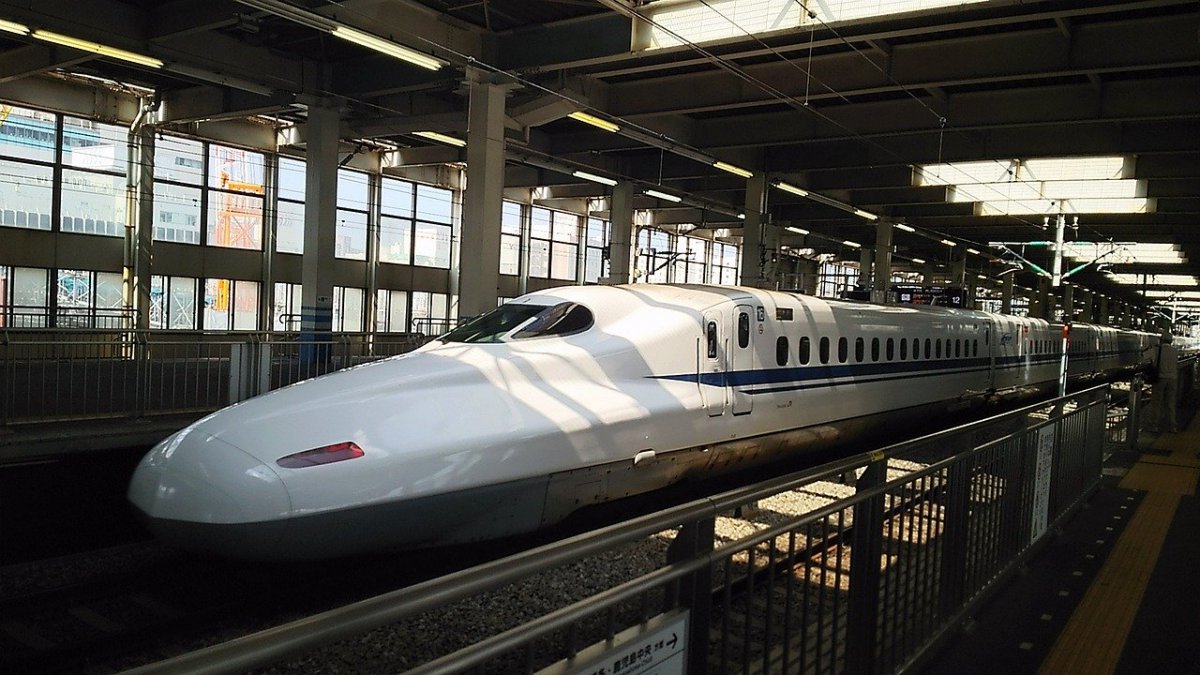
When you travel between cities in Japan, Shinkansen or “bullet train” operated by Japan Railway (JR) is the fastest and most convenient way to take. However, the prices of the Shinkansen can be very expensive.
One-, two-, or three-week JR Pass will pay off for long distance rail trips within Japan. One-week JR Pass is about ¥30,000 (US$276), two-week JR Pass is about ¥47,000 (US$440), and three-week JR Pass is about ¥60,000 (US$560). If you are planning to visit Tokyo, Kyoto, and Hiroshima, and come back to Tokyo, for example, the prices for Shinkansen non-reserved seats will be ¥13,320 (Toyo-Kyoto) + ¥9,450 (Kyoto-Hiroshima) + ¥18,910 (Hiroshima-Tokyo) = ¥41,680. The reserved seats are a little more expensive.
JR Pass is not only for Shinkansen. It can also be used to get around within the city, so you can save even more if you choose to use JR over metro or other private railway companies to explore the city.
So if you are planning to visit several cities in Japan, getting JR Pass is recommended. The best option is to purchase the JR Pass before you come to Japan and activate it upon arrival, this will be your cheapest option!
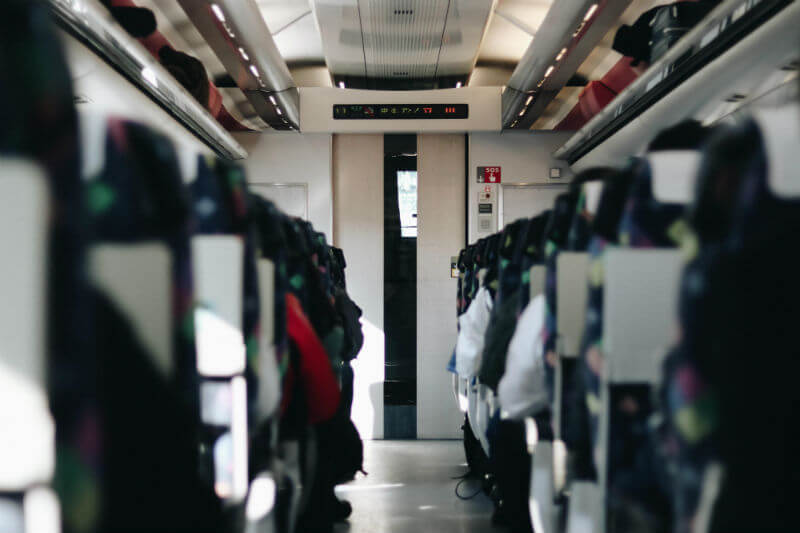
Alternatively (or in addition to JR pass), you may want to consider traveling by bus . It is usually cheaper to take a long distance bus than taking trains, and buses may cover the areas where JR trains are not available.
For example, between Narita Airport and central Tokyo, there is the Narita Express train that connects Narita Airport and major cities in and around Tokyo, and is served by JR. However the JR Pass in not available for Narita Express train. Therefore, we recommend you to take a bus. From Narita Airport to Tokyo Station, Narita Express takes you in 80 minutes with ¥3,070, while the Airport Bus TYO-NRT takes you in about 65 minutes with ¥1,000. ▶ How to Get to Narita Airport
Many bus companies exist in Japan, and most such as Willer Express offers 3, 5, and 7-day bus passes priced from ¥10,000 to¥15,000. You can choose any 3, 5, or 7 days non-consecutively within two months.
The long distance buses are clean, quiet, safe, and comfortable with reclining seats. You can save a night accommodation if you take overnight bus routes. Some overnight buses are equipped with a pull-over head blind or curtains between the seat next to yours to block out light.

Many transit companies in Japan offer transit passes with which you can save fair amount of money when you are exploring the area. For example, in Tokyo, you can get Tokyo Metro 24-Hour Pass (¥600), Tokyo Metro and Toei Subway One Day Pass (¥900), and Tokyo Free Pass (¥1,600) which allows you free access to Tokyo Metro, Toei Subway, Toei Bus, and JR within 23 wards in Tokyo within 24 hours. These passes can be purchased at ticket vending machines in the train stations. Read more details on the official site of Tokyo Subway Tickets
3. Eating cheap

Fast food in Japan is not all about deep-fried, highly processed foods. You can find fast food restaurants serving steaming bowls of rice with savory meats, freshly boiled udon or soba noodles with variety of toppings, and a plate of Japanese curry rice which is one of Japanese soul foods.
Although there are worldly renowned fast food restaurants such as McDonalds , Burger King , and KFC all over Japan, you can also find Japanese fast food chain restaurants with affordable prices. Matsuya , Sukiya , and Yoshinoya serve Japanese style breakfast, rice bowls with meat or fish, Japanese curry rice, and set menu with rice, miso soup and main dish. The price of a rice bowl with savory meat, called “gyudon” in these restaurants is around ¥350. CocoCurry House Ichibanya serves Japanese curry rice, and its pork curry costs ¥500. Marugame Seimen and Hanamaru Udon are udon noodle fast food restaurants. The prices of their menu range from around ¥300 to ¥900. Some of these restaurants open 24 hours.
In many train stations, on the platform or near the ticket gate, you are likely to find soba and udon noodle shops, and they are often stand-up shops. These noodle shops are for those people who want to eat quickly and inexpensively before getting on the train.
In some fast food restaurants, you have to select and pay for your meal at a vending machine at the entrance of the restaurants, and bring the ticket to the staff. Not only the fast food restaurants, you can get lunch with a cheaper price on weekdays at many places.
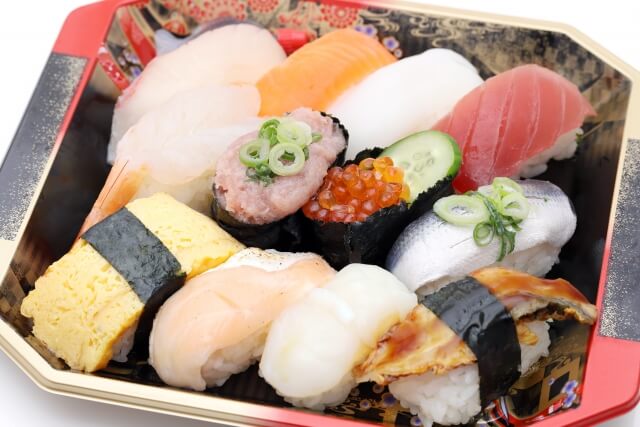
Cheap and fresh bento boxes, noodles, rice balls, sandwiches are other options available at Japanese grocery stores and convenience stores. They are great for picnics, hikes, and of course, eating at home/hotel. The prices range from ¥150 to ¥500.
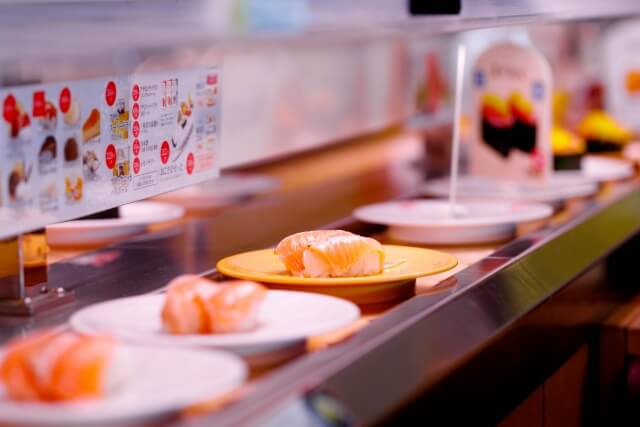
You can taste one of the most popular Japanese food in the world and experience Japanese unique dining culture with affordable prices. Sushi-go-round, conveyor belt sushi, or “kaiten zushi” can be a great way to dine affordably in Japan. This kind of sushi shop such as Sushi Ro or Kura Zushi serves a plate of sushi from ¥100. The plates are color-coded by price. Sushi Ro serves not only sushi but also miso soups, fried chicken, fried potatoes, tempura, salad, udon noodles, ramen noodles, and Japanese desserts.

4. Staying cheap

When you are staying in Japan for a few days or weeks, accommodation cost can make a big difference. You can save significant amount of expense if you find a place to stay with Airbnb. Airbnb offers many affordable apartments right in popular cities such as Tokyo, Kyoto, and Osaka where the hotels are usually more expensive than other areas, and can provide more local feeling experience than staying in a hotel.
Business hotels can be found readily across Japan, providing economical and no-frills accommodation to travelers. They usually offer single- or double-occupancy rooms under ¥12,000/night. The rooms are relatively small but clean and equipped with a bed, desk, television, refrigerator, air conditioner, a bath with a shower unit over a bathtub, and an electronic kettle with complimentary green tea bags. WiFi is usually included and many have on-site laundry facilities.
Some famous business hotel chains include Route Inn , APA Hotel , Super Hotel , Dormy Inn . Many of them are located conveniently close to railway stations or highway exits.
Stay at a hostel or guest house will be a good option for your stay. It is more welcoming and friendly atmosphere with a modern and stylish designed decor. If you want to have an opportunity to meet locals and other travelers and enjoy interacting with others, choose a couple of nights to stay at the hostel or guest house!
Our recommended place to stay; CITAN hostel Book And Bed Tokyo Asakusa Sakura House
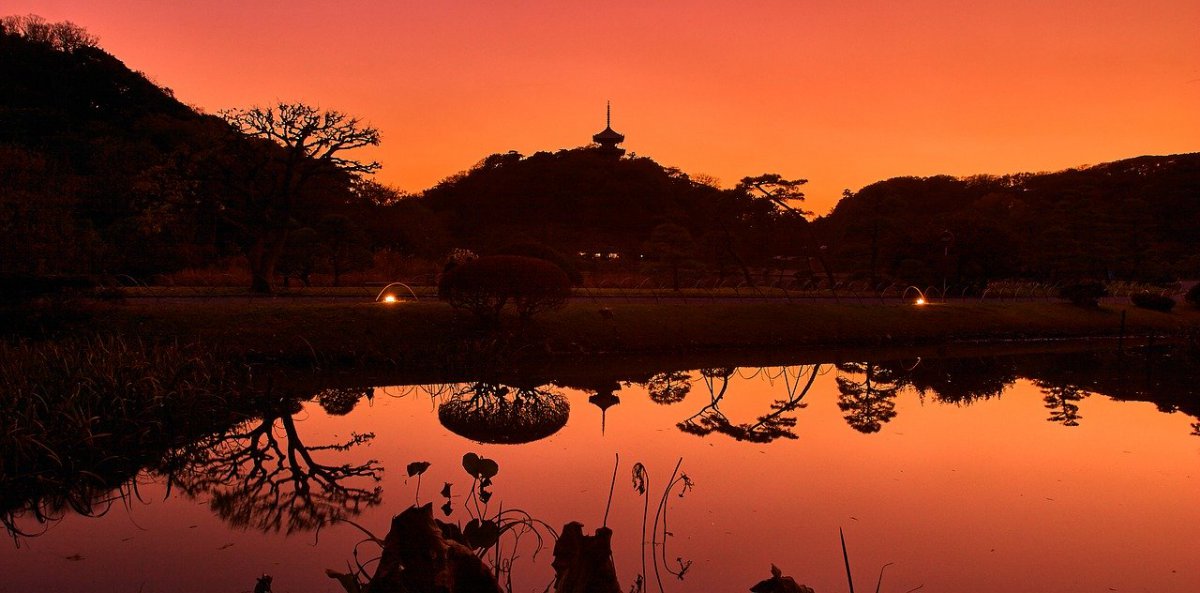
If you plan on visiting several museums and art galleries in the Tokyo region, the Grutt Pass is a well worth purchase for savings. For only ¥2,200, you can get free admission and/or discounts to 99 facilities: 82 museums, 3 zoos, an aquarium, and 13 gardens. Some of the popular facilities which the Grutt Pass provides the admission include Ueno Zoo , Sankeien Garden , Edo Tokyo Museum , and National Museum of Emerging Science and Innovation (Miraikan), and the discount for the National Museum of Nature and Science , Tokyo National Museum , and National Museum of Modern Art , Tokyo.
6. Shop cheap
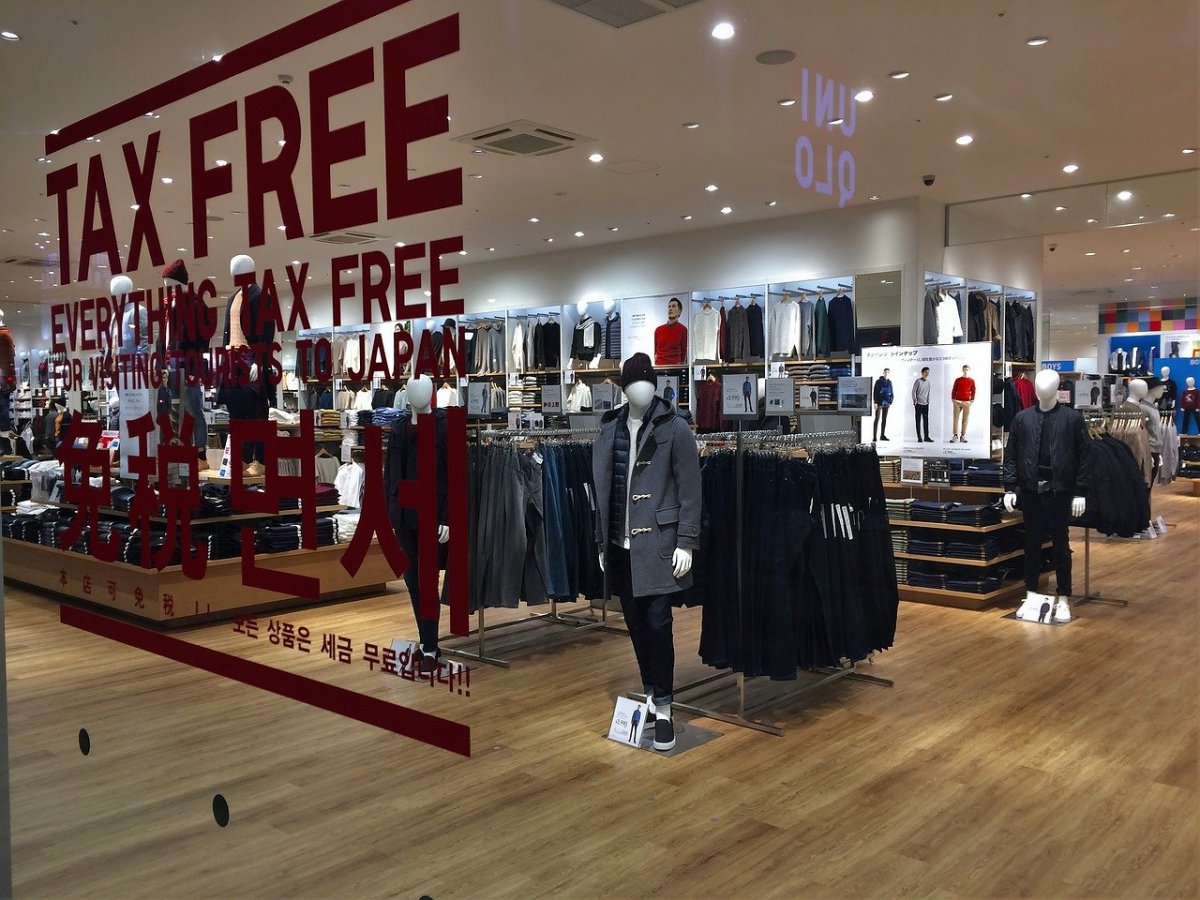
Many department stores and other shops can waive Japan’s 10 percent sales tax for visitors from overseas. Do not forget to bring your passport with you. As you explore Tokyo, you may find many stores with tax-free signs at the entrance especially some chain pharmacy such as Matsumoto Kiyoshi , Tsuruha Drug , and Drug Seims . Popular gift shops such as Donguri Kyowakoku which is an official store for Ghibli movies, and Kiddyland which is a toy and character goods mecca also waive the tax.
100 yen shops in Japan are great place to look for gifts for your family, friends, coworkers, and yourself. They offer daily necessities, designer stationery, and all kinds of products for only ¥100 (often before tax). Usually the quality and designs of the products are surprisingly good for their prices and there are some useful and innovative goods. Three popular 100 yen shops in Japan are Daiso , Can Do , and Seria .
Japan Wonder Travel is a travel agency that offers guided tours throughout Japan. From private walking tours to delicious Food and Drink tours, we can help you organize the best tours just for you! If you want to explore Japan and learn more about the history and backstories of each area you are visiting, our knowledgeable and friendly English speaking guides will happily take you to the best spots! In addition, we can provide you with any assistance you may need for your upcoming trip to Japan, so please feel free to contact us if yu have any questions or need some help!
▶ Tokyo Fish Market Tour @Tsukiji – Enjoy Local Food and Drink Explore the most lively and popular fish market in Tokyo and try some of the local’s favorite street foods and sake with one of our friendly and knowledgeable English speaking guides!

▶ Tokyo 1–Day Highlights Private Walking Tour (8 Hours) There’s no better way to explore an area than taking a tour with a knowledgeable local guide. You will have the chance to learn about the history and interesting background stories of Tokyo, as well as discover some hidden gems which can be hard to do without a guide.

▶ Mt. Fuji Day Trip Bus Tour from Tokyo Experience the breathtaking views of Mt. Fuji by visiting the highlights of the area on our guided sightseeing bus tour! Departing from Shinjuku in central Tokyo, you can travel comfortably to all of the best spots in the area by bus.

How did you think about our tips for traveling cheap to Japan? There are many ways to save your travel expenses and we hope this article helps you to travel Japan under budget!
Follow us on Instagram or Facebook for more travel inspiration. Or tag us to get featured!
Happy travelling!

This post may contain some affiliate links. When you click through and make a purchase we may receive some commission, at no extra costs to you
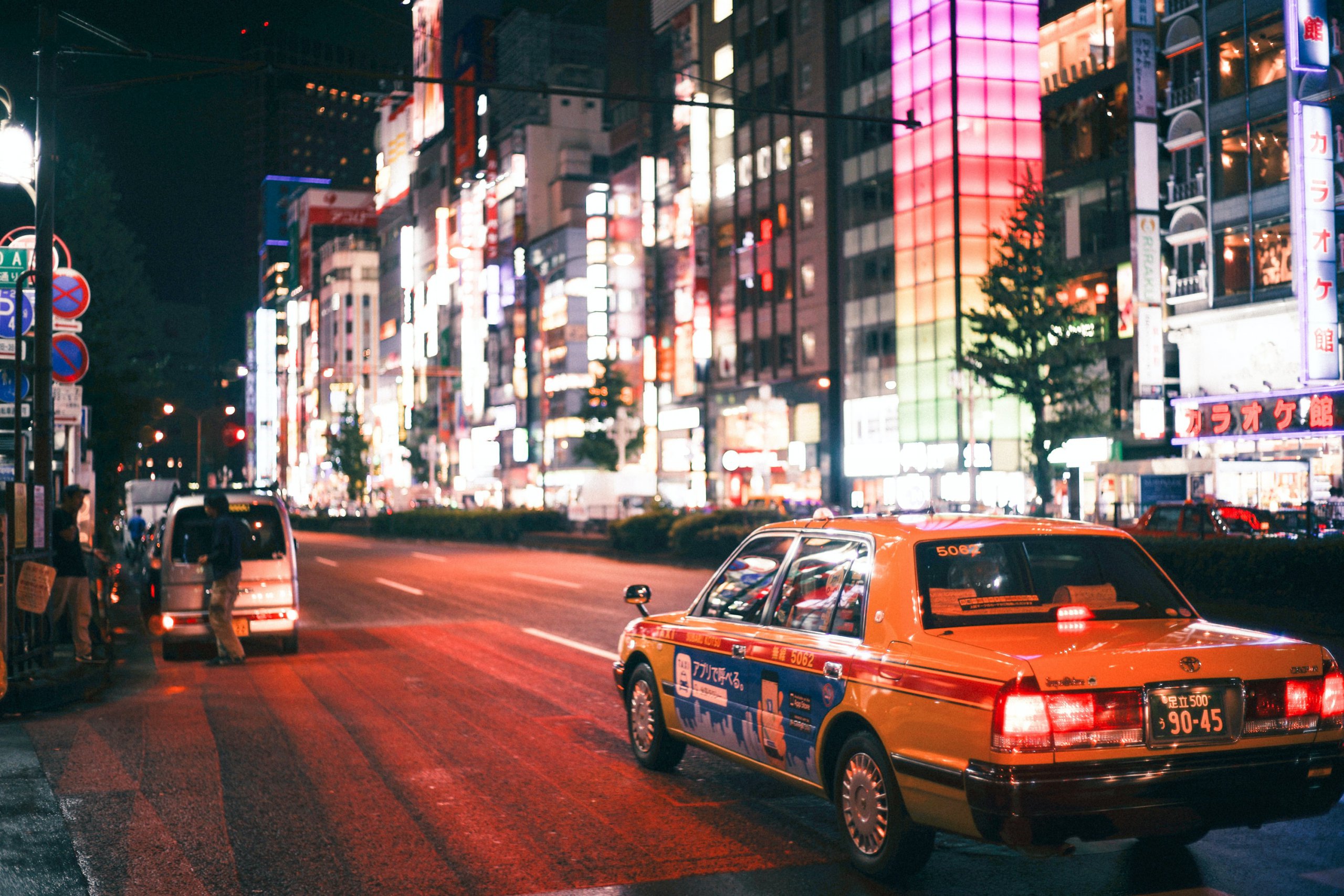
- Popular destinations
- Hidden places in Japan
- Tours and workshop
- Food and drink in Japan
- Itinerary in Japan
- Places to visit in Tokyo
- Food and drink in Tokyo
- Seasonal events
- Tours & workshops
- Tokyo This Week
- Day trip from Tokyo
- Itinerary in Tokyo
- Places to visit in Kyoto
- Food and drink in Kyoto
- Itinerary in Kyoto
- Day trip from Kyoto
- Travel tips
- Accommodation
- Cultural tips
- Transportation
- Tokyo Tours
- Kyoto Tours
- Kimono Rental
- Fukushima Tours
- Mount Fuji Tours
- Tour Package
- Media Kit(English/日本語)
THE 10 BEST Cheap Things to Do in Japan
Best budget-friendly things to do in japan.
- 5.0 of 5 bubbles
- 4.0 of 5 bubbles & up
- 3.0 of 5 bubbles & up
- Ginza / Tokyo Nihonbashi
- Ueno, Asakusa
- City Center
- Shibuya / Harajuku / Ebisu
- Budget-friendly
- Good for Kids
- Good for Big Groups
- Good for a Rainy Day
- Good for Couples
- Honeymoon spot
- Hidden Gems
- Adventurous
- Good for Adrenaline Seekers
- Things to do ranked using Tripadvisor data including reviews, ratings, photos, and popularity.
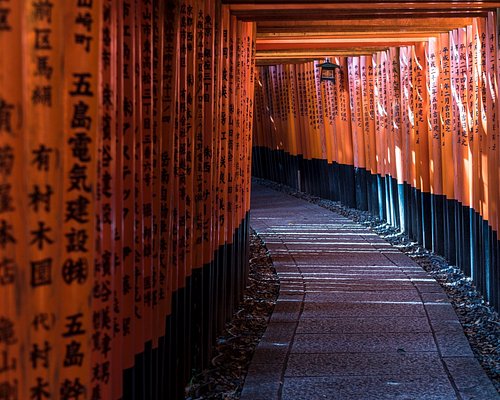
1. Fushimi Inari-taisha Shrine
2. Kinkakuji Temple

Recommended Experiences (27)
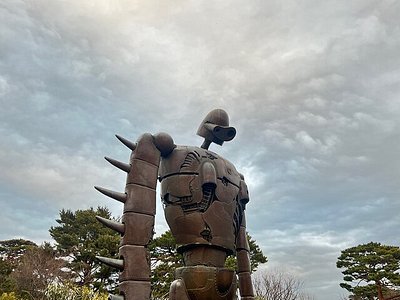
3. Kiyomizu-dera Temple

4. Hiroshima Peace Memorial Museum

5. Dotombori District

6. Senso-ji Temple
7. Shinjuku Gyoen National Garden

8. Todai-ji Temple

9. Meiji Jingu Shrine

10. Atomic Bomb Dome

11. Himeji Castle
12. Nara Park
13. Miyajima
14. Asakusa
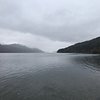
15. Kenrokuen Garden
16. Sanjusangendo Temple
17. Okinawa Churaumi Aquarium
18. Ueno Park
19. Hiroshima Peace Memorial Park
20. Owl cafe tokyo Akiba Fukurou
21. Itsukushima Shrine

22. The Hakone Open-Air Museum

23. Matsumoto Castle

24. Ginkakuji Temple
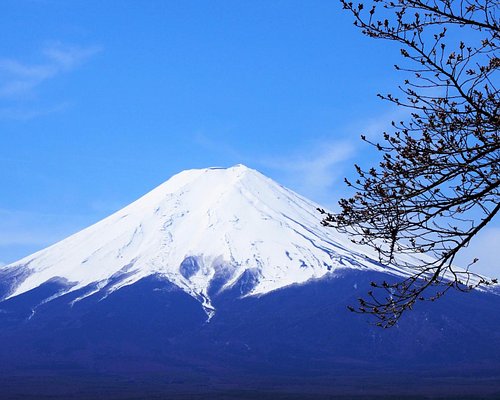
25. Mount Fuji

26. Tokyo Metropolitan Government Building Observation Decks

27. Jigokudani Snow Monkey Park

28. Monkey Park Iwatayama

29. Ise Jingu

30. Nikko Tosho-gu

What travelers are saying

Cheapest Cities to Live in Japan (Housing, Food, and Cost of Living)
As an Amazon Associate, I earn from qualifying purchases
Spending your entire life in a single location can get boring, particularly if you stick to the same daily routine. Sometimes, the solution to a monotonous lifestyle is moving to another country.
After all, exploring new cultures, cuisines, and attraction sites can give your life a fresh perspective.
Japan is famous for many things, and in a positive way. The country boasts a rich cultural heritage spanning many centuries.
However, its most distinctive quality is combining the old and the new.
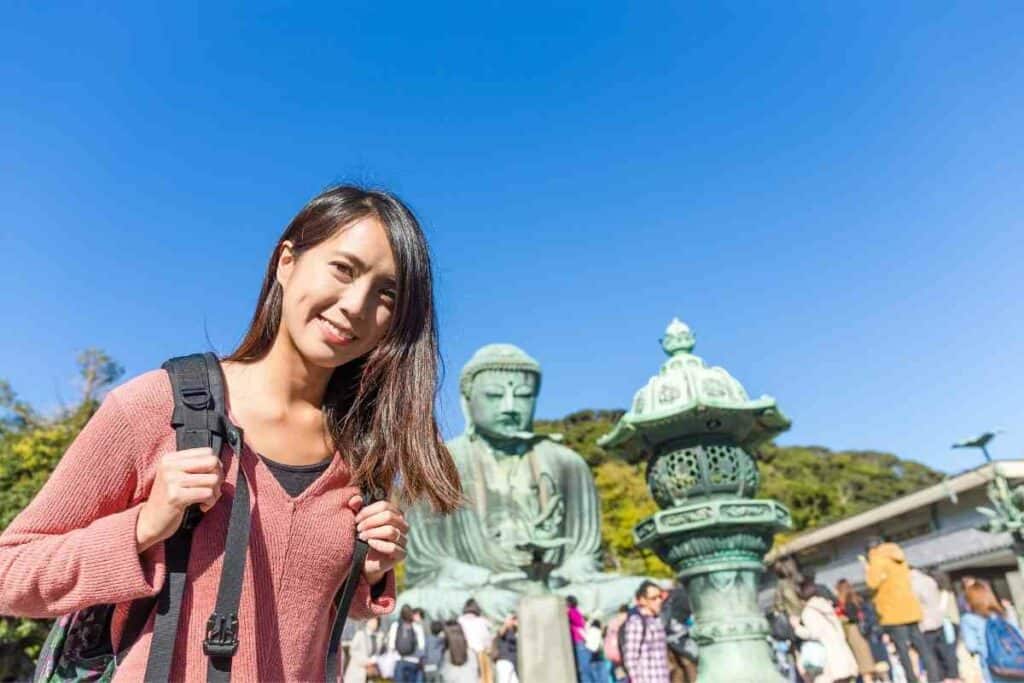
Walking through Japanese cities, you’ll enjoy traditional cuisines and art while catching a glimpse of ultramodern skyscrapers and futuristic transport networks.
It’s worth noting that living in Japan isn’t cheap. You can’t expect to get all the perks mentioned above on a shoestring budget.
What to Expect? You can still find some affordable cities to call home. If you want to live comfortably without draining your savings account, try the following cities.
Table of Contents
Cheap Cities to Live in Japan
Yokohama is a port city on Japan’s Honshu Island.
It’s the headquarters of many multinational companies, including Bank of Yokohama, JVC, Kenwood, Nissan, and Yokohama Tyres.
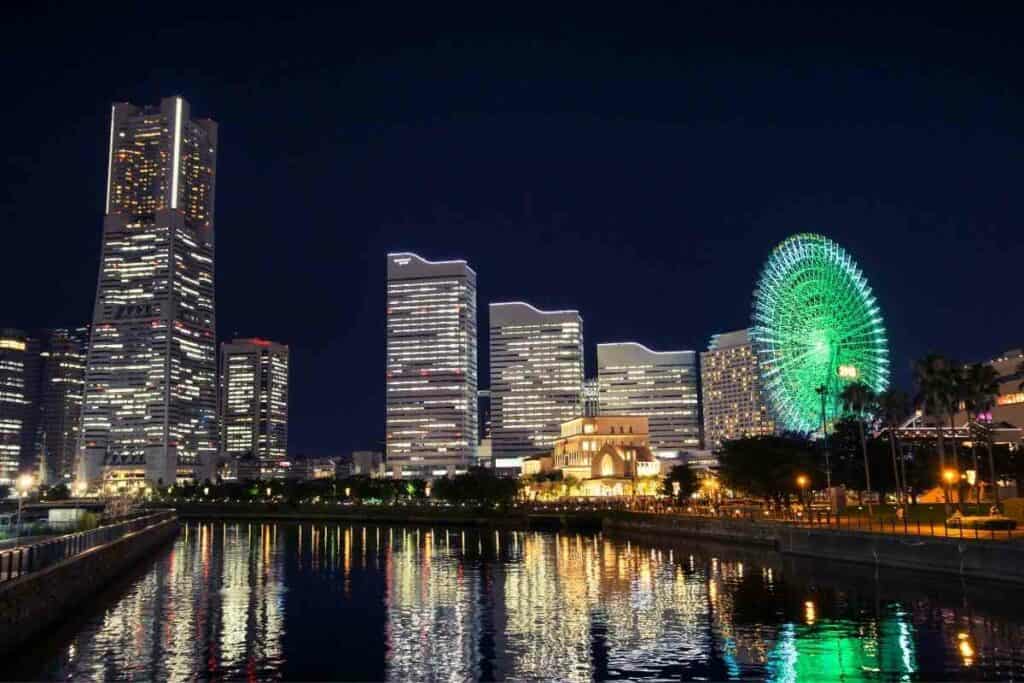
Due to its large size, many people assume it’s expensive to live in Yokohama. In reality, it’s one of the most affordable cities in Japan.
One-bedroom studio apartments in the CBD cost an average of $1,200 monthly.
If you move to the outskirts, you can get flats at a lower price. Other necessities like groceries, utilities, and entertainment are also pocket friendly.
Yokohama is the preferred location for many people who work in Tokyo but don’t want to live in the capital.
It takes 30 minutes to commute from Tokyo to Yokohama, the same as someone living in the capital’s suburbs.
You may also like 📖
- Best Hotels In Yokohama
However, Yokohama’s affordable lifestyle enables you to save more than those in Tokyo.
Besides affordability, Yokohama also has plenty of amenities and attraction sites:
- Chinatown – If you want to eat Chinese food or add some Chinaware to your crockery, you can visit the Chinatown in downtown Yokohama.
- For recreation -You can see the Hakkeijima Sea Paradise, Sankei-en garden, Shin-Yokohama Ramen Museum, or one of the city’s many stadiums, including the one that hosted the 2002 World Cup final.
- Mount Fuji – Nature lovers will adore the city’s proximity to Hakone, where you can take hiking trails up Mount Fuji and enjoy panoramic views of Lake Ashinoko.
Read Next 📖
- 5 Best Hotels with a View of Mount Fuji
The reasons behind Yokohama’s popularity among immigrants are apparent.
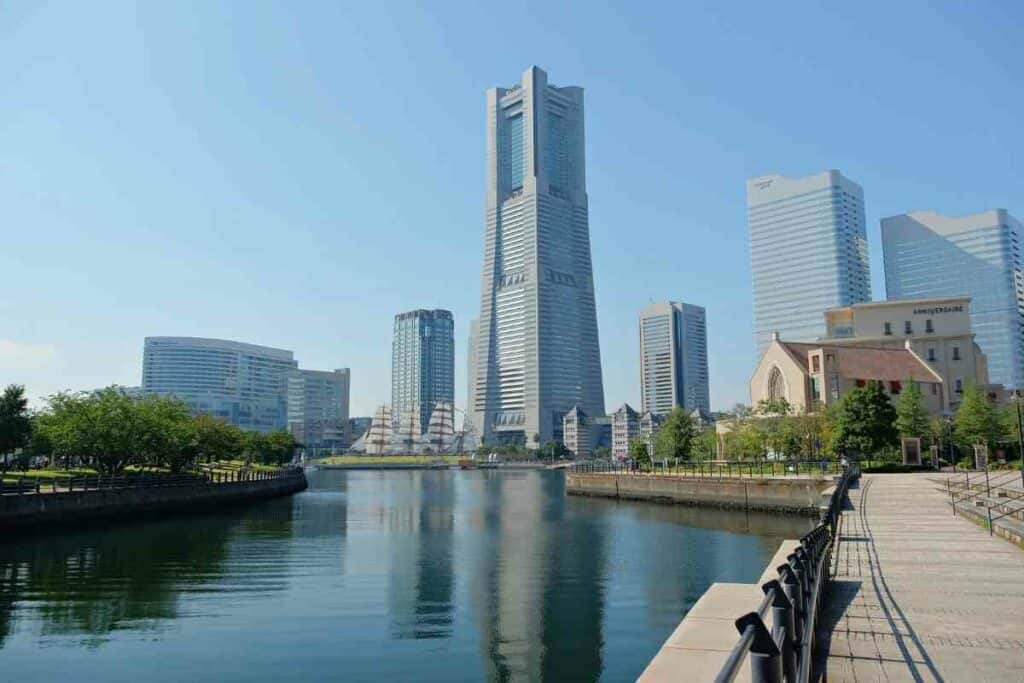
It’s affordable and has every facility you need, such as nature parks, stadiums, museums, industries, ultramodern malls, and abundant job opportunities.
On the Downside – The city has many smokers who cause discomfort to non-smokers. It’s also dangerous to roam alone at the west exit of the Yokohama station at night.
Sapporo is the largest city on Hokkaido Island, the northernmost isle in Japan.
Residents lead a different lifestyle to those in other Japanese cities, especially the densely populated Honshu Island.
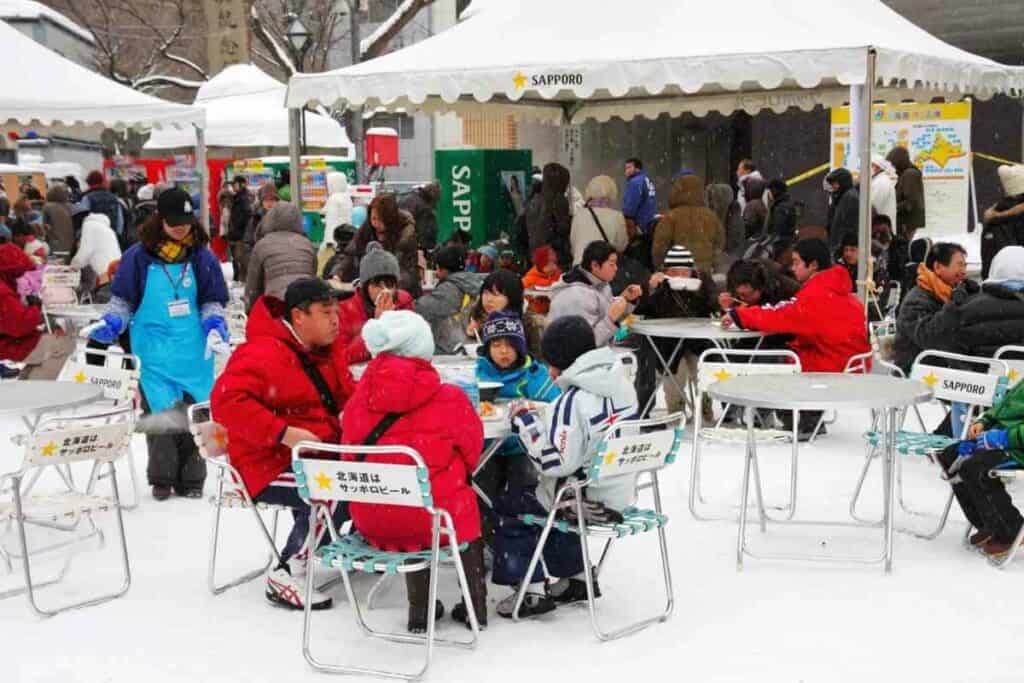
Sapporo is the cultural, economic, and political capital of Hokkaido Island . The town, a small village in the 19 th century, is now Japan’s fifth largest city.
Also Read 📖
- Does it snow in Japan?
In winter, sub-zero temperatures are typical in Sapporo. It gets so cold that snow covers buildings, roadways, and parks, painting the entire city white.
However, these conditions don’t spell doom for activities in Sapporo.
- Cheap Things In Japan
- Best Hotels In Sapporo
Locals take advantage of the snowy conditions to showcase their exceptional skiing skills.
Even Better – The city also hosts the Sapporo Snow Festival , which attracts millions of tourists annually.
Sapporo has a rich sporting history, having hosted the football and rugby World Cup tournaments and the Winter Olympics.
Despite its significance, it isn’t expensive to live in Sapporo. You can rent a spacious apartment, get food, and pay utilities for $1,600 monthly.
The city’s colleges charge lower tuition and accommodation fees than Japanese higher learning institutions.
Students can get by with around $800 monthly, making it a suitable location for internal scholars.
Kamakura is a small city and one of the cheapest areas to live in Japan.
It was the political and religious capital of the medieval area.
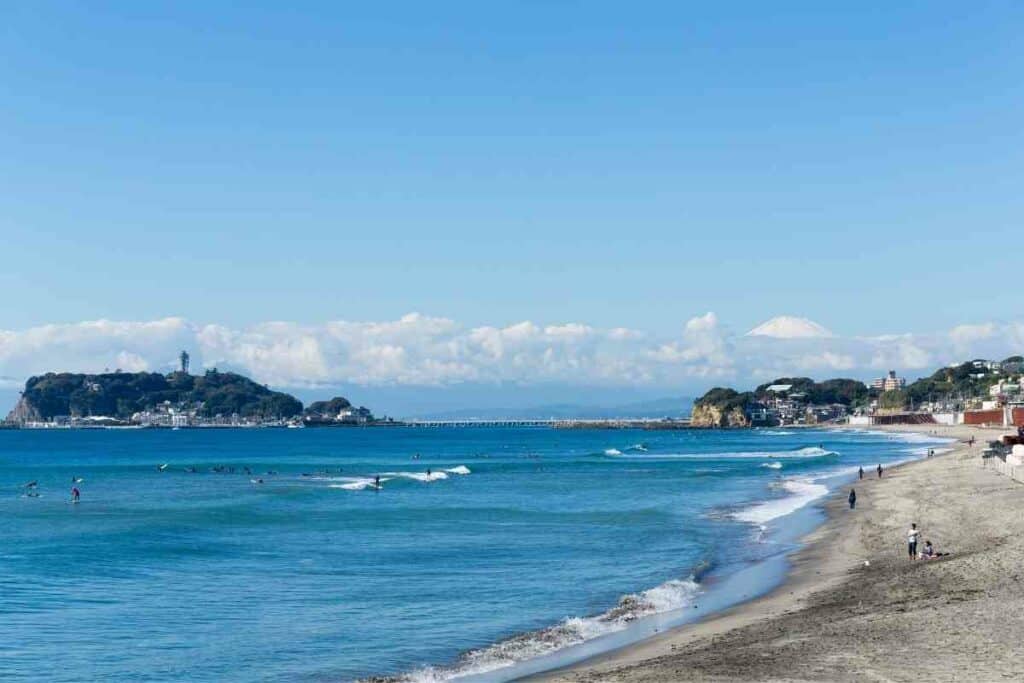
This explains the many Buddhist temples and Shinto shrines that attract history enthusiasts.
Housing prices in Kamakura range from $420 to $600 monthly for one-bedroom apartments – if you have a family, $1,300 is enough to get a spacious three-bedroom house.
Food is also cheap, with regular restaurants and roadside food stands selling meals for as low as $7.
Currently, Kamakura serves as a popular tourist destination. The city’s most iconic attraction is the 13-meters tall bronze statue, The Great Buddha.
Besides, you can also enjoy surfing at one of the city’s many beaches or enjoy breathtaking views of Mount Fuji.
Read next – 10 Best Surfing Destinations in Japan
Another reason to live in Kamakura is its proximity to Tokyo. If you board a train at the capital, you’ll reach Kamakura in 45 minutes.
Read next – 5 Best Hotels in Kamakura
As such, it’s a viable suburb for those looking for a reprieve from Tokyo’s expensive lifestyle.
However, the trains tend to get crowded during rush hours and weekends.
Keep in Mind – The worst thing about Kamakura is its weather – the city experiences heavy rainfall throughout the year, even in the ‘driest’ months.
Living in Kawasaki is similar to staying in Tokyo, but the former is gentler on your finances.
Like Tokyo, Kawasaki is home to many corporate institutions, guaranteeing many job opportunities. You’re likely familiar with Kawasaki motorbikes that originate in this city.
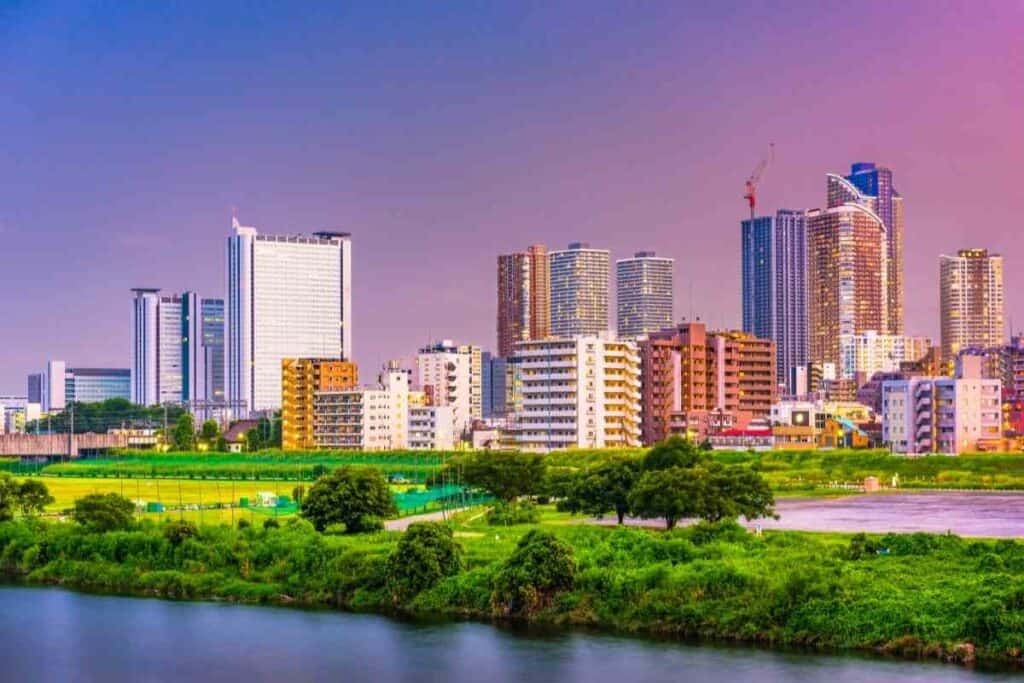
Kawasaki is a 40-minute train ride from the Tokyo metropolis. If you work in the capital, you can save substantial money by renting a house in Kawasaki, as the prices are up to 50% lower.
The estimated cost of living is $1,500 monthly per person.
Besides an affordable lifestyle, Kawasaki offers an escape from Tokyo’s dense and noisy population. As mentioned above, it has a strong job market, with many white and blue-collar jobs.
Additionally, Kawasaki has an extensive canal network connected to the nearby river.
You can use boats and rafts to navigate the city, enjoying the many shrines, museums, and futuristic architectural designs.
Read later – 5 Best Hotels in Kawasaki
Fukuoka is the largest city on Kyushu Island , famous for its busyness and liveliness.
Nevertheless, it’s comparatively smaller than other Japanese cities, making it affordable to many.
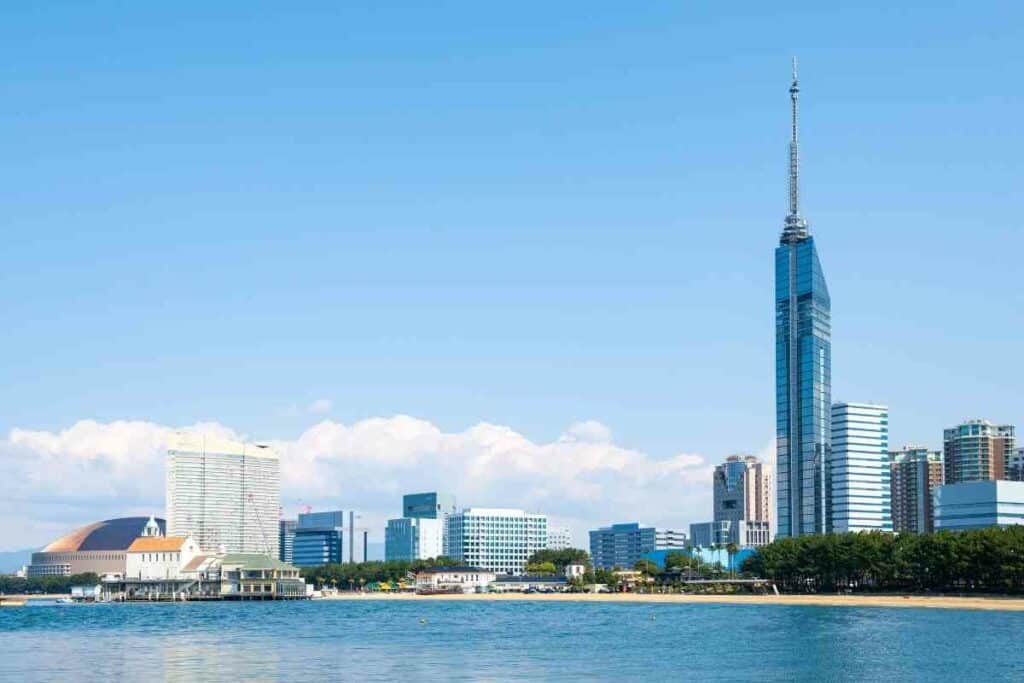
As one of the pioneers of Japanese culture, the city has numerous temples and tasty street foods. These bring life to the streets after sunset.
The cost of living in Fukuoka starts from $1,400 monthly per person. For a family of four, $3,100 is enough to cover rent, food, entertainment, and utilities.
Unlike most Japanese cities, Fukuoka’s atmosphere isn’t full of harmful gases from factories.
Several Japanese cherry blossoms line its streets, making it ideal for nature lovers.
You can also take a trip to the nearby Itoshima and relax under palm trees as you enjoy the famous sunset.
Read next – 5 Best Hotels in Fukuoka
Recently – Locals have established many startups in the city. This has prompted an influx of foreign investors in Fukuoka. So, if you desire to start a company, the town presents a good platform.
Besides entrepreneurship, you can try other jobs like teaching English, restaurant attendant, medicine, and IT practitioners.
On the downside, most locals can’t communicate in English. For this reason, you can find it difficult to relay information if you aren’t good at Japanese.
However, this is advantageous in the long run because it forces you to learn Japanese and expands your knowledge.
- 11 Successful Male Japanese Entrepreneurs
Most second cities have a bad reputation.
Surprisingly, Osaka doesn’t have a poor standing among locals and foreigners.
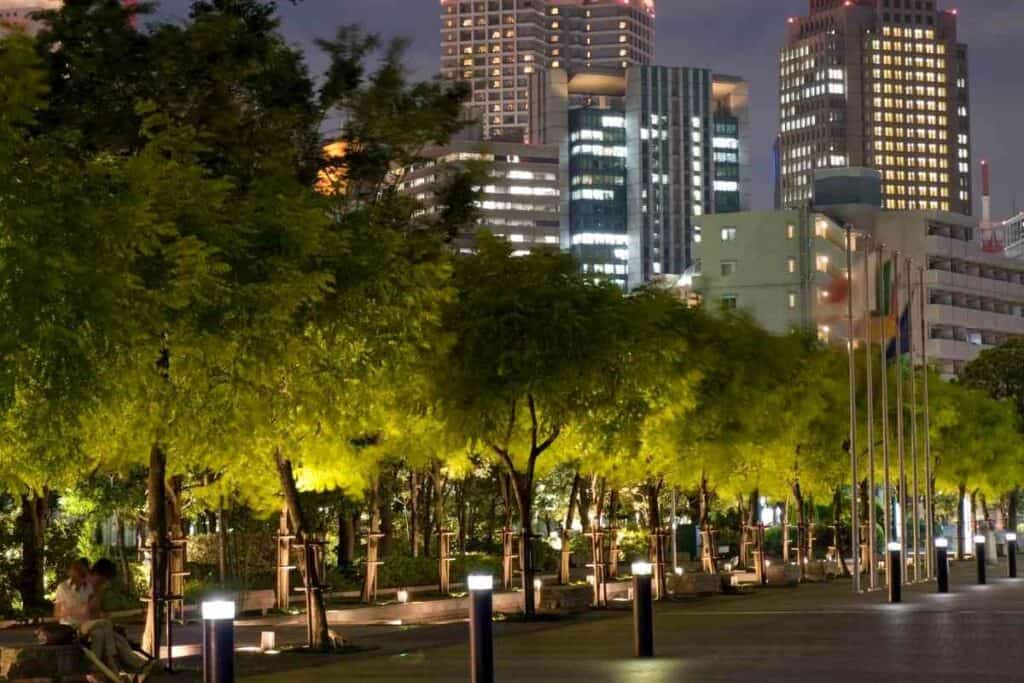
Instead, many regard it as a vibrant metropolis that offers most things you can find in the capital at affordable costs.
Osaka has 20 million people, making it one of the world’s most populated cities.
It’s a suitable location for expats looking for a 24-hour economy that guarantees many job opportunities and a relatively cheap lifestyle.
The port city is home to renowned multinational corporations like Panasonic and Sharp.
After a busy week at work, the neighboring suburbs of Amemura, Horie, and Namba offer the perfect weekend getaway for dining and drinking.
Don’t Worry! Although most parts of Osaka are crowded, you can find calm places to stay. Mino city is a perfect example of a tranquil environment. It’s a 30-minute drive from Osaka’s CBD and one hour from Kobe city.
The average cost of living in Osaka is $1,500, with reasonable housing costs, food, and utility prices.
The efficient transport network is also a huge attraction, yet Osaka is 15% cheaper than living in the capital.
Read next – The 2025 Japanese Work Permit
When you hear of Hiroshima, the first thought is the atomic bomb dropped by the Americans to mark the end of the Second World War.
There’s no denying that the bomb’s effects were devastating – but the city has since risen from its momentous fall.
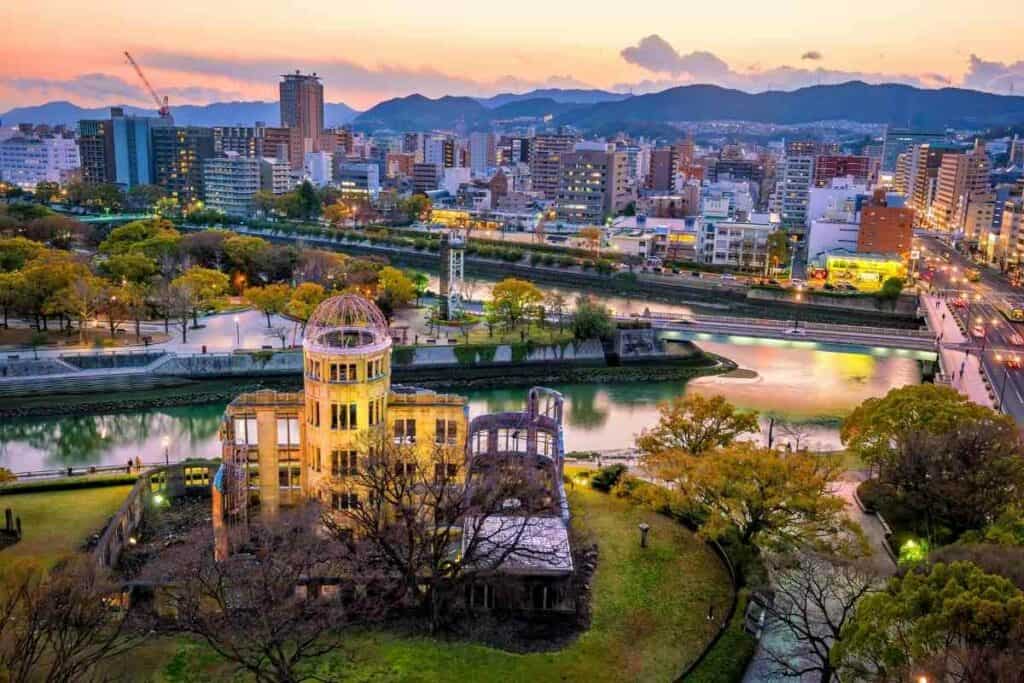
The city is beautiful, with modern amenities and welcoming people.
Hiroshima residents are determined to shun the bomb’s traumatic memories from their minds. Many tourists flock to the city, but it’s never crowded or chaotic.
The CBD is the most expensive area to live in Hiroshima. However, it’s still cheaper than the cost of living in other Japanese cities.
If you want to save more, you can find more affordable apartments on the city’s outskirts. For instance, the average rent for a one-bedroom apartment is $800.
Hiroshima is close to exciting attractions like the iconic Miyajima, easily accessible via trams or ferries.
Read next – 5 Best Hotels in Miyajima Island
The city has many baseball fans, mainly because of the impressive performances by the Hiroshima Carps. It’s one of the country’s most popular teams.
Lastly – Hiroshima has many inexpensive restaurants and mouth-watering street foods like the city’s iconic Okonomiyaki (fried noodles wrapped in a pancake). Hondori Street is famous for its numerous shopping malls, bars, and restaurants.
Nagoya is a medium-sized metropolis with three million residents.
Some refer to it as ‘Little Tokyo’ because it provides a similar feel, with its neon lights, huge shopping malls, tall buildings, and trendy karaoke bars.
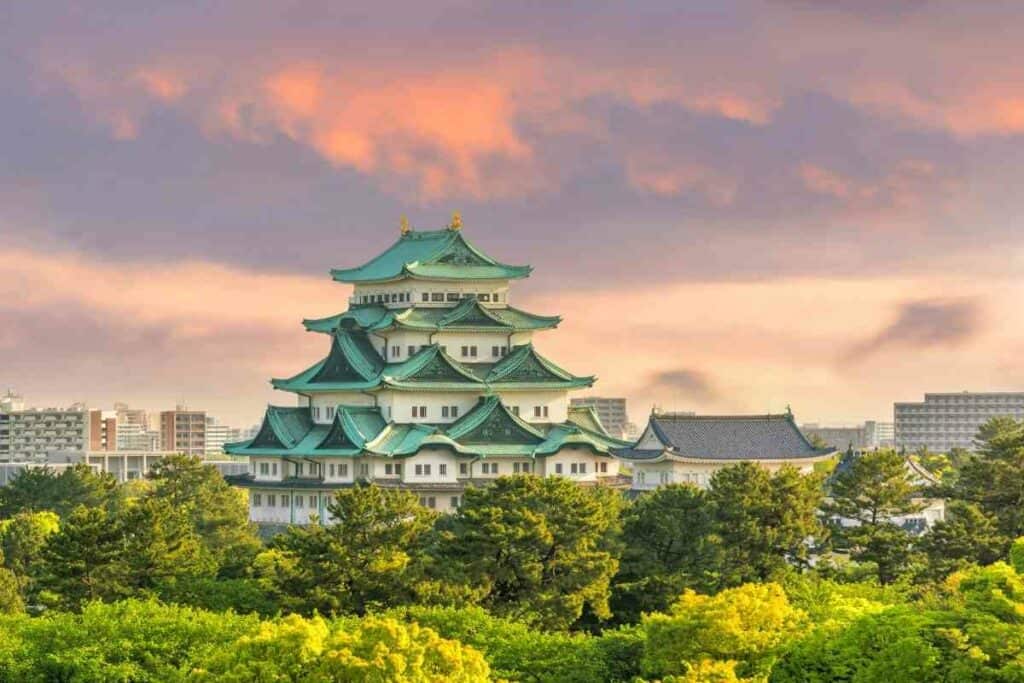
Unlike Tokyo, the city has several cultural heritage sites, like the Nagoya Castle, with futuristic architectural designs.
The most significant benefit of living in Nagoya is that it’s easy to navigate for newcomers because it isn’t as big as other Japanese cities.
You can become familiar with the city quickly after moving to Nagoya. It also has an efficient and affordable transport network, with stops across the city.
Tsushima Island
Tsushima Island offers a break from the modern architectural designs that dominate most Japanese cities.
To experience nature’s diversity, you might want to live on this archipelago with over 100 islets.
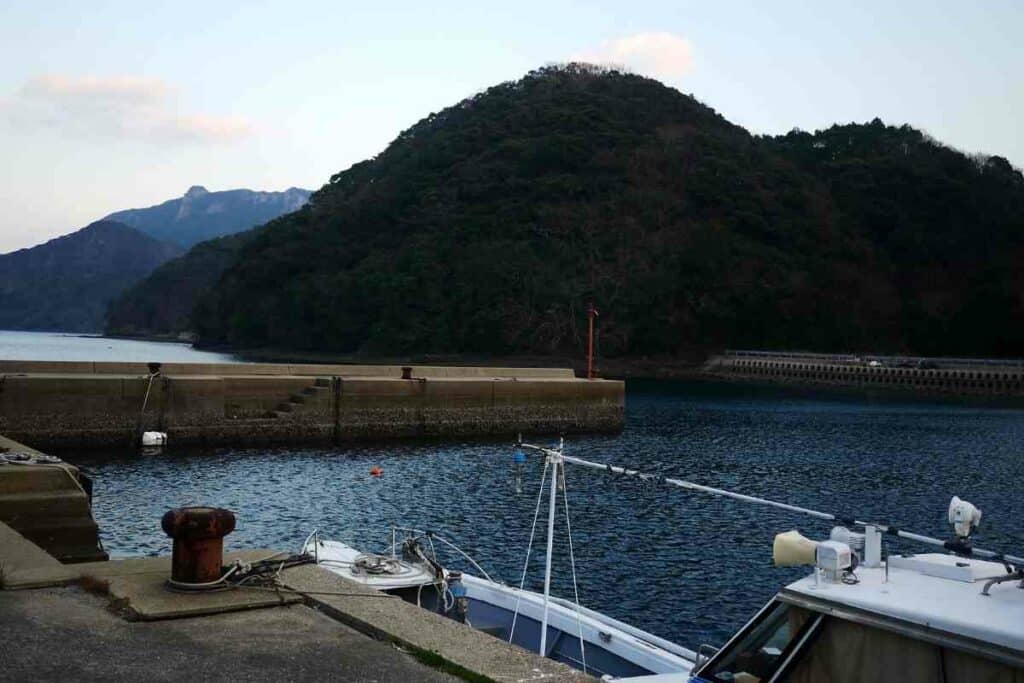
These comprise many natural reserves with beautiful beaches, tropical vegetation, and breathtaking mountain peaks.
There are also typical big-city sights like tall buildings, although they’re fewer than most metropolises.
Tsushima Island is the only city on the archipelago. Its life centers around the sea, with a unique blend of Japanese and Korean cultures.
Despite its attractive offerings, the cost of living in Tsushima is incredibly low.
One-bedroom apartments go for a paltry $400 monthly. $1,000 is enough to get one person by in a month.
Wrapping Up
There’s more to Japan than Tokyo. The country has many cities that offer a cheaper lifestyle than the capital without compromising amenities and job opportunities.
The smaller cities also provide a break from the bustling and hectic lives in the big towns.
House rent is the most significant contributing factor to the cost of living in Japan. However, prices vary in different cities.
You can get an apartment costing a few hundred dollars monthly, but it’ll only have basic amenities.
Most rental houses in Japan are as big as hotel rooms. Nevertheless, they cost less than American cities.
The cost of living in Japan depends on your spending habits. Besides the estate you live on, food and transport also affect your monthly budget.
For instance, regular commuting using bullet trains is expensive. Similarly, eating in restaurants is costlier than preparing meals at home.
Although it isn’t the cheapest, living in Japan is worth trying out. If you take the time to research, you can find an affordable place to stay.

About the author
I love traveling and writing about my exploits as a travel blogger and freelance writer. You’ll find me curled up in my reading corner, enjoying a cup of tea and a romance novel when not busy.
Latest posts

Japanese Wedding Traditions (Venue, Dress & Food)
This post will discuss wedding customs you can expect to find in a traditional Japanese wedding today. These include the traditional Japanese wedding dress code, venue, gift, and food.

Bubble Tea vs Boba Compared: What’s the Difference?
Bubble Tea and Boba are two extremely refreshing drinks with the added satisfaction of jelly balls to add a whole new sensation to the drink.

Rinko Kikuchi Net Worth:Sci-fi blockbuster Japanese Star
Acclaimed actress Rinko Kikuchi and her impressive net worth. From her breakthrough role in ‘Babel’ to starring in blockbuster hits, learn about the financial success that accompanies her illustrious career.
- Tokyo Cheapo (繁體中文)

Yozakura: 8 Best Nighttime Cherry Blossom Illuminations in Tokyo
Get the top tokyo cheapo hacks in your inbox..

Tokyo Events This Week: Pink Petals and a Fertility Festival
Tokyo events for Monday, April 1 to Sunday, April 7, 2024.

New Video: Tokyo’s Best Airport — Flying into Narita vs. Haneda
Which one should you use when flying to Tokyo?

Updated Forecast: 2024 Tokyo Cherry Blossom Dates
They've been teasing us — but looks like they're about to bloom, at last.

April 2024: 5 Events Not To Miss in Tokyo
A chance to see the infamous "penis festival", puppies, processions, and more!

New Video: The Best eSIMs for Visiting Japan
We cover the main providers in Japan, including pricing, data speeds, and the convenience of installation.

Mega Guide: 24 Best Places to See Cherry Blossoms in Tokyo
Choose from parks, traditional gardens, mountains and more.

The Hokuriku Arch Pass: Taking the Slow Route Between Tokyo and Osaka
Meander along Japan's "golden route" — exploring Nagano, Kanazawa and more.

Spring Escapes: Top 7 Day Trips from Tokyo
Must-see cherry blossom, moss phlox, and wisteria locations — all easily accessible from Tokyo.

Ashi Angels: Hakone for Evangelion Fans
Explore the real Tokyo-3.

Top 10 Tokyo Cherry Blossom Festivals in 2024
Where to go for street food, music — and lots of sakura.
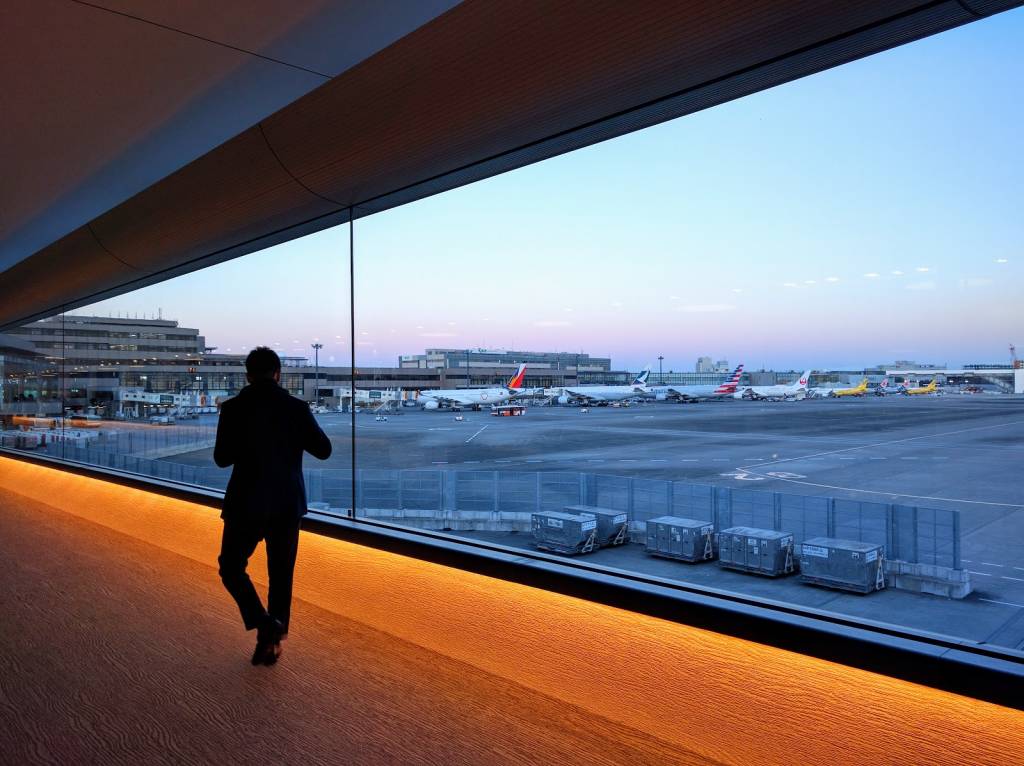
Finding the Best Transport From Narita Airport to Tokyo
How to get from the plane to your accommodation.

New Video: Top Japanese Phrases You Need Before Traveling to Japan

The Samurai Restaurant: Discount Tickets and What To Expect
Get ready for an exuberant new show from the creators of the old Robot Restaurant.

Beginner’s Guide To Skiing in Hakuba
Olympic slopes just a few hours from Tokyo—some of them open till May!

5 Stunning Spring Bus Tours From Tokyo
Take a ride to experience the best of the season.

Top 25 Easy Day Trips From Tokyo
Add a few of these to the wander list.

Tokyo to Osaka: Fast and Creative Ways of Getting There
Full guide to taking the bullet train, buses, and low-cost flights.
TC Partners
The best offers from our partners

Mobal Japan Unlimited – Perfect SIM for Residents and Visitors
A no-contract unlimited data and voice SIM for all. No residency card or visa required! Mobal’s Japan Unlimited SIM is a no contract, no termination fee, voice & data SIM with free worldwide delivery.
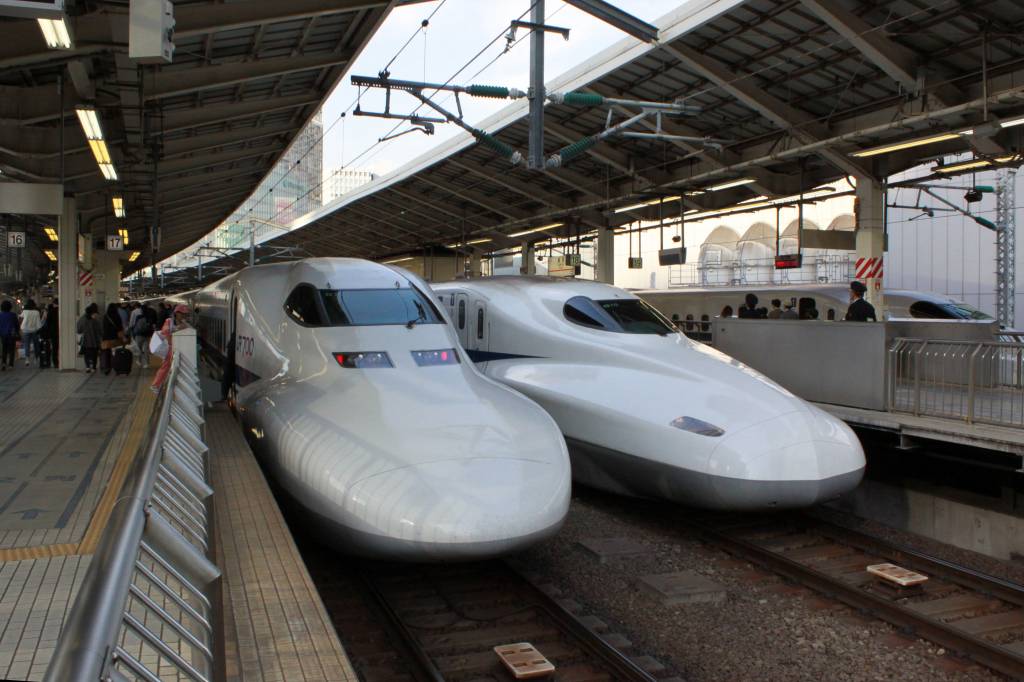
The JR Rail Pass
Unlimited travel on any JR train—including the high-speed Shinkansen—for a period of 7 days. Price includes free shipping to your home address.
- Eating & Drinking
- Itineraries
- Getting Around
- Special Offers
- Attractions
- Ask a question
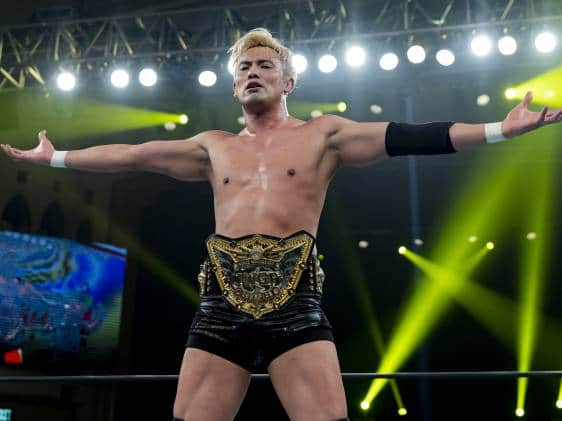
Sakura Genesis 2024
See this annual wrestling event that takes place at Ryōgoku Kokugikan (the sumo stadium) each year.

Yoyogi Park Wanwan Carnival
The Wanwan Carnival is a festival of everything doggy and dog related.

Nihonbashi Sakura Festival 2024
Head into central Tokyo's Nihonbashi district for an electric (and eclectic) cherry blossom experience.

Hanazono Shrine Antique Market
Blue skies are the perfect time to visit this small antique fair. Enjoy some casual browsing without the pressure and noise of the larger markets.
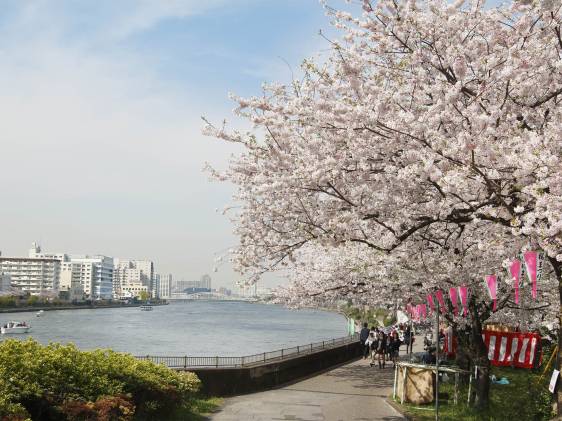
Bokutei Sumida Park Cherry Blossom Festival
See sakura in the shadow of Tokyo Skytree at Sumida Park. With festival stalls, music, and a promenade of blossoms a kilometer long, you could forget you're still in the city.

AC Hotel by Marriott Tokyo Ginza
AC Hotel offers a comfortable hideaway in and outside of your room with plenty of areas to work or relax in -- including a lounge and roof terrace.

Sequence Miyashita Park
Sequence hotels are a cheapo favorite. They are no-frills stylish and found in excellent locations --- a Japanese business hotel but for hipsters if you will. Apart from a frustrating self check-in experience (if your name isn't Japanese just …

Mimaru Tokyo Akasaka
Mimaru is a spacious apartment hotel in Akasaka that is popular with families. What’s the hotel like? The hotel is modern with a minimalist Japanese aesthetic. Despite being right on the busy Akasaka Dōri thoroughfare, the main entrance is to …

Hakone Gora Park
Opened in 1914, Gora Park is purportedly Japan’s first French-style garden. Gora is the terminus station for the Hakone Tozan railway line. Admission is free for Hakone Free Pass holders and those with a Hakone Tozan Train & Cable Car 1-Day Pass.

teamLab Acorn Forest
The teamLab Acorn Forest is a small, outdoor exhibit in Higashi Tokorozawa Park in Saitama. It's a permanent installation of large silver "acorns", which resonate sounds through the woods, and light up in magical color at night. teamLab Acorn …

Immersive Fort Tokyo
Let your imagination run wild.

When to See Cherry Blossoms in Japan

Asakusa: A Guide to Tokyo's Traditional Center

Narita Airport to Tokyo

A Guide to ALL Pokemon Centers in Tokyo, Japan

A Beginner's Guide to Shibuya - Scramble Crossing, Shopping & Great Views!

Which is the Best View in Tokyo: Top Observation Decks

Top Japanese Phrases You Need Before Traveling to Japan

January 5th

December 22nd

November 9th

Close without accepting

14 Best Cities in Japan To Visit This Year
Written By: ThePlanetD Team
Updated On: February 19, 2024
Everyone should explore Japan at least once in their lifetime. Japan has thousands of hidden gems and is a year-round destination. You can visit its ski resorts in winter or the beautiful coastline in summer. And, whatever the season, Japan’s cities are always ready to welcome you with fascinating attractions, delicious street food, and bucket loads of culture.
The real question is, which of the cities in Japan should you visit? In an ideal world, all of them. However, this guide will narrow it down to the absolute best cities.
Table of Contents
Explore Japan: The Top Cities in Japan
Japan has some incredible cities. From Tokyo to Sapporo, these are the best cities in Japan for your next adventure. Let’s dive straight in.
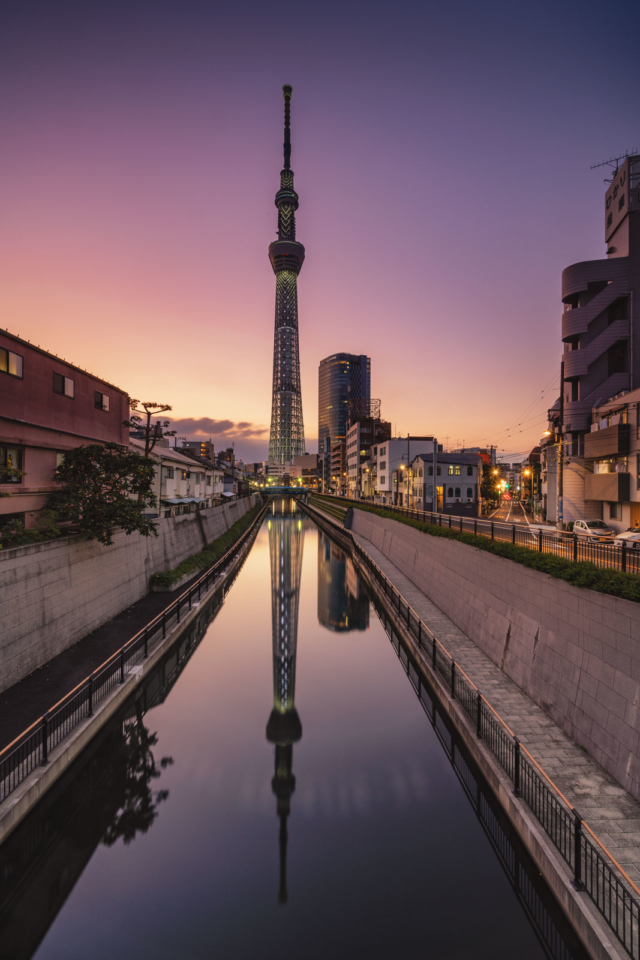
When you think of cities in Japan, it’s safe to say that Tokyo will be in your top three. As the capital, Tokyo is one of the major Japanese cities and attracts millions of tourists a year. It is also the largest city in Japan, with an estimated population of around 14 million people .
Think busy streets, fast-paced entertainment, and flashing neon lights – Tokyo is hectic but exciting. Tokyo is where to visit if you want to be right in the thick of all the action, with plenty of museums to tour, shopping to bag, and fun to be had. The sheer size of the city is exciting in itself.
So, where do you begin? What are the best things to do in Tokyo ? Well, after visiting the city a few times we suggest starting with Tokyo Tower. Tokyo Tower may look familiar, and it should be. The tower was heavily inspired by the Eiffel Tower. In fact, the only difference is that Tokyo Tower is 333 meters tall and red and white.
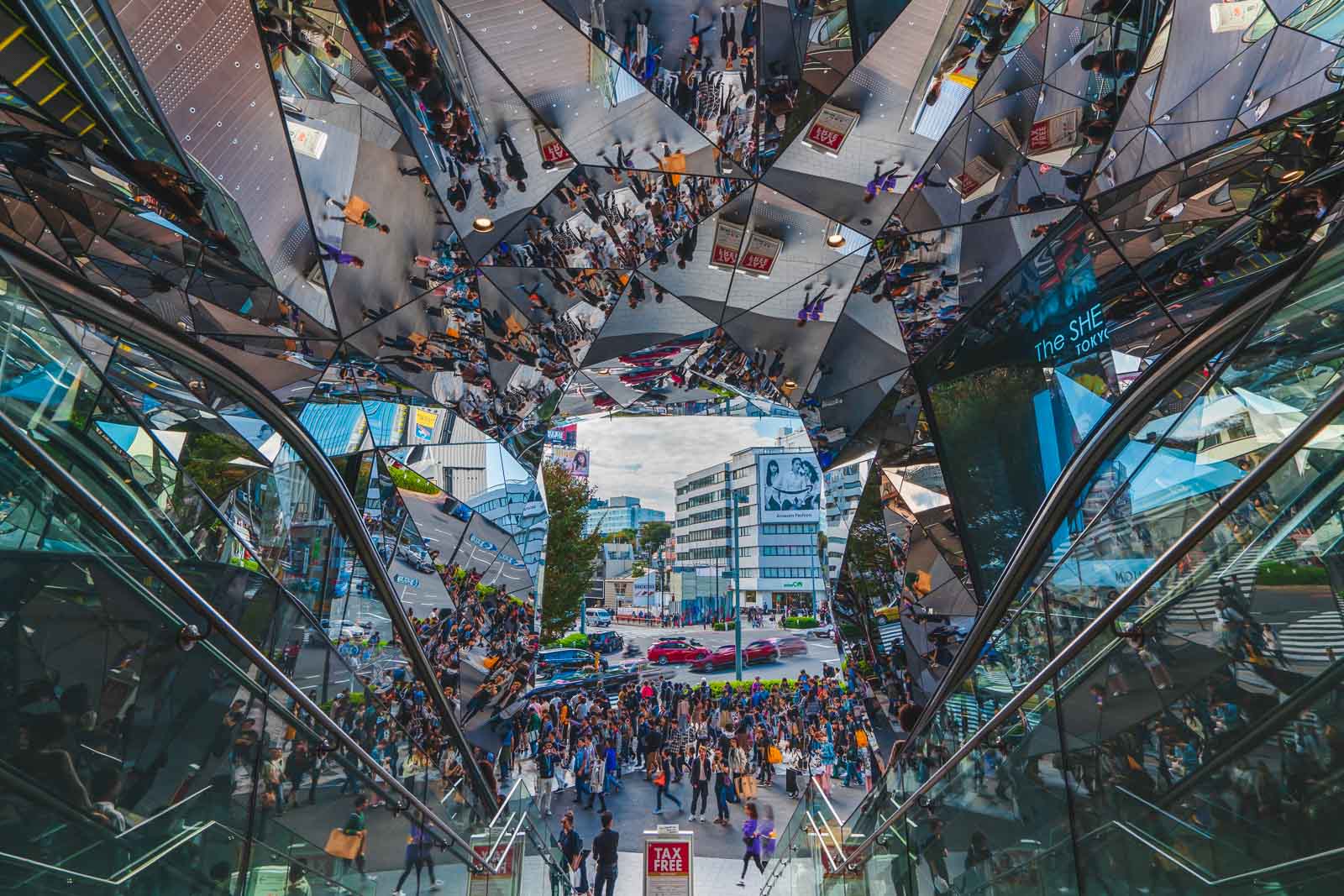
Heading to the top of the tower, you can learn about Tokyo’s architectural history en route, finishing with a spectacular view of the beautiful city below. Nearby, there’s also Tokyo Skytree which stands at a dizzying 634 meters and is the tallest tower in the world – so be prepared to spend at least a few hours amongst the clouds.
To appreciate Tokyo’s atmosphere on the ground, head to Golden Gai for a downtown vibe or Shibuya Crossing for a CBD experience. Allow time to visit museums like the Mori Art Museum, Japan Olympic Museum, and NHL Museum of Broadcasting.
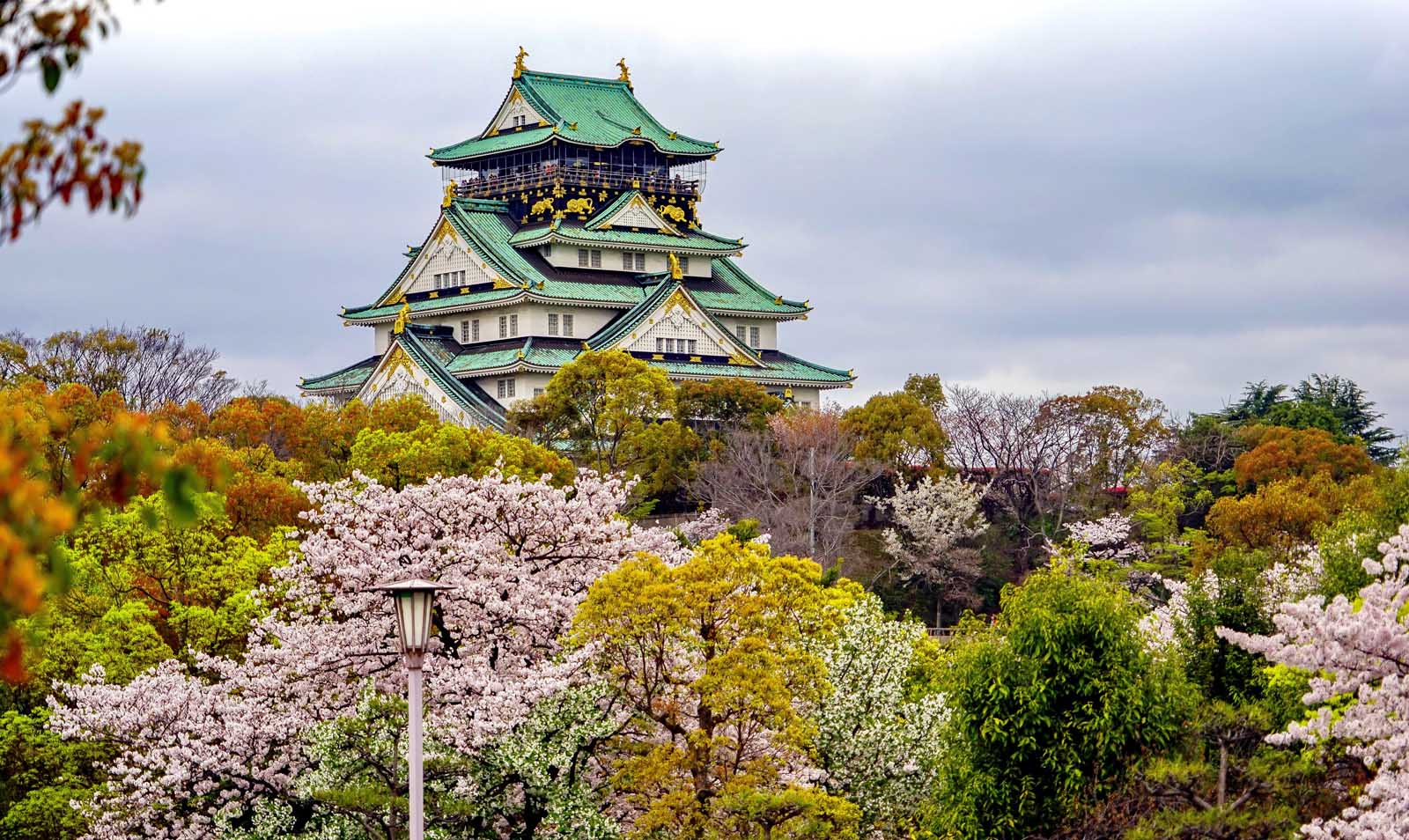
Osaka is another one of Japan’s large cities. Osaka has a strong character, and the port city has a commercial soul with lots going on at all hours of day and night. There’s always street food to taste, a bar to hop to, and attractions to visit. Osaka is a great place to visit if you love a mixture of partying, relaxing, and sightseeing. The city has lots of personality and a balance of everything – like a compromise with no sacrifice.
To appreciate the history of Osaka, a trip to Osaka Castle should be on your itinerary. The 16th-century castle is surrounded by cherry trees and a moat, and Osaka Castle is one of the prettiest places to visit in the city. While, if you want a day of light-hearted fun, there’s Universal Studios Japan to explore. The theme park has Hollywood-themed rides, and it’s conveniently located just outside the center of Osaka.
Finally, Osaka is the famous home of one of Japan’s oldest Shinto shrines. Sumiyoshi Taisha is a popular Shinto shrine to visit – on tourism or religious grounds. We recommend visiting to fully experience Japan’s beautiful religious culture.
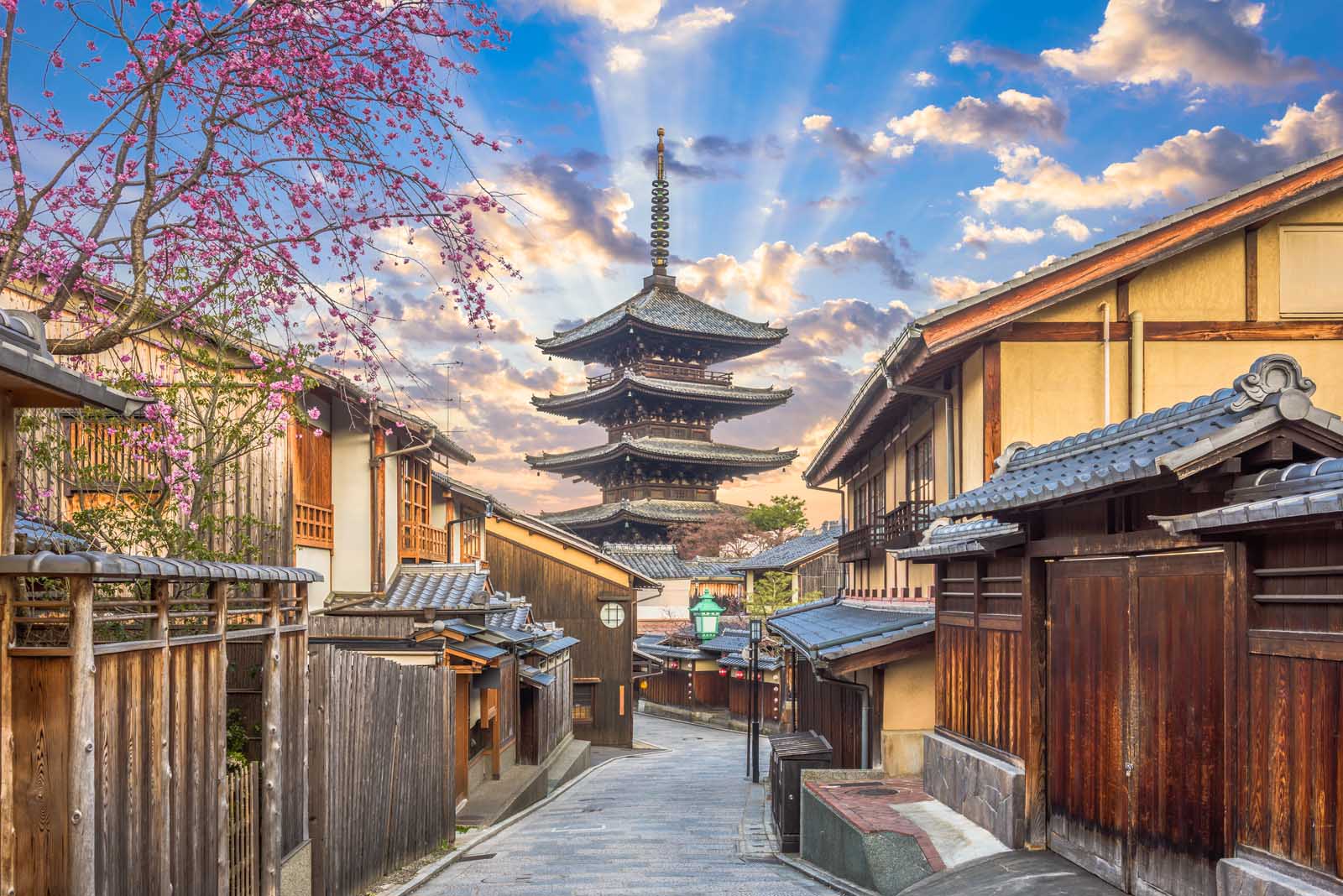
Tokyo might be the capital today, but Kyoto was once the country’s capital. In the center of the Kansai region, Kyoto is one of Japan’s most traditional cities. In Kyoto, you’ll find classic dark wood houses and plenty of Buddhist temples and Shinto shrines. If you are chasing culture and tradition, Kyoto is a great place to explore in Japan.
To experience the traditional streets lined by wooden houses, head to Gion. You can wander in the early morning for the quietest streets or at night to see the cobbled roads lit by paper lanterns. Visiting the many temples of Kyoto is also a must-do on your trip, especially the Golden Pavilion. You can admire the Golden Pavilion from across its pond, being wowed by the golden tint that gives it its name and popularity.
Looking for picturesque scenes? Head to the bamboo forest of Arashiyama or the red columned walkways of the Fushimi Inari-Taisha Shrine. Kyoto is full of stunning scenery and eye-opening cultural attractions. You can read more in our guides on the best places and things to do in Kyoto .
4. Hiroshima
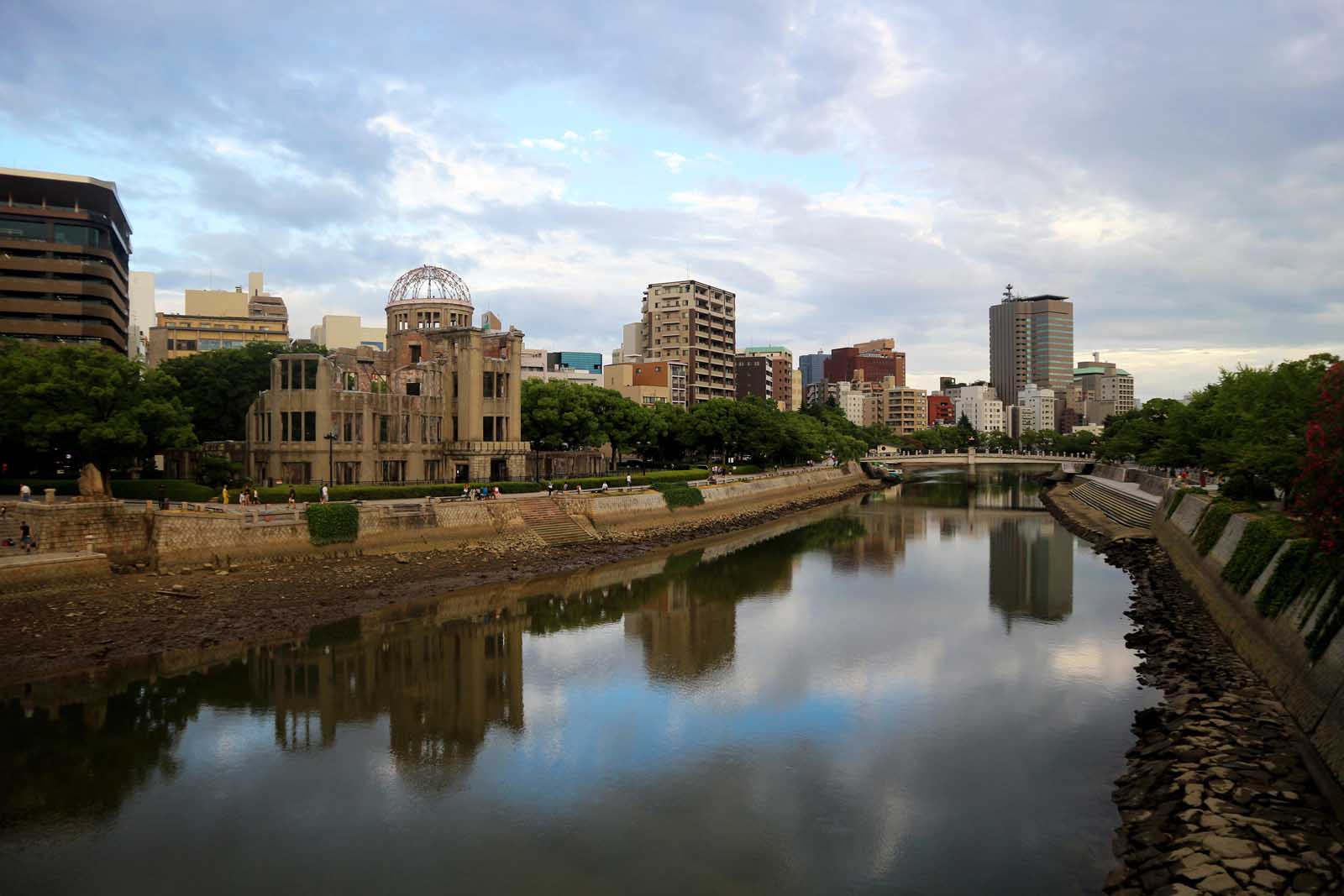
Hiroshima is a name not many forget. Sadly, the reason behind Hiroshima being one of the most famous cities in Japan is the atomic bombing that occurred in 1945. The US dropped an atomic bomb on the large city, causing over 100,000 casualties. Visitors to the city can now pay their respects to the victims and destruction at many memorable attractions, including the Peace Park.
There is much to appreciate about Hiroshima in its own right, though. Food lovers should sample the Japanese pancake, nicknamed Hiroshima-style okonomiyaki. There’s also Hiroshima Castle to tour and Shukkei-en scenic garden to stroll. Hiroshima’s culture and history have not been tainted by the tragic atomic bomb, and you’ll love the city’s variety of attractions.
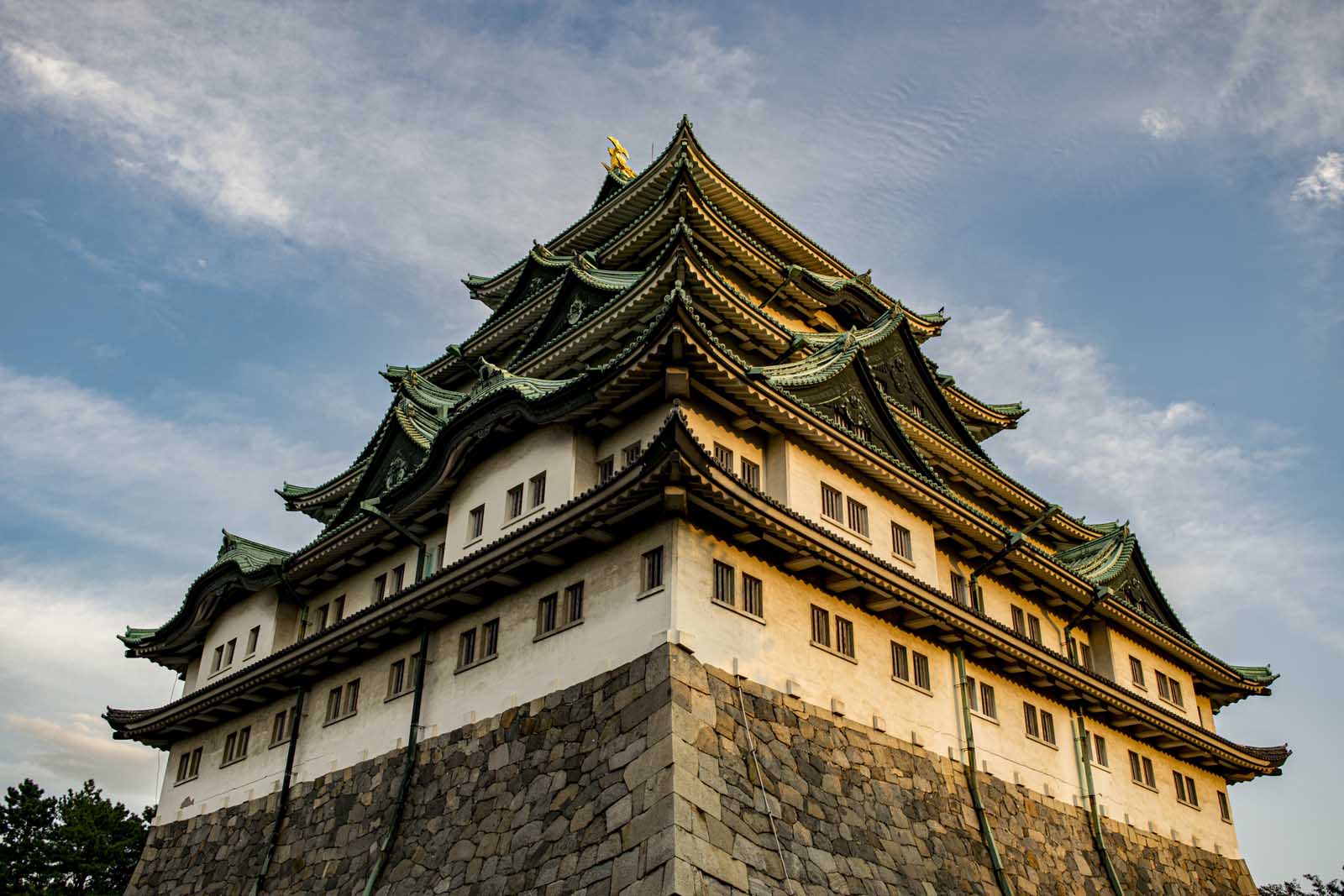
Nagoya is known for manufacturing and shipping and is the capital of the Aichi Prefecture. Have you heard of Honda? Toyota? Mitsubishi? All of these big automotive brands were developed in Nagoya. Nagoya has an innovative, industrial atmosphere, ideal for those wanting to experience the business side of Japan.
Visitors should tour the Toyota Exhibition Hall to get a better idea of automotive production in Japan. Nagoya Castle is great for a historical introduction to Nagoya. There are also one-off events in Nagoya like the Nagoya Sumo Tournament in July, the Nagoya Matsuri festival in October, and the World Cosplay Summit in July and August.
Nagoya has lots going on, so don’t forget to check the city’s schedule. And, in your downtime, make sure to try some miso katsu – miso katsu is a regional specialty.
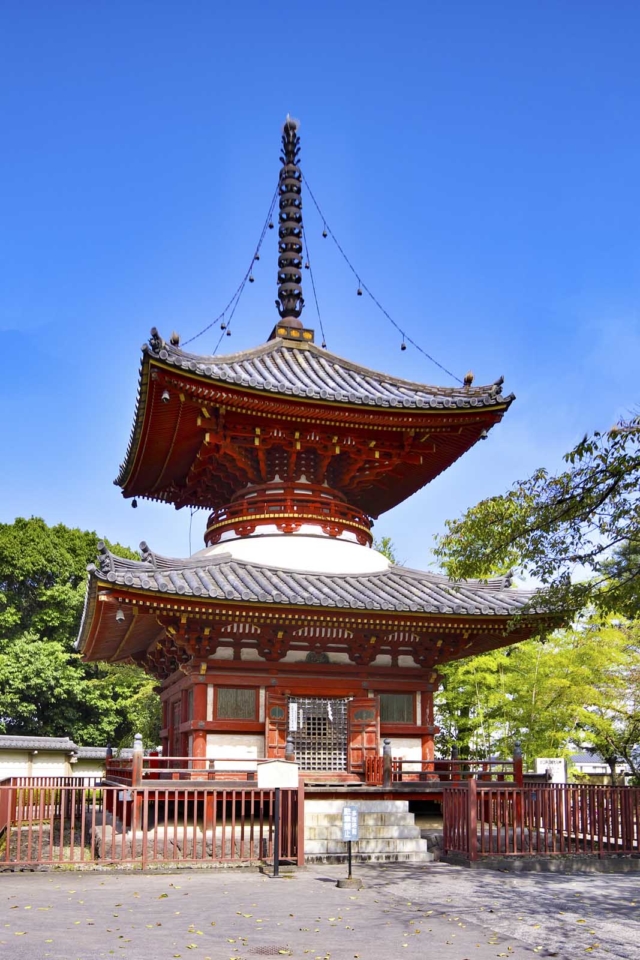
Looking to visit the real side of Japan? Saitama is a primarily residential city, perfect for getting a quieter experience of Japan. One of the best ways to experience a country is by escaping its main tourist areas. If you prefer this style of travel, Saitama is the place for you. Many residents use Saitama as a commuter town, traveling to Tokyo for work during the week.
So, what’s there to see in Saitama? Hitsujiiyama Park is a gorgeous place to visit and is famed for its carpet-like growth of pink moss. For those who like tasting sessions, you can also take a sake tour around the city – sampling the traditional Japanese alcohol. Saitama is a beautiful place to visit, not too far away from the other major cities but far enough away to escape the constant buzz.
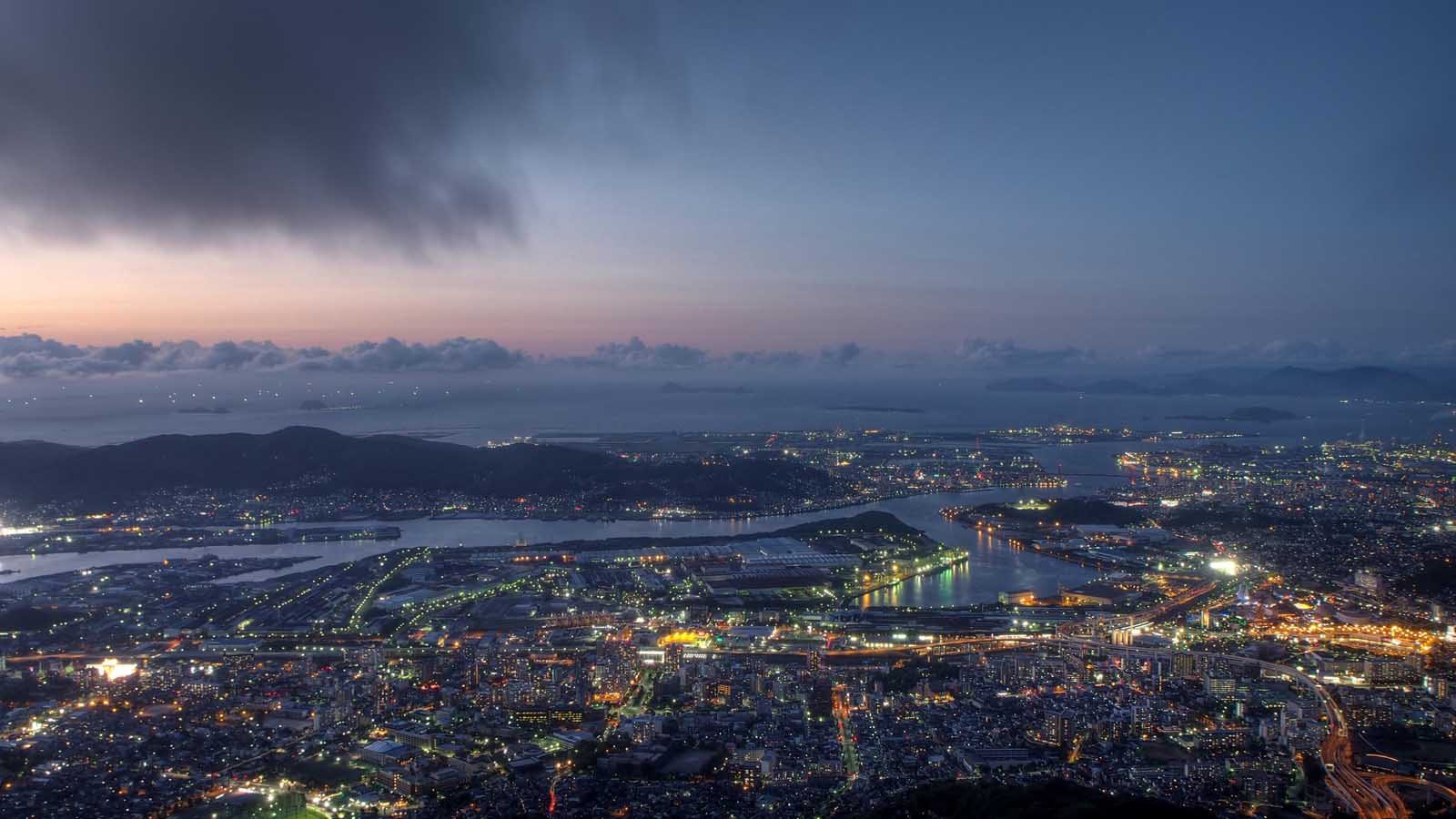
Another of the major cities in Japan is Fukuoka. Fukuoka is famous for its beautiful islands and sits on the coastline, surrounded by gorgeous beaches perfect for a summer getaway. The port city is located in Fukuoka Prefecture. The prefecture capital is popular among young professionals, students, and businesses.
The city’s main attractions are Fukuoka Castle, Kyushu National Museum, and Dazaifu Tenman-gu, a shrine to the god of education. Fukuoka is a definite metropolis. If you love an exciting city atmosphere full of action, bold cuisine, and entertainment, Fukuoka is perfect. It lacks the history of Kyoto and the popularity of Tokyo. Still, if you want a fun ‘second city’, you’ll have a fantastic time.
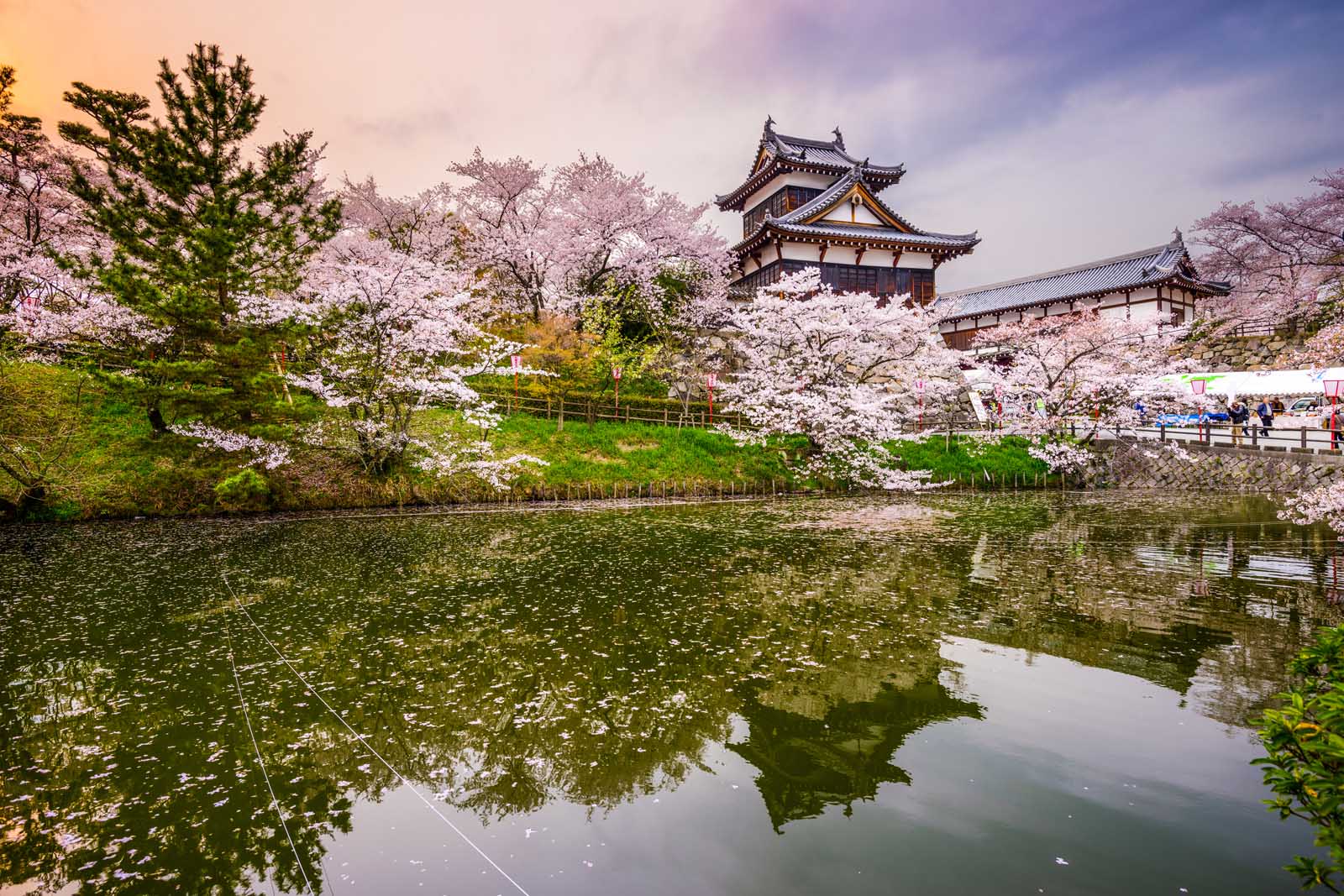
Nara is most famous for its deer population. If you’ve seen pictures of Nara online, chances are you’ve seen the idyllic temple scenes. The temples are surrounded by green space and Bambi-look-a-likes – cute, we know. Like Kyoto, Nara was also once a capital city. However, now, Nara is better known for its serene atmosphere and regal history.
The top things to do in Nara are to visit Nara Deer Park, Todai-Ji Temple, and Tamukeyama Hachimangu Shrine. You could easily spend a whole day temple-hopping though, and Nara is full of peaceful places for visitors to immerse themselves in Japan’s beautiful culture.
Nara is also easy to combine with visiting other cities in Japan. Traveling from Kyoto to Nara is just a short train ride, taking around 45 minutes one way.
9. Nagasaki
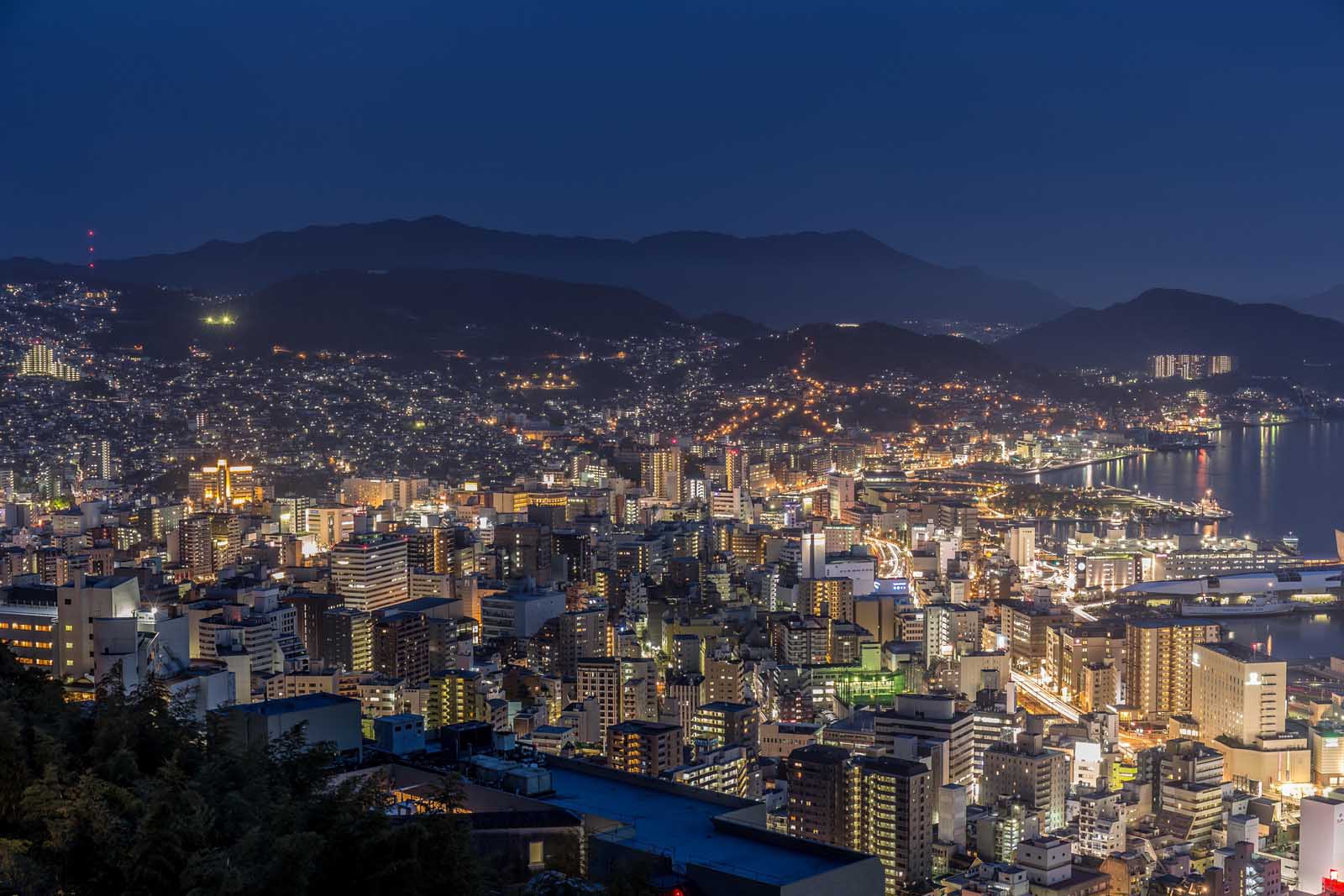
Like Hiroshima, Nagasaki was victim to an atomic bomb in 1945. The devastation was heartbreaking, and visitors can pay their respects today at attractions like the Peace Park. Nagasaki has many other aspects that make it an educational destination though. Nagasaki is one of the largest port cities in Japan and has a long history of trading with Europe.
The result is a fusion of European and Japanese culture and influence. You’ll find Christian sites like Oura Cathedral amongst the collection of stunning shrines and temples. To immerse yourself in the history of Japan’s international relations, you really can’t find a better place.
Then, when you’re ready, you can visit the Atomic Hypocenter Park and Peace Park to discover the darker side of Nagasaki’s history. The city has lots for you to learn.
10. Sapporo
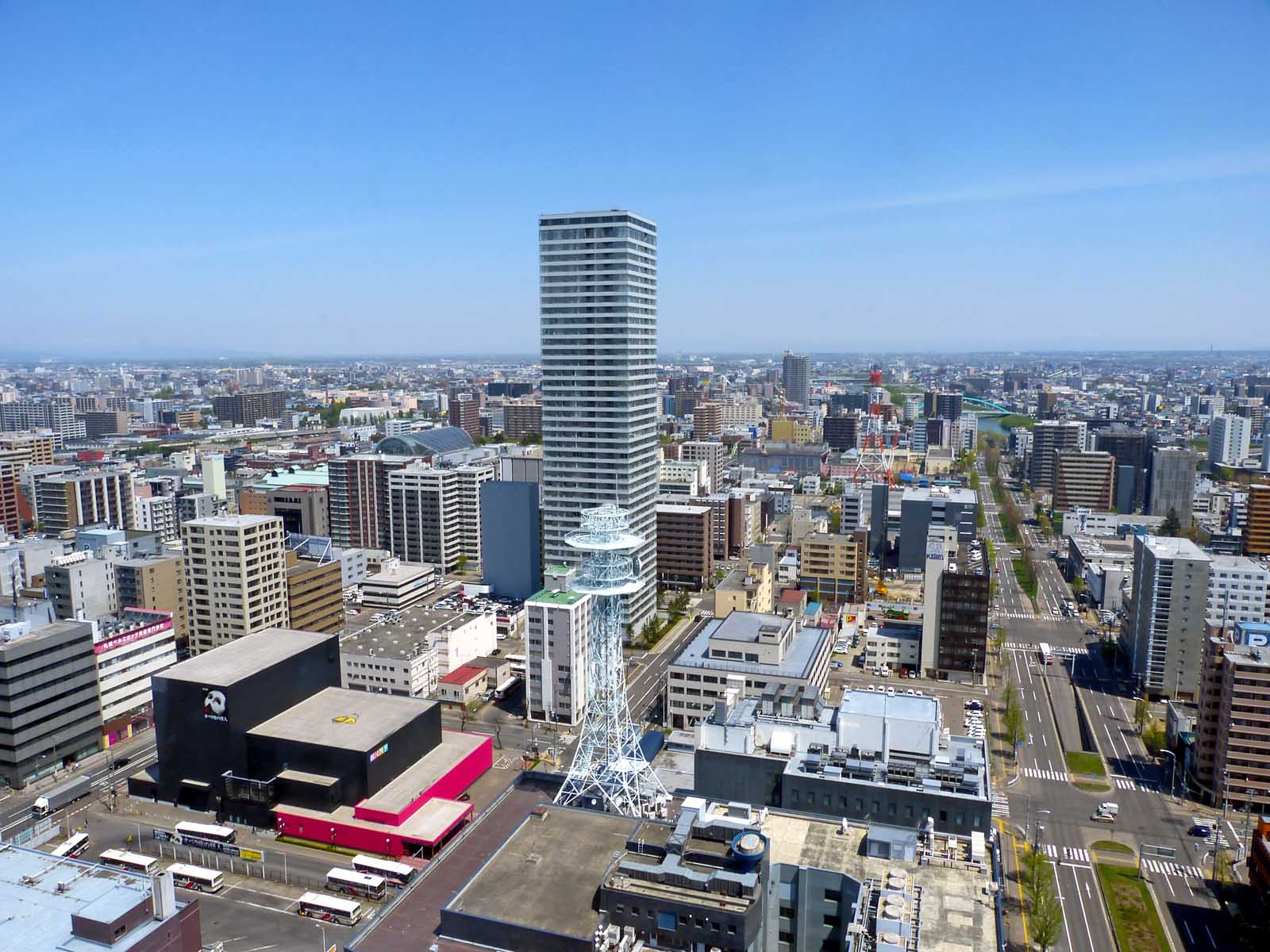
Do you recognize the name Sapporo? The city of Sapporo just happens to be the namesake (and birthplace) of one of Japan’s most famous beer brands. Sapporo is the capital of the Hokkaido Prefecture and is easily one of the best cities in Japan. Situated on Japan’s Northern Island, Sapporo is well-combined with a visit to Tokyo.
Visitors can tour the Sapporo Beer Museum or ride up to the top of the Sapporo TV Tower. There’s a fantastic mixture of attractions in Sapporo. It has that city buzz, with lots of big-city-style entertainment and tourist infrastructure.
If you can, coincide your visit to Sapporo with the Snow Festival. The winter festival is one of the best in the world, and the winter wonderland spreads 1.5 km – full of ice sculptures, an ice skating rink, and sledding areas.
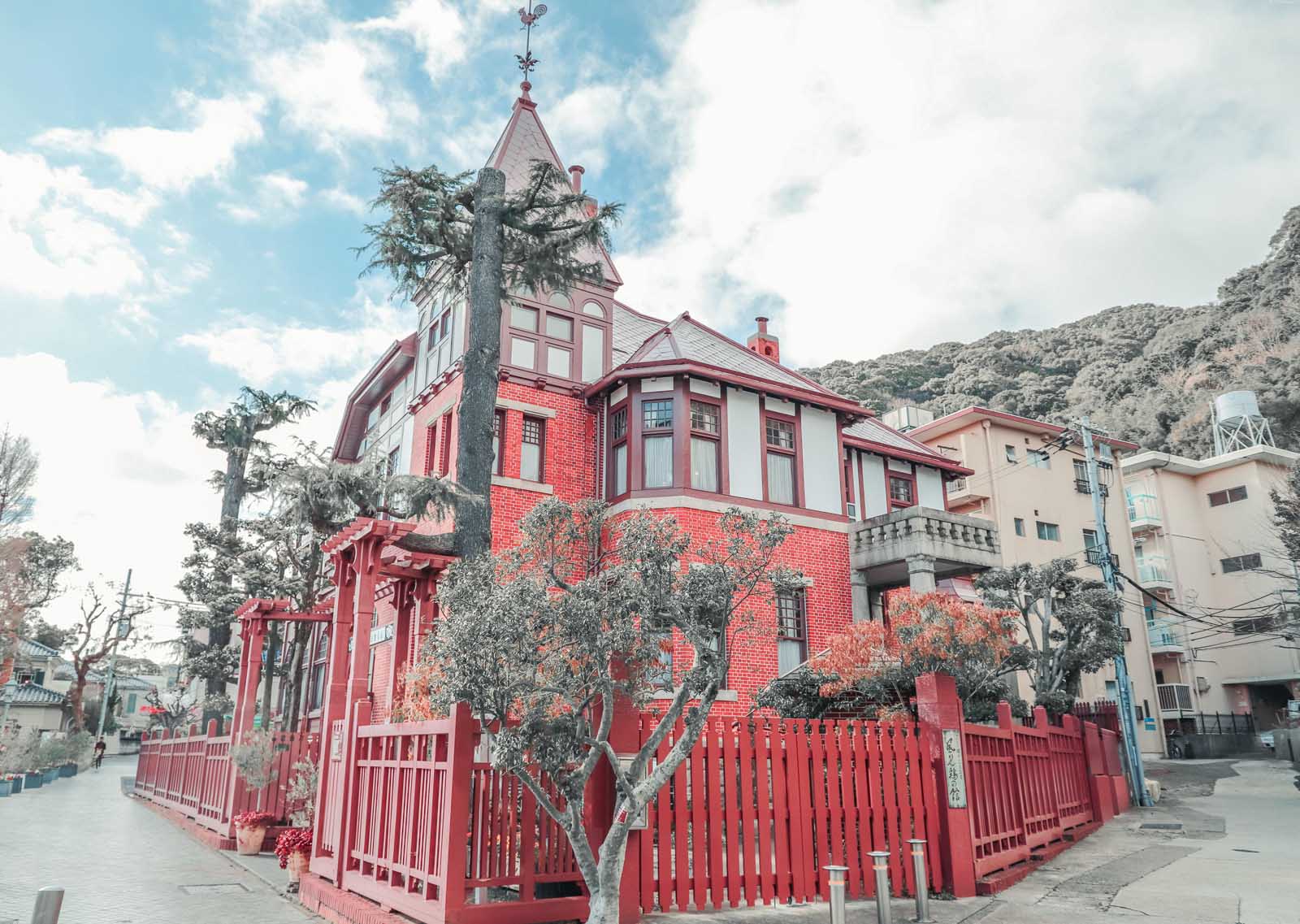
Kobe is one of Japan’s largest port cities, beginning to overflow with glitzy skyscrapers and modern living. This is not what got Kobe its place in this guide though; its food scene is what makes it stand apart from Japan’s other best cities. Kobe is world famous for its Kobe beef and renowned for its seafood. If you visit Kobe, be prepared to splash out on daily restaurant meals, as its cuisine is too tempting to pass by.
We suggest exploring Kitano Village to see Kobe’s old-school architecture. Of course, if you walk by a steakhouse, be sure to pop in and grab a table for a taste of Kobe beef. Steak Aoyama is a small, family-run steakhouse with an excellent reputation for delicious meals and pretty reasonable prices. Finish your day with a stroll around the harbor, with views of the modern skyline lighting up after dark.
Got a bit of extra time? Hike up Mount Rokko. Mount Rokko overshadows the city as a beautiful but fierce natural landmark. There are a range of route options so take a look at which best suits your fitness and technical abilities.
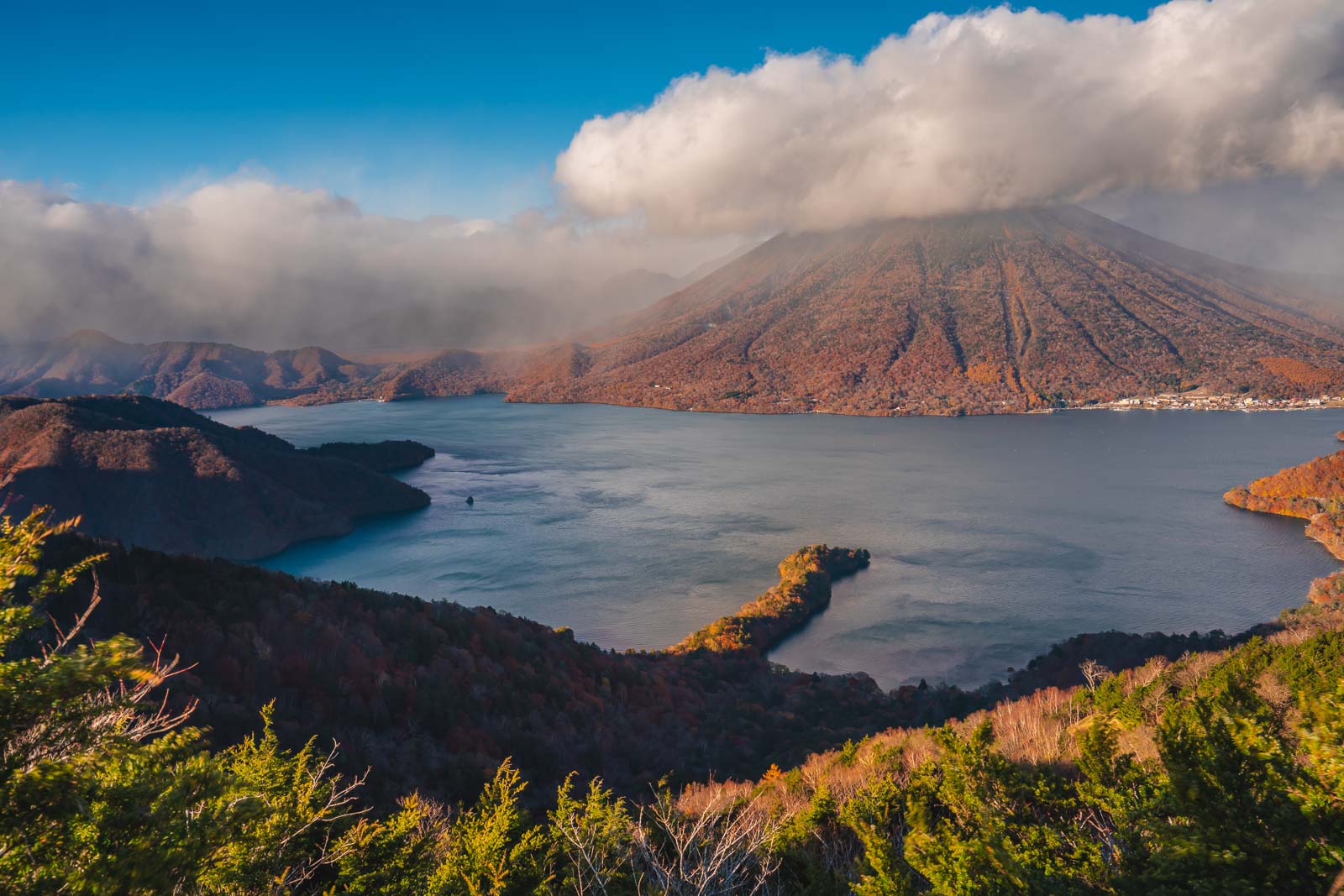
Nikko is one of the smallest cities in Japan. Situated in the Tochigi Prefecture, Nikko is surrounded by the Japanese Alps. It is one of the most beautiful places to visit in the country – let alone just amongst Japan’s best cities.
You can explore Nikko itself or use the city as a gateway to Nikko National Park. You’ll find temples, monkeys, and natural scenery galore. Nikko is perfect for lovers of the great outdoors. Visitors can easily balance hiking days and outdoor activities with sightseeing in the Nikko city center.
When it comes to things to do in Nikko , the Shinko Bridge is a must. The iconic red bridge is the postcard image of Nikko, and you should add it to even the shortest of itineraries. We also recommend spending at least a day temple hopping. Outside of Nikko, Kegon Falls is fantastic to visit. And, if you get a chance, take a scenic boat tour down the Kinugawa River.
Nikko is beautiful. To get off the beaten track and surround yourself with nature, look no further. Nikko has a serenity that the major cities in Japan just can’t provide. We stayed in a traditional Ryokan in Nikko, and you can read about our experience here .
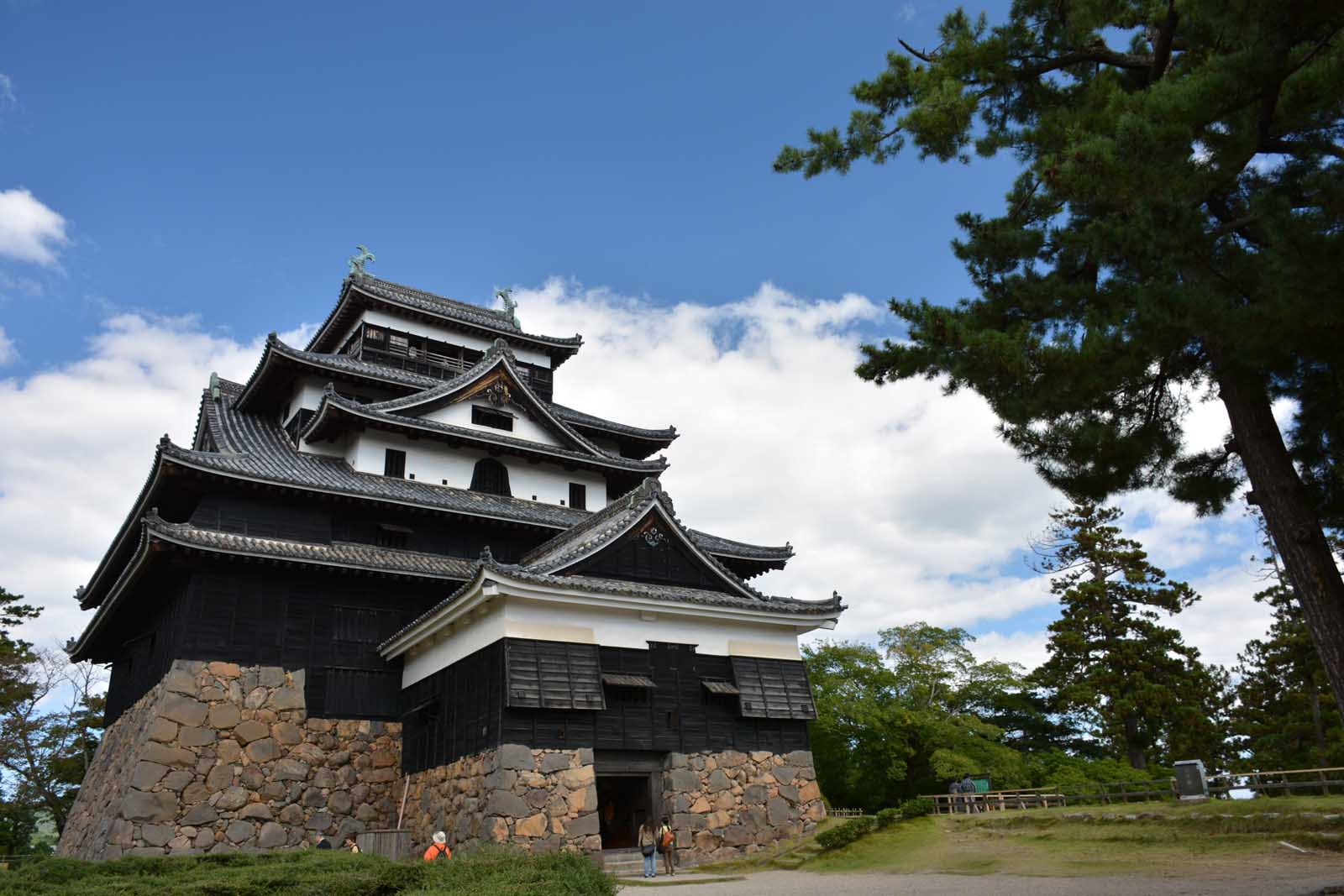
Matsue is in the Shimane Prefecture on the southwest coast of Japan. The large city is called ‘the water city’, thanks to its location between the sea and Lake Shinji. Mastue is less popular than major cities like Tokyo, but those who stray off the beaten path will be richly rewarded. Matsue is full of feudal history, historical sites, and beautiful scenery.
The best things to do are to visit Matsue Castle, the Adachi Museum of Art, and one of the shrines. The Yaegaki and Miho shrines are both famous for their beauty. While, if you want to embrace the water activities of ‘the water city’, you can take a sunset cruise on Lake Shinji.
Matsue has a relaxing atmosphere and is an excellent summer destination. It is one of the best cities to unwind and learn on the same trip.

Beppu isn’t always included in lists of the best cities in Japan. Sure, Beppu isn’t one of Japan’s major cities. However, it is one of the country’s most exciting places to visit. Beppu is a geologist’s delight and the best destination for hot springs in Japan. If you want a spa getaway or just to experience the natural wonders in Japan, Beppu is worth visiting.
Since Beppu has over 2,000 hot spring sources, you’ll have lots of spa-related things to do in the city. You can choose heated mineral springs or bathe in nutrient-rich heated mud or sand baths. You could even steam your own food over the onsen steam.
Want something totally different? Take a cable car trip up the Beppu Ropeway or visit the Harmonyland theme park. Beppe is one of the best cities in Japan for a short getaway and is definitely worth a space on your itinerary.
Final Thoughts
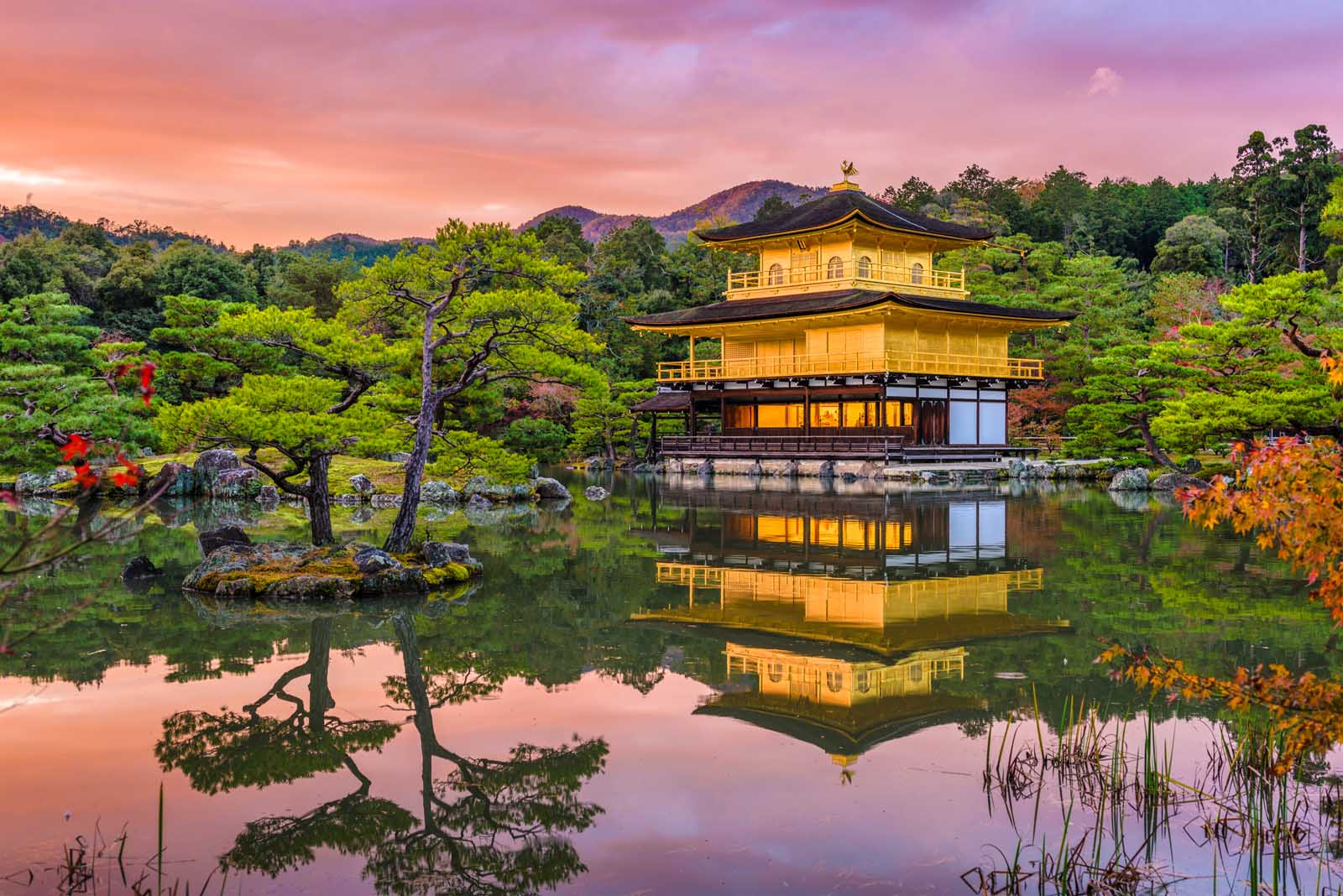
There are so many amazing cities in Japan. The country is a treasure trove of fascinating urban scenes, and you’ll find a unique culture, traditions , and delicious food . Whether you want the neon lights of Tokyo or the blue waters of the sea by Fukuoka, you’ll quickly find a city to suit your needs and interests. Besides, all of these cities in Japan are worth visiting.
We hope that you have a wonderful visit to Japan . The country is sure to inspire a return visit, so prepare to fall in love.
Plan Your Next Trip to Japan With These Resources:
- The Best Things to do in Tokyo, Japan
- Best Day Trips from Tokyo
- The 17 Best Things to Do in Kyoto, Japan
- Traditional Japanese Food: 20 Dishes You Can Try in Japan or At Home
- Mind-Blowing Facts about Japan
- Things to do in Kamakura Japan – The Ultimate Seaside Escape
- Complete Nikko Japan Travel Guide – 18 Things to do and Places to See
Travel Planning Resources
Looking to book your next trip? Why not use these resources that are tried and tested by yours truly.
Flights: Start planning your trip by finding the best flight deals on Skyscanner
Book your Hotel: Find the best prices on hotels with these two providers. If you are located in Europe use Booking.com and if you are anywhere else use TripAdvisor
Find Apartment Rentals: You will find the cheapest prices on apartment rentals with VRBO .
Travel Insurance: Don't leave home without it. Here is what we recommend:
- Allianz - Occasional Travelers.
- Medjet - Global air medical transport and travel security.
Need more help planning your trip? Make sure to check out our Resources Page where we highlight all the great companies that we trust when we are traveling.
You May Also Like
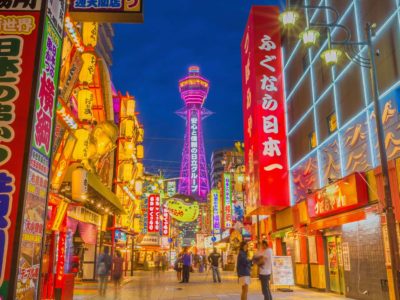
22 Best Things To Do In Osaka, Japan in 2024
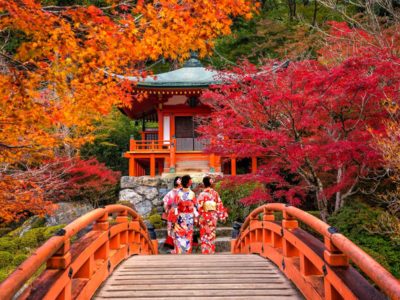
The 20 Best Things to Do in Kyoto, Japan
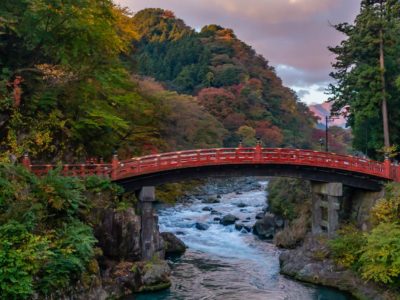
9 Amazing Day Trips from Tokyo, Japan
About ThePlanetD Team
Guest writers for The Planet D offer insider tips and information on destinations that they are experts in. We can't be everywhere at once, and it is important to have the highest level of travel information from local writers and experienced travelers.
Join thousands of others who get our monthly updates!
Leave a comment cancel reply.
Save my name, email, and website in this browser for the next time I comment.
1 thought on “14 Best Cities in Japan To Visit This Year”
Hello! My name is Yuan I like your blog, because I really like Japan. I hope to go
- Entertainment
- Latest Mortgage Rates
- Credit Cards
- Restaurants
- Food & Drink
- Lamborghini
- Aston Martin
- Rolls Royce
- Harley Davidson
- Honda Motorcycles
- BMW Motorcycles
- Triumph Motorcycles
- Indian Motorcycles
- Patek Philippe
- A. Lange & Söhne
- Audemars Piguet
- Jaeger-LeCoultre
- Vacheron Constantin
- Electronics
- Collectibles
The 10 Cheapest Places to Live in Japan

If you want to live in Japan, you'll need to accept something first. Japan isn't cheap. Not by a long way. It may have culture, history, a stable economy, and a reputation as one of the most modern and innovative societies around, but what it doesn't have is tiny price tags.
But while you'll struggle to find anywhere that you save a fortune while living like royalty, some places are more affordable than others. If you want to live well without sacrificing your life savings in the process, check out these ten cheapest places to live in Japan .

10. Kamakura
Drive less than an hour from Tokyo and you'll hit on the coastal city of Kamakura. At one point, it was the political center of Japan. Those days may be gone, but it's still got a unique place in Japanese society, not least for its stunning location.
Nestled between wooded hills and packed with Buddhist temples and Shinto shrines, it's easy to see what draws so many visitors to the city every year. For more long-term visitors, the city has plenty to recommend it, including affordable accommodation and a cost of living that, by Tokyo standards at least, is dazzlingly low.

If you like boats, beaches, and bargains, you're going to love the beautiful port of Chiba. Set a very convenient 30 miles away from Tokyo, the city is packed with attractions like Chiba Debra. Hoki Museum, Makuhari Messe, and the SSAWS ski resort.
Despite being within striking distance of the capital, the cost of living in Chiba is blissfully low, putting it within easy reach of people who want to enjoy the good life without robbing the bank first.

8. Yokohama
Who says big cities are always expensive? Yokohama may be one of the largest cities in Japan, but it's also pleasantly affordable. A one-bedroom studio apartment in the center shouldn't cost you much more than $1300 per month - cast your net a little wider and you shouldn't have any problems in finding somewhere in the outskirts for between $700 to $1000.
Utilities, groceries, and entertainment are all similarly affordable. Asides from affordability, Yokohama offers its residents a host of benefits, including an easy 30-minute commute into Tokyo and the kind of wining, dining, shopping, and recreation opportunities that are more than a match for the capital.

7. Kawasaki
Living in Tokyo might be exciting, but it's not exactly easy on a shoestring budget. Fortunately, there are a plethora of cities in the wider Tokyo metropolitan area that offer all the advantages of the big city, but at a fraction of the cost.
Despite being just a short commute from the capital, life in Kawasaki is much easier on your wallet. Rental prices are around 50% less than in Tokyo, and the overall cost of living won't stretch your budget to breaking point.
Even leaving aside its affordability, the city still has a lot to offer, including a picturesque riverside location, a strong job market, and a very attractive clutch of shrines and museums.

If you want to enjoy Japan's rich culture, not to mention some of its finest beaches, you'd do well to set your sights on Naha on the island of Okinawa. Blessed with a stunning coastline, a diverse tropical interior, and glorious weather, it's heaven for nature lovers.
Fortunately, it's not exactly hell for those on a budget either, with a good selection of very affordable housing options and an overall cost of living that won't blow a hole in the bank.
The one thing you'll need to bear in mind is that Okinawa is tiny and about as remote as it's possible to get. Getting around Naha won't be a problem, but once you break free of the city limits, you're on your own.

According to ksemoving.com , Japan's third most populous city also ranks as one of its most affordable. Housing prices are reasonable, the cost of utilities, groceries, and other essentials are all low enough not to be a concern, and the public transportation system is both affordable and decent enough to make getting from one part of the city to the other a cheap breeze.
On top of all that, Osaka is said to be one of the most easy-going and friendly cities in the entire country.

If the thought of living like a king for less than $2000 a month appeals to you, you might want to consider Sapporo. For just a little over $700 a month, you'll be able to stretch to a very reasonable apartment in the heart of the city.
Groceries, utilities, and other essentials are all equally affordable. If all that wasn't enough to tempt you, the relaxed pace of life and annual traditions like the Hanami festival and the Sapporo Snow Festival just might.

Inside Tale ranks Kyoto as one of the best cities to live in Japan. As the cultural and religious hub of the country, it's packed to the rafters with religious places, temples, shrines, and other places of note, including Kinkaku-ji, Kamigamo Shrine, Shimogamo Shrine, Tō-ji, and Daigo-ji.
Yet despite its historical and cultural importance, Kyoto doesn't charge its residents a premium to live here. Housing options are extensive and, by and large, incredibly affordable. Groceries might be a little pricier than they are in certain other parts of the country, but the overall cost of living is still low enough to let you get by on around $1900 a month.

In 2020, questionjapan.com ranked Fukuoka as one of the five cheapest places in Japan to live. In the year since, not a lot has changed. Housing is still incredibly affordable (expect to find a very attractive city center apartment for less than $700 a month), and the cost of food, entertainment, utilities, and other essentials come in at around 25% less than you'd pay in Tokyo.
If you needed any further reason to make it your next home, the numerous parks, beaches, shrines, bars, restaurants, and booming job market should help.

1. Tsushima Island
If you're a fan of the great outdoors, you're going to love Tsushima Island. Over 80% of the island comprises of a nature reserve, packed with mountains, pristine beaches, tropical vegetation, and sublime scenery.
While big-city attractions are thin on the ground, there's still a lot of historical and cultural delights to enjoy, along with a jam-packed events schedule that includes the likes of Banshoin Temple Lantern Lighting Festival, Izuhara Port Festival, and Watazumi Shrine Traditional Festival.
The cost of living is almost unbelievably low, with around $1200 per month being more than enough to let you live in style.
You can also read:
- 20 Must See Attractions in Japan
- The 20 Best Things To Do in Japan for First-Timers
- The 20 Best Places to Live in Japan
- The Traveler’s Guide to HIking in Nagoya, Japan

Written by Dana Hanson
Related articles, how to know if you’ll regret moving to florida.

7 Reasons Why People Regret Moving To Colorado

How To Know If You’ll Regret Moving to South Carolina
How to know if you’ll regret moving to arizona.

6 Things to Know about the Cost of Living in Florida Vs. California
9 things to know about the cost of living in canada vs us, 8 aspects of the cost of living in costa rica vs usa, 9 differences in the cost of living in ireland vs us.

Wealth Insight! Subscribe to our Exclusive Newsletter
- Tokyo Cheapo (繁體中文)
Japan's Top Cities: Which Ones to Visit?
Planning a trip around Japan involves some tough decisions when it comes to picking which cities to visit.
Aside from Tokyo, there are three big cities. And while we’re not claiming Tokyo is an absolute must, it’s often a given (partly due to flights), so we’ll stick to the outliers. Kyoto, Osaka and Hiroshima form the golden trio—all with easy reach of each other, all with their own highlights. But what if you can’t hit all three? If you are struggling with which Japanese cities to choose or looking for alternatives, we’ve got a few suggestions.

1. Kyoto: Perfect for culture lovers and temple hoppers

Easily the number-one destination after Tokyo, Kyoto is the ancient capital and heart of Japan’s cultural history. Known for being stylish and having a slower pace of life, Kyoto is picturesque and knows it—kind of like the ‘popular girl’ at school who was actually really nice that you couldn’t help but like.
Why you should go
Some of the most well-known spots in Japan can be found here, including the eye-catching Kinkakuji, the winding streets of Gion and the bamboo forests of Arashiyama. With over 1,000 temples in total, Kyoto is the type of place you’ll need to spend a few days exploring (we have a handy two-day plan you can peruse to help you decide). It’s perfect for that old-Japan feel and has plenty of fewer-visited corners as well as the busier ones. There are also great nearby places to travel too, including Nara , Amanohashidate and Uji .
Why you shouldn’t
Kyoto is pretty busy, especially if you visit during its prettiest seasons (cherry blossom or autumn, or New Year… or summer? A lot of the time basically). Annual visitors have topped 50 million in recent years (nearly 140,000 a day if you divide it equally), so expect crowds and queues at all the sights. The tourism factor can make it pricier than a lot of places with less of a reputation, especially when it comes to hotels or ryokan . There are budget options of course, they just book up fast.
The verdict
Keep in mind that things are often popular for a reason (unless you’re talking about the Kardashians or Coldplay that is), so if you’ve never been, it can still be an amazing place to see (plus it’s only going to get busier). Otherwise, consider some alternatives (below).
The alternatives: Kanazawa and Kamakura

If you’re looking for a similar feel, but have already been to Kyoto or just don’t fancy it, there are some great alternatives. Kanazawa is a smaller city known for beautifully preserved Edo districts where geisha serve tea and entertain . There is a history of gold-leaf production as well as the stunning 17th-century Kenrokuen Garden and the food haven of Omicho Market. Usually a stop-off rather than a destination, it’s a city with a lot to offer—especially if you stay a few days and explore fully.
If you’re staying closer to Tokyo, Kamakura is known as “Little Kyoto” partly due to it being a capital city in the distant past, but also thanks to the number of temples. A far cry from Tokyo’s busy neon feel, but only an hour away by train, Kamakura a more manageable option. If you’re looking for more Tokyo-based locations that have a hint of Kyoto, we have a few more suggestions .
2. Osaka: One for the foodies and nightlife lovers

Osaka is the scruffier, friendlier and rougher (but in a good way) city of Japan. Osakans are known for being more direct, the nights last longer, and just as Kyotoites would go bankrupt for clothes, this city would do it for food.
If you’re the kind of person who bases their travel plans around food, then this has to be top of your list. Known for kuidaore (dining yourself into bankrupty), Osaka serves up nfamous dishes like okonomiyaki and takoyaki as well as lesser known options like kushikatsu . It’s also the home of kitsune udon and cup noodles.
The fabulously neon Dotonbori is packed with restaurants and has been the dedicated entertainment district for almost 400 years. This combination makes Osaka the best place for a night out (and the giant Asahi beer sign is no mere coincidence). With plenty of clubs, more bars than you could ever hope to visit and enough late-night ramen to see you through, a trip to Osaka is a thoroughly indulgent affair.
While Osaka has a fair few day-time sights to enjoy, it’s definitely less fun if you’re not into the food or social side. If you like quiet shrines and temples and can’t stand the idea of walking down busy streets for your third dinner of the night, maybe skip this one.
Foodies, groups up for a night out and lovers of neon go right ahead. If you prefer serene gardens and are an “eat to live” kind of person, maybe don’t—or maybe do and it will change your life!
The alternative: Sapporo

Almost 5,000 km away, Sapporo is the perfect alternative to Osaka thanks to it’s proximity to nature, love of beer and fantastic food. As the capital of Hokkaido, Sapporo’s location means it just doesn’t get the visitors (besides during the famous annual snow festival ), but it really should. Known as the home of beer, Sapporo has lots to offer in terms of musuems, Sapporo and Asahi brewery tours and beer halls, microbreweries and a strong whiskey scene thanks to Nikka. Food-wise you are spoiled for choice —the island is known for dairy and potatoes, while the city is known for butter ramen, soup curry and more. Last but not least, the Susukino District has all the neon of Osaka, so you won’t feel left out.
3. Hiroshima: History and tradition

A landmark in history for all the worst reasons, Hiroshima is a beautiful city with a balance of both somber and serene locations. While it would be strange to visit without going to the museums and peace park , it would be equally strange to limit the city to only these places—especially with a stunning castle, beautiful gardens and great food scene to explore.
If you’re particularly interested in history or feel you have a connection to the events of WWII, going to Hiroshima can be an incredibly personal and emotional trip. For those with a more general interest, it can be educational, moving and beautiful—a true lesson in the damages of war and the need for peace in the future. There are plenty of beautiful sights including Hiroshima Castle, Shukkei-en Gardens and the delicious local specialty of Hiroshima-style okonomiyaki . Nearby, the fantastic Miyajima is known for the floating gate and is only half an hour from the city.
This is a tough one—if you have no interest in history and other places rank higher on sights, then maybe skip Hiroshima. It is an important part of both Japan and the world’s past, however, so do consider the visit.
The alternative: Fukuoka

Not necessarily the obvious choice, but Fukuoka can be a great alternative to Hiroshima and is close to the city that may have first sprung to mind. A busy hub with a reputation for night-time food stalls, impressive shrines and temples as well as a healthy appetite for ramen—it’s a great introduction to the Kyushu region. If you’re looking for some war-related history, Nagasaki is near(ish), and Beppu has some great onsen to see and soak in. All in all it’s the perfect base for island explorations.
If you can’t choose or have some extra time, we have a 7-day itinerary and 14-day World Heritage based one for exploring Japan on the JR Pass!
Get the best Japan Cheapo hacks direct to your inbox

Updated: 2024 Japan Cherry Blossom Forecast
The blooms are fashionably late. Here's when to see sakura in all the major cities.

April 2024: Top Events Around Japan
Look forward to flowers and festivals galore!

8 Perfect Places To See Cherry Blossoms in Osaka
Castle grounds, sprawling parks — and somewhere extra special.

Cherry Blossoms in Kyoto: 14 Best Sakura Spots
From temples to riversides, geisha districts — and more.

9 Things To Do in Fukui
Explore the shiny new stop on the Hokuriku Shinkansen — an easy trip from Tokyo.

6 Must-See Fertility and "Penis Festivals" in Japan
Stop giggling and start reading.

11 Best Places to See Cherry Blossoms in Japan
Riverside paths, real castle moats, pagodas and more.

Ghibli Park Guide: Tickets, Getting There and More (Updated)
Now with the Valley of Witches, and real-life cat buses.

March 2024: Top Events Around Japan
Plum and cherry blossoms, spring festivals, the Grand Sumo Tournament in Osaka — and more!

The Survival Guide to Kyoto Station
Bookmark this for easier travels.

5 Reasons To Visit Ishikawa
The prefecture extends a warm welcome, as part of its efforts to rebuild in the wake of the Noto earthquake.

February 2024: Top Events Around Japan
Winter wonderlands, oyster festivals, and rituals to chase away demons.

Close without accepting
- Travel Guides
- Top Destinations
- Inspiration & Ideas
- Booking Tips
- Packing Guide
- Where to stay
- At The Airport
- How-to Guides
- First Times
- Travel Community
- World Flavours
- Travel Products
The 10 best cities to visit in Japan in 2021
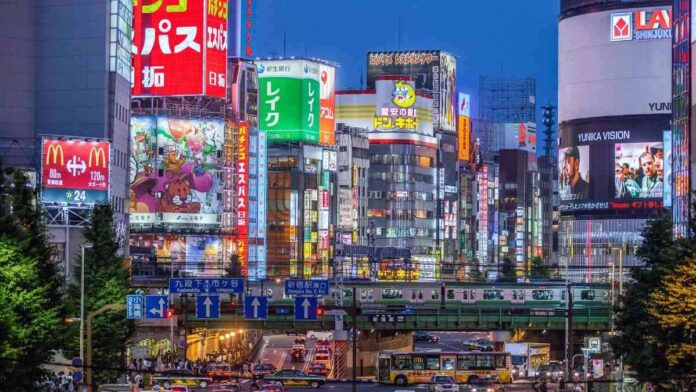
Japan’s diverse culture makes it somewhat of a paradox, with the entire country being a delicate blend of ultra-modern and beautifully traditional. A short trip along the winding alleys of the best cities in Japan unveils a labyrinth of endless activity and exploration.
The best cities to visit in Japan will vary depending on your interests, but luckily the country has something for everyone, ranging from beautiful beaches to modern metropolises.
What are the best cities to visit in Japan?
Top cities in japan to immerse yourself in culture and history, best cities in japan for urban travel, top cities in japan to experience nature, best city in japan for a gastronomical experience, best cities in japan to immerse yourself in culture and history.
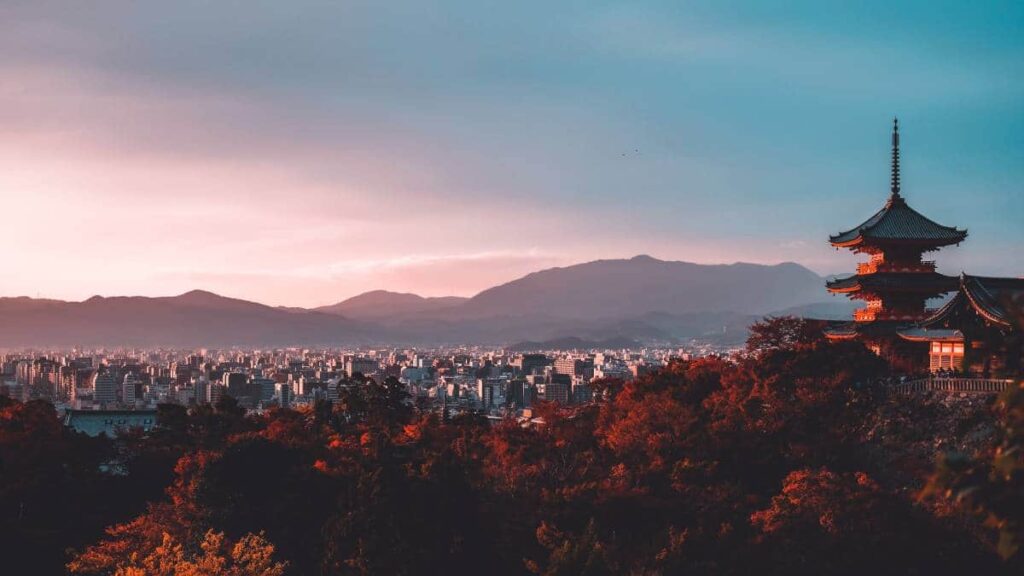
Compared to some of the more modern cities in Japan, Kyoto feels more traditional, and that is precisely why you should visit. The former capital is dripping with history, and you will find numerous beautiful temples.
I recommend waking up early and heading up Fushimi Inari Shrine before the crowds come. Then take a stroll along the Philosopher’s Path and bask in the area’s serenity. I rented a bicycle to explore the whole city and recommend it highly.
Kyoto’s biggest attraction comes to life in late March to early April, and the cherry blossom spots bloom and are indeed a sight to behold.
The food in Kyoto makes it one of the best cities in Japan. The ramen I had here was the best in Japan. You can find Kyoto GOGYO around Nishiki Market, but you’ll have to wait in line.
READ MORE: Kyoto is also one of the best romantic anniversary destinations in the world
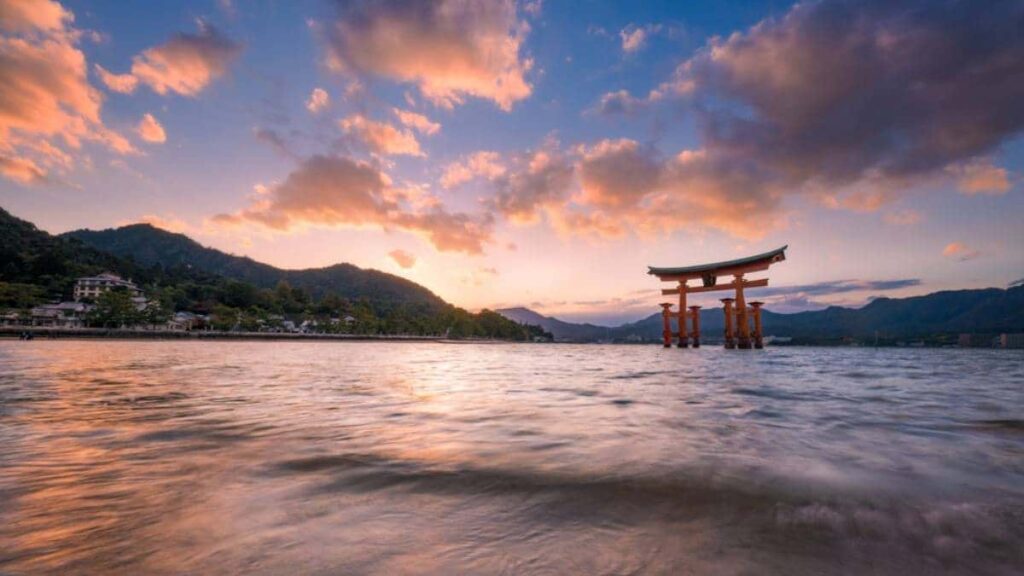
Steeped in history from the infamous atomic bomb which destroyed the city in 1945, Hiroshima is one of the top cities in Japan for those seeking some history.
Pay your respects at the Hiroshima Peace Memorial Park, commonly called the Genbaku Dome, Atomic Bomb Dome or A-Bomb Dome, and visit the area’s museum for a closer delve into the events of that fateful August 6th day.
The local speciality is okonomiyaki, a Japanese savoury pancake, and it is delicious. Nearby you can find Miyajima Island, which requires a short ferry ride to visit. There is a giant floating torii gate which is one of the largest in Japan. The island is also full of deer like at Nara, so if you are short on time, I’d recommend coming here because the island coupled with the city of Hiroshima means there is more to do.
READ MORE: When is the best time to visit Japan?
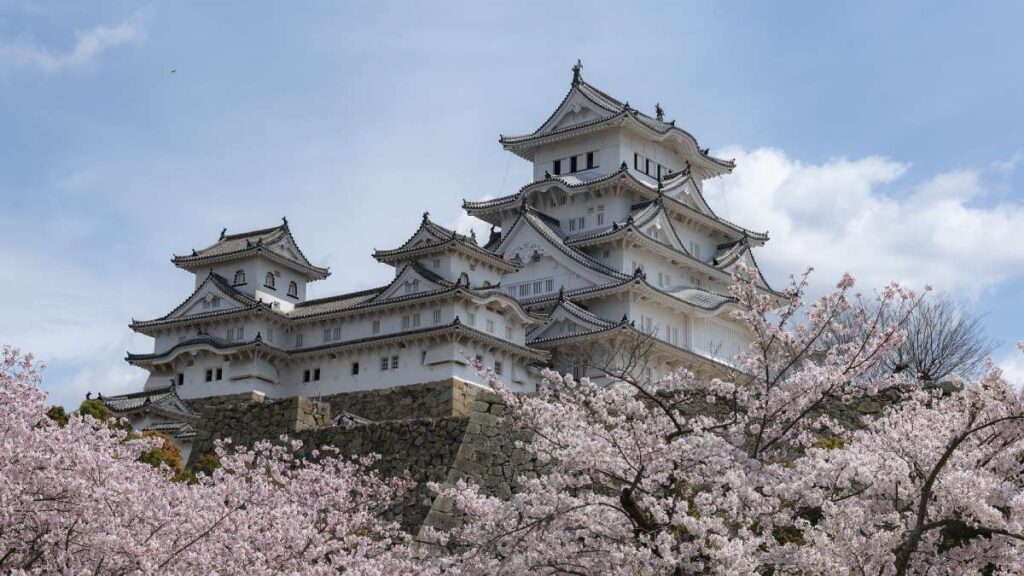
The serenity and accessibility of Himeji makes it the perfect destination for a 1-day getaway from the busy life in Osaka.
Be sure to visit the Himeji Castle, a UNESCO Heritage Site and a National Treasure of Japan. The magnificent white castle is the biggest and most visited castle in the nation and boasts a rich history and significance.
The entrance fee here is about $10 for adults and $3 for students. Expect to spend about 2 to 4 hours exploring the six levels of the Main Keep. If you are lucky, you could secure a ticket in the peak season and enjoy the cherry blossoms.
Don’t forget to visit Kokoen Garden or Engyo-ji Temple for some incredible views.
READ MORE: Himeji Castle is one of the most famous castles in the world
Top cities in Japan for urban travel
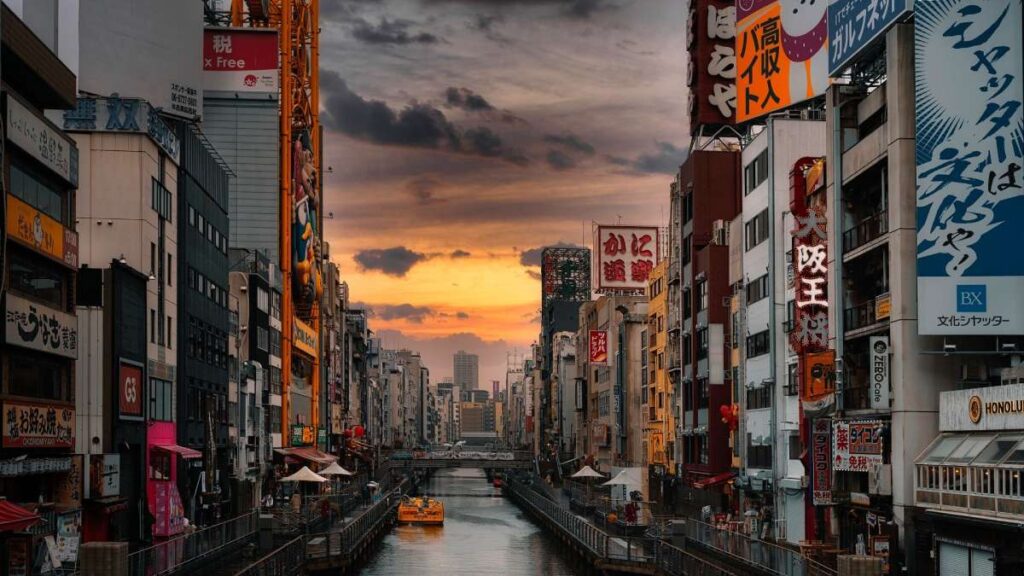
Osaka was the first city I visited in Japan and my overall favourite, it’s one of the best cities to visit in Japan.
The metro area is excellent to explore on foot, and the parks are beautiful. Make sure to visit Shirokita Park, which is near the waterfront and then take a stroll down the river and enjoy a drink at one of the many riverside bars.
Stepping foot into Dotonbori, the main tourist area, is an assault on the senses at first. But you’ll be left in awe as the chaotic nightlight makes way for neon lights and canal boats. Enjoy some food on one of the many nightspots that line the canal and soak everything in.
If you have time, the Osaka aquarium is also worth taking a visit too as it’s one of the largest in the world.
READ MORE: Did you know that Osaka is one of the largest cities in the world (although it’s not the largest in Japan)?
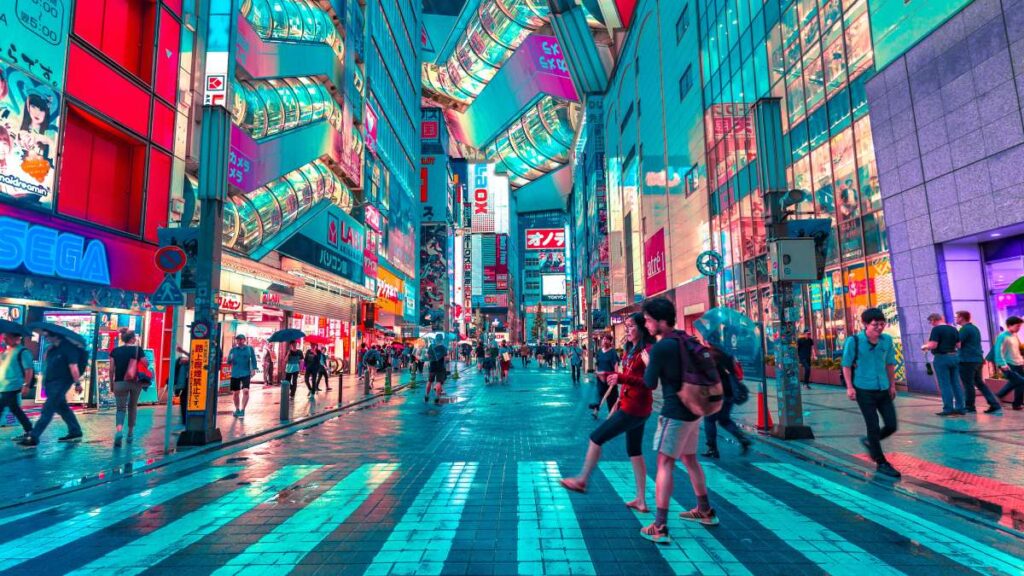
Tokyo has something for everyone. It’s one of the best cities to visit in Japan (and in the world) if you are looking for some diversity. It has Akihabara for all the diehard anime fans and more traditional spots like the cramped bars of Shinjuku Golden Gai for those wanting a taste of the city’s nightlife.
Simply walking the streets of Shinjuku and soaking up the atmosphere is an activity in itself. But be sure to check out Ameya Yokocho market in Ueno and stop at the host of incredible street food spots. It’s also a popular shopping district and nearby the beautiful Ueno Park.
I’d also highly recommend getting a free birdseye view of the city up the Tokyo Metropolitan Government Building which is located in Shinjuku. For something unique, take a trip down to TeamLab Borderless for an immersive digital art experience.
READ MORE: Amazing Tokyo made our list of the top 10 best cities in the world
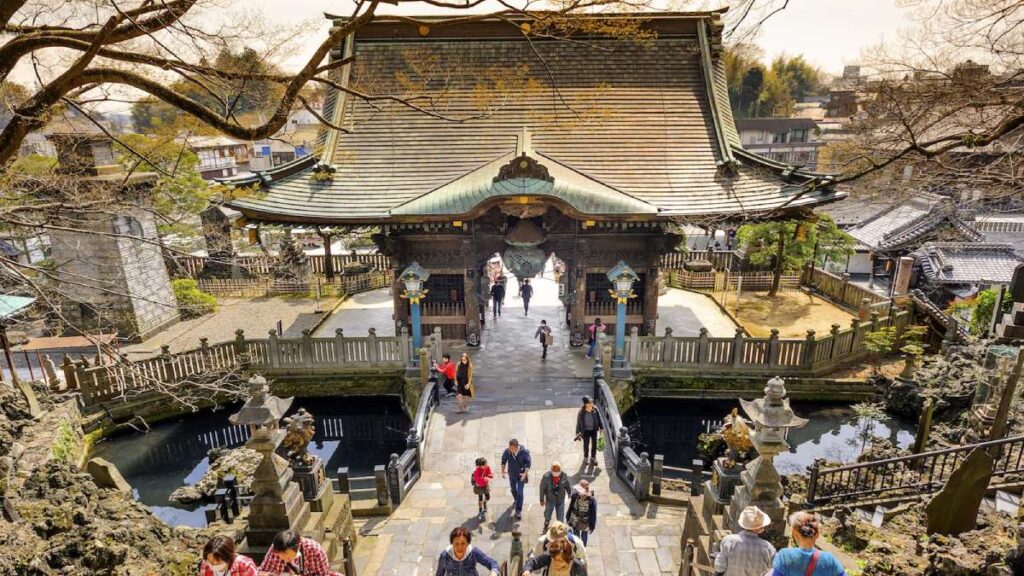
Home to Japan’s busiest airport and located about 60 kilometres away from Tokyo, tourists tend to leave Narita out of the itinerary. If you are lucky enough to get a long layover in Narita Airport, I recommend venturing out into the area for a few hidden gems.
For a day trip, you can check out Japan’s first aeronautical museum and experience a flight simulator. For some last-minute shopping, head to Aeon Mall or Shisui Premium Outlet and you could grab some really good deals. If you are travelling for business looking to just relax, get in an onsen fix at Yamato No Yu or have a quick stroll on “Plane-Spotting Hill” Sakura-no-Yama Park.
READ MORE: Discover why Japan is one of the best and safest places in the world for solo female travel
Best cities in Japan to experience nature
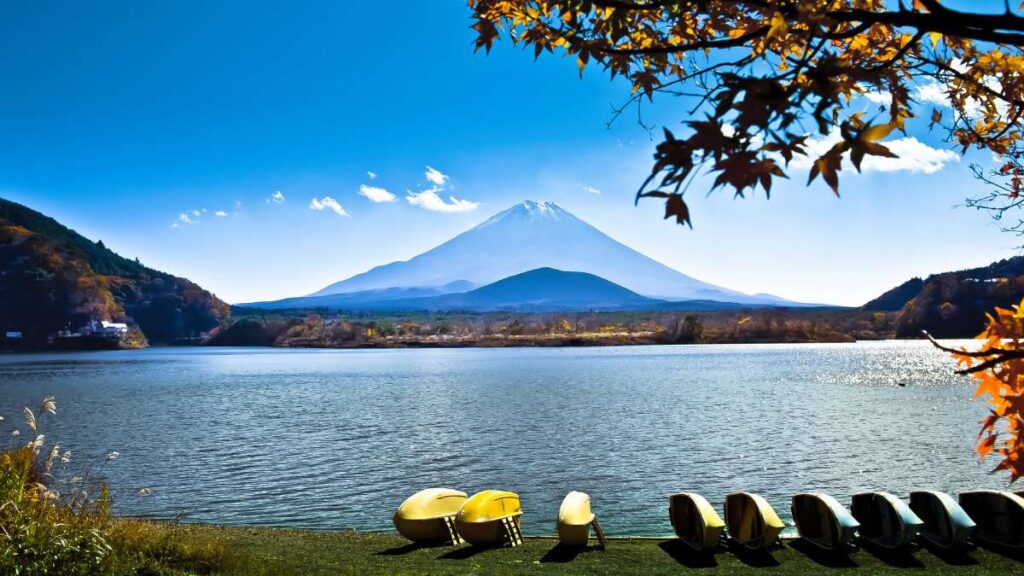
Sitting just an hour and a half from Tokyo, I am often amazed at how many people pass Hakone by. The mountainous area is one of the top cities in Japan for a retreat from the chaos of Tokyo and is well known for the abundance of onsens, the Japanese hot spring resorts.
Make sure to get a Hakone Free Pass which enables you to use all transport in the region under one travel card. A boat ride across Lake Ashi will give you a spectacular view of the famous red torii gate, and on a clear day, you’ll even get a glimpse of Mount Fuji. A cable car over Ōwakudani, the active volcano, is also included in the pass.
For the active among you, I highly recommend hiking up Mount Kintoki. At 1,212m above sea level, it takes a few hours to climb but will give you a perfect view of the snow-capped Mount Fuji. The hike alone made this one of my top cities in Japan. It’s also free.
READ MORE: Japan is home to one of the world’s best and biggest roller coasters
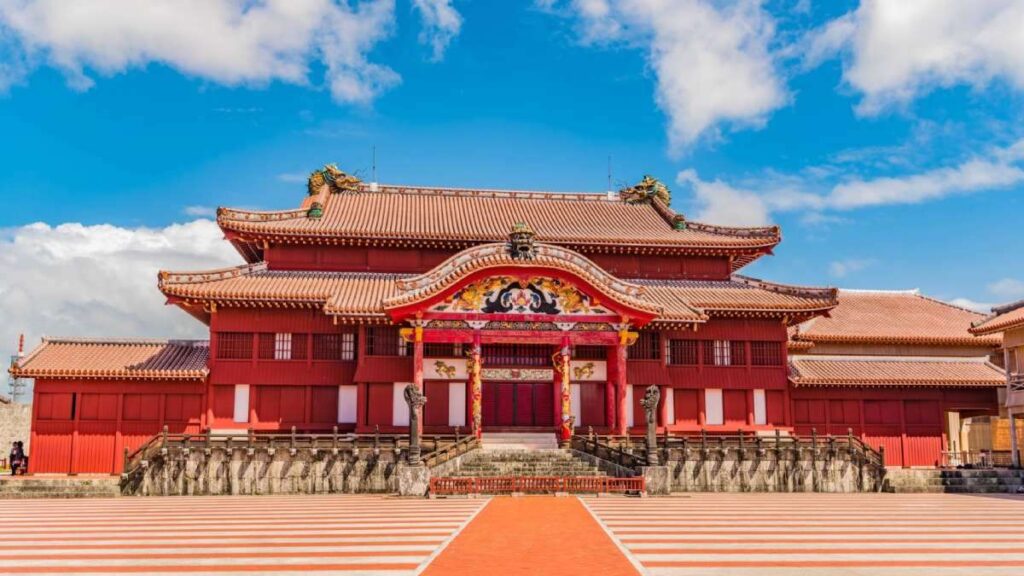
Naha is one of the best cities in Japan if you are looking for a beach break while on your Japanese adventure. It is the capital of Okinawa, a beautiful prefecture made up of an array of islands.
While in Naha make sure to check out the Naminoue Beach for some sun, Shurijo Castle for some culture, and First Makishi Public Market for a bite to eat. Naha acts as a hub for the other islands in the region. So take a boat tour to explore the variety of snorkelling, swimming, and other activities on offer.
READ MORE: While in Okinawa make sure you explore one of the largest aquariums in the world
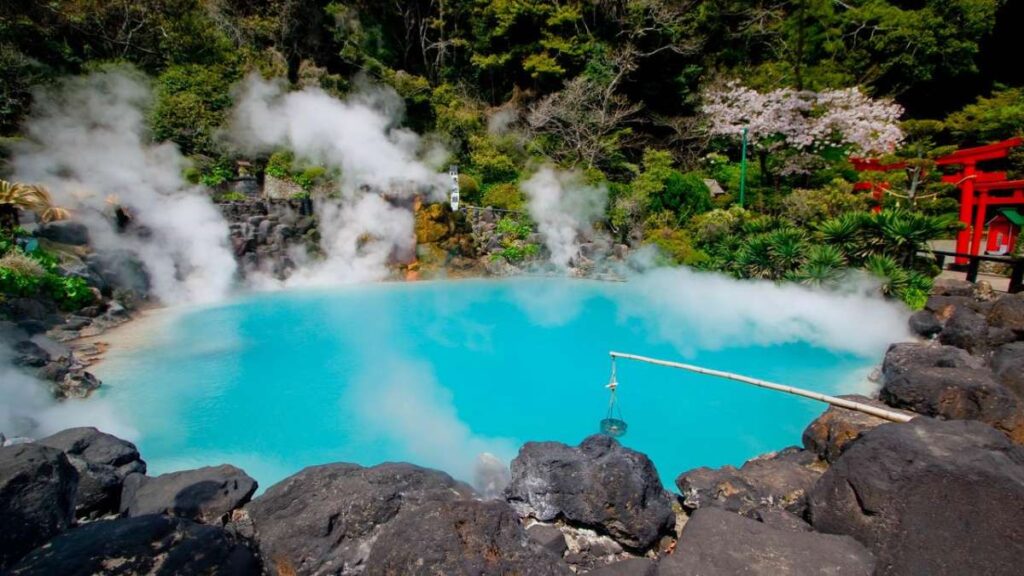
The city of Beppu is the most popular hot spring resort in Japan – a title brought about by having over 2,000 hot springs vents that account for 10% of the vents in the country. Domestic and foreign travelers flock to Beppu just for its unbeatable range of onsen activities.
Besides the conventional hot water, the resorts here offer other bath types such as mud, steam or sand baths. After you have pampered yourself with the abundance of thermal water that Beppu has to offer, check out some of the ‘hells”, which are hot springs for viewing only. I would recommend visiting Umi Jigoku or Chinoike Jigoku for a more interesting photo op.
Foodies can have a taste of fugu, or blowfish, in the various restaurants scattered in the area. For those feeling a little less adventurous, have a go at steam cooking at Jisokumushi Kobo Steam Cooking Center.
READ MORE: Japan regularly is at the top of the safest countries to visit
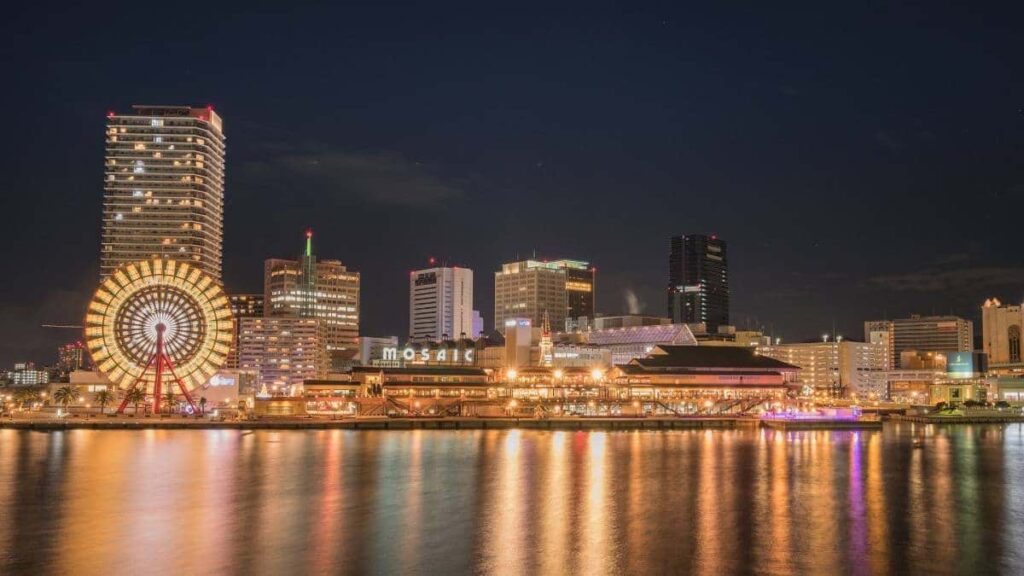
The Japanese have always been known for their precision, reliability and expertise in their craft. For food, Kobe is the perfect summation of gastronomical excellence. If there has to be a city that foodies cannot miss out, it’s Kobe – for Kobe beef, obviously.
The city is not just good for its famous beef. Indulge in sake at the breweries in Nada while checking out the various museums in Japan’s district with the top sake production – admission is free.
If you need to get in a good workout, a 40-60 minute hiking trail from Shin-Kobe Station will take you through some decent views of Nunobiki Waterfall and Nunobiki Herb Garden. The best view awaits you at the top station of Shin-Kobe Ropeway, where you can get an aerial view of the city at the observatory.
READ MORE: Are you a foodie? Would you dare trying the most bizarre and weird food from around the world ?
The beauty of Japan is that there is something for every traveler. Whether it’s taking in the breathtaking views of the skyline in the metropolis or stumbling upon a quaint eatery in a cobbled alley, Japan offers a truly unique experience for each visitor she welcomes.
Check out our Japan Travel Guide for tips on everything you need to know when planning your trip to Japan so you can make the most of your time in the Land of the Rising Sun!
- Travel Guide
RELATED ARTICLES
10 awesome reasons why you should travel to singapore in 2023, 10 best things to do in kyoto, the 10 best bars in melbourne in 2022, latest articles, embracing sustainable travel: a guide to eco-friendly journeys and green tourism, the best canned alcoholic drinks when you’re on the go, how to prepare for a flight with pets, how to prepare for a flight with a child: essential tips for flying with children, most popular, mobile travel apps are growing in apac as the world embraces travel again, 14 best ideas on how to travel for cheap, best retro games for long flights, discovering kuching: a comprehensive travel guide for your sarawak adventure.
- Privacy Policy
- Terms Of Use
Copyright © 2024 Travel Wanderlust - All Rights Reserved.

Unforgettable 7 Day Japan Itinerary (2024)
R eady to dive into a whirlwind 7 day Japan itinerary that promises a blend of tradition, modernity, and breathtaking landscapes? From the electrifying streets of Tokyo to the serene temples of Kyoto and the gastronomic delights of Osaka, I have crafted a journey based on my personal experience that packs the essence of Japan into one unforgettable week.
*Disclosure: This post may contain affiliate links, which means we may receive a commission if you click a link and purchase something we have recommended. Please check out our disclosure policy for more details. Thank you for your support!
Your 7 Day Japan Itinerary
This itinerary isn’t just about ticking off the sights. It’s about immersing yourself in the rhythm of Japanese life. From samurai stories to the future of technology, and yes, lots of sushi, get ready for a truly unique adventure.
Day 1: Tokyo – Urban Exploration and Neon Lights
How to travel to tokyo.
Your 7 day Japan itinerary will likely start at Narita International Airport. From the airport, the quickest way to central Tokyo is the Narita Express train (N’EX), which takes about an hour. Just ask anyone at the airport train station for directions.
Another easy option is the Limousine Bus service that runs both to and from Narita and Haneda airports.
Best places to stay in Tokyo
Choosing where to stay in Tokyo offers a glimpse into the city’s diverse character. Shibuya and Shinjuku offer vibrant nightlife and bustling streets, making them perfect for those looking to dive into Tokyo’s dynamic energy.
For a more serene atmosphere with a touch of traditional charm, Asakusa hosts cozy stays near historical sites. Alternatively, Roppongi stands out for art lovers and night owls, offering upscale accommodations and a lively scene. Here are some of our favorite Tokyo hotels for families .
Things to do in Tokyo on Day 1
- Visit Senso-ji Temple in Asakusa: Start your exploration in the tranquil surroundings of Tokyo’s oldest temple, Senso-ji. Walking through the iconic Kaminarimon Gate and browsing the stalls of Nakamise Street is a wonderful introduction to Japanese culture.
- Cross Shibuya Crossing: Witness the organized chaos of Shibuya Crossing, one of the most photographed spots in Tokyo. The nearby statue of Hachiko, the loyal dog, adds a bit of nostalgia to this bustling area.
- Explore Harajuku: Dive into the heart of Tokyo’s youth and fashion culture in Harajuku. Takeshita Street is a kaleidoscope of trendy shops, cafes, and colorful street food. It reflects the vibrant and eccentric styles that define the area.
- Enjoy the Views from the Tokyo Metropolitan Government Building: Head to Shinjuku to visit the Tokyo Metropolitan Government Building. Its observation decks offer stunning panoramic views of the city. This is a perfect spot to watch the sunset over Tokyo. (This is a great option if you don’t want to pay for Shibuya Sky , Tokyo Tower, or Tokyo Skytree ).
- Dine in Omoide Yokocho: Conclude your day in the nostalgic alleys of Omoide Yokocho. This cozy corner of Shinjuku is famous for its tiny yakitori stalls and izakayas. These offer a taste of Tokyo’s culinary traditions in an intimate setting.
Day 2: Tokyo – Cultural Dive and Tech Wonders
On Day 2, we delve deeper into Tokyo’s fascinating blend of tradition and futuristic innovation. This day is about experiencing the culture and technology that defines this city.
Things to do in Tokyo on Day 2
- Meiji Shrine Morning Visit: Start with a peaceful visit to the Meiji Shrine, nestled in a lush forest. This shrine offers a tranquil contrast to Tokyo’s urban energy, perfect for a reflective morning.
- Harajuku’s Takeshita Street: After the shrine, head back to Harajuku to explore Takeshita Street more leisurely. This street buzzes with youthful fashion, unique shops, and colorful treats, showcasing Tokyo’s vibrant pop culture.
- Imperial Palace East Gardens: Midday, visit the Imperial Palace East Gardens . These gardens offer a quiet retreat with well-kept lawns, scenic paths, and historical sites, in the city center.
- Akihabara’s Tech and Anime Hub: Spend your afternoon in Akihabara, Tokyo’s electric town. Here you can immerse yourself in its world of electronics, anime, and manga. This is one of the best things to do in Tokyo with kids . It’s a must-visit for tech lovers and fans of Japanese pop culture.
- Evening in Odaiba: Conclude your day in Odaiba, enjoying its futuristic vibe, entertainment options, and bay views. The island is a perfect spot for an evening stroll, dining, and enjoying panoramic views of Tokyo’s skyline.
Day 3: Hakone and Mount Fuji – Nature’s Majesty
How to get to hakone.
No 7 day Japan itinerary is complete without seeing Mt Fuji! While it is a popular day trip from Tokyo , we recommend making time for an overnight in the area. Your gateway to Hakone begins aboard the Odakyu Limited Express “Romancecar” from Shinjuku Station in Tokyo. This comfortable and direct route takes you to Hakone-Yumoto in approximately 85 minutes, offering picturesque views along the way.
Investing in the Hakone Free Pass is recommended for those planning extensive exploration. This pass not only covers your round trip between Tokyo and Hakone but also grants unlimited access to various forms of transportation within Hakone. It includes buses, ropeways, and boats, making your travels within this scenic area both easy and cost-effective.
Best places to stay in Hakone
Choosing to stay in Hakone will allow you more time to explore this enchanting region. Hakone Yumoto, serving as the gateway to the area, is renowned for its welcoming hot spring hotels and ease of access. This makes it a popular choice for many visitors.
For a touch of luxury nestled in nature, Gora offers upscale ryokan with private onsen and breathtaking mountain vistas.
Alternatively, the area around Lake Ashi is a peaceful getaway. Some accommodations boast views of Mount Fuji, making for a picturesque retreat.
Things to do in Hakone and Mount Fuji
- Visit Owakudani Valley to see its active sulfur vents and enjoy the unique experience of eating eggs boiled in its naturally hot waters, said to extend one’s life.
- Take the Hakone Ropeway for stunning panoramic views of the surrounding mountains and a chance to see Mount Fuji on clear days.
- Enjoy a Lake Ashi Cruise aboard a pirate ship, offering a unique perspective of Hakone’s natural beauty and, weather permitting, views of Mount Fuji.
- Explore the Hakone Shrine, nestled on the shores of Lake Ashi. Its iconic torii gate offers one of Hakone’s most picturesque scenes, seemingly floating on the water.
- If time allows, visit the Hakone Open Air Museum, where art and nature merge beautifully, featuring impressive sculptures and artwork in an outdoor setting that highlights the area’s scenic landscapes.
Our Favorite
Mt fuji and hakone tours.
- Full Day Trip to Hakone with Lake Ashi Cruise via Context Travel
- Mt Fuji, Hakone, and Lake Ashi Private Day Tour via Viator
- Private Mt Fuji Charter with Driver via GetYourGuide
- Mt Fuji and Hakone Private Day Tour via Tours By Locals
Day 4: Kyoto – Time Travel to Ancient Japan
How to get to kyoto.
The journey from Hakone to Kyoto can be seamlessly made by Shinkansen (bullet train). First, take a train from Hakone-Yumoto to Odawara Station, and from there, board the Shinkansen to Kyoto.
The total travel time is approximately 2 to 3 hours, allowing you to transition smoothly from the natural landscapes of Hakone to the historic ambiance of Kyoto.
Best Places To Stay in Kyoto
Gion, the city’s geisha district, offers a stay right in the heart of traditional Japan, where the evening streets are lit by paper lanterns and wooden machiya houses.
For those who prefer the hustle and bustle of the city with a modern twist, the Downtown Kyoto area around Shijo-Kawaramachi is perfect, with its convenient access to shops, restaurants, and major sightseeing spots.
Alternatively, Arashiyama in the western part of the city is a haven for nature lovers. This area offers a more secluded stay close to the famous Bamboo Grove and other natural sites.
Things To Do in Kyoto on the First Day
- Visit Fushimi Inari Shrine, famous for its thousands of vermilion torii gates that trail through the mountain, creating a mesmerizing path that’s both spiritual and photogenic.
- Explore Kinkaku-ji (Golden Pavilion), a Zen Buddhist temple that is one of Kyoto’s most iconic sights, with its top two floors covered in gold leaf shining over a reflecting pond.
- Stroll through the Arashiyama Bamboo Grove, an otherworldly forest that offers a tranquil and awe-inspiring walking experience. (Arashiyama was one of our favorite places to visit in Kyoto with teens ).
- Experience the tranquility of Ryoan-ji, known for its karesansui (dry landscape) rock garden, which embodies the essence of Zen Buddhism.
- Wander around Gion, Kyoto’s famous geisha district, in the evening. The area’s traditional wooden machiya houses and exclusive ochaya (teahouses) provide a glimpse into the old Kyoto lifestyle.
Day 5: Kyoto – The Heart of Tradition
Things to do in kyoto on your second day.
- Kiyomizu-dera Temple: Start your day with a visit to this historic temple, famous for its wooden stage that offers stunning views of the cherry and maple trees below, as well as the city of Kyoto.
- Nijo Castle: Explore the opulent Nijo Castle, renowned for its beautiful architecture, intricate interiors, and the Nightingale Floors designed to sing at the slightest touch to warn of intruders.
- Philosopher’s Path: Take a stroll along the Philosopher’s Path, a cherry tree-lined canal that provides a peaceful setting for reflection and is especially beautiful during the cherry blossom season.
- Ginkaku-ji (Silver Pavilion): Visit Ginkaku-ji, a Zen temple that, despite its name, is not adorned in silver but is renowned for its beautiful sand gardens and moss-covered grounds.
- Pontocho Alley: Conclude your day with an evening wander through Pontocho Alley, one of Kyoto’s most atmospheric dining areas. This narrow lane is filled with traditional tea houses, restaurants, and bars offering a glimpse into Kyoto’s vibrant nightlife. A must do for any 7 day Japan itinerary.
Day 6: Nara – Amongst Deer and Temples
How to get to nara.
You can take the JR Nara Line from Kyoto Station directly to Nara Station, with the journey taking about 45 minutes to an hour.
Alternatively, the Kintetsu Kyoto Line offers a slightly faster route from Kyoto to Kintetsu Nara Station, taking about 35 to 50 minutes. Both options drop you near Nara’s main attractions.
Best Places To Stay in Nara
Nara’s accommodations provide traditional and modern options, primarily located around Nara Station and Naramachi, the old merchant district.
Staying near Nara Park offers easy access to many of the city’s historical sites and the chance to wake up close to the serene natural beauty and the deer that call it home.
Things To Do in Nara
- Todai-ji Temple: Visit this iconic temple, home to the Great Buddha (Daibutsu), one of the largest bronze statues in the world. The temple complex and its massive gate are impressive sights that showcase the grandeur of ancient Nara.
- Nara Park: Wander through Nara Park, famous for its hundreds of freely roaming deer. Considered messengers of the gods in Shinto religion, these deer have become a symbol of the city and a must-see for visitors.
- Kasuga-taisha Shrine: Explore the serene Kasuga-taisha Shrine, known for its thousands of stone lanterns that line the path to the shrine, as well as the hundreds of bronze lanterns within. The shrine is a beautiful example of Shinto architecture and tradition.
- Naramachi: Stroll through the historic Naramachi district, where you can explore traditional merchant houses, quaint shops, and cafes. This area provides a glimpse into old Nara’s daily life and culture.
- Isuien Garden: End your day with a visit to Isuien Garden, a beautiful example of Japanese landscape gardening. With its carefully designed ponds, bridges, and tea houses, Isuien offers a peaceful retreat and a perfect spot for contemplation and relaxation.
Day 7: Osaka – Culinary Adventure and Urban Excitement
How to get to osaka.
From Nara, you can take the JR Yamatoji Line directly from JR Nara Station to JR Osaka Station, with the journey taking about 50 minutes to an hour.
Alternatively, the Kintetsu Nara Line offers service from Kintetsu Nara Station to Osaka’s Namba Station, a trip that also takes around 40 minutes. Both routes provide a seamless transition to the lively atmosphere of Osaka.
Best Places To Stay in Osaka
- Namba/Dotonbori: For those looking to dive straight into the heart of Osaka’s renowned food scene and nightlife, staying in the Namba or Dotonbori area is ideal. This district is bustling with energy, offering easy access to street food, restaurants, and entertainment options.
- Umeda: Situated around Osaka Station, Umeda is another great area to stay, known for its shopping, dining, and modern architecture. It’s conveniently located for exploring the city and offers a range of accommodation options.
- Shin-Osaka: For travelers needing quick access to the Shinkansen for day trips or onward travel, Shin-Osaka is practical. It provides efficient connections without sacrificing the convenience of city amenities.
Things To Do in Osaka
- Osaka Castle: Start your day with a visit to Osaka Castle, one of Japan’s most famous landmarks. The castle park is especially beautiful during cherry blossom season, and it is sure to be a hit if you’re visiting Osaka with kids . The museum inside offers a deep dive into Osaka’s history.
- Dotonbori: This vibrant area is famous for its neon lights, extravagant signage, and diverse street food options, including takoyaki (octopus balls) and okonomiyaki (savory pancakes).
- Shinsaibashi Shopping Arcade: Explore the Shinsaibashi Shopping Arcade, a covered shopping street that stretches for several blocks and offers everything from high-end fashion to unique souvenirs.
- Umeda Sky Building: For panoramic views of Osaka, visit the Umeda Sky Building. The floating garden observatory on the 39th floor offers a 360-degree view of the city, making it a perfect spot for photography enthusiasts.
- Kuromon Ichiba Market: End your day at the Kuromon Ichiba Market, where you can sample fresh seafood, street food, and local specialties. It’s an ideal place to enjoy the flavors of Osaka and pick up some last-minute gifts or souvenirs.
The Quickest And Cheapest Way To Travel In Japan: The Bullet Train
Japan’s Shinkansen, or bullet train, is the epitome of fast and efficient travel, offering an unmatched combination of speed, economy, and comfort. It is even faster and more cost-effective than flying. The network stretches across the country, linking major cities and tourist destinations with speed.
With trains departing frequently and stations centrally located, the Shinkansen is an ideal choice for transportation during your 7 day Japan itinerary.
The JR Pass
The Japan Rail (JR) Pass is a powerful tool for tourists, offering unlimited travel on most Shinkansen trains and other JR services for a fixed period (7, 14, or 21 days). This pass not only simplifies travel across Japan but also significantly reduces costs for those looking to explore multiple regions.
Purchasable exclusively by foreign tourists BEFORE arriving in Japan, the JR Pass is an investment that pays dividends in both convenience and savings.
Its benefits extend beyond the Shinkansen, covering local trains, buses, and even some ferries, ensuring a comprehensive travel solution across Japan’s diverse landscapes.
Best Time Book Your 7 Day Japan Itinerary
The ideal times to embark on your 7 day Japan adventure are during the spring (March to May) for the cherry blossoms and autumn (September to November) for the vibrant fall colors. These seasons offer stunning natural backdrops and pleasant weather, enhancing your travel experience.
- Spring is famous for its cherry blossoms, creating picturesque scenes across cities like Tokyo and Kyoto. Due to its popularity, it’s wise to book accommodations and travel arrangements well in advance.
- Autumn impresses with its cool weather and colorful foliage, perfect for outdoor activities and temple visits.
For fewer crowds and potential savings, consider late spring or early autumn. Planning your trip 3-6 months ahead can secure better deals and ensure a smoother experience, regardless of the season you choose.
Tips For Traveling In Japan
- Public Transportation Mastery: Japan’s public transport system is world-class, punctual, and extensive. Familiarize yourself with local train and bus schedules, and consider purchasing a PASMO or SUICA card for convenient tap-and-go travel in major cities. You can find more information about this in our Japan travel tips .
- Respect Local Customs: Japanese culture values etiquette highly. Simple gestures like removing your shoes before entering someone’s home or a temple, bowing as a greeting, and being mindful of noise levels on trains can go a long way in showing respect.
- Language Barrier: While major cities often have English signs and speakers, venturing off the beaten path might present language challenges. Learning a few basic Japanese phrases or having a translation app can enhance your experience and interactions.
- Connectivity: Stay connected with a portable Wi-Fi router or a Japanese SIM card , especially useful for navigating, translating, and accessing timetables on the go.
- Mind the Seasons: Weather can significantly impact your travel experience. From the humid summers to the snowy winters, pack accordingly. Be aware of seasonal variations that might affect your plans, such as typhoon season in late summer and early autumn.
- Exploration Beyond the Cities: While cities like Tokyo, Kyoto, and Osaka are must-visits, Japan’s charm also lies in its rural landscapes, onsen towns, and mountain retreats. Allow time to explore beyond the urban environments.
- Cash is King: Despite its high-tech reputation, many places in Japan still prefer cash transactions. This is especially common in rural areas, smaller establishments, and temples. Always carry a sufficient amount of yen to cover your expenses.
Budget For Your 7 Day Japan Itinerary
Planning your budget for a 7-day trip to Japan will involve considering various expenses to ensure an enjoyable yet affordable experience. Here’s a brief overview:
Accommodation: Choose from a range of budget-friendly options, including hostels, guesthouses, and capsule hotels. Prices typically range from ¥3,000 to ¥8,000 per night.
Transportation: Consider investing in a Japan Rail Pass (JR Pass) for unlimited travel between cities. A JR Pass will cost about ¥50,000 for 7 days of unlimited travel.
Food: Enjoy affordable meals at local eateries like izakayas and noodle shops. We recommend budgeting around ¥3,000 to ¥6,000 per day for food.
Activities: Budget for additional expenses such as entrance fees to attractions and cultural experiences based on your interests.
Miscellaneous: Allocate funds for souvenirs, snacks, and unforeseen expenses to ensure a stress-free journey.
Total Spend:
Depending on your preferences and travel style, budgeting approximately ¥90,000 to ¥150,000 per person for the entire 7-day itinerary should cover accommodation, transportation, food, activities, and miscellaneous expenses. Adjustments may be needed based on individual preferences and priorities.
FAQs: 7 Day Japan Itinerary
Is 7 days enough for japan.
While 7 days may seem short, it’s sufficient to experience the highlights of Japan, especially if you focus on specific regions or cities. Consider prioritizing your must-see attractions to make the most of your time.
What is better, Osaka or Kyoto?
Both Osaka and Kyoto offer unique experiences. Osaka is known for its lively food scene, modern architecture, and vibrant nightlife. Kyoto is renowned for its historical temples, traditional tea houses, and serene gardens. Consider visiting both cities to enjoy the contrast between modernity and tradition.
Can I get around without speaking Japanese?
It is possible to navigate Japan without speaking Japanese, especially in major tourist areas and transportation hubs. Here you will find English signage and English-speaking staff are common.
Learning a few basic Japanese phrases such as greetings and polite expressions can enhance your travel experience and interactions with locals.
Is Japan very expensive to visit?
Japan can be relatively expensive, especially in major cities like Tokyo and Kyoto. However, there are plenty of budget-friendly options available, including affordable accommodations, inexpensive dining options like ramen shops and convenience stores, and economical transportation passes such as the Japan Rail Pass. With careful planning and budgeting, you can enjoy Japan without breaking the bank.
Do I need a visa to enter Japan?
Citizens of many countries can enter Japan for tourism purposes without a visa for short stays (usually up to 90 days). However, visa requirements vary depending on your nationality and the purpose of your visit.
Check the visa requirements for your country on the official website of the Ministry of Foreign Affairs of Japan before traveling to Japan.
What are the best seasons to visit Japan?
The best seasons to visit Japan are spring (March to May) and autumn (September to November). Spring offers cherry blossoms (sakura) in full bloom, mild temperatures, and vibrant festivals such as hanami (flower viewing) celebrations.
Autumn boasts stunning fall foliage (koyo), pleasant temperatures, and fewer crowds, making it ideal for outdoor activities and scenic hikes.
What are the top 5 things to do in Japan?
- Explore the historic temples, shrines, and gardens of Kyoto, including Kinkaku-ji (Golden Pavilion) and Fushimi Inari Taisha.
- Experience the bustling streets and lively markets of Tokyo, including Shibuya Crossing, Tsukiji Outer Market, and Senso-ji Temple in Asakusa.
- Visit Hiroshima’s Peace Memorial Park and Museum to learn about the city’s tragic history and promote peace and reconciliation.
- Discover the natural beauty of Hakone and soak in an onsen (hot spring) while enjoying views of Mount Fuji.
- Indulge in Osaka’s culinary delights, including okonomiyaki (Japanese savory pancake), takoyaki (octopus balls), and street food in Dotonbori.
Conclusion: 7 Day Japan Itinerary
Crafting this 7 day Japan itinerary reminded me of how amazing it was to experience the country’s rich culture, history, and natural beauty. Whether we were exploring Tokyo’s streets, immersing in Kyoto’s ancient traditions, or savoring Osaka’s culinary delights, each day brought new unbelievable adventures.
Embrace the serene moments in temples, marvel at Mount Fuji’s beauty, and indulge in urban energy. With 7 days, create lasting memories amid cherry blossoms in spring, fiery autumn foliage, or unique festivals.
As you bid farewell, carry Japan’s warmth, traditions, and unforgettable experiences with you. You will find yourself planning your second trip to Japan not long after, just like we did!
More Posts You Might Like from this author
17 Interesting F acts About Nicaragua
9 Best National Parks in Nicaragua
Cost of Living in Nicaragua
About the author: Warren Morelli is a seasoned traveler, digital nomad, and the creative mind behind The Nomad Hive . Together with his partner Natasha, they have been exploring the world for over 8 years, documenting their adventures and sharing valuable insights with their audience. With a passion for discovering hidden gems and off-the-beaten-path destinations, Warren and Natasha offer practical tips, honest advice, and captivating stories to inspire fellow travelers to embark on their own journeys.
The post Unforgettable 7 Day Japan Itinerary (2024) appeared first on Kids Are A Trip™ .

- India Today
- Business Today
- Reader’s Digest
- Harper's Bazaar
- Brides Today
- Cosmopolitan
- Aaj Tak Campus
- India Today Hindi
8 places with the cheapest hotel rooms, Bengaluru is on the list
Love travelling but have budget problems here are eight destinations offering the cheapest accommodations..
Listen to Story

- Bengaluru has turned out to be the most affordable tourist destination in India
- The city offers an average room rate of Rs 4,584
- You can also head to Thailand and Indonesia for the cheapest accommodations
2024 is a joyful year for all travel enthusiasts as it is packed with multiple long weekends. But while many of us wish to be on the road all the time, our pockets don't always allow us to splurge on the 'really want to tick this off my list' vacations.
Enter budget accommodations! Digital travel platform Agoda recently revealed a list of eight tourist destinations with the cheapest hotel rooms on average.
So, if you are planning an international trip, you can get some of the best deals in Thailand.
Meanwhile, in India, you can head to Bengaluru and score yourself a good stay, all credit to the competitive room rates in April and May.
This year, Bengaluru has secured the spot as the most affordable tourist destination in India, surpassing Puri, which topped the cheapest destinations ranking a year ago.


IMAGES
VIDEO
COMMENTS
Cheapest Cities in Japan to Visit. Tokyo is amazing, futuristic, and a place unlike many others in the world, but there are many other captivating cities in Japan to explore that should be considered. Also, Tokyo is one of the most expensive cities to visit!
The Seishun 18 is a 5-day ticket, costing 2,370 yen per day - a total of 11,850 yen. A fraction of the price of the Japan Rail Pass, this is a great option if you want to do lots of little trips or one or two big journeys during the 5 day period. Interestingly, the ticket can also be shared between up to 5 people.
If you want to see something a little more exotic, a visit to Shinjuku Gyoen is going to set you back a very low ¥500 (£3.30). So many of the city's other sights like Tsukiji Market, the Shibuya scramble and the Tokyo Metropolitan Government Building Observatory will only cost you your transport fee. 2. Fukuoka.
Travelling Between Cities: Although train travel in Japan is a great experience, recent years have seen numerous low-cost carriers spring up, offering incredibly competitive alternatives. In fact, flying will usually be the cheapest way to travel cheaply within Japan. Airlines include JAL, ANA, Skymark, Starflyer, Peach, and Jetstar.
You can save money in Japan by living like a local. If you're staying in a hostel, buying a rail pass, eating relatively cheap food, and visiting a few attractions, budget around 10,000-13,000 JPY per day. However, by utilizing the tips above, I think you can travel Japan for 7,000-10,000 JPY per day.
4. Go camping in the summer months. If you really want to do Japan on the cheap, you can rely on its network of well-maintained campsites in rural or resort areas; prices range from ¥500 to ¥1,000 per person or tent. Note that many sites are only open in the summer. 5. Swap a night in a hotel for an overnight bus ride.
The cheapest way to enjoy Japan is to stick to one or two main cities. Cities in Japan are massive with plenty of shops, restaurants, and things to do. Budget-friendly options are at every corner if you bother to look around you. Try the street food, these options are delicious and cheap. Credit cards (and travel hacking) can be your friend ...
A regular JR pass that allows travel across the whole country costs 29,100 yen. This is incredibly reasonable. If you take a train from Tokyo to Kyoto, throw in a day trip to Nara and you've started saving money. Our plan was as follows: 3 days - Hiroshima and Miyajima. 2 days - Osaka. 1 day - Himeji. 1 day - Nara.
Dining out in Japan doesn't have to be expensive, and is often better value for money than most other world capitals. Wherever you travel, restaurants in popular tourist areas will always cost more. Follow the locals and you will generally find both lower prices and more authentic Japanese cuisine.
The fast train from Tokyo will cost around $120. This is where the Japan Rail Pass really comes in handy. If you plan to do even a small amount of traveling between cities, it will pay off quickly. You'll get unlimited rail travel with the seven-day pass for $294.
Read more: My Best Travel Tips . Local Travel in Japan. For local travel in Japan, it goes without saying that walking is your best bet. Taxis and Uber are expensive in Japan, and we found that walking for 20-30 minutes in Tokyo was often much better than trying to deal with the metro. Just wear comfortable shoes!
Address: 609 Nishidaimonjicho Tominokoji Dori Shijoagaru , Nakagyo, Kyoto 604-8054, Kyoto Prefecture. Tour the Imperial Palace in Kyoto. 4. Kyoto Imperial Palace. Once home to the emperor of Japan during the Heian period, the Imperial Palace shouldn't be missed for it's sheer scale and tranquil gardens.
6. Book your accommodation ahead of time. Budget-friendly places fill up first. Unfortunately, Japan is one of those countries where planning ahead is going to save you lots of money. Our guesthouses and hostels were all booked on Booking.com and Hostelworld.com for anywhere from $7.50-$23 per person.
Traveling in Japan with a limited budget is possible. The islands' life might seem costly, however the archipelago offers a wide range of transportation and accommodation services adapted to all budgets. Planning in advance remains the best solution to dig out the best value for money.. For those having time, long distance trips between larger cities can be done by night buses or boats.
6. Shop cheap. Tax-free. 100 yen shop. Japan Wonder Travel Tours. Read more Japan tips. 1. Travel season. Peak seasons for Japanese travelers (which means peak hotel rates) are usually cherry blossom season from late March to early April, and autumn foliage season from mid-November to early December.
Insights to Ghibli: Experience the Studio Ghibli Museum. 93. Recommended by 92% of travelers. Museums. from $80 per adult. LIKELY TO SELL OUT*. Sumo Tournament Experience in Tokyo. 65. Recommended by 100% of travelers.
As one of the pioneers of Japanese culture, the city has numerous temples and tasty street foods. These bring life to the streets after sunset. The cost of living in Fukuoka starts from $1,400 monthly per person. For a family of four, $3,100 is enough to cover rent, food, entertainment, and utilities.
Cheap restaurants, hotels, entertainment and shopping. A Cheapo's guide to visiting and living in Tokyo. Cheap restaurants, hotels, entertainment and shopping ... There are chairs and places to relax, ... Your Prepaid SIM Card Options for Travel in Japan March 15th. About Tokyo Cheapo. About.
13. Japan to Busan ($131 roundtrip) Located between majestic mountains and azure seas, Busan beckons with its harmonious blend of urban energy and natural splendor. As one of the cheapest cities to fly to from Japan, this South Korean gem offers an experience that marries affordability with unbridled adventure.
Sumiyoshi Taisha is a popular Shinto shrine to visit - on tourism or religious grounds. We recommend visiting to fully experience Japan's beautiful religious culture. 3. Kyoto. Tokyo might be the capital today, but Kyoto was once the country's capital. In the center of the Kansai region, Kyoto is one of Japan's most traditional cities.
Hoki Museum, Makuhari Messe, and the SSAWS ski resort. Despite being within striking distance of the capital, the cost of living in Chiba is blissfully low, putting it within easy reach of people who want to enjoy the good life without robbing the bank first. 8. Yokohama.
2. Osaka: One for the foodies and nightlife lovers. Photo by Chris Kirkland. Osaka is the scruffier, friendlier and rougher (but in a good way) city of Japan. Osakans are known for being more direct, the nights last longer, and just as Kyotoites would go bankrupt for clothes, this city would do it for food.
Kyoto. Compared to some of the more modern cities in Japan, Kyoto feels more traditional, and that is precisely why you should visit. The former capital is dripping with history, and you will find numerous beautiful temples. I recommend waking up early and heading up Fushimi Inari Shrine before the crowds come.
How to travel to Tokyo. Your 7 day Japan itinerary will likely start at Narita International Airport. From the airport, the quickest way to central Tokyo is the Narita Express train (N'EX ...
Gorgeous cherry blossoms (Photo: Getty Images) How to reach: Direct flights from Delhi, Mumbai, and Bengaluru are available. Best time to visit: January to March is the most beautiful time to be in Narita. 8. Kaohsiung, Taiwan (Average room rate: Rs 8,418) Easy to access, Kaohsiung is the second-biggest city in Taiwan.